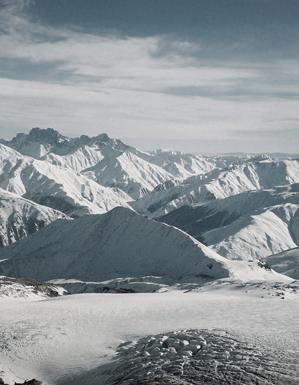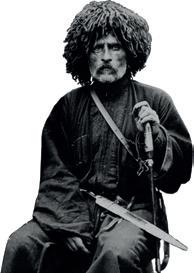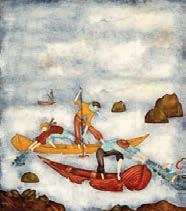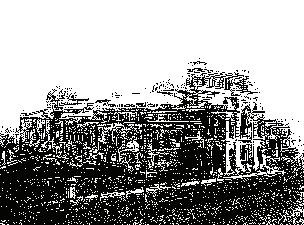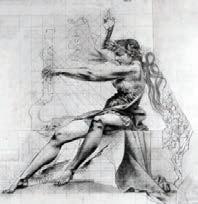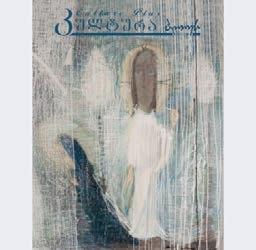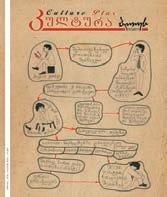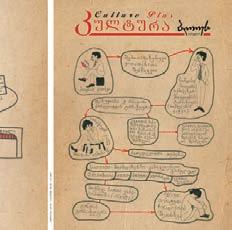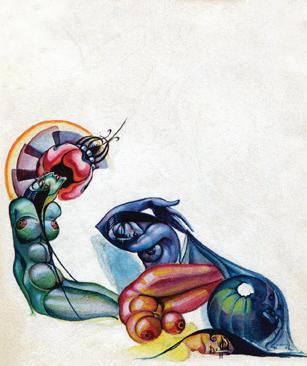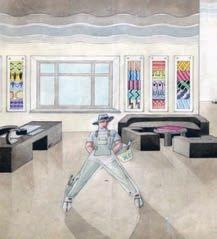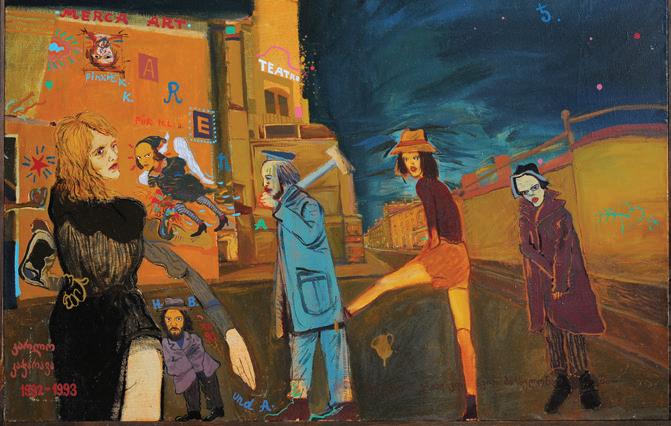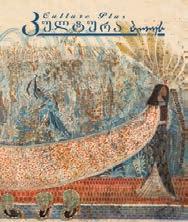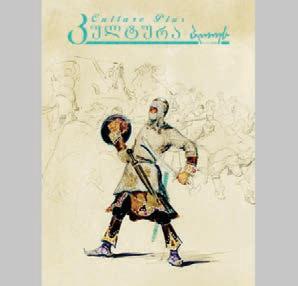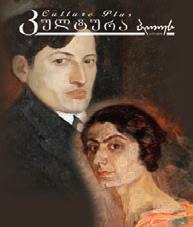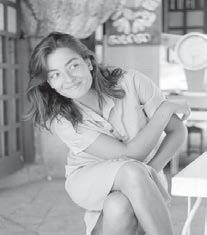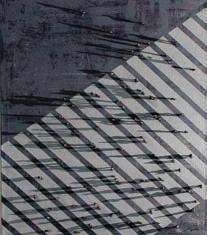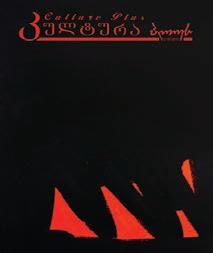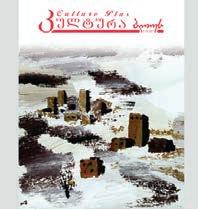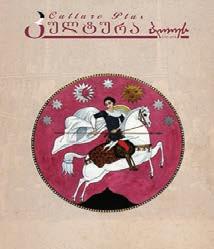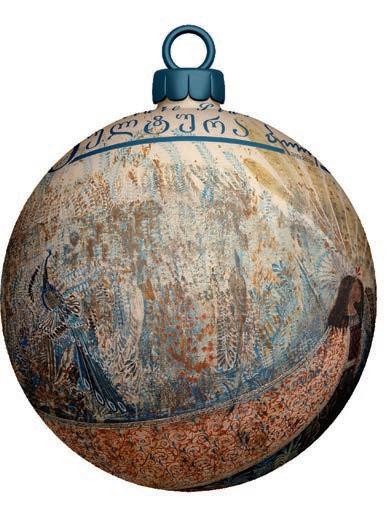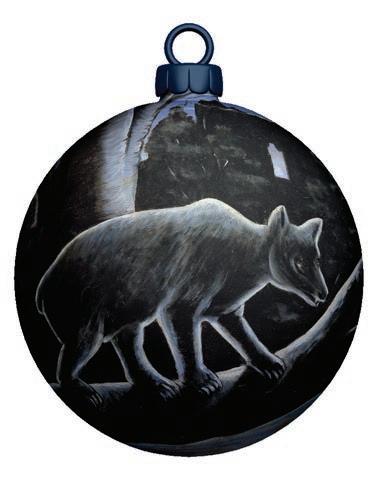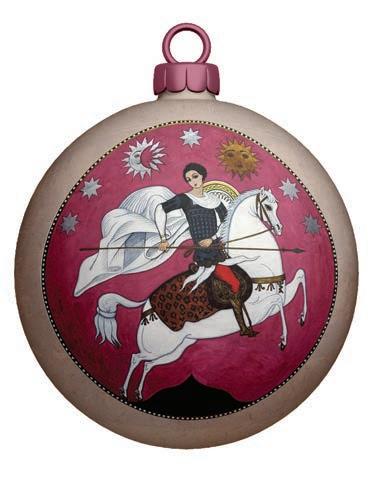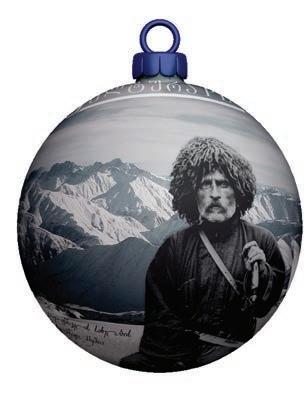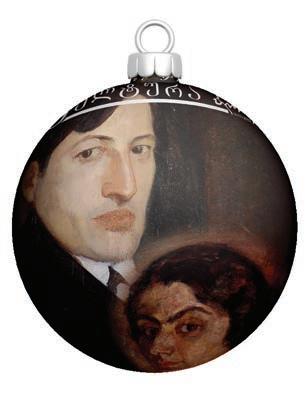

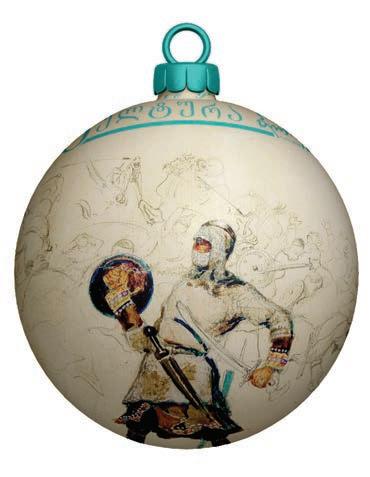


















4 (18) 2019
fiqrebi xmamaRla
`parlamenti~ anu „xrikis moedani“
ulmobeli saqmis kaci
Ria gakveTili
samSoblos siyvaruli profesia ar gaxlavT
afxazTa muhajiroba or dedaqalaqSi vicnobT ki?
daviT sarajiSvili ganaxlebadi, viTarca amirani
Cems Zvel saxlSi
ra iqna lerwamSi damaluli cecxli?
`kavkasiis maRalmTiani regionebidan~ nikoloz baraTaSvilis konteqsti
sicariele...
mTavari redaqtori revaz iukuriZe saredaqcio jgufi xaTuna kereseliZe aleqsandre ServaSiZe dizaineri nikoloz bagrationi
THINKING OUT LOUD
“THE PARLIAMENT,” OR THE “SQUARE OF TRICKERY”
RELENTLESS MAN OF BUSINESS OPEN LESSON
LOVING YOUR HOMELAND IS NOT AN OCCUPATION
ABKHAZ MUHAJIRISM IN TWO CAPITALS
DO WE EVEN KNOW HIM?
DAVID SARAJISHVILI
CAPABLE OF REVIVAL LIKE AMIRAN
IN MY OLD HOUSE
WHERE IS THE FIRE THAT WAS CONCEALED IN REED?
‘FROM THE HIGH REGIONS OF THE CAUCASUS’
NIKOLOZ BARATASHVILI'S BACKGROUND
A CULTURAL VOID…
EDITOR-IN-CHIEF REVAZ IUKURIDZE
EDITORIAL STAFF KHATUNA KERESELIDZE ALEKSANDRE SHERVASHIDZE DESIGNER NIKOLOZ BAGRATIONI
el-fosta: kulturaplusm@gmail.com facebook.com/kulturaplusm
gamodis kvartalSi erTxel
JurnalSi ganTavsebuli masalis gamoyeneba SeiZleba mxolod redaqciis TanxmobiT Issued quarterly
saganmanaTleblo-sazogadoebrivi Jurnali ISSN 2346-8165
beWdva: Sps „kontrol p“ / Print: Ctrl p
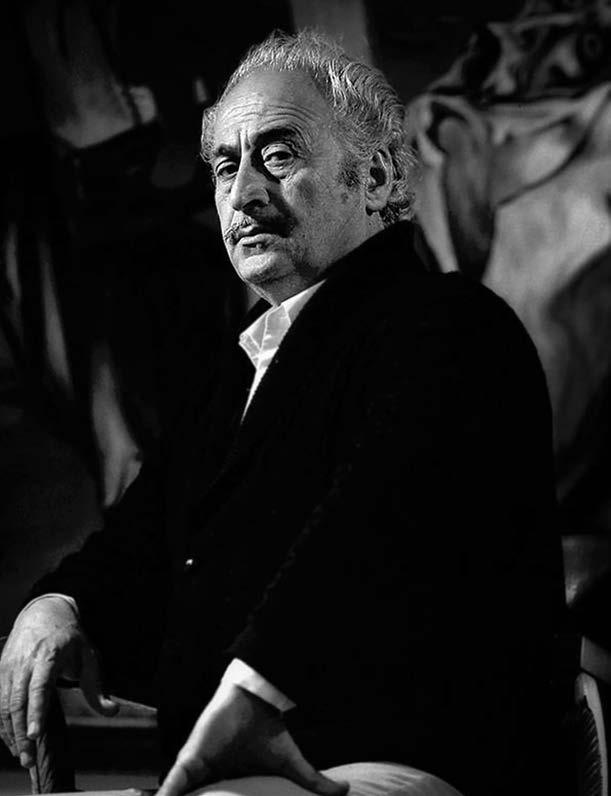
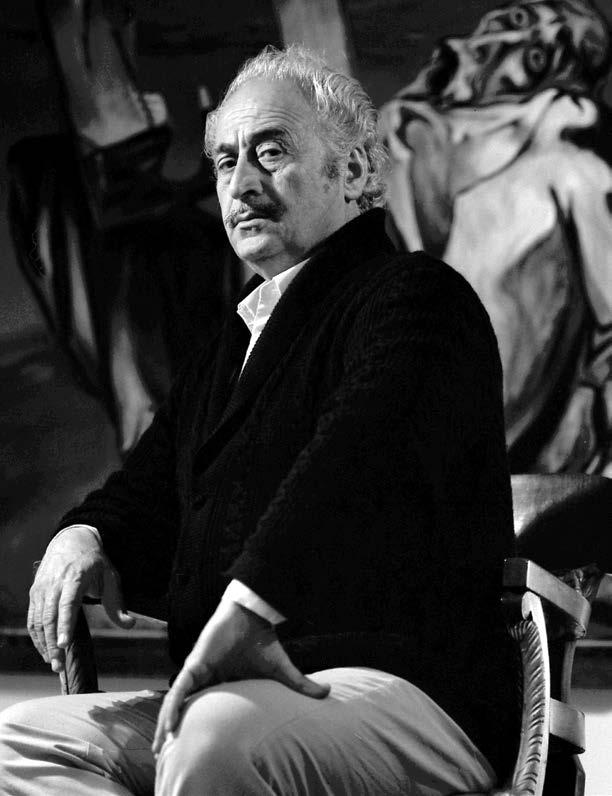
adamianis daknineba sulieri siRatakiT iwyeba. Tu Cvens yofa-cxovrebas CavwvdebiT, aRmovaCenT, rom qarTvel kacs Seryevia sulieri simtkice. gulsatkenia da didi usamarTlobaa, roca wina planze uxamsoba da Zaladobaa warmoCenili da am dros WeSmariti saqarTvelo TiTqos nislSi CaZirula... jer kidev saukuneebis ukan, akademiebSi izrdebodnen Cveni winaprebi... qarTvels ar ucxovria damwerlobis, filosofiis, SemoqmedebiTi Rvwis gareSe. amas Cveni literatura da kulturis ZeglTa siuxve adasturebs. saqarTvelos aRmSeneblobis dedaboZi kulturaa. dRes Cveni upirvelesi amocana gonieri, ganswavluli axalgazrdobis saqmeSi Cabma unda iyos, radgan axalgazrdul energias Seswevs unari SemoqmedebiTi Tavdadebisa. saqarTveloSi odiTgan iswrafodnen swavla-ganaTlebisken, radgan swamdaT, rom `ymawvili unda swavlobdes sacnoblad Tavisadao: vin aris, sidam mosula, sad aris, wava sadao...~ ers ganswavluli profesionalebi, suliT Zlierni da samSobloze mofiqrali Svilebi sWirdeba. yvelam unda gaiazros, rom eris Wkua-gonebis saganZuri mis inteleqtualur nawilSi Zevs.
qarTvel politikosebs rom Tavis droze hqonodaT unari, Caswvdomodnen mecnierTa miniSnebebs, literaturasa da xelovnebaSi gumaniT mignebul simarTles, Caswvdomodnen mweralTa tkivils, dRes, albaT, saqarTvelo am dReSi ar iqneboda... unda vTqvaT, unda vaRiaroT, rom didi istoriisa da kulturis qveyanaSi axla Rirebulebebi dakninebulia. Semcdaria is, vinc fiqrobs, rom kultura maSin amaRldeba, roca davnayrdebiT, ekonomikurad movmagrdebiT, mereRa dadgeba kulturuli aRmSeneblobis dro?! rom aRaSeno, kultura unda gagaCndes! ra donis kulturac geqneba, im donis saxelmwifos SevqmniT! amitomac erTi wuTiTac ar SeiZleba misi ganviTarebis Seferxeba. marTalia, omma, siduxWirem, adamianTa fizikur gadarCenaze fiqrma, Zarcva-yaCaRobam, Ralatma amosunTqvis saSualeba ar mogvca Cveni istoriis bolo wlebSi, magram Cvens dRevandel yofas marto amas nu davabralebT... yvelasTvis kargad cnobili magaliTia leningradis blokadaSi moqceuli moqalaqeebis qmedeba _ rogor gadaarCines Zeglebi, rogor ganarides daRupvas xalxis sulieri simdidre, dagvarwmunes, rom kultura adamianis Rirsebis didi wyaroa.
Cven ki, Cvenda samarcxvinod, rac spilenZiT Semosili Zeglebi gagvaCnda, gavatyaveT, davangrieT, movspeT, gavanadgureT. amaze metad savalalo raRa unda iyos, rom Sens ers sulieri ganZi mostaco, xelovnebis nimuSi dalewo da ferad liTonad TurqeTSi gayido... imasac moveswariT, rom Tavad xelisuflebam memorialebis afeTqebas mihyo xeli (romelsac saubedurod
The decline of man begins with spiritual bankruptcy. If we comprehend our existence and way of life, we will discover that Georgian Man has lost his spiritual strength. It is heartrending, and also a great injustice, that indecency and violence are in the foreground while the real Georgia seems to be shrouded in fog... And yet, centuries ago, our ancestors were brought up and nurtured in academies... Georgia has not existed without writing, philosophy, and creative yearning. Our literature, and the abundance of cultural monuments, is a testament to this.
Culture is the pillar of a flourishing Georgia. Today, our primary aim should be to involve intelligent and learned young people, as youthful energy has the capacity of creative devotion. Since time immemorial, people yearned towards knowledge and enlightenment in Georgia, as they believed that “A young man should learn in order to know himself: “Who is he? Where has he come from? Where is he? Where will he go..?” The nation needs learned professionals; sons and daughters strong in spirit and with their Motherland on their minds. Everyone should comprehend that the nation’s treasures of wisdom are in its intellectuality.
If only Georgian politicians had had the skill, at the appropriate time, to comprehend the hints of the scholars; the truths found intuitively in literature and art; to have comprehended the pain of writers. Then Georgia would not be in its current state today... We should say, we should admit, that in this country of great history and culture, values have been compromised. He who thinks that culture will rise when we will be well fed and better off is mistaken –would the time of cultural revival come then? You must have culture in order to revive it! And the state we create will be of the same level as the culture that we possess! For this reason, its development cannot be delayed for a single minute. It is true that war, poverty, people’s concern with physical survival, thieving, robbery, and betrayal did not leave us any time to catch our breath in the recent years of our history. But let us not blame our current state of being only on this... The actions of the people trapped in the Leningrad blockade are a well-known example – how they preserved monuments, saved people’s spiritual treasures from destruction, and convinced us that culture is a great source of human dignity.
On the other hand, we, in our shame, stripped all the copperplated monuments that we had; we broke, we destroyed, we annihilated. What could be more lamentable than to steal a spiritual treasure from your nation, to destroy a work of art, and to sell it as scrap metal in Turkey...? We have even witnessed the government itself blowing up memorials (which, unfortunately, even resulted in loss of life) and displaying unprecedented immorality...
The destruction of culture should be brought to an end! Our parliament should, at last, now, ensure the strict protection of culture by law. And our most urgent matter at hand should be taking care of the education of the new generation.
We should see the big picture when we talk about culture. Even big business cannot be created without specific culture. Those who took this into account were fortunate and also managed to help the country.
msxverplic mohyva) da gaugonari uzneoba gamoavlina...
wertili unda daesvas kulturis ngrevas! Cvenma parlamentma axla mainc unda miaRwios imas, rom kulturas kanoni myarad icavdes. Cveni gadaudebeli saqme ki momavali Taobis swavla-ganaTlebaze zrunva unda gaxdes.
roca kulturaze vlaparakobT, igi masStaburad unda davinaxoT. specifikuri kulturis gareSe didi biznesic ar iqmneba. vinc es gaiTvaliswina, gaumarTlda kidec da qveyanasac argo.
`gadavarCinoT qarTuli kultura da is gadaarCens qarTvel xalxs!~ _ brwyinvaled iyo naTqvami, magram kargad Tqmuls kargad gamgebi ar gamouCnda. dRemde msofliosTvis Seucnobi qveynis Rirseba swored Cveni TviTmyofadi kulturis gacnobiT unda dagvewyo da arc erTi wamiT ar unda Segveferxebina es gezi. arc axlaa gvian, Tuki movindomebT. qarTul kulturaze fiqri saxelmwifoebrivi saqmea da, pirvel rigSi, swored xelisuflebam, saxelmwifom unda upatronos mas. aucilebelia Rrma kontaqtebi saerTaSoriso arenaze rogorc politikur, ise ekonomikisa da kulturis sferoebSi. aRsaniSnavi faqtia bolo dros qarTuli anbanis unikalurobis warmoCenis mizniT gadadgmuli nabijebi... es procesi unda gagrZeldes da msoflios Cveni TviTmyofadoba sxva mxrivac unda gavacnoT. bunebrivia, didi xelovnebis gverdiT sokosaviT mravldeba mdarec. amas ver avcdebiT. es normaluri procesia iseve, rogorc is, rom mSveniereba da simaxinje erTmaneTs Sescqerian TvalebSi, magram maTi aRreva arasdros momxdara da arc moxdeba. mTavaria, SegeZlos xelovnebis nawarmoebis garCeva surogatisgan. swored WeSmarit xelovnebas axasiaTebs kaTarsisi _ sulieri ganwmendis Zala. axla samecniero, analitikuri werilebis weris droa. primitiuli, zedapiruli, mdare informaciuli xasiaTis statiebiT verafers mivaRwevT. sazogadoebas, axalgazrdobas unda vawvdideT Rrma, Rirebul masalas, sadac saubari iqneba imaze, Tu ra aris specifikuri ena xelovnebisa, misi dargebisa, ras niSnavs Tanamedrove xelovneba _ riTi ganvasxvavebT mas winamorbedisgan...
dRes Cvens dedaqalaqSi daSvebuli Secdomebi xval momavali TaobebisTvis mwvave problema gaxdeba. am saWirboroto Temis Sesaxeb bevri misaubria da damiweria. gavixseneb erT sakmaod `STambeWdav~ Zaladobas _ saakaZis moedanze, giorgi saakaZis

“Let us save Georgian culture and it will save the Georgian people!” – This was well said but it failed to reach the right listeners. We should have begun the dignity of our country, which is unknown to the world, by acquainting others with our culture and we should not have deviated from this path even for a second. It is not too late now, either, if we work hard enough. Thinking about Georgian culture is an issue related to statehood, so primarily the government – the state – should look after it. Deep international contacts in political as well as economic and cultural spheres are essential. Noteworthy are the steps taken towards promoting the uniqueness of the Georgian alphabet... This process should be continued and we should acquaint the world with our self-sufficiency from another perspective as well.
Naturally, in the presence of great art, inferior art tends also to proliferate. This cannot be avoided. This is a normal process, much like beauty and ugliness – they may stare each other in the eyes but they have never mixed, and they never will. The main thing is to be able to tell a work of art from a surrogate. It is precisely true art that can be cathartic – that it can possess the power of spiritual purification. Now is the time to write scientific and analytic papers. We will achieve nothing by writing primitive, superficial, inferior informational papers. We should provide the public, the youth, with deep, valuable material, which will talk about the nature of the specific language of art and of its genres, what modern art means, what differentiates it from its predecessors...
The mistakes made in our capital city today will become acute problems for future generations tomorrow. I have spoken and written a great deal about this pressing issue. I would like to recall one, particularly “impressive” instance of violence – the closing off of the space behind the statue of Giorgi Saakadze on Saakadze Square, and the mutilation of an area rich in artistic value. The square where Saakadze’s statue stands was designed by four famous architects and was developed according to that excellent project. The architects provided a great background for the statue – the Caucasus Mountains. Such natural space is a great joy for a city, and its
Zeglis ukan sivrcis Caketvas da mxatvruli Rirsebis mqone garemos damaxinjebas. moedani, sadac saakaZis Zegli dgas, oTxi cnobili arqiteqtoris mier iyo daproeqtebuli da am Cinebuli proeqtiT iyo ganaSenianebuli. Zegls arqiteqtorebma veeba sivrce dautoves _ kavkasionis mTebi. aseTi bunebrivi sivrce qalaqisTvis didi bednierebaa, xolo misi daxSoba _ didi Tavxedoba. viRacis surviliT giorgi saakaZis moedanze, Zeglis ukan, Tanamedrove arqiteqturisTvis samarcxvino SenobaTa krebuli _ erTmaneTze gadajaWvuli saxlebi aSenda, romelmac sruliad daaxSo sivrce da qalaqi daamaxinja. droTa cvlilebam, yovelma axalma biurokratma arsebuli, Zveli rom ase daazianos, mospos, maSin Cven uRimRamo da uistorio qalaqs avaSenebT _ dasaxlebul punqts. sabednierod, Cvens qalaqs bunebrivad axlavs iseTi adgilebi, romelTac SenarCuneba sWirdeba. Cven xelovnurad vspobT im silamazes, romelic RmerTma mogvca. Cemi azriT, landSaftis dacvis sakiTxi specialistTa ganxilvis, gansjis sagnad unda iqces. imedi maqvs, viRac-viRacaTa TviTnebobiT dedaqalaqi metad aRar dazaraldeba. vinc Cveni qalaqebis, Cveni samSoblos keTildReobaze fiqrobs, mis awmyosa da momavalze, maT daucxromeli qmedeba marTebT, radgan gulgrilobis garemoSi azrovneba dundeba, uniWoba zeobs, yvelaferi mdare Tavs iCens, adamianis mSveniereba da Rirseba fuladi SesaZleblobebiT fasdeba, amitom ar SeiZleba moduneba, Cven es ar unda davuSvaT!
Cvens cxovrebas gamarTleba eqneba maSin, Tu Cven viqnebiT Rirseuli Svilebi Cveni winaprebisa, dReniadag saqarTveloze mofiqralni.


obstruction is great impudence. Due to someone’s personal desire, an entire group of closely-knit blocks – buildings that bring shame to contemporary architecture – was built behind Giorgi Saakadze’s statue on Saakadze Square. This completely congested the space and disfigured the city. If changing times, and every new bureaucrat, were to damage and destroy everything that is old in such a way, then we will build a gray city lacking any kind of history – creating merely a populated place. Fortunately, our city inherently possesses the kinds of places that need to be preserved. We artificially destroy this God-given beauty. In my opinion, landscape protection should be a topic of discussion for relevant specialists. I hope the capital will not suffer any more because of the willfulness of certain people.
Those who think about the well-being of our cities and our Motherland, their present and their future, are duty-bound to act relentlessly, because in an atmosphere of indifference thought dwindles, mediocrity prevails, everything that is substandard rises, and human beauty and dignity become measurable by financial ability. This is why we cannot rest; we cannot allow this to happen!
Our lives will be justified if we live as worthy descendants of our ancestors, with Georgia always on our minds.
mravali wlis win akakim quTaisis bulvari oTxkuTxovani formis gamo imerul xaWapurs Seadara, xolo „baRiskideze“ gaCaRebuli mudmivi sazogadoebrivpolitikuri vnebaTaRelvisa da mZafri debatebis gamo, mas dRemde Seucvleli saxeli _ „quTaisis parlamenti“ uwoda.
poeti imdenad iyo dakavSirebuli quTaisis istoriul baRTan, mis SinaarsTan da koloritTan, rom didi xnis Semdeg, XX saukunis 80-ian wlebSi, oficialuradac ki daisva sakiTxi, quTaisis bulvarisTvis „akakis baRi“ daerqmiaT... dRes quTaisis kulturul-istoriul Zeglebs Soris bulvars gamorCeuli adgili uWiravs, metic, igi Tavisuflad SeiZleba saqarTvelos meore dedaqalaqis siamayed CaiTvalos. am siamayes ki Sori, Rrma, Zalian saintereso safuZveli aqvs...
Many years ago, Akaki Tsereteli (Akaki) compared Kutaisi’s Boulevard to an Imeretian Khachapuri due to its quadrilateral shape, and gave it its hitherto unchanged name, ‘the Parliament of Kutaisi,’ due to the constant social and political turmoil and the passionate debates that took place at the ‘Edge of the Garden’ there. The poet was so connected to Kutaisi’s historic garden, its core essence and couleur locale, that seventy years after his death, in the 1980s, even the issue of naming the Kutaisi Boulevard “Akaki’s Garden” was officially discussed... Today, the Boulevard holds a special place among Kutaisi’s historic cultural landmarks. Furthermore, it can easily be considered to be the pride of Georgia’s second capital. And this source of pride has a distant, deep, and very interesting origin...

“The
quTaTurTa mwvaneSi Caflul sacxovrebel saxlebs odiTganve gaaCnda sakuTari baRebi. amaTgan yvelaze saucxoo solomon pirvelis asulis _ darejanis baRi iyo, romelic 1820 wels imperiam xazinas gadasca, Semdgom ki sazogadoebis saseirno adgilad gamoacxada. es iyo amierkavkasiaSi pirveli evropuli tipis sazogadoebrivi baRi. xolo is adgili, sadac dRevandeli istoriuli bulvaria, XVIII saukuneSi asparezs warmoadgenda, romelic vaxuSti batoniSvilis gadmocemiT, „mozRudvili iyo varjad WandriT“. feodalur quTaisSi aq imarTeboda sxvadasxva garTobaTamaSoba: marula, burTaoba, yabaxi... sxvadasxva mosazrebas Soris, yvelaze sando petre glinesarovisaa, romelic bulvaris dabadebis TariRad 1848 wels asaxelebs. igi quTaisis vice-gubernatori swored am dros iyo. amdenad, quTaisis bulvari saukunenaxevarze meti xnis _ sul mcire, 167 wlisaa! quTaiselebma axal sazogadoebriv baRs imTaviTve, ratomRac, franguli saxeli „bulvari“ Searqves. albaT, am SinaarsiT mkveTrad gamijnes im Zveli saqalaqo baRisgan, sadac, saCrdilobel xeebTan erTad, venaxi da bostanic ki bibinebda. „bulvaris“ analogiiTa da imeruli maxvilsityvaobiT, sul male franguli sityvis qarTuli saalerso versiac gaCnda: `gulvardi“. siyvaruliT Serqmeuli saxelwodeba imdenad popularuli gaxda, rom bolo aTwleulebamdec moaRwia. gazeT „kavkazis“ korespondentis cnobiT, XIX saukunis ormocdaaTian wlebSi quTaisis bulvars farTo kvadratis forma hqonda da oTxive mxriv wiTeli ficruli RobiT iyo Semoraguli... kviraobiT mwvane mindorze msxdari quTaTurebi bunebis wiaRSi tkbebodnen musikiT. sxva dReebSi xalxi aq Tavs iSviaTad iyrida. qalaqis TviTmmarTvelobis iniciativiT 1878 wels gakeTebuli xis Robe, e.w. „reSotka“, maleve daZvelda. qvaSi Casmuli rkinis moajiriT mis Sesacvlelad ki Tanxa quTaisSi gadmosaxlebuli oldenburgeli princis, konstantines mier gadaxdili baJidan gamoinaxa. SemoRobva didxans gagrZelda da 1891 wlisTvis mTlianad damTavrda. baRis gareT qvafenilic daigo. bulvaris SemoRobvasTan dakavSirebiT arsebobs akakis erTi sakmaod mware xumroba: `moajiris svetebi sasaflaos Zeglebs hgvanan, davTvale da zustad imdenia, ramdenic xmosania qalaqis rCeva-gamgeobaSio“. es Robe baRs XX saukunis 70-ian wlebSi moxsnes.
The houses of the Kutaisians, swathed in verdant greenery, have always had their own gardens. The most awe-inspiring of these was the one that belonged to Darejani, the daughter of Solomon I. The empire handed this garden over to the treasury in 1820, and it was subsequently designated as a promenade to be enjoyed by the public. This was the first public garden of a European type in Transcaucasia. The location of the contemporary historic Boulevard housed an arena in the 18th century, which, according to Prince Vakhushti, was “encircled by intertwined plane trees.” Various games and recreational activities took place here during the feudal age of Kutaisi: marula, burtaoba, qabakhi
Among various opinions, the most trustworthy is that of Petre Glinesarov, the vice governor of Kutaisi at the time, who designated 1848 as the birth year of the Boulevard. Therefore, the Kutaisi Boulevard has existed for over a century and it now counts 167 years!
For some reason, the Kutaisians gave the new garden a French name when naming it the ’Boulevard’ and in this way they presumably wanted to strictly differentiate it from the old city garden, where grapevines and vegetables bloomed alongside shade-casting trees. A combination of an analogy for the word ‘Boulevard’ and Imeretian wit and eloquence promptly yielded a playful Georgian version of the French name: “Gulvardi,” or “Roseheart.” The lovingly crafted name proved to be so popular that it has even survived to recent decades.
According to a reporter of the newspaper ‘Kavkaz,’ in the 1840s the Kutaisi Boulevard was shaped like a wide square, and was encircled by a red wooden fence on all sides... On Sundays, Kutaisians used to sit on the lush green grass and enjoy music alfresco. People rarely gathered there on other days of the week.
The wooden fence, or the so-called ‘reshotka,’ which was built in 1878 on the initiative of the City Council, soon decayed. The funds that were required to replace it with an iron railing embedded in stone came from the levy paid by Prince Constantine Oldenburg, who had moved to Kutaisi. The railing took a long time to be built and was completed by 1891. The roads outside the garden were also paved with cobblestone.
Akaki is said to have made quite a bitter joke on the topic of the Boulevard’s new fence: “The railing pillars resemble monuments at a cemetery. I counted them, and their number exactly matches the number of balloters at the city administration.”
Throughout its existence, the Boulevard has been transformed many times according to the wishes of this or that ruling authority, while buildings have appeared and disappeared on the garden territory.
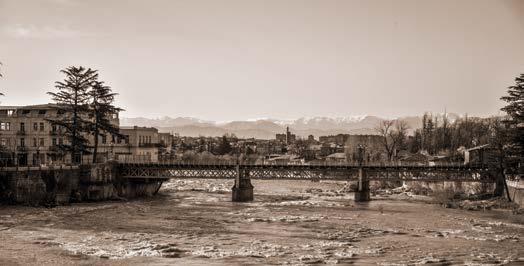
arsebobis ganmavlobaSi bulvarma, sxvadasxva drois xelisufalTa mowadinebiT, araerTxel icvala saxe. baRis teritoriaze Cndeboda da qreboda garkveuli nagebobebi.
baRma, romelic, imperiis msaxurTa CanafiqriT, mxolod dasvenebisa da garTobis uwyinari adgili unda yofiliyo, daarsebidanve uCveulod gaifarTova daniSnuleba da quTaisSi, mTel guberniaSi sazogadoebrivi moRvaweobis centrad, progresul SexedulebaTa gavrcelebis asparezad iqca.
Tu aq, Tavdapirvelad, mxolod garTobas dawafebuli Tavad-aznauroba, saxelmwifo uwyebaTa moxeleebi daseirnobdnen da, giorgi wereTlis sityvebiT, „quTaisis bulvars... imisTana mniSvneloba hqonda qalaqisaTvis, rogorc pariJSi yavaxanebs da klubebs... mudam erTi sicili da xarxari iyo“. mogvianebiT swored aq, akakis mier „quTaisis parlamentad“ monaTlul bulvarSi arCevdnen qalaqis mmarTvelobis xmosanTa av-kargs, qmnidnen sxvadasxva mimarTulebas, davobdnen da amuSavebdnen saarCevno svlebs. kidev erTi maxvilgonivruli Sedareba _ akakim arCevnebis dReebis bulvars „xrikis moedani“ uwoda... bulvars hyavda rCeulebi da, akakisTan erTad, eseni iyvnen _ quTaisuri sazogadoebis mier TeTrwvera „aristided“ monaTluli, TergdaleulTa ufrosi Taobis warmomadgeneli kirile lorTqifaniZe, solomon leoniZe, Zmebi RoRoberiZeebi, rafiel erisTavi, giorgi wereTeli, niko nikolaZe, daviT xelTufliSvili, giorgi
The garden, which the empire’s servants intended to be nothing but a harmless venue for rest and relaxation, managed to broaden its purpose in a most unusual way soon after its establishment. It became a center of social activity and an arena for the dissemination of progressive attitudes, in Kutaisi and in the entire province.
If, initially, the garden was only traversed by state employees or nobles with entertainment on their minds, in Giorgi Tsereteli’s words: “the Boulevard of Kutaisi had the same meaning and importance for the city as cafes and clubs did for Paris... Mirth and merriment abounded there.”
It was here, in the ‘Parliament of Kutaisi,’ as Akaki had christened it, that the good and the bad of the city leadership’s balloters were elected, various movements were created, and electoral strategies were debated and refined. Another witty simile: Akaki called the Boulevard during election time the ‘Square of Trickery’...The Boulevard had its chosen personalities, and, along with Akaki, they were: Kirile Lortkipanidze, who was christened by the Kutaisian public as the white-haired ‘Aristides,’ and a representative of the older Tergdaleulebi generation, Solomon Leonidze, the Ghoghoberidze brothers, Rapiel Eristavi, Giorgi Tsereteli, Niko Nikoladze, Davit Kheltuplishvili, Giorgi Zdanovichi-Maiashvili, Mose Kikodze, Simitri Nazarishvili, Pavle Tumanishvili, Data Nizharadze, Giorgi Sharvashidze, Konstantine (Kotsia) Eristavi, Anton Purtseladze, Luka Asatiani, Ilia Chikovani, Isak and Ivane Pundashvili, Solomon Mikeladze, Dimitri Bakradze, Davit Bakradze, Erote Sidamonov-Eristavi, Gerasime Kalandarashvili, Sergei Meskhi, Petre Nakashidze, Data Eristavi, Davit Kldiashvili, Niko Lortkipanidze, Ivane Zurabishvili, Seit Iashvili, Sergi
zdanoviCi-maiaSvili, mose qiqoZe, dimitri nazariSvili, pavle TumaniSvili, daTa niJaraZe, giorgi SarvaSiZe, konstantine (kowia) erisTavi, anton furcelaZe, luka asaTiani, ilia Ciqovani, isak da ivane puradaSvilebi, solomon miqelaZe, dimitri baqraZe, daviT baqraZe, eroTe sidamonov-erisTavi, gerasime kalandaraSvili, sergei mesxi, petre nakaSiZe, daTa erisTavi, daviT kldiaSvili, niko lorTqifaniZe, ivane zurabiSvili, seiT iaSvili, sergi gersamia, kita abaSiZe, anton lorTqifaniZe, trifon jafariZe, giorgi maisuraZe da mravali sxva.
Zvel bulvars axsovs is axalgazrda quTaTurebic, gatacebiT rom kiTxulobdnen „Rubernski stambaSi“ dabeWdil wigns melqisedek abesaZisas _ „saarSiyo leqsebi vaJebisagan qalebTan minaweri“ da axsovs „soboros“ mopirdapired, myudro kuTxeSi, amoCemebul skamze mjdomi moxucic _ saqarTvelos ugvirgvino mefe akaki wereTeli, martoobas rom ar aclidnen garsSemoxveuli Tayvanismcemlebi. raWa-leCxumSi akakis cnobili mogzaurobis amsaxveli pirveli kadrebic swored bulvarSi gadaiRo pirvelma qarTvelma operatorma vasil amaSukelma da filmi poetisa da misi mxleblebis bulvarSive dabrunebiT daasrula. bulvars aseve axsovs „lotoTi daTroba“ (akakis sityvebia) aristokrati qalbatonebisa, Rameuli farnebis Suqze, Ramis 10-11 saaTzec ki, gaCaRebuli rom hqondaT azartuli TamaSi da Carozad morTmeul „vareniebs“ aCqarebiT Seeqceodnen, raTa umal mibrunebodnen sayvarel garTobas... da axsovs ekaterine lorTqifaniZis redaqtorobiT quTaisel qalTa mier gamocemuli „qarTuli biblioTekac“, ucxour progresul nawarmoebTa Targmanebs rom awvdida qarTul sazogadoebas.
axsovs tragikuli bedis poetis _ mamia gurielis ganumeorebeli deklamaciac da mixai ziCis mier „vefxistyaosnis cocxali suraTebisaTvis“ Sekrebil quTaisel qal-vaJTa gasaocari silamazec. bulvarSi wlebis ganmavlobaSi Srialebda feraZis, gamreklovis, wulukiZis, RambaSiZis, kilaZisa Tu xelaZis tipografiebSi dabeWdili wignebis furclebic da quTaisSi gamocemuli aTeulobiT cincxali gazeTic, rom araferi vTqvaT sagangebod gamoweril „iveriasa“ Tu „droebaze“.
aq xSirad gagrZelebula daviT miqelaZis (mevelis), elene yifianis (dimitri yifianis asulis), niko nikolaZis debis salonebSi dawyebuli literaturuli debatebi. sazogadoebas codniTa da gamorCeuli inteleqtiT aRafrTovanebda tartusa da laifcigis universitetebSi ganswavluli axalgazrda mecnieri da mwerali, filosofiis doqtori grigol robaqiZe, romlis leqciam
Gersamia, Kita Abashidze, Anton Lorktipanidze, Tripon Japaridze, Giorgi Maisuradze, and many others.
The old Boulevard remembers the young Kutaisians who fervently read Melkisedek Abesadze’s ‘Amatory Poems, Written by Young Men to Women,’ published by the provincial publishing house of Kutaisi. It also remembers the old man who invariably sat on the same chair, opposite the ‘soboro,’ or the cathedral. This old man was Akaki Tsereteli, the uncrowned king of Georgia, who was rarely afforded the luxury of solitude by the admirers who always seemed to surround him. It was precisely on the Boulevard that Vasil Amashukeli, the first Georgian director of photography, filmed the beginning of Akaki’s famous journey to Racha-Lechkhumi. He ended the film with the return of Akaki and his admirers to the very same Boulevard.
The Boulevard also remembers the ‘Inebriation by Lotto’ (in Akaki’s words) of aristocratic women, who eagerly engaged in gambling under the streetlights late into the evening, while hastily consuming various jams brought to them for dessert so as not be distracted from their favorite pastime for too long. The Boulevard also remembers the ‘Georgian Library,’ which was published by Kutaisian women, under Ekaterine Lortkipanidze’s editorship, which provided the Georgian public with translations of foreign progressive works.
The Boulevard also remembers the inimitable declamation by Mamia Gurieli, the tragically fated poet, as well as the exceptional beauty of the Kutaisian young men and women who gathered for Mihaly Zichy’s tableaux vivants.
Throughout the years, the rustling of pages from books printed with the typography of Peradze, Gamreklovi, Tsulukidze, Ghambashidze, Kiladze, and Kheladze, as well as of dozens of fresh newspapers printed in Kutaisi, not to mention the special subscriptions to ‘Iveria’ and ‘Droeba.’ Debates initiated at the literary salons of Davit Mikeladze-Meveli, Elene Kipiani (daughter of Dimitri Kipiani), and the sisters of Niko Nikoladze often continued here. Grigol Robakidze, PhD, a young scientist and writer who had studied in the universities of Tartu and Leipzig, often amazed the public with his knowledge and exceptional intellect here. It was his lecture on Nietzsche that made Akaki himself say: “I witnessed what I had missed my entire life: A Georgian intellectual and a free thinker, rather than a fantastic gramophone.”
The Boulevard’s elite were the first to feel Galaktioni approaching, and from the very beginning held his poems, which were printed in the periodic press, in high esteem, together with the great Akaki. In 1914, in Kutaisi, with his first book published in Tutku Gvaramia’s publishing house, the new king stepped onto the Boulevard.
In 1915-1916, the conservative ‘Edge of the Garden’ engaged in incensed discussions of the works of a symbolist school with the strange name ‘Tsisperi Qantsebi,’ (Blue Drinking Horns), which was founded by “some” young poets – Tite Tabidze, Pavle Iashvili, Nikoloz Nadiradze, Valerian Gaprindashvili, and Aleksandre (Sandro) Tsirekidze. The Boulevard Society was amazed by the fact that
fridrix nicSeze TviT akakis aTqmevina: `vnaxe is, rac mTelis Cemis sicocxlis ganmavlobaSi menatreboda: qarTveli inteligenti, TavisTavad moazre da ara saucxovo gramafoni“.
bulvaris elita pirveli grZnobda galaktionis moaxloebasac da periodul presaSi dabeWdil mis leqsebs, did akakisTan erTad, imTaviTve maRal Sefasebas aZlevda. 1914 wels quTaisSi, tutku gvaramias stambaSi dabeWdili pirveli wigniT axalma mefem Semoabija bulvarSi.
1915-1916 wlebSi ki konservatoruli „baRiskide“ gagulisebuli ganixilavda „vincxa“ axalgazrda poetebis _ tite tabiZis, pavle iaSvilis, nikoloz nadiraZis, valerian gafrindaSvilis, aleqsandre (sandro) cirekiZisa da maTi megobrebis mier Camoyalibebuli, ucnaursaxelwodebiani simbolisturi skolis _ „cisferi yanwebis“ produqcias da gaocebuli iyo, „rafer“ uWerda mxars „am Tavxed bovSebs“ iseTi gemovnebiani mkiTxveli da Semfasebeli, rogoric `ufali kritikosi~ kita abaSiZe brZandeboda.
am skolis erT-erTi fuZemdebeli, ori manifestis avtori tician tabiZe mogvianebiT ityvis: `quTaisi maSin warmogvedgina rodenbaxis mkvdar briuged... qalaqi gaRatakebuli wvrili memamuleebisa, romelTac ukve karga xania gaeniavebinaT sakuTari mamulebi, qalaqi eSmakobaSi gawvrTnili xalxisa, oxunjebisa da usaqmo muqTaxorebisa _ iwvevda CvenSi meSCanobisadmi bohemur opoziciur ganwyobilebas da gvamxedrebda „sazogadoebrivi gemovnebis“ winaaRmdeg“. iqve, axlos mdebare ori didi kinoTeatris _ „monplezirisa“ da „radiumis“ mayurebeli bulvaris CrdilqveS msjelobda axali kinosuraTebis, maT Soris _ vasil amaSukelis mxatvrul-dokumenturi namuSevrebis Sesaxeb. xolo Teatraluri „baRiskide“ gacilebiT adreuli wlebidan da gacilebiT mkveTri emociebiT arCevda jer kote mesxisa da misi Teatris repertuars, mako safarova-abaSiZis, nato gabunia-cagarlis, nino CxeiZis, elisabed CerqeziSvilis, taso abaSiZis, vaso abaSiZis, kote yifianis rolebs; mere ki imiT amayobda, rogor „daartymevina cxviri“ quTaisSi sagastrolod Camosul ganTqmul Zmebs _ adelgeimebs maT warmodgenebs Soris sagangebod Casmuli speqtaklebiT („rui blaziT“ da „hamletiT“) lado mesxiSvilma. gacilebiT gvian, 1928-30 wlebSi, quTaisi da misi Teatraluri „baRiskide“ pirvelive speqtakliT daipyro kidev erTma gamorCeulma niWma _ kote marjaniSvilma. bulvaris erT-erTi Wadris qveS, ikribebodnen marjaniSvilelebi da aq, uSangis, verikos, sxva korifeTa garemocvaSi, xSirad idga Turme didi kotec. es istoriuli Wadari, samwuxarod, dRevandeli saopero Teatris gafarToeba-rekonstruqciis samuSaoebs Seewira.
“these impudent youngsters” were supported by such as tasteful a reader and appraiser as the master critic Kita Abashidze.
Titsian Tabidze, one of the founders of this school and the author of two manifestos, would later say: “At that time, we saw Kutaisi as Rodenbach’s Bruges-la-Morte... A city depleted by petty landowners who had already squandered their estates long ago; a city of people well versed in trickery; of jesters and idle freeloaders – it provoked us to a bohemian opposition to philistinism and set us against “public taste.”
Nearby, the audiences of two large cinemas, the Monplaisir and the Radium, were discussing new films in the shade of the Boulevard. These films included Vasil Amashukeli’s documentary feature films. Much earlier, and with significantly more distinct emotions, the theatric ‘Edge of the Garden’ discussed the works of Kote Meskhi and his theatric repertoire, as well as the roles played by Mako Saparova-Abashidze, Nato Gabunia-Tsagareli, Nino Chkheidze, Elisabed Cherkezishvili, Taso Abashidze, Vaso Abashidze, and Kote Kipiani. The ‘Garden’s’ public was also proud of how Lado Meskhishvili bested the famous Adelheim brothers, who had come to Kutaisi on tour with their plays the Ruy Blas and Hamlet.
Much later, in 1928-1930, Kutaisi and its theatrical ‘Edge of the Garden’ was taken by storm by the very first play of this distinguished talent, Kote Marjanishvili. The Marjanishvilis gathered beneath one of the Boulevard’s plane trees, and here, surrounded by Ushangi, Veriko, and other notable theatric figures, the great Kote could also often be found. Unfortunately, this particular historic plane tree was sacrificed during the reconstruction of the modern Opera House.
Primarily, the Boulevard was an arena for the best performers of urban and folk songs. At the beginning of the previous century, distinguished noblemen and their friends refused to concede their supremacy: Bondo and Pipinia Mikeladze, Kokinia Dgebuadze, Niko Paghava, Kotatia Mumladze, Mina Bolkvadze, “Daniela Uria,” and others. Legend has it that when the Kutaisian public held a grand banquet for Vano Sarajishvili and Sandro Inashvili, who had come to Kutaisi on a performance tour, the distinguished singers were amazed by the brilliant rendition of the ’Tseduri Mravalzhamieri,’ which was performed during the feast by young noblemen from Imereti. People told a story whereby Daniela Uria, who was prima voce, raised his voice to the heavens and refused to conclude the song until the dazed noblemen quietly surrendered three golden ten-ruble coins, which he had requested by displaying three fingers joined together. On the next day, Daniela is reported to have held a feast for the nobles and paid for it with precisely those three gold coins.
The delightful songs of high-school students could also often be heard on the Boulevard, where groups often challenged each other, though the Dimitri and Bidzina Mchedlidze brothers were peerless in this regard. The youth instantly stopped singing upon spotting Ioseb Otskheli, however, as the old headmaster walked home from school; they even hid behind the trees.
Real stories have often served as the basis for the song repertoire of the ‘Edge of the Garden.’ For example, during the early 1900s,
bulvari, upirvelesad, qalaquri da folkloruli simRerebis saukeTeso SemsrulebelTa asparezi iyo. gasuli saukunis damdegs aq pirvelobas aravis uTmobdnen keTilSobili Tavadebi da maTi megobrebi: bondo da pipinia miqelaZeebi, kokinia dgebuaZe, niko faRava, kotatia mumlaZe, mina bolqvaZe, `daniela uria~ da sxvebi. legendad SemorCa is ambavi, sagastrolod Camosul vano sarajiSvilsa da sandro inaSvils quTaisis sazogadoebam didi banketi rom gaumarTa da imerelma TavadiSvilebma sufrasTan Sesrulebuli brwyinvale „ceduri mravalJamieriT“ gaaognes gamoCenili momRerlebi. xalxSi yvebodnen: pirvels Turme daniela uria ambobda, xma caSi aswia da, manam ar wavida finalisken, sanam gasavaTebulma Tavadebma mis mier sami SeerTebuli TiTiT moTxovnili sami oqros Tumani Cumad ar daudes magidaze, meore dRes ki danielam isini am fuliTve aqeifao.
bulvarSi xSirad gaismoda gimnazielTa mSvenieri simRerebic, jgufi-jgufs ejibreboda, Tumca badali ar hyoliaT Zmebs _ dimitri da biZina mWedliZeebs. axalgazrdoba umal wyvetda simReras, rogorc ki Tvals mohkravdnen qarTuli gimnaziidan wamosul da bulvaris gavliT Sinisken mimaval ioseb ocxels. ekrZalvodnen moxuc direqtors, xeebs efarebodnen.
„baRiskidis“ sasimRero repertuars araerTxel dasdebia safuZvlad realuri istoriebi. magaliTad, gasuli saukunis aTiani wlebis `quTaisur arRanSi~ gaCenila erTi axali „pesni“, romelsac gatacebiT mReroda imereTis maSindeli dardimandi axalgazrdoba: `ia uezJaiu iz kutaisa, praSCai, alisa! taSCi vedro!..“ es alisa quTaisis satumroSi momuSave lamazi damlagebeli yofila, romelic peterburgidan ardadegebze Camosul vinme axalgazrda imerel Tavads danaxvisTanave Sehyvarebia da colobaze dauTanxmebia. samwuxarod, sarTulidan sarTulze wyliani vedroebis tarebis garda, am lamazmans sxva „samsaxuric“ hqonia sastumroSi da ubedur saqmros es mxolod maSin Seutyvia, erTerT TayvanismcemelTan friad saeWvo viTarebaSi rom wauswria. gulmoklul Tavads sastumrodan gaqcevis win qalisTvis swored zemoTxsenebuli leqsi-amonakvnesi dautovebia, romelic swrafad gavrcelebula quTaisSi da simReradac uqceviaT. mxolod aseTi kiCi rodi ipyrobda quTaisis bulvars, aq SesaniSnavad sruldeboda klasikuri da folkloruli margalitebi, piruTvnelad fasdeboda adgilobriv Tu sagastrolod Camosul SemsrulebelTa xelovneba. Tavis droze Zvel bulvarSi gacxarebiT laparakobdnen iSxnelebis tkbilxmian gogonebzec, maTi skolis direqtorma kinaRam rom garicxa saswavleblidan Ramis koncertSi monawileobis gamo. aseve sensaciad iqca „quTeisis cirkSi“ skolis uCumrad gamosuli biWi _ kolia qvarianic, romelmac rusebis

there appeared on the Kutaisian arena a new ‘pesni’ (song), which the carefree Imeretian youth of the time used to sing with enthusiasm: “Я уезжаю из Кутаиса, прощай, Алиса! Тащи ведро!” (“I’m leaving Kutaisi, good-bye Alisa! Fetch the bucket!”). The aforementioned Alisa turned out to be a beautiful chambermaid at a hotel in Kutaisi, with whom one young Imeretian nobleman on holiday from Saint Petersburg had instantly fallen in love, and whom he had later married. Unfortunately, this beauty had apparently had another “job” besides taking buckets of water from one hotel floor to the next, and the unlucky groom only found out about this upon catching her with one of her admirers under fairly suspicious circumstances. The aforementioned lines were the only thing that the heartbroken nobleman could utter before fleeing the hotel; and they were subsequently made into a song in Kutaisi. Such kitsch was far from being the only thing that conquered the Boulevard of Kutaisi. Classic and folk gems were performed brilliantly here, and the works of artists both local and on tour were given a frank assessment. At the time, people spoke fervently of the sweettoned Ishkhneli girls, whom their school headmaster nearly expelled from the institution because they took part in a night concert.
ganTqmuli falavani „Cornaia maska“ daamarcxa. kolia qvarianisa da saarako Zalis patronis _ JorJika iaSvilis qiSpobac axsovs Zvel „baRiskides“, anu is sajildao rkinis meseri, bulvarSi romeliRac lamazi qalbatonis gavlisas erTi falavani TiTebiT aqeT rom gadmoRunavda da meore _ isev iqiT gadaRunavda da gaasworebda.
bulvaris istoriaSi kidev erT saintereso furclad Sevida WleqianTa dasaxmareblad XX saukunis aTiani wlebidan tradiciad qceuli „gvirilobis“ dResaswauli. pirmSvenieri quTaTuri qalbatonebi (maT Soris _ iSviaTi garegnobis saSa Ciqovani), romelTac gimnazieli gogo-biWebi gvirilebiT savse kalaTebiT dahyvebodnen bulvarSi, saqvelmoqmedod SeZenil gvirilas sakinZeebSi umagrebdnen frakebsa da CoxebSi gamowyobil mamakacebs. dabolos _ saqveynod ganTqmuli quTaisuri iumori, fxiani sityva-oxunjobani gavixsenoT, bulvarisTvis rom mudam damaxasiaTebeli iyo da sergia erisTavisa Tu pipinia miqelaZis msgavsi didostatebi qmnidnen! maT kvaldakval Taobebi amdidrebdnen „baRiskidis“ folklorul saganZurs.
Tu ara bulvarSi, maS, sad unda eTqva pipinia miqelaZes es cnobili fraza: `quTaisi unda gamovacxadoT nakrZalad, sadac saSvis gareSe Semosvlis ufleba mxolod darbaisel, zrdil, patriot qarTvelebs eqnebaTo~. ar dagvaviwydes, es is pipiniaa, visiTac friad moxiblula gabriel episkoposis dakrZalvaze quTaisSi Camosuli ilia WavWavaZe da Tavis dabadebis dReze miuwvevia saguramoSi, iq ki 24 wlis pipinias uTamadia mravalkacian sufrasTan...
istoriul bulvars Tavisi tradiciuli Sinaarsi ar daukargavs _ mosaxleobis dasvenebis kerasTan erTad, igi dResac sazogadoebrivi azris safixvnoa, anu quTaisis ZvelTaZveli „parlamenti“ kvlav aqtiurad ganixilavs sazogadoebriv-politikur, kulturul, socialur-ekonomikur sakiTxebs, TviTmmarTvelobis problemebs, kerZo da saxelmwifo mniSvnelobis Temebs. kvlav iqmneba kvimati quTaisuri frazebi... axal „baRiskides“ jer kidev axsovs mklavze gadakidebuli lurji labadiT bulvaridan muzeumisken taatiT mimavali „saTaflieli mindia“ _ dinozavrebis nakvalevisa da TeTramiwis arqeologiuri Zeglebis aRmomCeni petre Wabukiani, ulamazesi meoba (oTar) sulaberiZe, monadiruli Tavgadasavlebis xatovnad mTxrobeli, moqandake valiko mizandari, quTaisidan mudam gausvleli da mis SuagulSi motriale ebraeli ilo fotografi, kidev mravali kolorituli quTaiseli, romelTac waruSleli nakvalevi datoves. „baRiskidis“ axali Taobis „ideologias“, mSobliuri qalaqisadmi siyvaruls _ rezo WeiSvilisa da rezo
Another sensation was Kolia Kvariani, a boy who, while playing truant, managed to defeat the famous Russian wrestler ‘Chyornaya Maska,’ (Black Mask), at the Kutaisi circus.
The rivalry between Kolia Kvariani and Zhorzhika Iashvili, who was famous for his legendary strength, was also well remembered at the ‘Edge of the Garden.’ This rivalry manifested itself in the form of the prized iron fence rail, which, when a beautiful lady passed through the Boulevard, one strongman would bend to one side with his fingers, only to have the other one bend it to the other side, making it straight again.
Another interesting page in the Boulevard’s history was the celebration of ‘Gviriloba,’ (Chamomile Day), which was held in order to help those afflicted with tuberculosis, and which became a tradition after 1910. Charming Kutaisian ladies (including the striking-looking Sasha Chikovani), who were followed by the high-school student boys and girls with baskets full of chamomiles, would pin the flowers, which were purchased for charity, to the lapels of men in tailcoats and chokhas.
And finally, let us recall the renowned Kutaisian sense of humor, the pithy jokes and witticisms that have always been characteristic of the Boulevard, and which were uttered by the likes of the masters Sergia Eristavi or Pipinia Mikeladze! In their footsteps, generations enriched the folk treasure of the ‘Edge of the Garden.’ Where, if not on the Boulevard, could Pipinia Mikeladze have uttered this famous phrase: “We should declare Kutaisi a reserve where dignified, polite, patriotic Georgians would be the only people allowed in without a permit.” We should not forget that this is the person who impressed Ilia Chavchavadze, who was visiting Kutaisi for Bishop Gabriel’s funeral, to such an extent that he invited him to his birthday in Saguramo, where the 24-year-old Pipinia led the populous feast as tamada (toastmaster).
The historic Boulevard has not lost its traditional meaning. Besides being the venue of choice for the purpose of relaxation for residents, it remains a forum of public discourse to this day. In other words, Kutaisi’s ancient “Parliament” still hosts debates on social, political, cultural, scientific, and economic issues, problems of selfgovernance, and matters of private and public importance. Sharp and witty Kutaisian phrases are still being created here...
The new ‘Edge of the Garden’ still remembers “Mindia of Sataplia” – Petre Chabukiani, the discoverer of the fossilized dinosaur tracks and of the Tetramitsa archaeological site, jogging through the Boulevard towards the museum with a blue cape draped over his arm; the handsome Meoba (Otar) Sulaberidze, the avid storyteller of hunting adventures; the sculptor Valiko Mizandari; the Jewish photographer Ilo, who never left Kutaisi and always loitered around its center, and many other remarkable Kutaisians who have left their imprint on the past.
The “ideology” of the new generation of the ‘Edge of the Garden’ is further formed by the Kutaisian art of Reso Cheishvili and Rezo Gabriadze, along with their love for their native city.
gabriaZis „quTaisuri“ Semoqmedebac ayalibebs. samwuxarod, istoriul baRs, romelic sul raRac erT heqtarzea SemorCenili, iersaxes umaxinjebs ukanasknel periodSi Cadgmuli mdare xarisxis nagebobebi. problemaa msubuqi manqanebis parkirebac _ transporti uxeSadaa SemoWrili baRis saval bilikebze. sxvadasxva dros xelisuflebaSi mosul garkveul adamianTa madas rom gadaurCes, momavalSi TviTneburad rom aravin gadawyvitos aq raime `obieqtis~ Cadgma, gadakeTeba Tu gatana, mcenareuli safarisa da Zeglebis xelyofa, _ saWiroa, qalaqis sakrebulom sagangebo kanoni miiRos istoriul bulvarTan dakavSirebiT. ar dagvaviwydes: quTaisis bulvari _ es saamayo warsulis cocxali Zegli, didi saqalaqo kulturis nawilia!
nanuli cxvediani
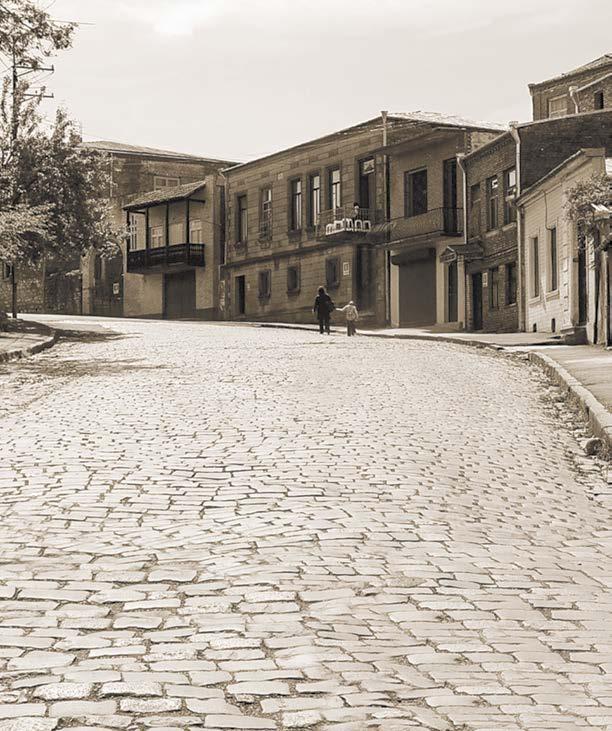
Unfortunately, the historic garden, which is located over a mere hectare of land, is being defaced by recently erected buildings which are of an inferior quality. Parking space is another problem –the garden’s pedestrian walkways are being increasingly invaded by vehicles.
It is essential for the City Council to adopt appropriate legislation concerning the Boulevard, so that it may survive the appetites of certain people coming to power at various points in time, and so that no one can arbitrarily decide to construct any buildings here, or to modify or relocate anything that is already here, or to encroach upon the vegetation or any monuments that exist here.
We must not forget that the Boulevard of Kutaisi is a living monument of a proud past, and a constituent part of great urban culture!
By Nanuli Tskhvediani

„Sroma kacis guls da sxeuls ar awuxebdes, arc simdabled iTvlebodes“ _ miaCnda sazogadoebrivi winsvlis orientirad qarTvel moazrovnes, publicists, iurists, ekonomists, finansists, sazogado moRvawesa da did praqtikoss, niko nikolaZes. Tavadac ase cxovrobda da qmnida. swored am muxlCauxreli Sromis mematianea memorialuri saxl-muzeumi qvemo imereTSi, did jixaiSSi. 1886 wels, soflis SuagulSi, ulamazes ezo-parkSi, marselis Sindisferi kramitiT daxuruli saxli augia deduleTSi, lorTqifaniZeebiseul miwa-wyalze dasaxlebul nikos. Senoba Semdeg samjer gadaukeTebia, 1910-ian wlebSi ki Svedi arqiteqtoris edmund frikis proeqtis mixedviT misTvis saboloo saxe miucia da aivnebi, marani, sardafi Tu sxva, evropidan gamowerili, ruseTis imperiis masStabiT saxlTmSeneblobaSi pirvelad gamoyenebuli betoniT mougia...
“Work should not disturb the heart and body of Man, and neither should it be considered to be beneath him” –this was the opinion of the Georgian thinker, publicist, lawyer, economist, financial expert, public figure and great practician, Niko Nikoladze. He himself lived and created by this rule, too. The memorial house museum in the village of Didi Jikhaishi, in Imereti province, is a monument to precisely this kind of tireless work. Niko, who had settled on the land of his mother’s family, the Lortkipanidzes, built a house tiled with burgundy-colored Marseilles roof tiles in 1886, in the middle of the village. He altered the structure of the house three times, and gave it its final form in the 1910s, based on a project by Swedish architect Frike. He constructed the balconies, the cellar, and the wine cellar with concrete that was shipped from Europe, unprecedented in the Russian Empire at the time...
dRes muzeumi 1340-ze met eqsponats moicavs, arsebobs mdidari biblioTekac. 1958 wlidan am saxlSi calkea ganTavsebuli kidev erTi mniSvnelovani kulturuli kera _ niko nikolaZis vaJis, maTematikosis, inJiner-metalurgis da gamomgoneblis, sportsmenis, mravalmxrivi moRvawis giorgi nikolaZis muzeumic.
„nikoobasa“ (niko nikolaZisadmi miZRvnil saxalxo dResaswaulze) Tu sxva, Cveulebriv dReebSi eqskursiaze mosuli damTvalierebelis yuradRebas ipyrobs nikos mier saqarTveloSi 1910 wels agebuli pirveli qaris Zrava (am nagebobiT xdeboda wylis meqanikuri amotumbva Widan da mamulis Senoba-nagebobebis, naTesebis wyliT momarageba); saojaxo nivTebi da sasoflo-sameurneo iaraRebi, romlebic mis mieraa evropidan Tu ruseTidan Camotanili: TeTreulis sarecxi manqana, „vermolilis“ firmis gogirdis Sesawamli manqana, boTlebis Tavsacobi manqana, berlinidan Camotanili abano, nikolaZis specSekveTiT sofel jixaiSisTvis parizSi damzadebuli mzis saaTi, rZis separatori da karaqis sadRvebi, londonSi SeZenili ponis etli, amerikaSi damzadebuli simindis saRerRi manqana, aseve amerikuli sabeWdi manqana, romelzec beWdva ramdenime enaze SeiZlebodao, „kodakis“ firmis fotoaparatis erT-erTi pirveli modeli, ruseTidan Camotanili Tivis sawnexi manqana... es nivTebi dResac sainteresoa da, advili warmosadgenia, rogor STabeWdilebas moaxdendnen isini gasuli saukunis damdegisa da ufro adrindel sazogadoebaze! XX saukunis 20-ian wlebSi, roca bolSevikur xelisuflebas niko nikolaZe „gaukulakebia“ da mis kar-midamoSi sxvani SeusaxlebiaT; bevri iSviaTi nivTi dakargula, dRemde SemorCenili eqsponatebi ki mosaxleobasa Tu saxelmwifo SenobebSi wlebis manZilze ugrovebiaT saxl-muzeumis did moamageebs _ Tina WilaZes da mis meuRles, valerian bibileiSvils. swored saxl-muzeumis erT-erTi pirveli direqtoris, qalbatoni Tina WilaZis mier 50-ian wlebSi warmoebul pirad dRiurebSia detalurad aRwerili, Tu rogor cdilobda axalgazrda qalbatoni nikoseuli nivTebis moZiebas da gadarCenas, rogor dadioda partiis centralur komitetSi, kulturis saministroSi, raionis adgilobrivi Cinovnikebis kabinetebSi, raTa rogorme gamoeglija gafantuli nivTebis saxl-muzeumisaTvis dabrunebis nebarTva. swored am adamianebis meoxebiT, dRes saTuTadaa aRdgenili da adgilmiCenili es memorialuri nivTebi.
saxl-muzeumSi damTvalierebels SeuZlia informacia miiRos niko nikolaZis mravalmxriv samecnieropublicistur, sazogadoebriv moRvaweobaze, magram, upirvelesad, aqauri fondebi didi praqtikosis sakvirveli garjis faqtebiTaa gajerebuli.
„ulmobeli saqmis kaci“ uwodebia misTvis arCil
Today this museum holds over 1,340 exhibits, and also includes a rich library. Another important cultural center has been located separately within the house since 1958 – the museum of Giorgi Nikoladze, the mathematician, engineermetallurgist and inventor, athlete, versatile public figure, and Niko Nikoladze’s son.
On Nikooba (a public celebration dedicated to Niko Nikoladze) as well as on other days, visitors to the museum will notice the first Georgian wind turbine that was built by Niko in 1910 (the structure was used to mechanically pump water out of a well and to supply water to various relatives and buildings in the region). They will also encounter family items and agricultural instruments that Niko Senior brought Giorgi from Europe or Russia: a laundry washing machine, a sulfur pesticide spraying machine of the Vermolil brand, a bottle corking machine, a bath brought from Berlin, a custom-made sundial that Niko ordered to be constructed in Paris specifically for the village of Jikhaishi, a milk separator and butter churn, an American multi-language typewriter, one of the first Kodak photo cameras, a hay press brought from Russia... These items remain interesting to this day, so it is easy to imagine how impressive they must have been for the public at the beginning of the previous century, and even earlier!
In the 1920s, when the Bolshevik government labeled Niko Nikoladze a “kulak” and allowed others to settle in his land, many rare items were lost and many of the exhibits that have survived to this day were collected and preserved by the residents, as well as the great caretakers of the house museum, Tina Chiladze and her husband, Valerian Bibileishvili. Tina Chiladze was one of the first directors of the house museum. It is from her private diaries from the 1950s that we find a detailed description of how she, as a young

jorjaZes da arc ilias, akakis, sxva did Tanamedroveebs dauSurebiaT epiTetebi mravalmxrivi da masStaburi saqveyno saqmeebis gamo.
saxl-muzeumSi stumrobisas, uwinaresad, imas getyvian, rom ciurixis universitetis kursdamTavrebuli niko nikolaZe pirveli qarTvelia, romelmac ucxoeTSi daicva sadoqtoro disertacia da samecniero xarisxi moipova (Tema: `ganiaraReba da misi socialurekonomiuri Sedegebi“). is kidev mravali aspeqtiT iyo pirveli. nikom farTo ganaTleba, gamocdileba, avtoriteti, sazRvargareTuli kavSirebi bizneswreebTan, mecnierebTan, umaRlesi donis specialistebTan _ yvelaferi gamoiyena saimisod, rom saqarTveloSi didi saerTaSoriso proeqtebi ganxorcielebuliyo. XIX saukunis 70-ian wlebSi man safuZveli Cauyara saqarTveloSi pirvel saerTaSoriso saaqcio sazogadoebas „naxSiras“, romelic Cveni qveynis wiaRiseuli simdidreebis mopoveba-damuSaveba-eqsportis sakiTxebze muSaobda da ucxoel biznesmenebTan TanamSromlobda.
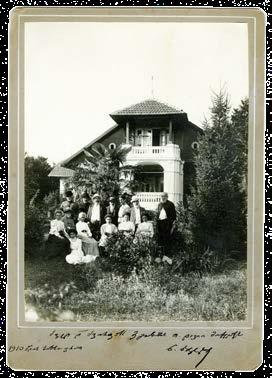
lady, tried to find and preserve Niko’s items, how she used to go to the Central Committee of the Communist Party, the Ministry of Culture, and to the offices of local district officials in order to obtain permission to return the scattered items to the house museum. It is precisely due to the support and help of these people that the memorial items are lovingly restored and kept at their rightful place today.
Visitors to the house museum can receive information on Niko Nikoladze’s multifaceted scientific, publicistic, and social work, but the local vaults are mainly replete with the results of the extraordinary exploits of Niko Nikoladze, the practician.
Archil Jorjadze called him the “relentless man of business” and Ilia (Chavchavadze), Akaki (Tsereteli), and other contemporaries also lavished him with epithets due to his many large-scale activities of national importance.
The first thing you are likely to be told while visiting the house museum is that Niko Nikoladze, who graduated from the University of Zurich, is the first Georgian to have defended his doctoral dissertation and to have received an academic degree abroad (the topic was “Disarmament and its Social-Economic Consequences”). He was a forerunner in many other respects as well. Niko used everything, including his extensive education, reputation, contacts with foreign business circles, scientists, and experts of the highest level, to facilitate the implementation of great international projects in Georgia. In the 1870s he laid the groundwork for the first international Joint-Stock Company in Georgia, Nakhshira, which worked on the extraction, processing, and exportation of natural resources, and which cooperated with foreign businessmen.
In 1872-1874, the first and longest railway line in Transcaucasia was constructed between Poti and Tbilisi under Niko Nikoladze’s direct leadership. He is also the author of the initial idea of transporting oil from Baku to Georgian territory, as well as of the Baku-Batumi oil pipeline project. In the 1880s he brought the Rothschilds, the French millionaires, to Georgia and convinced them to fund and implement this project, within the framework of which the Tsipi tunnel, and the railway line that ran through it, were built at the Rikoti Pass (1884-1888). Together with them, he ran the construction and, subsequently, the operation of the BakuBatumi oil pipeline for many years. In the latter part of his lifetime, in 1926-1927, he conceived the project of one more oil pipeline, between Grozny and Poti. While discussing the project with the Nobel brothers, he strongly defended his position on the necessity for both pipelines to go through Georgian territory. Upon Niko Nikoladze’s request, the German engineer and entrepreneur Bunge conducted the first process of simultaneously making a telephone call and sending a telegram over a single telegraph line in the world, using the Tbilisi-Kojori line in Georgia.
In 1878-1892, Niko Nikoladze was elected as a voting member at the Tbilisi City Council four times. During this time he implemented a number of large-scale projects in the capital,
1872-74 wlebSi niko nikolaZis uSualo xelmZRvanelobiT gayvanili iqna amierkavkasiaSi pirveli da yvelaze grZeli, foTi-Tbilisis sarkinigzo magistrali. masve ekuTvnis baqos navTobis saqarTvelos teritoriaze tranzitis Tavdapirveli ideac da baqobaTumis navTobsadenis proeqtic. XIX saukunis 80-ian wlebSi man saqarTveloSi Camoiyvana frangi milionerebi _ rotSildebi, daafinansebina da ganaxorcielebina es proeqti, romlis farglebSic aigo wifis gvirabi rikoTis uReltexilze, masSi ki _ rkinigzis magistrali (1884-88 ww.). igi wlebis manZilze maTTan erTad xelmZRvanelobda baqo-baTumis navTobsadenis jer mSeneblobas da Semdeg _ funqcionerebas. sicocxlis bolos _ 1926-27 wlebSi _ SeimuSava kidev erTi navTobsadenis _ grozno-foTis _ proeqti. Zmeb nobelebTan kamaTisas mudam mtkiced icavda Tavis pozicias orive navTobsadenis usaTuod saqarTvelos teritoriaze gavlis Sesaxeb. niko nikolaZis TxovniT, germanelma inJiner-mewarme bungem, msoflioSi pirvelad, swored saqarTveloSi, Tbilisi-kojris telegrafis xazze ganaxorciela erT xazSi telefoniT laparakisa da depeSebis erTdroulad gadacemis procesi.
1878-92 wlebSi, niko nikolaZe oTxgzis iyo arCeuli Tbilisis qalaqis sabWos xmosnad. man am periodSi araerTi masStaburi proeqti ganaxorciela dedaqalaqSi, maT Soris: Tbilisis quCebis eleqtroficireba; 1883 wlidan Tbilisis pirveli sazogadoebrivi transportis _ cxenis tramvais, anu `konkas~ SemoReba, 1903 wlidan _ eleqtrotramvais amoqmedeba; veris xidis mSenebloba; avWalis wyalsadenis gaxsna (manamde Tbilisis mosaxleoba mtkvridan TuluxCebis mier amotanil wyals svamda); 1913 wels Tbilisis pirveli eleqtrosadguris gaxsna da mravali sxva.
niko nikolaZes udidesi wvlili miuZRvis funikuliorisa da sabagiro gzis mSeneblobaSi. man saberZneTidan Camoitana saSeni masala, riTac sabagiro gza aages. niko nikolaZea avtori e.w. `aramiancisa~ da gogirdis abanoebze balneologiuri kurortis mSeneblobis proeqtebisa.
niko nikolaZis gardacvalebis Semdeg ganxorcielda misi kidev ramdenime masStaburi proeqti _ Tbilisis centralizebuli kanalizaciis gayvanis da nataxtarbulaCauris wyalsadeniT Tbilisis momaragebis; masve ekuTvnis Tbilisis zRvis proeqtic (niko nikolaZes surda, dRevandeli Tbilisis zRvis adgilas, mSrali da Sxamiani haeris gadatexisa da klimatis gaumjobesebisTvis, Seqmniliyo xelovnuri tbebis kaskadi. mogvianebiT, 50-ian wlebSi es proeqti gacilebiT masStaburad ganaxorcielda da tbebis nacvlad uzarmazari xelovnuri wyalsacavi gaSenda). da mainc, niko nikolaZis yvelaze didi Zalisxmeva foTTan da mis portTanaa dakavSirebuli. es iyo
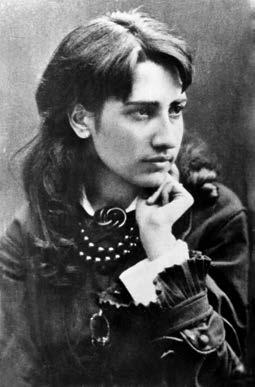
including: constructing electricity infrastructure along the roads of Tbilisi; establishing the first form of public transportation in Tbilisi, a horse-drawn tram, or Konka, in 1883; introducing the electricity-powered tram in 1903;constructing the Vere Bridge; opening the Avchala water supply system (until then the residents of Tbilisi drank the water that was distributed by water carriers from the Mtkvari River); opening Tbilisi’s first power station in 1913, and so forth.
Niko Nikoladze made major contributions to the construction of the funicular and the aerial tramway. He brought the construction material for the aerial tramway from Greece. Niko Nikoladze authored the projects of the so-called Aramiants Hospital and the Balneology Resort, which was built on Tbilisi’s sulfur springs.
A number of Niko Nikoladze’s large-scale projects were implemented after his passing. Examples of this are the creation of a centralized sewage system and the supplying of drinking water for Tbilisi via the Natakhtari-Bulachauri water supply system. The project of the Tbilisi Sea also belongs to him (Niko Nikoladze
saukunis proeqti, romliTac ganaxorciela misi axalgazrdobis droindeli miswrafebebic da siWarmagis gamocdilebac.
„ulmobelma saqmis kacma“ foTi rom Caibara, maSin qalaqis biujeti 75 aTas maneTs Seadgenda; roca mtrebma usafuZvlo braldebebiT, iZulebiT daatovebines Tanamdeboba, qalaqis `didi qisa~ ukve 723 300 maneTiT „gaberiliyo.“ istoriis furclebs SemorCa isic, rom foTis `qalaqisTavma~ niko nikolaZem 1896 wels dabeWda ruseTis imperiis masStabiT pirveli samprocentiani obligacia _ didi saporto qalaqis asaSeneblad, 1 400 000 maneTis odenobiT: daawesa pirveli sabaJo („safuTo“) naxevarkapikiani gadasaxadi, riTac xeli Seuwyo qalaqis keTilmowyobas.
foTis TviTmmarTvelobis ganawesiT niko nikolaZem imperiaSi pirveli precendenti dauSva damoukidebeli ekonomikuri regionis Seqmnisa (dRevandeli „Tavisufali ekonomikuri zonis“ winamorbedi) _ portic da qalaqic sakuTar Tavs TviTon ifinansebda da saxelmwifo xazinaSic sakmao gadasaxadi Sehqonda. dabolos _ jixaiSi! sadac niko nikolaZe 35 wlis ganmavlobaSi praqtikulad xorcs asxamda ideebis mniSvnelovan nawils, sakuTari meurneoba didmniSvnelovan sacdel sadgurad aqcia. 1894 wels misi xelmZRvanelobiT gayvanili xonis sarwyavi arxi, romelmac iqauri miwebi gaacocxla, faqtobrivad, pirveli sarwyavi sistemaa mTel dasavleT saqarTveloSi. niko cdilobda eleqtrifikaciis danergvas soflis meurneobaSi. pirvelma Semoiyvana da gaavrcela mravali qveynis sxvadasxva jiSis frinveli da cxoveli. TanamedroveTa mogonebebiT, nikos mamulSi naxavdiT: maltur Txas, ruanis ixvs, iorkSiris Rors, espanur virs, holandiur Zroxas, senbernaris jiSis ZaRlebs da sxva. ezo-parkSi ki dRemdea daculi: seqvoia, araukaria, qonis xe, sapnis xe, korpis muxa, amerikuli kakali da sxva unikaluri mcenareebi. 1897 wels niko nikolaZes sasoflo-sameurneo gamofenaze warudgenia mis mier Camotanili da Tavis mamulSi cocxal Robeebad gavrcelebuli trifoliati (mware limoni), romelsac adgilobrivebi „nikolaZis ekals“ eZaxdnen. 1913 wels peterburgSi mowyobil gamofenaze man foTis baRidan da jixaiSidan SerCeuli eqsponatebi gagzavna. sanimuSod hqonda gaSenebuli Tavisi tye. holandiis magaliTze man melioraciisa da irigaciis magaliTebic uCvena Tanasoflelebs. cnobilia misi ojaxis wvlili dasavleT saqarTveloSi meabreSumeobis ganviTarebaSi. didi amagi dasdo nikom saqarTveloSi mevenaxeobisa da meRvineobis ganviTarebasac _ sakoleqcio nakveTze, vazis sxvadasxva jiSi hqonda gaSenebuli. 1912 wels niko nikolaZem aRZra sakiTxi „quTaisis meRvineTa aqcioneruli sazogadoebis“
wanted to create a cascade of artificial lakes at the current location of the Tbilisi Sea, in order to neutralize dry and poisonous air and to improve the climate. Later, in the 1950s, this project was implemented on a much larger scale, and one immense artificial reservoir was created in place of the lakes).
And still, Niko Nikoladze’s greatest efforts are connected with Poti and its port. This was the project of the century, with which he realized the aspirations of his youth as well as the experience of his later years.
When the “relentless man of business” took over Poti, the city budget consisted of 75,000 rubles. When enemies forced him to leave his position due to unfounded accusations, the city coffers had increased by 723,000 rubles. History remembers that for the first time in the Russian Empire, the Poti city head, Niko Nikoladze printed 3% bonds, amounting to 1,400,000 rubles, in order to build a great port city: he established the first half-kopek (by pound of weight) customs duty, with which he facilitated the city’s development.
Through Poti local government regulations, Niko Nikoladze created the first precedent of an independent economic region within the Russian Empire (which is a predecessor of the contemporary free economic zone) – both the port and the city were self-funding, and made significant payments to the state treasury.
And finally – Jikhaishi! Where Niko Nikoladze practically realized an important part of his ideas over a period of 35 years, and where he fashioned his household into an important experimental station. The Khoni irrigation channel, which was constructed in 1894 under his leadership and which revived the lands in the region, is in fact the first irrigation system in all of western Georgia. Niko tried to introduce electricity to the agricultural process. He introduced and ensured the propagation of various plant and animal species from different countries. According to his contemporaries, you could find Maltese goats, Rouen ducks, Yorkshire pigs, Spanish donkeys, Dutch cows, Saint Bernard dogs, and various other animals on his grounds. And sequoias, araucarias, tallow trees, red ashes, cork oaks, American walnut trees, and other unique species of plants are still protected in the park to this day.
At an agricultural exhibition in 1897, Niko Nikoladze presented the trifoliate (bitter lemon), which he had brought from abroad and planted as a live hedge on his estate. The locals called it “Nikoladze’s Thorn.” In 1913, he sent choice exhibits from the Poti garden and from Jikhaishi to an exhibition held in Saint Petersburg. He had planted his own model forest. Using the example of the Netherlands, he showed his fellow villagers examples of land improvement and irrigation. His family’s contribution to the development of seri-culture in western Georgia is well known. Niko also put in a great deal of effort towards the development of viticulture and winemaking in Georgia, cultivating various species of the grapevine on a collection plot. In 1912, Niko Nikoladze raised the issue of
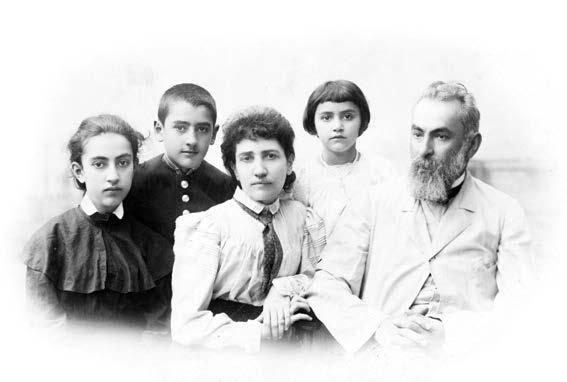
daarsebis Sesaxeb, rac miznad isaxavda Rvinis sardafebis mowyobas quTaissa da zestafonSi. did jixaiSSi, nikos saxlis qveS, dRemde SemorCenilia betoniT naSeni Rvinis sardafi, sadac qvevrebsa da muxis kasrebSi inaxeboda Rvino. did jixaiSSi nikom pirvelma SemoiRo xilis Rvinis damzadeba, rac sagangebod Seiswavla safrangeTSi. niko nikolaZe mudam cdilobda, daxmareboda Tanamemamuleebs siaxlis Secnobasa da praqtikul danergvaSi, glexobaSi gaeRvivebina Svilebis swavlaganaTlebisadmi interesi. 1925 wels, swored misi moTxovniTa da rCeviT, nikolaZianT „gakulakebul“ mamulSi gaixsna dabali safexuris sasoflo-sameurneo skola, romelic 1930 wels teqnikumad gadakeTda... niko nikolaZe Rrma siberemde `ebrZoda~ saqmes. axali Taoba, albaT, misi magaliTiT unda swavlobdes qveynis msaxurebas, Sromis siyvaruls, progresuli azrovnebis kulturas. istoriis nebismier saskolo saxelmZRvanelos daamSvenebda dokumenturi masala didi mamuliSvilis, „ulmobeli saqmis kacis“, niko nikolaZis moRvaweobis Sesaxeb.
nanuli cxvediani
establishing the Kutaisi Winemakers’ Joint-Stock Company, which aimed to create wine cellars in Kutaisi and Zestaponi.The concrete wine cellar in which wine was preserved in Qvevris (traditional Georgian clay vessel for storing wine) and wooden casks survives to this day under Niko’s house in Didi Jikhaishi. Niko introduced the making of fruit wines which he had learned in France.
Niko Nikoladze always tried to assist his fellow countrymen with the comprehension and practical implementation of innovation, and to encourage farmers to see the importance of education for their children. At his insistence and recommendation, a basic school of agriculture was founded in the Nikoladze kulak estate in 1925, and was made into a technical college in 1930.
Niko Nikoladze worked hard all the way through to his old age. New generations should learn the service of their country, the love of work, and the culture of progressive thought from his example. Any school history textbook would do well to include documentary material on the life of Niko Nikoladze, the great patriot, the “relentless man of business.”
Nanuli Tskhvediani
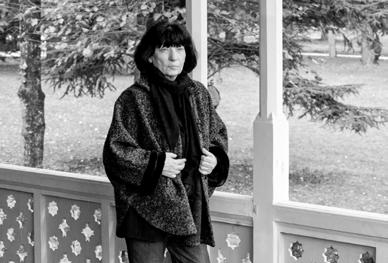
imisTvis, rom srulfasovnad gaigo eliso virsalaZis fenomeni, unda daeswro mis cocxl koncerts, SeigrZno atmosfero, romelsac is dResac im maRali saSemsruleblo eTikiT qmnis, warsulis did pianistebs rom axasiaTebdaT... misi yoveli koncerti, TiTqos, auxsneli, amoucnobi ritualia.
TelavSi musikis saerTaSoriso festivalis aRdgenis Semdeg ukve meeqvse welia eliso virsalaZe da misi wre, erTgul msmenelTan erTad, am ritualis Tanaziars axal Taobebsac xdis. Taobebs, vis Tvalwinac ar gauvlia pianistis SemoqmedebiT gzas da romelTa mexiserebisTvisac ucxoa is Soreuli 1957 wlis koncerti Tbilisis konservatoriis mcire darbazSi, sadac TxuTmeti wlis eliso virsalaZe pirvelad warsdga msmenelis winaSe solo programiT.
XX saukunis didi piansitis, sviatoslav rixteris dabadebidan 100 wlisTavisadmi miZRvnili wlevandeli klavirabendi TelavSi im legendis gagrZeleebaa, romelic virsalaZeebis ojaxSi didi xnis win daibada, rodesac elisos didedam da qarTuli safortepiano skolis erT-erTma fuZemdebelma, anastasia virsalaZem pirveli gakveTilebi Cautara SviliSvils...
In order to fully understand the phenomenon that is Eliso Virsaladze, you would have to attend her live concert, to partake of the atmosphere that she creates even today with her high level of performance, which used to be characteristic of the great pianists of the past. Her every concert seems to be an inexplicable, mysterious ritual.

For six years now, ever since the restoration of the Telavi International Music Festival, Eliso Virsaladze and her circle, together with her faithful audience, allow the younger generations to share in this ritual as well. These generations have not witnessed the pianist’s creative path and they do not remember the distant year of 1957 when the fifteen-year-old Eliso Virsaladze first performed a solo programme in front of an audience at the recital hall of the Tbilisi State Conservatoire.
This year’s piano recital in Telavi, which was dedicated to the 100-year anniversary of the birth of Sviatoslav Richter, a great pianist of the 20th century, is a continuation of the legend that was born in the Virsaladze family a long time ago, when Anastasia Virsaladze, Eliso’s grandmother and one of the founders of the Georgian piano school, started tutoring her small granddaughter.
Tavidan didedas ar undoda Cemi swavleba, amitom daviwye SedarebiT gvian, maSin eqvsi wlidan iwyebdnen swavlas, axla _ xuTidan iwyeben, me ki mxolod rva wlisa movxvdi bavSvebis im mcirericxovan rigSi, visac dideda amecadinebda. Cveulebriv, dideda bavSvebTan ar muSaobda.
Tu hqodna mas swavlebis raime meTodi, xom ar iyenebda egreTwodebul leSetickis meTods, romelic SesaZloa leSetickis mowafisgan da meuRlisgan, ana esipovasgan eswavla Tavad? swavlebis meTodi saerTod ar arsebobs, arsebobs
At first grandma did not want to teach me, which is why I began relatively late. At the time, they used to start piano lessons at the age of six, now they even start at the age of five; however, I was already eight when I joined the small group of children that my grandmother tutored. Grandma did not normally work with children.
Did she have a specific method of tuition? Did she use, for instance, the so-called Leschetizky method, which she could have learned from Leschetizky’s spouse and pupil, Anna Yesipova?

im adamianTa gavlenebi, visTanac urTierTob. dideda yoveldRe igonebda peterburgSi ana esipovas klasSi gatarebul wlebs. skolebis arsebobis ki me saerTod ar mjera, rac ufro memateba wlebi, miT ufro. ras niSnavs franguli, rusuli an amerikuli skola? aris kargi da cudi skolebi. rasakvirvelia, garkveuli Tvisebebi axasiaTebs frangul skolas, magram es imas ar niSnavs, rom am skolis warmomadgenlebi sxvebze ukeT ukraven frangul musikas. an Tundac imas, rom moskovis konservatoriaSi ukeT esmiT rusi kompozitorebis musika. 1958 wels Caikovskis konkursze, rodesac ven klaibernma Seasrula Caikovksis da raxmaninovis safortepiano koncertebi, aleqsandr goldenvaizerma, romelsac Tavad raxmaninovis Sesruleba hqonda mosmenili, megobrobda lev tolstoisTan da ukravda misTvis, Tqva, rom ar egona, Tu kidev mouxdeboda aseTi interpretaciis mosmena.
ramdenad vrceldeba didi pedagogebis gavlena studentebze?
yvela profesors aqvs Tavisi xedva interpretaciasa da Sesrulebis maneraze; henrix neihauzi Tuki atyobda, rom mowafe iyo niWieri, xolo Sesruleba damajerebeli, arasdros cdilobda Tavze moexvia miseuli interpretacia an SeezRuda misi fantazia. arc dideda iqceoda ase, masac hyavda ufro metad da naklebad niWieri mowafeebi. es sakuTar Tavzec gamomicdia _ rac ufro niWieria mowafe, miT ufro met Tavisuflebas aZlev mas, miuxedavad im Secdomebisa, rac SeiZleba iyos mis SesrulebaSi. maSin rodesac naklebad niWierebi ufro skrupulozurad misdeven pedagogis rCevebs da ukeTes Sefasebebsac iReben gamocdebze da gansakuTrebiT konkursebze.
Tqveni pirveli repertuari Tavisufali iyo etiudebisa da gamebisgan, SesaZloa aseTi midgoma iyos universaluri? musikaSi araferi ar aris universaluri; repertuaris mxriv unda iyos mravalferovneba, erTi da imave asakis mowafeebs SeiZleba sxvadasxva sirTulis nawarmoebebi misce, Tumca arsebobs garkveul asakSi garkveuli sirTuleebis daZlevis aucileblobac, raTa mowafes hqondes is sabaziso codna da teqnika, rac daexmareba mas samomavlod. arsebobda meToduri kabinetebis damuSavebuli qrestomaTiebic, sadac CamoTvlili iyo nawarmoebebi, romlebic sxvadasxva klasSi unda Segesrulebina. axlac aris aseTebi, rac sabWouri skolis gadmonaSTia. Rimilis momgvrelia, rom meTodurma kabinetma raime gavlena moaxdinos saswavlo procesze.
dRes ukve sakmaod adreul asakSi ukraven rTul repertuars... maxsovs, rodesac ToTxmeti-TxuTmeti wlis viyavi,
There is no such thing as a teaching method; there is only the influence of the people with whom you communicate. Grandma always used to recall the years she had spent in Saint Petersburg, being taught by Anna Yesipova. I, on the other hand, do not believe in schools of music and the older I get the more certain of this I become. What does a French, Russian, or American school mean? There are good and bad schools. Naturally, there are certain features that characterize the French school but this does not mean that representatives of this school are better at performing French music than others. It also cannot be said that people understand the music of Russian composers better at the Moscow Conservatoire. At the Tchaikovsky competition in 1958, when Van Cliburn performed piano concertos by Tchaikovsky and Rachmaninoff, Alexander Goldenweiser, who had listened to the performance by Rachmaninoff himself, and who was a friend to Leo Tolstoy and used to perform for him, said that he did not think he would have been able to listen to such an interpretation again.
To what extent do great teachers influence their students?
Every professor has his or her own view on interpretation and the manner of performance. When Heinrich Neuhaus saw that a student was talented, and the performance was convincing, he never tried to force his own interpretation, or to limit the student’s imagination. Grandma was the same. She also had students, some of whom were more talented than others. I have experienced this myself as well – the more talented a student is, the more freedom you allow him in spite of the mistakes that he may make during the performance. Meanwhile, less talented students are more meticulous in following the teacher’s instructions, and they usually get better evaluations at examinations, and particularly at competitions, too.
Your first repertoire was free of etudes and scales. Can such an approach be universal?
Nothing in music is universal. In terms of the repertoire, there should be diversity. It is possible to give students of the same age works of various difficulties to perform. However, it is also necessary to overcome certain difficulties at a specific age, in order for a student to attain the basic level of knowledge and technique that will help him or her in the future. The office of methodology also used to provide chrestomathies, which contained lists of works that should be performed at various grades. Such things still exist today, though they are relics of Soviet times. It is an amusing thought that such offices of methodology could influence the tuition process.
Today, fairly complex repertoires are being performed at rather an early age...
I remember that when I was 14 or 15 years old, grandma asked Neuhaus about the works that she could give me to perform. His answer was that I should be allowed to play what I wanted to play. However, grandma did not give me very difficult pieces as she believed that anyone, at any age, whether it is a student or a pupil,
dideda ekiTxeboda neihauzs, Tu ra nawarmoebebis mocema SeiZleboda CemTvis. igi pasuxobda _ mieciT is, risi dakvrac mas surs. Tumca, dideda arasdros maZlevda Zalian rTul nawarmeobebs, radgan Tvlida, rom nebismier asakSi, mowafe iqneba es Tu studenti, unda ukravdes ise, rom Sesrulebis done uaxlovdebodes nawarmoebis amocanas, xolo, didedis moTxovnebi yovelTvis maqsimalurad mkacri iyo.
rogoria Tqveneuli repertuaris sazRvrebi, adreuli da uaxlesi musika; da samomavlo repertuari? adrindelebidan dakruli maqvs ramos, kuperenis da baxis musika; uaxlesi solo programidan, albaT, prokofievis merve sonata da SostakoviCis ocdaoTxi preludia.
rac Seexeba mimdinare repertuars, axla minda raxmaninovis dakvra. gasuli saukunis 80-ianebSi vukravdi meore da mesame safortepiano koncertebs, bolo dros aRar _ ara imitom, rom ar mindoda, ubralod, rodesac gaqvs vrceli repertuari da daZabuli sakoncerto gegma, Znelia im musikisTvis gamonaxo dro, romlis dakvras im konkretul momentSi ar iTxoven. amitom, xSirad, imisTvis rom mivuaxlovde ama Tu im nawarmoebs, vcdilob mivce isini studentebs.
nawarmoebis swavlisas Tu iyenebT romelime konkretul redaqciebs?
arc erT konkretul redaqcias ar vaniWeb upiratesobas. pianisti, romelic ukravs beThovenis sonatebs, unda icnobdes yvela cnobil redaqcias. magaliTad, hans fon biulovisas _ Zvel, magram Zalian sainteresos. rac Seexeba Sopens, axla gamodis ian ekeris uaxlesi redaqciiT da yvela, vinc apirebs Sopenis varSavis konkursSi monawileobas, valdebulia swored es redaqcia gamoiyenos nawarmoebebis swavlisas. gamodis, rom kortoc, neihauzic da kempfic arasworad ukravdnen... baxis SemTvevaSi aris mxolod dedani, is rac Tavad baxma dawera _ `sufTa~ notebi, romelsac aranairi dinamikuri miniSnebebi ara aqvs. yvelaferi danarCeni ubralod unda daviviwyoT. rac Seexeba urteqsts, gamoicema bevri, romlebic TiTqos avtoriseul dedans efuZneba da aqvs pretenzia iyos erTderTi da zusti, magram iciT rogori sxvaobaa maT Soris da ramdeni Secdomaa?
TbilisSi gagimarTavT monografiuli koncertebi: beThovenis safortepiano koncertebis cikli, sonatebi Celosa da fortepianosTvis, Subertis eqspormtebis ciklebi...
damikravs, magram es ar aris kargi arc SemsruleblisTvis da arc msmenelisTvis, radgan

should play so that the level of performance is close to the aim of the piece. Grandma’s requirements were always as strict as possible.
What is the range of your repertoire, in terms of early and contemporary music, and what is your future repertoire to be?
From the old ones I’ve played pieces by Rameau, Couperin, and Bach. And in my latest solo programme I played Piano Sonata No. 8 by Prokofiev and the 24 Preludes by Shostakovich.
As concerns my current repertoire, I want to play Rachmaninoff. In the 1980s I played his Piano Concertos No. 2 and No.3 but I haven’t done so lately – not because I did not want to but simply because when you have an extensive repertoire and a rigid concert plan, it is difficult to find the time for a musician that is not in high demand at the moment. Because of this, in order to get closer to a piece, I try to give it to my students.
Do you use any specific editions while studying a piece?
I do not prefer any specific editions. A pianist that plays Beethoven’s sonatas should be familiar with all famous editions. For example, those by Hans Von – Bülow, which are old but very interesting. As concerns Chopin, a new edition by Jan Ekier is being produced now and everyone who intends to participate in the Chopin Competition in Warsaw must use this edition in order to study the pieces. It would seem that Cortot, Neuhaus, and Kempff all played incorrectly... In Bach’s case, there is only the original that Bach wrote himself – pure sheet music without any dynamic indications at all. We should simply forget everything else. As regards urtext editions, many of these are published, they are supposedly based on the author’s original works and claim to be the only precise ones, but do you know how many differences there are between them, and how many mistakes they contain?
You have held the following monographic concerts in Tbilisi: The complete Piano Concertos by Beethoven’s, sonatas for cello and piano, the complete Impromptus by Schubert... I have played them but this is not good for either the performer or the audience as each of them is so deep in terms of meaning that
Sinaarsobrivad imdenad Rrmaa TiToeuli, rom did daZabulobas moiTxovs ara marto Semsruleblisgan, aramed msmenelisaganac. Cemma studentma, boris berezovskim daukra beThovenis yvela koncerti erT saRamoSi, mec erT saRamoSi maqvs dakruli 1970 wels beThovenis 200 wlis iubileze, Tumca es mxolod erTxel moxda.
bisze Sesasrulebel musikas Tu amzadebT winaswar? arasodes, ubralod maqvs mTeli rigi nawarmeobebi mzad da rodesac koncertis ZiriTadi programa mTavrdeba, maSin virCev romelimes maTgans.
Tqven, iseve rogorc sviatoslav rixterma uari TqviT studiur Canawerebze... sxvaTaSoris, maSin rodesac Sevwyvite studiuri Cawerebi, ar vicodi Tu rixteric ase moiqca; is sakmaod didxans werda studiaSi. saqme isaa, rom Zalian didia sxvaoba cocxal Sesrulebasa da studiur Canawerebs Soris, romelSic dakargulia Sesrulebis manera, darbazis atmosfero. Tu SevadarebT artur rubinStainis Sumanis fantastikuri piesebis studiur da sakoncerto Canawerebs, gagviWirdeba Tqma, rom es erTi da igive pianisitia.
dRes Secvlilia damokidebuleba; rodesac Cemi studentebi usmenen alfred kortos Canawerebs, iTvlian ramdeni usufTao noti aqvs, da es marTlac asea. Tu usmen, ramdenad sufTadaa Sesrulebuli teqsti, maSin verafers gaigeb, Tqven warmoidgineT, horovicsac aqvs iseTi Canawerebi, rom gagiWirdebaT dajereba rom horovicia, imdenad usufTaodaa Sesrulebuli.
am SemTxvevaSi gamonaklisia arturo benedeti mikelanjeli...
imitom, rom rogorc Cemi profesori iakov zaki ambobda, mikelanjeli mona iyo Tavisi teqnikis, mas hqonda srulyofilebamde miyvanili mwiri repertuari, ris gamoc igi arasdros momwodna, miuxedavad imisa, rom aRmafrTovana misma Sesrulebis xarisxma moskovis koncertebze.
konkursebi, rogorc samwuxaro aucilebloba... rixteris saxelobis konkursi... samwuxarod, konkurss alternativa dRes ar aqvs, es faqtia. is Semosavlis erTaderTi wyaroa studentebisTvis, riTic maT Tundac garkveuli periodiT finansurad unda uzrunvelyon Tavi, rom Semdeg SeZlon repertuarze muSaoba. rixteris saxelobis konkursis idea swored sxva konkursebis alternativas warmoadgenda. magram, rodesac davinaxeT, rom Cveni laureatebi konkursisgan ver iReben im Sedegs, rasac vvaraduobdiT, konkursi
they require a great deal of tension not only from the performer but also from the listener. Boris Berezovsky, my student, played all of Beethoven’s concertos in one evening; I also played them in 1970, at Beethoven’s 200th Jubilee, though this happened only once.
Do you prepare the pieces to be played as an encore in advance?
Never. I simply have a series of pieces that I know, and I choose one of them when the main programme of the concert is finished.
Like Sviatoslav Richter, you have refused to do studio recordings...
When I refused to do studio recordings I did not know that Richter had done the same thing; he had spent a lot of time recording in the studio. The point is that there is a huge difference between a live performance and a studio recording, in which the manner of performance, and the atmosphere of the hall, are both lost. If we compare the studio and concert recordings of ArthurRubinstein performing Schumann’s Fantasiestücke / Fantasy Pieces, we might find it hard to believe that the same pianist is playing both.
The attitude is different today. When my students listen to recordings of performances by Alfred Cortot, they count the number of wrong notes, and this is true. If you listen to determine how cleanly the text is performed, you will not understand a thing. Even Horowitz has such recordings, where you would find it difficult to believe that it is Horowitz who’s playing because the performance is not as clean as you would have expected.
In this sense, Arturo Benedetti Michelangeli is an exception... That is because, as my professor Yakov Zak used to say, Michelangeli was a slave of his technique; he had a small repertoire that he had honed to perfection and this is the reason why I never liked him, despite the fact that I was amazed by the quality of his performance at the recitals in Moscow.
Competitions are an unfortunate necessity... The Richter Competition...
Unfortunately, it is a fact that there is no alternative to competitions these days. They are the single source of income for students, which they should be able to use to provide for themselves for a while in order to then be able to work on their repertoire.
“The idea behind the Richter Competition was to provide an alternative to other competitions. But when we saw that our laureates to achieve the anticipated results, we chose not to continue with the competition. However, if I’d had a team similar to the one that I have for the Telavi Festival, the Richter Competition would probably have gone on.
Do competitions facilitate the development of a standard performer?
It is possible... Earlier they did, but this is no longer true today. For
aRar gavagrZeleT. Tumca, iq rom myoloda iseTi gundi, rogoric Telavis festivalze myavs, rixteris konkursi, albaT, gagrZeldeboda.
uwyobs Tu ara konkursebi xels standartuli Semsruleblis tipis Camoyalibebas?
SesaZlebelia... adre uwyobda xels, dRevandel dRes ukve aRar. magaliTad geza andas saxelobis konkursze, romlis Jiuris wevric viyavi wels, pirveli premia mieniWa amerikel endriu taisons, romelic absoluturad ar jdeba standartuli sakonkurso pianistis CarCoebSi.
xom ar zRudavs konkursebi axalgazrdebs repertuaris mxriv?
dasaSvebia, Tumca amas ver vityvi geza andas konkursze, sadac mocemulia mTeli rigi kompozitorebisa da nawarmoebebis CamonaTvali da winaswar ar iciT ris Sesrulebas mogTxoven. am mxriv es konkursi unikaluria, radgan, garda kargi momzadebisa, unda flobdeT vrcel repertuarsac.
scodavs Tu ara Jiuri? rasakvirvelia, xSirad Jiuri Zalian did mniSvnelobas aniWebs msmenelis reaqcias, iwyebs flirts msmenelTan, rac saSinelebaa.
yvelaze Zlier musikalur saswavleblad isev migaCniaT Tu ara moskovis konservatoria? diax, Tumca samwuxarod, dRes aRaraa im donis, rogoric adre iyo. uaresia juliardis skolis SemTxveva, aranairi Sedareba ar SeiZleba warsulis juliardTan, sadac levinebi aswavlidnen. dRes SeiZleba Zalian kargi profesori iyos nebismier universitetSi da iq specialurad masTan midiodnen saswavleblad. es praqtika gamrTlebulia, radgan swavleba damokidebulia pirovnebebze da ara sistemaze. magaliTad, zalcburgis mocarteumSi ramdenime wlis win safortepiano skola ar iyo im donis, rogorisac dRes aris, imitom rom axla mivida ramdenime iseTi profesori, romlebic izidaven studentebs.
Tu iyo valdebuleba an iZuleba sabWoTa kavSirSi im garkveuli nawarmoebebis Sesrulebisa, romlebic ar gsurdaT? rasakvirvelia, filarmonias hqodna Tavisi gegma, Tu sazRvargareT midiodiT, programas aTanxmebdiT `goskoncertTan~, romelSic aucileblad unda CagerToT sabWoTa kompozitoris nawarmoebi. iZulebiT ki maSinac aravin arafers gaiZulebdaT. maxsovs, Cemma profesorma miTxra, Tu ginda moskovSi binis miReba, unda daukra tixon xrenikovis safortepiano koncertio, ar davukari da verc bina miviRe.
example, at the Concours Géza Anda, at which I was a jury member, the American pianist Andrew Tyson won first place, and he most certainly was not a standard competition pianist.
Do competitions restrict young performers in terms of their repertoire?
It is possible, though I cannot say this about the Concours Géza Anda, at which performers are provided with an entire list of composers and pieces, and they do not know in advance which one they will be required to perform. In this sense this competition is unique, as, in addition to being well-prepared, you should also possess an extensive repertoire.
Does the jury make mistakes?
Naturally, oftentimes the jury attaches a great deal of importance to the audiences’ reaction or starts flirting with the listener, which is terrible.
Do you still consider the Moscow Conservatoire as the strongest institution of musical education?
I do, though unfortunately today it is no longer at the level it used to be. The case of the Juilliard School is even worse; it cannot be compared at all with the Juilliard of the past, where the Lhévinnes used to teach. Today, any university can have a very good professor, and students may go there specifically to study under him or her. This is common practice as music tuition depends on the person and not on the system. For example, the school of piano at the Mozarteum University in Salzburg did not use to be of the level that it is today because now they have a number of professors that speciffically attract students.
During Soviet times, were you compelled or forced to perform pieces that you may not have wanted to perform?
Of course, the Soviet Philharmonic had its own plan. If you went abroad, you had to coordinate your programme with the Goskontsert (State Concert Association of the USSR) and you had to include works by Soviet composers. As regards being forced to do it, no one ever forced you to do anything then. I remember my professor once told me that if I wanted to receive an apartment in Moscow, I had to play Tikhon Khrennikov’s piano concerto. I did not play it and, correspondingly, did not receive an apartment in Moscow.
Do you get a chance to perform in remote locations? This in itself is a great kindness as people there miss music more than the people in big cities...
This is a great kindness for me as well, perhaps even more so than for the audience. At that time, you realize that what you are doing is essential, much more so then when you play in big cities and great halls.
Your student, Boris Berezovsky, said in an interview that a woman will never be able to play like a man...
giwevT xolme periferiebSi dakvra? rac TavisTavad didi sikeTea, iq xom xalxs ufro metad enatreba musika, vidre did qalaqebSi...
es CemTvisac sikeTea, SeiZleba ufro metadac, vidre maTTvis, visTvisac vukrav. am dros gesmis, rom rasac akeTeb, es aucilebelia, gacilebiT ufro metad, vidre did qalaqebSi da darbazebSi dakvra.
Tqvenma mowafem, boris berezovskim interviuSi Tqva, rom qali veradros daukravs ise, rogorc mamakaci... es namdvilad asea, qali ver daukravs kaciviT da piriqiT, kaci ver daukravs qaliviT. Tu igulsixma SesaZleblobebi, mamakac piansitebs Sorisac aris didi sxvaoba. risi Zalac Seswevs TviTon berezovskis, bevri sxva pianistisTvis SeiZleba dauZleveli sirTule iyos. sasaciloa amis Tqma, rodesac paganini-listis etudebi eZRvneba klara Sumans, rac niSnavs, rom listis drosac ki warmodgena pianist qalebze Zalain maRali iyo.
kulturis politika da xelovnebis dargebis subsidireba...
Zalian xSirad momyavs xolme fineTis magaliTi, Tu ratom miaRwia dRes aseT Sedegs am qveynis saSemsruleblo xelovnebam, ratom aqvT aseTi miRwevebi? mxolod imitom, rom iyo saxelmwifo dafinanseba _ esaa erTaderTi axsna. espaneTs rom hqonoda aseTi dafinanaseba adre, dRes masac eyoleboda ukeTesi Semsruleblebi da diriJorebi, Tumca, 90-ianebis dasawyisSi madridSic Seiqmna dedofal sofias skola, rac samomavlod aucileblad gamoiRebs Sedegs.
Telavis festivalis amocana, koncertebi da Ria gakveTilebi...
Telavis festivalis mTavari amocana aris ara mxolod SemsruleblebiT da koncertebiT msmenelis mozidva, aramed, misi saganamaTleblo xasiaTi. ar miyvars sityva maisterklasi! rodesac Tqven aZlevT maisterklass, es garkveulad privilegirebul mdgomareobaSi gayenebT... ubralod, Ria gakveTili, es ufro damajerebelia CemTvis, Tumca aqac SeiZleba iyos sxvaoba: zogi atarebs Sous, sanaxaobas da zogi Cveulebriv Ria gakveTils.
xom ar fiqrobT Telavis festivalis funqciis gafarToebaze, magaliTad, festivalTan arsebuli skolis Seqmnaze?
es Zalian rTulia, damokidebulia dafinansebasa da droze, ise ra Tqma unda, SesaZlebelia. Tumca, jerjerobiT im formatiT gagrZeldeba, romliTac aqamde iyo. festivalis aRdgenis Semdeg formati isedac Seicvala da gacda kamerul masStabebs, ramac SesaZlebeli gaxada festivalze simfoniebisa da koncertebis Sesruleba.

This is certainly true; a woman can never play like a man, and vice versa- a man will never be able to play like a woman. If it’s ability that is implied, then it should be noted that there is a big difference between male pianists as well. Something that Berezovsky can do may be impossibly difficult for many other pianists. Saying this is laughable, particularly when Paganini’s etudes were dedicated to Clara Schumann, which means that even during Liszt’s time, women pianists were held in very high regard.
Culture policy and subsidizing various art forms...
I frequently cite Finland as an example of this. How did the performing arts of this country achieve this result today? Why have they accomplished so much? Simply because of state funding; this is the only explanation. Had Spain had such funding earlier, today it would also have had better performers and conductors. However, in the early 1990s, the Queen Sofia College of Music was created in Madrid, which will definitely yield results in the future.
The aim, the concerts, and the open lessons at the Telavi Festival...
The main aim of the Telavi Festival is in its educational nature, rather than in its ability to attract an audience with its performers and concerts. I do not like the word master class! When you give a master class, this puts you in a rather privileged position... Simply an open lesson, this is more convincing for me, though there might be some differences here as well – some people hold a show, a spectacle, while others offer a regular open lesson.
Have you considered broadening the function of the Telavi Festival, for instance, by creating a school attached to the Festival?
This is very complicated. It depends on funding, and on time. Otherwise, naturally, it is possible. However, for the time being the Festival will continue in its current format. The format has already changed since the Festival was restored; it went beyond its chamber scale, which made it possible to perform symphonies and concertos there.



Loving your homeland is not an occupation
GiyaKancheli
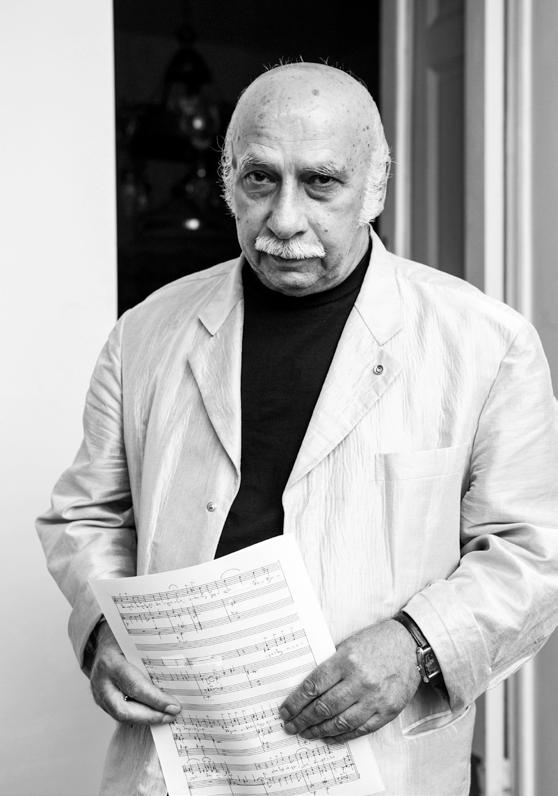

arasdros gamCenia survili musikis saSualebiT gamomexata Cemi damokidebuleba im umecrebis mimarT, romelic Tan axlavs sxvadasxva epoqis monacvleobas da kacobriobis istoriaSi arsebuli Semzaravi magaliTebis miuxedavad dResac ar kargavs aqtualobas. kargad mesmis, rom xelovneba samyaros ukeTesobisken ver Secvlis. amitomac vcdilob davupirispiro: umecrebas _ ara azvirTebuli mdinare, aramed „dumili“, romelic vizualurad uZravi wylis zedapirs hgavs; permanentul teroristul aqtebsa da daumTavrebeli konfliqtebiT gamowveul uaryofiT emociebs _ simSvide da moTmineba, vinaidan mxolod aseT viTarebaSi mimaCnia SesaZleblad fiqri mSvenierebis iseT xarisxze, romelsac ZaluZs umecrebas win aRudges; ufro da ufro mzard xmaurian garemos _ JReradoba, romelic siCumis zRvars uaxlovdeba; teqnikuri progresis miRwevebsa da urTules teqnologiebs _ maqsimalurad gamartivebuli musikaluri ena; cxovrebis da yofis ufro da ufro aCqarebul ritms _ utrirebulad neli tempebi; patriotizmis egzaltirebul gamovlinebebs, warsulis gandideba-gafetiSebas da religiur fanatizms _ mZafri, dinamiuri kontrastebi, radganac garda sanoto qaRaldze datanili niSnebisa, piradad me, protestis gamoTqmis sxva saSualeba ar gamaCnia. da radgan aRniSnuli garemoebebi Cems sulier mdgomareobaze qvecnobierad moqmedebs da, albaT, garkveul kvalsac tovebs, mixdeba sakmaod maRali niSnulis gadalaxva, raTa yoveldRiuri urTulesi Sromis procesSi, musikaluri formis Seqmnisas, Cemi fiqrebi da gancdebi mimarTuli iyos ara zemoT CamoTvlili problemebis asaxvisken, aramed im ukidegano, uxilavi sivrcis mimarT, romelic Cems warmodgenaSi mSvenierebis, sikeTisa da siyvarulis maradiul cnebebs ukavSirdeba. erTaderTi, razedac vocnebob, gaxlavT is, rom Cemi SemoqmedebiTi sirTuleebi SeumCneveli darCes msmenelisTvis. musikis universaluri ena, romelic Targmans ar saWiroebs, TiToeul msmenelSi gansxvavebul grZnobebs iwvevs. kargad mesmis, rom Cemi musikaluri samyaro mavansa da mavans SesaZloa aRizianebdes kidec, Tumca, keTilmosurneebis danaklisi arasdros migrZvnia. mogexsenebaT, ama Tu im movlenis WeSmariti Semfasebeli mxolod droa da bednieri viqnebi, Tu Cemi Semoqmedeba momavalSi (Tuki is daviwyebas ar mieca) aRiqmeba rogorc mcdeloba Tavis gaRwevisa sibnelidan sinaTlisken.
yovel axal namuSevarSi wesisamebr, vcdilob Cem mierve agebuli winaRobebis gadalaxvas, raTa droebiT mainc vigrZno Sveba. es procesi erTob mtanjvelia
I’ve never wished to express my attitude towards the ignorance that accompanies changes of time and, notwithstanding all the horrible examples in the history of Mankind, is still acute nowadays.
I do understand that art will not change the world for the better, so I try to oppose:
Silence that resembles the surface of still water and not a raging river to ignorance;
Peace and patience towards permanent terrorist acts and endless conflicts; because only in such situations can I think of beauty that is able to defeat ignorance;
The sound between the verge of silence and an increasingly noisy environment;
The simplest musical language to complicated technical progress; Exaggeratedly slow tempos to accelerating rhythm of life;
Dynamic contrasts to exalted patriotism, fetish of the past and religious fundamentalism.
I’ve no other means of expressing my protest but the notes written on music paper.
And as the above-mentioned circumstances subconsciously influence and no doubt leave their mark on my spiritual condition, in my daily hard work I have to empty my thoughts and emotions from these problems and address the endless, unseen space connected to the eternal notions of beauty, kindness and love in my perception. My sole desire is to keep my inner creative struggle hidden from the listeners of my music.
Universal language of music that needs no translation rouses different feelings in each listener. I do understand that my musical world can be irritating for some people, but I have also never lacked followers.
You may agree that the only true appraiser of any event is time and I’ll be glad if my music is seen in the future (if it is not lost in oblivion) as an attempt to escape from darkness towards light.
As a rule, in each new composition I try to overcome obstacles created by myself to feel, at least, temporary relief. This is a torturous process and the illusion of overcoming difficulties is not the guarantee of self-contentment.
I’ve never tried to be distinctive and full of originality. Moreover, I have repeatedly said that the issue of my creating process is as old as the universe: I try to go from subdominant to dominant chords and then to tonic so that I am not drowned in boredom.
I don’t like discussing or talking about my compositions, especially before showing a new piece. After finishing the composition I look forward to the first rehearsal which is to reveal the best and worst sides of my work. The best criteria to assess my music with is silence reigning in the concert hall full of people.
If passion for being original or, even worse, extravagant, prevails the composer, creation of music loses its essence...
I can’t tell you anything about the very first literary work as it is lost in time, but we can talk about the first musical works starting from religious chants which have a specific character. I’ll also mention folk polyphony, the origins of which are also lost in
da sirTuleTa daZlevis iluzia sruliadac ar aris kmayofilebis grZnobis winapiroba.
arasodes micdia da arc vcdilob originalobas. piriqiT, xSirad vimeoreb, rom Cemi Semoqmedebis erTerTi mTavari problema samyarosaviT xnieria: imgvarad minda gadavide subdominantidan dominantze, Semdeg ki tonikaze, rom upirveles yovlisa, Tavad ar dameuflos mosabezrebeli mowyeniloba.
sakuTar nawarmoebebze bWoba da azris gamoTqma ar maxasiaTebs; miT umetes, jer armosmenilze. morigi opusis dasrulebisTanave, veli pirvel repeticias, rodesac TvalnaTeli xdeba misi av-kargi. sakuTari musikis Sesafaseblad yvelaze mniSvnelovani kriteriumi ki, CemTvis, xalxiT savse darbazis gansakuTrebuli siCumea. Tu originalurobis da, miT ufro, eqstravaganturobis vneba iqceva dominantad da dagZlevs, musikis weras azri ekargeba...
pirveli literaturuli teqsti rodis Seiqmna ver getyviT, is xom droSia Cakarguli. rac Seexeba musikas, saubari SeiZleba saeklesio sagaloblebiT daviwyoT, romlebic aRniSvnis gansakuTrebuli specifikiT xasiaTdeba. aqve SemiZlia vaxseno Cveni xalxuri polifonia, romlis sawyisi niSnebis arseboba ucnobia. xSirad mebadeba kiTxva, vin da rogor Seqmna es Sedevrebi? pasuxs ver vpoulob. aseTi metaforac davuSvi _ SeiZleba guriaSi cxovrobda baxiviT niWieri pirovneba, romelmac uxmo Tavis or mezobels, romelTagan erT-erTs beThovenis, meores ki mocartis niWi hqonda da SesTavaza samxmiani polifoniuri simReris Seqmna. Tu amis daSveba SeiZleba, rbilad rom vTqva, ucnauri da gaugebaria, rogor aRmoCndnen erTdroulad `baxi, beThoveni da mocarti~ guriis garda saqarTvelos sxva kuTxeebSic. erT rameSi ki darwmunebuli var _ CvenSi, xalxuri musika, xalxis mier moednebze ar Seqmnila _ mas qmnidnen genialuri anonimebi. amitomac, Tavs uflebas ar vaZlev, anonimebis mier Seqmnili Cems musikaSi gamoviyeno. dasaSvebia, rom amgvar Sedevrebs safuZveli Caeyara qristianobis miRebamdec. amis Tqmis uflebas mTaSi warmarTuli religiis SemorCenili naSTebi maZlevs... svaneTSi, micvalebulis dakrZalvisas, dResac arsebobs garkveuli wesi _ iq, sadac micvalebuli asvenia, sxedan mxolod qalebi... Wirisufali patiJebs Tanasoflel an sxva soflidan `profesional~ momtiral mandilosans, romelic iwyebs tirils _ martiv melodias da oTaxSi msxdomi qalebi uerTdebian mas. am dros, ezoSi ramdenime mamakacisgan Semdgari gundi asrulebs svanur `zars~ _ zecisken mimarTul himns. erT-erTi eqspediciisas folkloristebma gadawyvites ritualis Cawera da mikrofoni daukiTxavad, Sesasvlel karebTan damales... firCamwerma qalebis tirili da kacebis „zari“ erTdroulad aRbeWda. roca es Canaweri movismine,
the past. I often ask myself who created these masterpieces and I can’t find the answer. I thought of a metaphor – maybe in Guria a talented person like Bach once lived; he invited two neighbors of his – one of whom was as talented as Beethoven and the other with the genius of Mozart - and suggested they create 3-voice polyphony. If this could be taken into consideration, it is somehow strange and incomprehensible how “Bach”, “Beethoven” and “Mozart” happened to live together not only in Guria, but in other regions of Georgia as well. I’m convinced of one thing – in our country, folk music was not written by people in the fields – it was created by anonymous geniuses. That is why I don’t allow myself to use the work of anonymous authors when writing my music. It could also be true that these masterpieces existed in our culture long before Christianity.
I can say this judging by the remnants of heathen religion in the mountains... Even nowadays in Svaneti during a funeral, according to tradition only ladies are allowed to sit in the room where the dead person is lying. The relatives of the deceased invite a “professional” weeper from their own or neighboring village. She starts wailing a simple melody and the women in the room sing along with her. At the same time, in the yard a group of men start singing the Svanetian “Toll” – a hymn addressed to heaven. Participants of one of the folklorist expeditions decided to record the ritual and secretly hid a microphone near the entrance door... the recording captured the voices of both men and women. I have listened to it and it’s been a true mystery for me ever since. Exactly this recording gave me the inspiration to invite Hamlet Gonashvili to perform the opening and the middle parts in my 3rd Symphony with the subtitle “The Chant”.
Maybe a century before Artem Erkomaishvili was born, there lived another “Artem Erkomaishvili”, and before him, yet another; this went on and on from generation to generation. I recently talked to the head of the Folklore Center, Giorgi Donadze, who was concerned about the fact that interest towards folk music has decreased, especially in the regions, notwithstanding the fact that 16 musical schools were founded in the peripheries by the State. Our script and language is vitally important for maintaining our identity and the exact same thing can be said about folk polyphony. Nowadays, passion for contemporary genres is normal and understandable, this happens in the whole world and we cannot be the exception. But if it overshadows the devotion of young people towards folk music, our identity will come under real threat.
I remember in 2000 I was a guest composer at the Lucerne Festival. The organizers suggested I invite one group to participate in it and so the Rustavi Ensemble visited Switzerland. At one of the events, after a long symphonic composition which I wrote specially for the Festival (conducted by Jansug Kakhidze), Rustavi performed Georgian folk music in a newly built concert hall. And then I learned
mivxvdi, rom es saocari movlena CemTvis gaugebari misteriis niSnebs atarebda. swored es Canaweri gaxda Cemi mesame simfoniis Seqmnis erTgvari inspiracia da Cem mier Seqmnili `tirilis~ simfoniis dasawyisSi, Sua nawilSi da boloSi Sesasruleblad hamlet gonaSvili moviwvie.
albaT, artem erqomaiSvilamde, saukuniT adre, cxovrobda da mReroda sxva `artem erqomaiSvili~, manamde kidev sxva da ase modioda Taobidan Taobamde. amaswinaT vesaubre folkloris centris xelmZRvanels, giorgi donaZes, romelmac gamoTqva wuxili imis gamo, rom interesma xalxuri muzicirebis mimarT iklo, gansakuTrebiT regionSi. miuxedavad imisa, rom saxelmwifom, swored regionSi, 16 samusiko saswavlebeli daaarsa. Tu Cveni TviTmyofadobisTvis Cvens damwerlobas da enas sasicocxlo mniSvneloba aqvs, aranaklebi mniSvnelobisaa Cveni xalxuri mravalxmianobac. dRevandeli gataceba popularuli JanrebiT normaluri da gasagebia, ase xdeba mTel msoflioSi da amas gverds ver avuvliT. magram Tu es gataceba daCrdilavs axalgazrdobis ltolvas xalxuri musikisadmi, Cvens identobas realuri safrTxe daumuqreba.
maxsovs, 2000 wels lucernis festivalis guest composer gaxldiT. organizatorebma SemomTavazes programis farglebSi erTi koleqtivi mimewvia da SveicariaSi ansambli `rusTavi~ Camovida. erT-erT saRamos, specialurad lucernis festivalisTvis Seqmnili Cemi vrceli simfoniuri nawarmoebis Sesrulebis (jansuR kaxiZis diriJorobiT) Semdeg, lucernis axladagebul saocar darbazSi `rusTavma~ qarTuli xalxuri musika Seasrula. maSin mivxvdi, ratom iwvevs Cveni cekvebi mayurebelSi saocar aRtkinebas, xolo xalxuri polifoniis mosmenas mohyveba gaogneba. `Cakrulos~, `xasanbeguras~ da `Cven mSvidobas~ Sesrulebas swored rom gaogneba unda mosdevdes. darwmunebuli var, rom artem da anzor erqomaiSvilebis niWis matarebeli xuTi-eqvsi wlis biWebi dResac mravlad arian... am genetikur kods gansakuTrebuli gafrTxileba da movla-patronoba sWirdeba. kargia, rom XX saukuneSi gaCndnen profesionali folkloristebi, romelTa Rvawli fasdaudebelia sxvadasxva kuTxis simRerebis fiqsirebaSi, gansxvavebuli versiebis aRmoCenaSi, brwyinvale, ganumeorebeli Semsruleblebis saTanado aRiarebaSi. qeds vixri maTi da gansakuTrebiT anzor erqomaiSvilis Semoqmedebis winaSe. amave dros, ar SemiZlia guliswyromiT ar aRvniSno, rom fundamenturi samecniero kvlevebi am sferoSi saukuneebis manZilze SemorCenil saunjes sagrZnoblad CamorCeba. jansuR kaxiZe natrobda da mec vnatrob, rom iseve rogorc kulturul da ganviTarebul qveynebSi, saqarTveloSic
why the audiences are delighted by our folk dances and astonished by our polyphony.
Performances of ‘Chakrulo,’ ‘Khasanbegura’ and ‘Our Peace’ should truly be followed by astonishment. I’m sure that there still are many 5-6 year old boys who have the talent of Artem and Anzor Erkomaishvili... We should take care and cherish this genetic code.
It’s good that we’ve had many professional folklorists in the 20th century who contributed to discovering song versions from different parts of Georgia. Proper assessment of these brilliant performers is priceless. I admire their work, especially that of Anzor Erkomaishvili. But at the same time I want to express my indignation that scientific studies in this field lag behind the treasury of several centuries.
I share Jansug Kakhidze’s dream of having a ‘philharmonic’ life in Georgia like in other cultural and developed countries! This means having a musical schedule a year ahead – which concert will be held and where, who the conductor will be, where a certain soloist will perform, which pieces will be performed at certain concerts, etc. This should be scheduled beforehand. In our country everything happens spontaneously. A festival - Yes, sir! Another one – Why not? A grand idea! And we live from festival to festival, from guest musician to guest musician. Last year a wonderful clarinetist, Levan Tskhadadze, who lives in Amsterdam and performs in Europe, brought great wind soloists to Georgia. And then what?! The event coincided with the Festival of Eliso Virsaladze in Telavi! That happened due to lack of coordination and we don’t have coordination because we don’t have a tradition of philharmonic life. Maybe the time will come when the State will think of laying the foundation for this tradition.
The new concert hall was built recently and was named the ‘Philharmonic Hall.’ My attempt to dissuade this name being given to it failed. Almost all TV or Radio journalists call it ‘Philharmonic Hall’... The only success I gained is that the sign on the front wall says ‘The Great Concert Hall.’ Our society should know that ‘Philharmonic Hall’ is a space where symphonic, chamber or choral concerts are held. It’s wrong to give this name to a hall where party congresses, different shows or, shortly speaking, any spectacles are held but the genres I mentioned above.
You referred to a ‘Ready Ear.’ I don’t know how masterpieces can be understood. The only crucial thing in this matter is feeling and emotion, which excludes understanding. I remember in the Soviet Union there was one channel which was watched by millions of people. In one of the programs a professional musical expert spoke about the structure and form of Beethoven’s Pastoral Symphony (6th) and he added: “In a certain episode a thunder is heard, storm rages and it starts to rain; then suddenly the sun and a rainbow appear...” I was listening to this person and thought – right now
arsebobdes `filarmoniuli~ cxovreba! es niSnavs imas, rom minimum erTi wliT adre musikalur sazogadoebas gaaCndes programa _ sad romeli koncerti Catardeba, sad idiriJorebs esa Tu is diriJori, sad daukravs esa Tu is solisti, ra Sesruldeba ama Tu im koncertze da a.S. es yovelive gawerili unda iyos winaswar. CvenTan ki yvelaferi spontanurad xdeba. festivali _ ki batono, meore festivali _ mSvenieria da vcxovrobT ase _ festivalidan festivalamde, gastrolioridan gastrolioramde. xandaxan xdeba ise, rom erTmaneTs sami koncerti emTxveva. SarSan SesaniSnavma klarnetistma levan cxadaZem, romelic amsterdamSi cxovrobs da evropaSi moRvaweobs, Camoiyvana saukeTeso solistebi, sasule-Casaber instrumentebze Semsruleblebi da ra? es festivali droSi daemTxva eliso virsalaZis festivals TelavSi! ar arsebobs koordinacia da ar arsebobs imitom, rom ar gvaqvs `filarmoniuli~ cxovrebis tradicia. albaT, mova dro, rodesac am tradiciis safuZvlis Cayraze izrunebs saxelmwifo.
aSenda sakoncerto darbazi, romelsac daarqves `filarmonia~. Cemi survili ar uwodon am darbazs `filarmonia~ uSedego aRmoCnda _ TiTqmis yvela tele da radio wamyvani xmarobs am termins-saxeldebas... mivaRwie mxolod imas, rom Senobis fasadze gaCnda warwera `didi sakoncerto darbazi~. Cvenma sazogadoebam unda icodes, rom `filarmonia~ gaxlavT sivrce, sadac imarTeba simfoniuri, kameruli da sagundo musikis koncertebi. ar aris swori `filarmonia~ uwodo darbazs, romelSic partiuli yrilobebiT dawyebuli da sxvadasxva sanaxaobiT damTavrebul warmodgenebSi sruldeba yvelaferi, zemoT CamoTvlili Janrebis garda.
Tqven egreT wodebuli `momzadebuli yuri~ axseneT. CemTvis gaugebaria xelovnebis maRali nimuSebis gageba. vfiqrob, rom mxolod SegrZnebaa is aucilebeli Tviseba, romelic `gagebas~ gamoricxavs. kargad maxsovs, rodesac sabWoTa kavSirSi erTi telearxi arsebobda romelsac as milionze meti mayurebeli ucqerda, erT-erT gadacemaSi profesionali musikismcodne gvesaubreboda beThovenis meeqvse `pastoraluri~ simfoniis struqturaze, formaze da Semdeg agrZelebda: ama Tu im epizodSi ucbad gaismis Weqa-quxili, iwyeba qariSxali da modis saSineli wvima... mere ki ucbadve gamoCndeba mze, cisartyela... vusmendi am adamians da vfiqrobdi _ axla am as milions xom hgonia, rom beThovenis es simfonia `momzadebuli yurisTvis~ feradi mxatvruli filmia... sxvaTa Soris, ori adamiani, Tu gnebavT col-qmari, romelTac erTad aqvT gatarebuli mTeli cxovreba da romlebic usmenen erTi da igive nawarmoebs, sxvadasxvagvarad aRiqvamen mas. es gaxlavT musikis abstraqtulobis Sedegi da musikis fenomeni
100 million people assume that Beethoven’s Sixth Symphony is a movie for a ‘Ready Ear’... by the way, two people, say a husband and a wife who have spent the whole life together, listen to one and the same music differently. This is the result of abstractedness of this phenomenon – music. It should not be understood, it should be felt! And that’s that! One can feel certain music this way, the other – yet another way... Someone may have no emotions whatsoever towards one kind of music, but adore another... So everything comes to feeling and not understanding – That’s why I think that our folk music cannot be understood.
The premiere of my latest piece was held twice in Belgium, Brussels and then three times in Seattle in the US. Before this my new album containing two compositions was released. It was named ‘Chiaroscuro’ and it received mutually exclusive press. Nowadays, high class critics are as much a rarity as high class composers, poets and writers... There are many more composers than there should be and we also don’t lack in the number of critics... I’ll give you one example: imagine the period a hundred years ago. Stravinsky, Prokofiev, Puccini, Schoenberg, Sibelius, Ravel and Debussy are all alive – this is a different musical language and thinking, an absolutely different attitude towards form and structure and each of the above-mentioned composers have their own apologists.
A century passes and nowadays Mahler, Shostakovich, Sibelius, Webern, Berg and Schoenberg peacefully coexist in the philharmonic programs; nobody has a problem with this. People come to concerts and listen to these different styles without protest. One critic in London pulled my ‘Chiaroscuro’ to pieces... While in Paris an article was written about the same album. Here’s the last sentence from it: “This music, which speaks to us in the language of humanity, belongs to a brilliant composer...” So, someone in France thinks I’m a brilliant composer and in England an article says: “I found myself in a shop of cheap shampoos and soaps listening to dreadful music” – these differences are normal. It should be like this! I don’t know whether you believe me or not, but these contradictory opinions don’t bother me a bit. I’ll be frank with you – negative reviews are as pleasant for me as acclaim.
Unfortunately, after Givi Orjonikidze passed away, music criticism has almost vanished (although this is partly due to the nonexistence of philharmonic life). Once, I was astonished when I read a review in one of the newspapers about a concert, written by the son of Andria Balanchivadze, Jarji (a brilliant musician, a pianist). I remembered the style of the end of 19th and beginning of 20th centuries, when the main idea was brought to the reader in simple, understandable language. I suggested Jarji write reviews about all the symphonic concerts in Tbilisi, but unfortunately we could not bring this idea to fruition.
swored amaSi gamoixateba. musikas gageba ar sWirdeba, mas sWirdeba SegrZneba! meti araferi... viRac grZnobs ase, viRac sxvagvarad... viRac saerTod ver grZnobs, magram grZnobs sxva Janris musikas... ase rom yvelaferi grZnobazea damyarebuli da ara gagebaze _ amitomac mimaCnia, rom Cveni xalxuri musikis gageba SeuZlebelia.
Cemi bolo nawarmoebis premiera orjer belgiaSi, briuselSi da Semdeg zedized samjer, amerikis SeerTebul StatebSi, sietlSi Sedga. manamde gamovida Cemi morigi diski ori nawarmoebiT, romelsac hqvia `kiaroskuro~ da rogorc aseT dros xdeba gaCnda presac _ absoluturad urTierTgamomricxavi SexedulebebiT. dRes maRali rangis kritikosi iseTive iSviaTobaa, rogorc maRali rangis kompozitori, poeti an mwerali... kompozitorebi xom bevrad metni arian, vidre unda iyvnen da raodenobiT kritikosebic ar CamorCebian maT... erT magaliTs moviyvan _ warmoidgineT asi wlis winandeli periodi. erTdroulad moRvaweobdnen stravinski, prokofievi, puCini, Sonbergi, sibeliusi, raveli, debiusi _ es gaxlavT gansxvavebuli musikaluri ena da azrovneba, absoluturad gansxvavebuli damokidebuleba formis, struqturis mimarT da yvela maTgans hyavs Tavisi apologeti. gavida saukune da dRes filarmoniul programebSi mSvidad Tanaarseboben maleri, SostakoviCi, sibeliusi, veberni, bergi, Sonbergi da es ukureaqcias aravisSi iwvevs. adamianebi modian koncertze da yovelgvari protestis gareSe ismenen am gansxvavebul mimarTulebebs. erTma kritikosma qalbatonma londonSi Cemi `kiaroskuro~ miwasTan gaaswora... am dros imave diskze parizSi daiwera statia, saidanac wagikiTxavT bolo winadadebas: `es musika ki uzomod humanuri eniT metyveli, genialur kompozitors ekuTvnis...~ e.i. safrangeTSi viRac mTvlis genialur kompozitorad, inglisSi ki statia brZanebs rom, `iaffasiani Sampunebis Tu sapnebis maRaziaSi movxvdi da raRac ubedureba movismineo~ _ es gansxvavebuloba normaluria, asec unda iyos. ar vici damijerebT Tu ara _ am ukiduresad urTierTgamomricxav gamonaTqvamebs sakmarisad mSvidad vxvdebi. Tumca gamogitydebiT _ uaryofiTi kritika aranakleb siamovnebas mgvris, vidre dadebiTi.
samwuxarod givi orjonikiZis gardacvalebis Semdeg musikaluri kritikis muxti TiTqmis gaqra (sxvaTa Soris amis mizezi filarmoniuli cxovrebis ararsebobacaa). maxsovs, didi xnis win, romeliRac gazeTSi wavikiTxe andria balanCivaZis vaJis, jarjis (SesaniSnavi musikosis, pianistis) werili erT-erT koncertze da saxtad davrCi _ gamaxsenda XIX saukunis bolos da XX saukunis dasawyisSi damkvidrebuli stili, rodesac martivi, gasagebi eniT da ramdenime winadadebiT gadmoicemoda ZiriTadi azri. jarjis SevTavaze, TbilisSi gamarTuli
I stopped visiting Russia several years ago, but my music is still played there. I don’t want to go to a country where the majority of the population, including some of my musician friends, support a sly provocateur, a president who attempts to destroy my country. The “Empire of Evil” from Ronald Reagan’s era continues to fight against the civilized world with triple energy and tries to destroy it. It also deeply saddens me that we had to alienate ourselves from Russian culture because of him. But I believe that though youngsters don’t know Russian, they will read great translations of Tolstoy, Dostoevsky and Chekov.
Fortunately, music does not need translation and thanks to modern technologies of communication, anything is accessible with almost no limitations for internet users. The number of young professional composers is on the verge of a minimum. Probably, this is due to the fact that creating an orchestral score is impossible without special education. I don’t want you to think that I’m against the modern bands. The more bands, the better. Multiplicity always helps bring true talent to light. I feel the same way about the multiple supporters of electronic music. The problem is that one can create a composition for the guitar or keyboard using only three or four chords while the score for the symphonic orchestra cannot be created without years-long education. This is why fewer and fewer youngsters go to the Conservatory.
I think we should give this good thought.
P. S. I have stepped beyond the age of 80 and the more time goes by, the more hurtful are the things I encounter. I’m sorry that my city reminds me of a “tadpole”. I worry that these eternal constructions that disfigure the city cannot be stopped. I ‘m sorry that the hate and spite among politicians drastically exceeds respect for one another. I realize that a perfect society can only exist in our minds, but the constant opposition and fighting is boring and unbearable for me. I don’t understand why we can’t control exhaust fumes that pollute our air and threaten the health of our fellow citizens. There are also seemingly unimportant, tiny problems that draw a feeling of protest in me. I was at a restaurant in the funicular garden not long ago. I don’t know who the building belongs to, I’m also not aware who the owner of the wonderful painting ‘Pirosmani’s Tbilisi’ by a friend of mine, KokaIgnatov, is. I was proud to invite my guests to see the painting, but I happened to be so wrong! I was sorry to see several tables and chairs in semi darkness (probably to create intimate space) and flat chandelier of a strange form blocking the upper part of the painting from view. I want to repeat that although I have no idea who the owner of the restaurant is, I ask him to have respect towards the art work, replace the chandelier, install proper light and separate the painting from the restaurant space with a fence which will be a reminder for visitors that art should be appreciated without beer, coffee or chit-chat. If my wish ever comes true, I will believe that love of your homeland has long passed the high-flown toasts said during the feasts.
yoveli simfoniuri koncertis Semdeg, daewera recenzia, romlis gamoqveynebaSic davexmarebodi. samwuxarod es idea ver ganvaxorcieleT.
ramdenime welia, rac ruseTSi siaruli Sevwyvite, Tumca Cemi musikis Sesruleba iq ar Sewyvetila. ar maqvs survili viaro qveyanaSi, romelSic mosaxleobis umravlesoba, da maT Soris zogierTi Cemi megobari musikosi, mxars uWers gaqnil provokators da qveynis damangrevel prezidents. ronald reiganis droindeli `borotebis imperia~ dRes asmagi energiiT ebrZvis gaerTianebul civilizebul samyaros da cdilobs mis daSlas. amave dros vnanob, rom ZiriTadad mis gamo gavemijneT rusul kulturas. Tumca mjera, rom axalgazrdobis dainteresebuli nawili rusuli enis arcodnis miuxedavad, kargad naTargmni literaturis meSveobiT eziareba tolstois, dostoevskis da Cexovis Semoqmedebas.
sabednierod, musika Targmnas ar saWiroebs da Tanac komunikaciis Tanamedrove teqnologiebis daxmarebiT is praqtikulad SezRudvis gareSe gaxda xelmisawvdomi internetmomxmareblebisTvis. axalgazrda profesional kompozitorTa ricxvma ki minimumamde davida. albaT, es movlena ganapiroba Semdegma garemoebam: dameTanxmebiT, rom saorkestro partituris Seqmna specialurad miRebuli ganaTlebis gareSe SeuZlebelia. ar ifiqroT, rom momravlebuli `bendebis~ winaaRmdegi var. piriqiT, rac ufro meti jgufi iarsebebs, miT ukeTesia. simravle WeSmariti niWis gamovlinebas uwyobs xels. aseTive damokidebuleba maqvs eleqtronuli musikis mravalricxovan mimdevarTan. problema ki imaSi gaxlavT, rom gitaraze an klaviSian sakravze sami an oTxi akordis monacvleobiT SesaZlebelia kompoziciis Seqmna. simfoniuri orkestrisTvis Rirebuli partituris Semqmnels mravalwliani ganaTlebis miRebis gareSe araferi gamouva. es gaxlavT martivi mizezi imisa, rom axalgazrda kompozitorebis ltolvam konservatoriaSi ganaTlebis misaRebad sagrZnoblad iklo. vfiqrob, es garemoeba damafiqrebelia.
P. S. 80 wels gadavabije da rac ufro meti dro gadis, CemTvis dasafiqrebeli da sawyeni matulobs. mwyins, rom Cemi qalaqi daemsgavsa „Tavkombalas“. mwyins, rom ver moeRo bolo mSeneblobebs, romlebic amaxinjeben garemos. mwyins, rom politikosebs Soris arsebuli gesli da zizRi sagrZnoblad Warbobs urTierTpativiscemas. mesmis, rom srulyofili sazogadoeba SeiZleba arsebobdes mxolod adamianis warmodgenaSi, Tumca Cvens sazogadoebaSi arsebuli gauTavebeli dapirispireba mosabezrebeli da autaneli
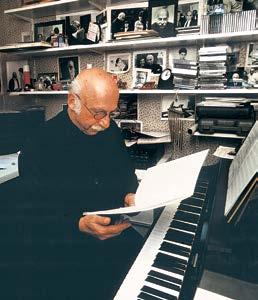
gaxda. ar mesmis, ratom ver cxaddeba avtomanqanebis mavne gamonabolqvze kontroli, Tu haeris dabinZureba pirdapir emuqreba Tbilisis mosaxleobis janmrTelobas. amave dros, arsebobs erTi SexedviT viTom da umniSvnelo problemebi, Tumca zogierTi maTgani CemSi protestis grZnobas iwvevs. amas winaT gaxldiT funikuliorze restoranSi. ar vici vis sakuTrebaSia dRes es Senoba da arc is vici, Tu vis sakuTrebaSi aRmoCnda Cemi megobris, koka ignatovis brwyinvale namuSevari `firosmanis Tbilisis~ pano. siamayis grZnobiT mivipatiJe stumrebi panos sanaxavad da maSinve vinane! naxevrad Cabnelebul darbazSi (specialuri ganaTeba intimuri atmosferos Sesaqmnelad) damxvda ramdenime magida da Sesabamisi raodenobis skami, gaugebari formis brtyeli Tanamedrove WaRi, romelic faravs panos zeda nawils. vimeoreb, miuxedavad imisa, rom warmodgena ar maqvs restornis amJamindel mflobelebze, minda vTxovo maT pativi miagon xelovnebis nimuSs, gaaTavisuflon sivrce, gadaitanon WaRi Sesaferis adgilze, Secvalon ganaTeba da dadgan panosgan garkveuli manZiliT daSorebuli xis ovaluri moajiri (Tejiri), romlis arseboba cxadyofs, rom xelovnebasTan Sexeba unda xdebodes kaTxa ludis, yavis da sja-baasis gareSe. Tu Cemi survili odesme ganxorcielda, davijereb, rom samSoblosadmi pativiscema gascdeba sufrasTan warmoTqmul maRalfardovan sadRegrZeloebs.
ruseTis imperatori nikoloz I mefisnacval m. s. voroncovs, 1846 wlis 26 seqtemberi

enaTmecnieri, Tavadi n. s. trubeckoi, 1925 weli, emigraciidan
“Divide all the Caucasian people into two categories – obedient and violent. Let the obedient remain in their dwellings and benefit from Russian rule while moving the violent by force into the depth of Russia, splitting them up into small numbers and scattering them throughout different Volosts of Russia”.
Dekabrist P. I. Pestel, 1824
“Listen to me and remember well what I will tell you. Don’t speak of the Caucasian region as an individual state. I wish and must do all in my power to merge this region into Russia so that they form an indivisible whole”.
Russian Emperor Nicholas I to Governor-General Vorontsov, September 26, 1846
“It is necessary to recognize Abkhazian as Abkhazia’s official language, promote development of the Abkhazian intelligentsia and sensitize them to the necessity of declaring war against any kind of Georgianization”.
Prince N.S. Trubetskoy, a linguist, 1925


afxazTa istoriaSi XIX saukunis 60-70-ian wlebSi tragikuli furceli gadaiSala. 1864, 1867 da 1877 wlebSi aTasobiT afxazi aiZules samSoblo daetovebina da osmaleTSi gadaxvewiliyo. es procesi istoriaSi muhajirobis saxeliTaa cnobili.
muhajiroba saerTokavkasiuri procesi iyo, romelic ara marto afxazebs, aramed qarTvelebs da Crdilo-kavkasiis xalxebs _ daRestnelebs, osebs, CeCnebs, Cerqezebs, abazebs, ubixebs, jiqebs, _ Seexo. arabulad `muhajereT~ gadasaxlebas niSnavs, Tumca kavkasiis xalxTa enebSi man ZiriTadad ZaldatanebiT gadasaxlebulis, samSoblodan devnilis mniSvneloba SeiZina. es ki mefis ruseTis mier XVIII-XIX saukuneebSi warmoebulma kavkasiurma omebma ganapiroba. kavkasiis ama Tu im regionSi ruseTis mmarTvelobis damyarebas Tan sdevda, ZiriTadad, mahmadiani mosaxleobis iZulebiT gasaxleba.
kavkasielTa muhajiroba Rrma socialur-ekonomikuri, politikuri da religiuri mizezebiT iyo gamowveuli. erTi SexedviT, TiTqos religiuri momenti dominirebda, Tumca ZiriTadi mainc politikuri faqtori _ ruseTis dampyrobluri politika iyo. ruseTis saxelmwifos mizani, tradiciulad, dapyrobili qveynis kolonizacia da mosaxleobis asimilacia iyo. cnobili istorikosi vasili kliuCevski kolonizacias `ruseTis istoriis ZiriTad faqtorad~ miiCnevda. amis naTeli magaliTi ruseTis istoriaa _ XVI saukunidan moyolebuli. pirvelad swored am saukunidan aRmoCnda ruseTis saxelmwifos SemadgenlobaSi ararusuli miwebi: karelia, komi, volgispireTi, uralispireTi; XVII saukuneSi ruseTma miierTa cimbiri, ukraina, belorusia; koloniur dapyrobaTa procesi ufro intensiuri XVIII saukuneSi gaxda, roca ruseTma baltiispireTi, poloneTi, yirimi da Savi zRvis mTeli Crdilo sanapiro daipyro; XIX saukuneSi imperiis SemadgenlobaSi kavkasiac aRmoCnda. mefis xelisuflebas surda kavkasia `samoqalaqo da politikuri TvalsazrisiT mWidrod Seekra ruseTTan da mis ganuyofel nawilad eqcia~, xolo adgilobrivi mosaxleoba `eniT, gonebiT, grZnobiT rusi gaexada~.
1864 wlis gazafxulze ruseT-kavkasiis omi (1863-1864) dasasruls uaxlovdeboda. Savi zRvis sanapiro, tamanis naxevar kunZulidan adleramde savse iyo muhajirebiT, romlebic osmaleTisken mimaval gemebs elodnen. maisSi, ruseTi jaris nawilebma dasavleT kavkasiis mTielTa winaaRmdegobis ukanaskneli kera ahWifsi, _
The 1860-70s represent a haunting black mark in Abkhazian history. In 1864, 1867 and 1877, thousands of Abkhazians were forced to leave their lands and settle in the Ottoman Empire. This process is known in history as Muhajirism.
The process of Muhajirism took place throughout Caucasus, and thus concerned not only Abkhazians, but also Georgians and NorthCaucasian peoples – Dagestanis, Ossetians, Chechens, Circassians, Abazians, Ubykhs, and Dzikhs. In Arabic, “muhajeret” means exile, but in the various languages of the Caucasian peoples, this word took on the connotation of forced exile and of being a refugee that had to flee one’s country. This connotation appeared because of the so-called “Caucasian Wars” orchestrated by the Russian Empire in the 18th-19th centuries. The implementation of Russian rule in this or that region of the Caucasus was most often accompanied by the forced emigration of their Muslim populations.
The Muhajirism of Caucasians was instigated for socioeconomic, political and religious reasons. At a glance, one might think that the religious aspect was dominant, but in reality, the most important issue was a political one – Russia’s imperialism.
The traditional goal of the Russian state was to colonize conquered countries and to assimilate their inhabitants. Famous historian Vasily Klyuchevsky considered colonization as “the most important factor in Russian history”. Looking back at Russia’s history since the 16th century, one can hardly argue with that. Indeed, all the following non-Russian lands have been annexed by Russia since then: Karelia, Komi, the Volga and Ural regions were seized in the early 16th century; in the 17th century, Russia annexed Siberia, Ukraine and Belarus; the colonization process became more severe in the 18th century, when Russia occupied the Baltic region, Poland, Crimea and the entirety of the north coast of the Black Sea. The Caucasus became part of the Russian Empire in the 19th century.
The authorities of the Russian Empire wanted to “merge the Caucasus with Russia from a civil and political point of view, and make it an indivisible part of the Empire,” and to “make the local populations become Russians in language, thought, and emotion.”
In the spring of 1864, the Russo-Caucasian war (1763-1864) was nearing an end. The Black Sea coast from the Taman Peninsula up to Adler was jammed with Caucasian highlanders waiting to board ships bound for the Ottoman Empire. In May, Russian troops seized the last bastion of western Caucasian warriors – Akhchipsou, located at the upper reaches of the Mzymta River. On the 21st of May, Russian troops celebrated the end of the Russo-Caucasian war in Akhchipsou’s center, in a place called Aul Gubaadva (“Kbaada” in Russian, now known as “Krasnaya Polyana”). A large part of Adygeans and Abazians living across the northeast coast of the Black Sea and in the northwest part of the Caucasus, including Ubykh and Dzikh people, fled to the Ottoman Empire.
The Turkish sailing ships were quite old. Greedy ship-owners tried to cram as many Muhajirs as possible on board. During their long and wearisome journey, passengers suffered badly from sea sickness and
mTis Temi mdinare mzimTas zemo welSi, _ daikaves. 21 maiss, ahWifsis centrSi, aul gubaadvSi (rus. kbaada, amJamad krasnaia poliana) kavkasiis omi damTavrebulad gamocxadda. Savi zRvis Crdilo-aRmosavleT sanapiroze da Crdilo-dasavleT kavkasiaSi mcxovrebi Cerqezebi, abazebi, ubixebi, jiqebi osmaleTSi gadasaxldnen, maT Soris, jiqebi da ubixebi mTlianad.
Turquli afriani gemebi moZvelebuli iyo. fuls daxarbebuli xomaldebis mepatroneebi cdilobdnen, rac SeiZleba meti muhajiri waeyvanaT. amitom, Sor da Znel gzaze, mgzavrebs zRvis avadmyofoba awamebda, rasac sanovagisa da wylis ukmarobac emateboda. am mZime pirobebs bevri ver uZlebda da iRupeboda, gansakuTrebiT, bavSvebi. erT qals ZuZuTa bavSvi mokvdomoda, Turqebs zRvaSi rom ar gadaegdoT, dedas mkerdze miekra, TiTqos ZuZus awovebda da iavnanas umReroda. cas swvdeboda gamwarebuli dedis gulis kvnesa. ase daibada afxazuri simRera `SiS-nani~ _ muhajirTa iavnana. Turqebi micvalebulebs zRvaSi yridnen, xSirad, cocxal moxucebsac, rogorc usargeblo da gamousadegar tvirTs. sikvdils gadarCenilni, osmaleTis sanapiroze gadmohyavdaT, maT aravin `eloda~ da... arsad Canda Sepirebuli samoTxe. Semdeg osmaleTis xelisufleba maT ukacriel, unayofo, gamofitul miwebze asaxlebda. erTaderTi xsna, Tavis gadarCenis saSualeba mamaci kavkasielebisTvis osmaleTis armia iyo. bevri SimSilisa da avadmyofobis msxverpli gaxda, vinc gadarCa, TandaTan adgilobriv mosaxleobaSi gaiTqvifa, mxolod mcire nawilma SeinarCuna eTnikuri TavisTavadoba, sakuTari ena. ase gaqrnen istoriidan qarTvelebis uaxloesi mezobeli ubixebi. afxazi mwerlis bagrat Sinqubas romanSi `ukanaskneli ubixi~ am xalxis tragediaa asaxuli. realurad, ukanaskneli ubixi Tevfiq esenCi 1992 wels gardaicvala. mis sikvdilTan erTad gaqra ubixuri enac. TurqeTSi, baliqesiris provinciis sofel haji osmanSi, erT saflavs aseTi epitafia aqvs: `es Tevfiq esenCis saflavia. is ubixur enaze mosaubre ukanaskneli adamiani iyo~. es istoriis mkacri gafrTxilebaa, radgan rogorc afxazuri andaza gvaswavlis, `vinc samSoblos kargavs, is yvelafers kargavs~.
dasavleT kavkasiis dapyrobis Semdeg carizmma kavkasiaSi Tavi myarad igrZno. aRar arsebobda afxazeTis samTavros SenarCunebis aucilebloba da 1864 wlis ivnisSi carizmma afxazeTis samTavro gaauqma, uSualo rusuli mmarTveloba SemoiRo. imavdroulad, ivlisSi, afxazeTis daumorCilebel mTis TemSi fsxuSi, mdinare bzifis Sua welSi, ruseTis jaris nawilebi SeiWrnen... gadamwyveti brZola bzifis Senakadis gribzas napirze gaimarTa. fsxuelebi TavganwirviT ibrZodnen, magram damarcxdnen. maTi didi nawili, 3500 adamianze meti
shortage of food and water. Many of them, especially children, could not survive the ravages of such a trying voyage and died. A young woman whose baby had died during the journey pretended to breastfeed it and sang lullabies in an effort to save her baby from being discarded into the sea by Turkish soldiers. The distraught mother’s doleful lullaby seemed to melt into the sky. This is how the Abkhazian song Siş Nani (Lament of the Exile) was born. Turkish soldiers threw the bodies of the dead, and often even live old people, into the sea as useless “cargo”. The surviving Muhajirs who arrived on the Ottoman coast were met and helped by no-one… The paradise they were promised was nowhere to be seen. Turkish rulers settled them on dry, barren and desolate stretches of land. The only arena where brave-hearted Muhajirs could excel and sustain themselves was the Ottoman army. Many died of hunger and disease, and of the survivors who managed to mingle with the local population, only few retained their ethnic identity and native language. This is how the Ubykhs, close neighbors of Georgians, disappeared from Earth. Abkhaz author Bagrat Shinkuba describes the tragedy of this tribe in ‘The Last of the Departed’. Actually, the last Ubykh, Tevfik Esenç, passed in 1992, taking the Ubykh language to his grave. In Turkey, an epitaph in the village Haciosman of the Balikesir province reads: “This is the grave of Tevfik Esenç. He was the last speaker of the Ubykh language.” This is a harsh warning from history – as an Abkhaz saying teaches us, “When a person loses one’s homeland, they lose everything”.
After conquering the Caucasus, the Tsarist regime established itself firmly in the region. There was no necessity to preserve the principality status of Abkhazia anymore, so it was abolished in June of 1864, and the Russian Empire introduced its own rule there. In July of the same year, Russian troops conducted an armed incursion into Abkhazia’s most rebellious community of Pskhu, on the middle reaches of Bzipi River… The decisive battle took place on the banks of River Gribza, a tributary of River Bzipi. Pskhuans fought till the end, but were defeated. A large group of over 3,500 of them boarded ships in Gudauta and headed for the Ottoman Empire. Only a small portion of Pskhuans, 105 families (862 souls) agreed to move and settle in Kuban. As a result, the middle reaches of River Bzipi became completely uninhabited.
A witness of these events, Russian army officer Taras Anchabadze, wrote how his regiment progressed from Sokhumi in the direction of Pskhu. They advanced by laying roads, constructing temporary bridges on rivers and cutting down trees. After passing the left, hilly bank of River Gumisti, they had to explode several cliffs to fortify roads along the valleys with large trees, poles and wattle. The regiment reached Pskhu after a month. Leading Pskhuan figures asked Russian commanders for permission to emigrate to the Ottoman Empire, to which the latter “agreed”.
The Pskhuans were leaving their lands forever. Men were imploring their ancestor’s graves in sorrow and women were weeping in silence. Observing an old custom, they sacrificed sheep and chickens; prepared “basturma” (marinated meat) and cheese, baked pastries,
zRvisken gaemarTa, gudauTaSi gemebSi Casxda da osmaleTSi gadaixvewa; mxolod mcire nawili, 105 ojaxi (862 suli) daTanxmda yubanis olqSi gadasaxlebas. amis Sedegad, bzifis Sua weli mTlianad gaukacurda. am ambebis TviTmxilveli, ruseTis armiis oficeri taras anCabaZe Semdeg igonebda, Tu rogor gaemarTa maTi polki soxumidan fsxusken. polks Tan gza gahyavda: mdinareebze droebiT xidebs agebdnen, tyes Cexdnen da ase miiwevdnen win. gumisTis marcxena, kldovani napiris gaswvriv saWiro gaxda kldeebis afeTqeba, xevebis pirebSi gzis gamagreba didi xeebiT, sarebiTa da wnulebiT. erTi Tvis Semdeg polki fsxuSi Sevida. fsxuelebis Tavkacebma ruseTis sardlobas sTxoves maTTvis osmaleTSi gadasaxlebis neba daerToT, razec `Tanxmoba~ miiRes. fsxuelebi samudamod tovebdnen TavianT samkvidros. kacebi pirquSad eTxovebodnen winaparTa saflavebs, qalebi Cumad qviTinebdnen. Zveli Cveulebis Tanaxmad, msxverpls swiravdnen, klavdnen cxvrebs, qaTmebs; samgzavrod amzadebdnen basturmas, yvels, acxobdnen qadebs, tikebSi asxamdnen Rvinos. bedaurebi, romlebsac gasayidad ver imetebdnen, tyeSi mihyavdaT da yurisZirSi tyviis daxliT, sicocxles uswrafebdnen. rodesac muhajirebi zRvis sanapirosken daiZrnen, qalebis moTqmam SeZra are-mare. wasvlis win fsxuelebma cecxls misces saxlebi. gadamwvar soflebSi mxolod mitovebuli ZaRlebi da katebi darCnen. fsxuc dacarielda.
afxazeTis samTavros gauqmebam, carizmis kolonizatorulma politikam, Cinovnikuri aparatis uxeSma Carevam afxazTa cxovrebis wesSi, afxazeTis socialur-sazogadoebrivi wyobis Taviseburebebis gauTvaliswineblobam, ekonomikurma siduxWirem, afxazTa masobrivi ukmayofileba gamoiwvia, romelic saxalxo ajanyebaSi gadaizarda. ajanyeba 1866 wlis 26 ivliss daiwyo sofel lixnSi da male TiTqmis mTeli afxazeTi moicva. imperiam, afxazeTSi, saswrafod gadmoisrola jaris nawilebi da agvistoSi ajanyeba CaaxSo.
CaxSobis Semdeg xelisuflebam gadawyvita Tavidan moeSorebina gansakuTrebiT mtrulad ganwyobili afxazebi _ muslimanebi da warmarTebi, ZiriTadad, kodoris Sua da zemo welis mosaxleoba. rusTa rwmeniT, maTi osmaleTSi gasaxleba xels Seuwyobda politikuri simSvidis uzrunvelyofas da, Sesabamisad, mefis xelisuflebis ganmtkicebas mxareSi. afxazTa gadasaxlebaze imperia brwyinvale portas gaurigda _ osmaleTi daTanxmda muhajirebi ruseTis sazRvrispira adgilebSi ar daesaxlebina da gadasaxlebulTa ukan, samSobloSi dabruneba aekrZala.
kavkasiis armiis mTavarsardalma da kavkasiis mefisnacvalma, didma mTavarma mixeil romanovma gankarguleba gasca da afxazTa gadasaxlebis procesi
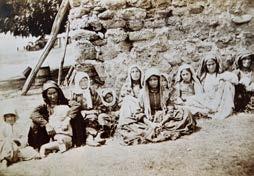
and poured wine in wineskin. They took their precious horses to the woods and abridged their lives by shooting a bullet under their ears.
The Muhajirs started proceeding to the seashore, the sobs and cries of women punctuating the journey. They had put fire to their homes before leaving them. Only cats and dogs were left in the burnt-out villages. Pskhu was empty.
The abolition of the Principality of Abkhazia, the colonialism of the Russian Empire, the brutal bureaucratic intrusion into everyday life, and the fact that the Abkhazian social order and customs were not taken into account, resulted in a massive feeling of discontent that grew into a popular uprising. The uprising started on July 26, 1866 in the village of Likhni and soon spilled over almost the entire territory of Abkhazia. The Tsarist regime was quick to unleash its troops to the region and quell the revolt.
After taking control, the Tsarist government decided it needed to get rid of Abkhazians who nurtured particularly strong anti-Russian sentiments – Muslims and pagans who were mainly concentrated in the middle and upper parts of the Kodori Valley. The Russians believed that exiling the Muslims would help them to gain political order, and therefore strengthen the Tsarist rule. They succeeded in clenching a deal with the rulers of the Ottoman Empire, who agreed not to let Muhajirs settle in the immediate vicinity of Russia’s borders or return to the places of their origin.
The vice-regent and commander-in-chief in the Caucasus, Grand Duke Mikhail Romanov, ordered the start of the process and thus began the exile of Abkhazians in late April of 1867. He also deployed additional troops in Abkhazia in order to prevent any riot. Abkhazians were mainly pressed into emigration by force. Keeping track of the Muhajirism process, newspaper ‘Droeba’ wrote (in June 1867): “Abkhazians feel weighed down… Tsebeldians, Dalelians and Gupulians have already left… Chiloians and Jgerdians have been driven out of their homes. They feel unutterably depressed about leaving. Abkhazians speak very well of Dimitri Chavchavadze, Chief of the Bzipi precinct. He gave them fatherly advice to prefer Russian rule to living in exile in the Ottoman Empire.”
1867 wlis aprilis bolos dawyo. SesaZlo areulobis aRsakveTad, afxazeTSi jaris damatebiTi nawilebic Sevida. afxazTa gadasaxleba, ZiriTadad, ZaldatanebiT xasiaTs atarebda. muhajirobis cxel kvalze, 1867 wlis ivnisSi, gazeTi `droeba~ werda: `afxazebi Zlier dajavrianebulni arian... webelelebi, dalelebi da gufuelebi wavidnen... Wilouelebi da jgerdelebi gamorekes TavianTi binidan. maT saSineli guliT ar undaT wasvla. afxazebi didad aqeben bzifis mazris ufross dimitri WavWavaZes. man mamobrivi mzrunvelobiT auxsna maT, rom rusis mmarTvelobis qveS yofna sjobs osmaleTSi gadasaxlebas~. 1921-1927 wlebSi saqarTvelos kaTolikospatriarqis uwmidesisa da unetaresis ambrosis (xelaia) cnobiT, muhajirobis dros afxazeTis episkoposTan, yovladsamRvdelo aleqsandresTan (oqropiriZe), romelic afxazebSi didi siyvaruliT da pativiscemiT sargeblobda, misula mahmadiani afxazi, saxelad urisi, 12 wlis SvilTan erTad. man mRvdelmTavars auxsna misvlis mizezi _ `SenTan movedi keTilo mwyemso, me osmaleTSi mivdivar, samSoblos samudamod veTxovebi da Cemi vaJi minda davtovo SenTan. coli da sxva Svilebi adre davkarge, ar vici ra momelis ucxo mxareSi, magram mainc vtoveb samSoblos. ar minda Cemi ubedureba erTaderT Svils gavuziaro da SenTan moviyvane. vici miiReb, aRzrdi qristianulad da bednieri iqnebao~. Tvalcremliani mama daemSvidoba Svils da wavida. afxazi ymawvili episkoposma aleqsandrem aRzarda, mRvdeli gaxda da didi sargebloba moutana qristianobas afxazeTSi. gazeTi `droeba~ afxazTa gadasaxlebis process ase aRwers: `navsadgurSi, romelsac jaris nawilebi icavdnen, ori mxriT Tokebi iyo gabmuli, rom wamsvlelebi da gamcileblebi erTmaneTs ar Sereodnen. dolis cemiT wamsvlelebs mouxmobdnen da gamosaTxovar musikas ukravdnen. rodesac gemi daiZvroda, mxiarul musikas daukravdnen, Semdeg ki mTeli batalioni Tofebs daclida~. 1857 wlis ivnisSi afxazTa gadasaxlebis procesi dasrulda. osmaleTis xelisuflebam, SeTanxmebisamebr, muhajirebi Tavdapirvelad kompaqturad, ruseTis imperiis sazRvrebidan Sors daasaxla _ nawili anatoliaSi, nawili balkaneTSi. gadasaxlebulebma TavianT dasaxlebebs is saxelebi Searqves, saidanac warmoSobiT iyvnen. ase gaCnda osmaleTSi soflebi: aac, akafa, guma, eSera, dal, wabal, Wlou, varCe, jgerda da sxv. afxazTa kompaqturi dasaxleba osmaleTis xelisuflebas mraval problemas uqmnida da muhajirTa gaTurqebis process xels uSlida, amitom portam Semdeg isini gafanta. afxazTa gadasaxlebis procesSi dgeboda muhajirTa siebi soflebis mixedviT, ojaxebis raodenobis, ojaxis Tavkacebis saxelisa da gvaris miTiTebiT, ojaxis wevrTa (kacebi, qalebi, bavSvebi) raodenobis CvenebiT. am siebis mixedviT, sofel fsircxadan gadasaxlda 51 ojaxi (210 suli), sofel
According to His Holiness and Beatitude Ambrosius (Khelaia), Catholicos-Patriarch of All Georgia in the years 1921-1927, a Muslim Abkhaz Muhajir-to-be named Urisi visited Bishop Alexander Okropiridze, who was highly respected and revered in Abkhazia, with his 12-year-old son. He explained the reason of his visit to the bishop – “I came to you, good shepherd, I am going to the Ottoman Empire, leaving my homeland forever, and I want to entrust my son to you. I lost my wife and other children, and I don’t know what will become of me in that foreign land, but still, I am leaving. I don’t want to share my condition with my son, and I brought him to you. I know that you will accept him, that you will raise him as a Christian, and that he will lead a happy life.” The weeping father said goodbye to his son and left. Bishop Alexander raised the young Abkhazian, who became a priest and did good services to Christianity in Abkhazia.
The newspaper ‘Droeba’ describes the forced emigration of Abkhazians as such: “In the heavily policed harbor, one could see ropes hanging in parallel to keep passengers and their kinsfolk apart. The sound of a drumbeat announced the time for passengers to go aboard amid farewell music filling the air. As the ships set off, the band struck up joyful music and soldiers kept firing in the air.”
In June of 1867, the emigration process of Abkhazians came to an end. Subject to the previous agreements with the Tsarist government, Ottoman rulers set up compact communities of Abkhazian Muhajirs far from the borders of the Russian Empire – part in Anatolia, and the rest in the Balkan Peninsula. Muhajirs gave these communities the names of their original villages, and this is how the following villages appeared in the Ottoman Empire: Aatsi, Akapa, Guma, Eshera, Dal, Tsabal, Chlou, Varche, Jgreda… The massive concentration of Abkhazians created many problems and held up the Turkification of Muhajirs, leading the Turkish authorities to break up the communities.
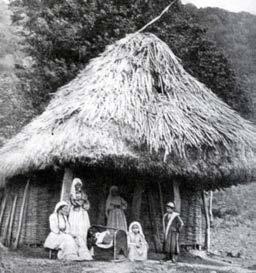
foqveSidan 10 (69 suli, 9 ojaxi faCulia _ 65 suli, 1 ojaxi jinjia _ 4 suli), sofel Wloudan _ 125 (539 suli), sofel aTaridan _ 7 (43 suli) da a.S. biWvinTis olqidan gadasaxlda 226 ojaxi (1357 suli), drandis olqidan _ 629 ojaxi (3245 suli), webeldis olqidan _ 2503 ojaxi (14 740 suli). amdenad, afxazeTidan 3358 ojaxi, 19 342 suli gadasaxlda. mTlianad `gaiwminda~ kodoris Sua da zemo weli, webeldis olqi _ webelisa da dalis Temebi. am Temebis TiTqmis 15 aTasiani mosaxleoba ucxoeTSi gadaixvewa. 1874 wels kavkasiaSi ingliseli mogzauri filip grouvi Camovida. igi yaraCaidan gadmovida kodoris xeobaSi, romelmac Zalian moxibla: `Znelia naxo ufro didebuli da mSvenieri adgili, vidre mdeloTi dafaruli velebi da tyeebi, romelzec kodori miedineba~, _ aRfrTovanebiT wers is. magram mogzaurs sevda da naRveli ipyrobs, roca xedavs, rom aq adamianis yofnis araviTari kvali ar Cans, _ `xeobis zemo weli sruliad ukacrieli iyo~, _ aRniSnavda igi.
1877 wlis aprilSi ruseT-osmaleTis axali omi daiwyo, romlis asparezi kavkasiac gaxda. omis dasawyisidanve rTuli viTareba Seiqmna afxazeTSi. carizmis koloniuri reJimiT gamowveulma ukmayofilebam am droisTvis kulminacias miaRwia da antirusulma, antikoloniurma ajanyebam ifeTqa. aseT viTarebaSi, 29 aprils, gudauTasTan Turquli desanti gadmosxda, romelic ZiriTadad afxazi muhajirebisgan Sedgeboda. soxumis garnizonis ufrosma, general-maiorma pavle kravCenkom, romelic imavdroulad soxumis samxedro ganyofilebis ufrosic iyo, ver gabeda SedarebiT Zlier mterTan Sebma, soxumi datova da md. kodorisken daixia. maisSi Turqebma TiTqmis mTeli afxazeTi daikaves. imavdroulad, ajanyebuli afxazebi TurqTa desants SeuerTdnen. antirusuli ajanyeba daiwyo CeCneTsa da daRestanSic. brwyinvale portas imedi mieca, rom ruseTis winaaRmdeg kavkasiis mTel mahmadianur mosaxleobas aamxedrebda, magram ruseTis jarebis warmatebebma kavkasiis frontze da gansakuTrebiT balkaneTSi, imedebi gaucrua. ivlisSi ruseTis jaris nawilebi Setevaze gadavidnen afxazeTSi da ukve agvistoSi mTeli mxare gawmindes Turqebisgan. afxazeTidan gaqcevisas Turqebs afxazTa nawilic gahyva; didi nawili, maT Soris, mcire raodenobiT qristiani qarTvelebi (megrelebi) da berZnebi ZaliT waiyvanes. ukan daxeuli Turqebi soflebs aoxrebdnen da uiaraRo mosaxleobas zRvis napirisken ZaliT mierekebodnen, iqidan ki gemebiT osmaleTSi mihyavdaT. gazeT `droebis~ korespondentis cnobiT, `sacodaoba iyo xomaldze gadayvanili afxazebis naxva... isini cxare cremliT stirodnen, zRvis napirisaken xelebs iSverdnen da amnairad eTxovebodnen Tavis samSoblo qveyanas~. TurqTa emisrebi soflebSi daZrwodnen da afxazebs aqezebdnen osmaleTSi
During the emigration process, lists of Muhajirs per village were created, showing the numbers of families, the names of the heads of the families, and the numbers of family members (men, women, and children) who had to leave for Turkey. According to these lists, 51 families (210 souls) were exiled from village Psirtskha, 10 from village Pokveshi (69 souls, nine Pachulia families – 65 souls, one Jinjia family – 4 souls), 125 from village Chlou (539 souls), 7 from village Atari (43 souls), and so on. 226 families (1,357) were exiled from the Bichvinta district, 629 (3,245) from the Drandi district, and 2503 (14,740) from the Tsebeldi district. In total, 3,358 families, or 19,342 souls were forcefully emigrated from Abkhazia. The middle and upper Kodori Valley were totally “cleaned”, as was the Tsebeldi district, consisting of the Tsebeli and Dali communities. This almost 15,000-strong community was sent abroad. In 1874, English traveler Philip Grove visited the Caucasus. He arrived in the Kodori Valley from Karachay, and was astonished by the place: “It’s difficult to imagine a richer and more wonderful place than the fields of meadow and forests of Kodori,” – he wrote. But once he sees that there is no trace of anybody living there, the traveler is quickly filled with grief and sorrow: “The upper part of the valley was completely desolate,” he noted.
In April of 1877, the new Russo-Turkish war broke out, involving the Caucasus region. The situation in Abkhazia escalated quickly. The dissatisfaction with the colonial regime of the Russian Empire reached its peak and sparked an anti-Russian and anticolonial insurgency. It was in this environment that on April 29, Turkish troops comprised largely of Abkhazian Muhajirs, executed a landing near Gudauta. General Pavle Kravchenko, head of the Sokhumi garrison and of the military section in Sokhumi, did not dare to clash with a relatively stronger enemy, so he left Sokhumi and retreated near the River Kodori. In May, the Turks took control of almost the whole territory of Abkhazia. Abkhazian insurgents joined the Turkish landing troops. An anti-Russian insurgency also started in Chechnya and Dagestan. The Ottoman Empire hoped that the whole Muslim population of the Caucasus would rebel against the Russians, but the successes of the Russian army on the Caucasian front, and especially in the Balkan Peninsula, crushed these hopes. In July, Russian forces carried out a counter-offensive in Abkhazia, and in August, they had already fought back the Turks.
On the run, the Turks were joined by part of the Abkhazians. They took most of them, including a small number of Christian Georgians (Megrelians) and Greeks, by force. The retreating Muslims employed a scorched earth policy, destroying and burning the villages, driving the unarmed population to the seacoast and loading them aboard vessels bound for the Ottoman Empire. According to a Droeba correspondent: “Abkhazians aboard the vessels made a sorry sight… In floods of tears, with arms outstretched towards the coast; they were leaving their homeland behind them forever”. Turk emissaries went to villages and incited Abkhazians to move to the Ottoman Empire, where they were promised an earthly paradise. Many chose death over life in exile and put up stiff resistance against the enemy. The Ottomans showed no mercy and
gadasaxlebuliyvnen, sadac miwier samoTxes hpirdebodnen. ucxoeTSi gadasaxlebas bevri samSobloSi sikvdils arCevda da mters winaaRmdegobas uwevda. osmalebi maT ar indobdnen da xocavdnen. gazeT `kavkazis~ cnobiT, zRvis sanapiroze eyara xelSeborkil da yelgamoRadrul afxazTa gvamebi. maT, Turme ukanasknel momentSi, gemebSi Casxdomis win scades winaaRmdegobis gaweva.
1877 wels muhajirobaSi TiTqmis 32 aTasi suli wavida. gumisTis ubnis 8 sasoflo Temi, sadac 2221 ojaxi (9985 suli) cxovrobda, mTlianad gadasaxlda; gudauTis ubnidan (17 sasoflo Temi), sadac adre 5293 ojaxi (23545 suli) cxovrobda _ 3775 ojaxi (17160 suli); kodoris ubnis 9 sasoflo Temidan ki, sadac 3935 ojaxi cxovrobda, 1071 ojaxi aiyara.
Tuki adre mTlianad daicala afxazeTis mTis Temebi fsxu, webeli, dali, axla TiTqmis mTlianad dacarielda afxazeTis sanapiro zoli. aRsaniSnavia, rom am dros aTasobiT afxazis monaTla. imereTis episkoposisa da afxazeTis eparqiis mmarTvelis episkopos gabrielis (qiqoZe) garjiT 19 aTasamde afxazi monaTla da masobrivi gadasaxlebisgan ixsna.
gaukacurebuli afxazeTi damTrgunveli sanaxavi iyo. rogorc didi mecnieri niko mari aRniSnavda `afxazeTis centraluri eTnografiuli nawilic ki gaukacurda... darCa mxolod gavelurebuli ezoebi xexiliT, ar iyo arc erTi afxazi da arc afxazuri sityva gaismoda~. gazeT `golosis~ korespondenti giorgi wereTeli maSin gulistkiviliT werda: `bunebidan dawyebuli irgvliv yvelaferi damwuxrebulia. ukacriel, veeberTela sivrceze, romelic jer kidev arc Tu didi xnis win dasaxlebuli da sicocxliT savse iyo, axla mxolod nangrevebi gvxvdeba da sicocxlis niSan-wyali ar igrZnoba~. mas mxars `iveriis~ korespondenti ubamda: `soxumidan or-sam verszed kargad damuSavebuli mamulebi gvxvdeba, magram pataras rom gascdebiT, siCume, ukacuroba da udaburobaa... gaivliT kidev TxuTmets, ocs verss Tvaluwvdenel tyeSi da versad SexvdebiT niSans adamianis mosaxleobisas. natrobT, neta an Robe mainc davinaxo, an ZaRlis yefa gavigono, rom qveyana ise carieli ar meCvenos, rogorc adamianis gaCenis winaT iyoo. ra gasakviria, rom afxazeTis umTavres qalaqis axlo-maxlo aseTi siCume iyos, rodesac afxazeTSi afxazebi aRar arian~.
rodesac osmaleTis miwieri samoTxis miTi daimsxvra, bevri muhajiri samSobloSi dabrunebas Seecada, magram ruseTis xelisuflebas maTi miReba ar surda. ruseTsa da osmaleTs Soris dadebuli SeTanxmebiTac muhajirebs samSobloSi dabrunebis ufleba ar hqondaT. miuxedavad amisa, muhajirebi jiutad cdilobdnen, zogi zRviT, zogi xmeleTiT, gamoeRwiaT osmalTa da rusTa saguSagoebisTvis da mSobliur keras dabruneboda.
slaughtered anyone who got in their way. The newspaper ‘Kavkaz’ lamented the sight of the seacoast littered with the handcuffed and throat-slit bodies of Abkhazians. At the last moment, right before boarding the ships, they had tried to oppose the Turks…
In 1877, a total of 32 thousand people joined the ranks of Muhajirs. Eight communities from the village Gumisti, populated by 2,221 families (9,985 souls) were exiled; 3,375 families (17,160 souls) from the Gudauta area (17 communities), where there used to be 5,293 families (23,545 souls); and 1,071 families from the nine communities of the Kodori area, where there were once 3,935 families.
Where at first the mountainous villages of Pskhu, Tsebeli and Dali emptied, now, it was almost the whole length of the Abkhazian coastline that had become desolate. It is worth noting that thousands of Abkhazians were baptized during that period. Thanks to the hard work of Gabriel (Kikodze), bishop of Imereti and head of Abkhazia’s diocese, up to 19,000 Abkhazians were baptized, and were able to escape exile.
Abkhazia looked heartbreakingly bleak. As the great scientist Niko Marr put it, “even the central ethnographic part of Abkhazia is emptied… The only things left are wild yards with fruit trees; there is no single Abkhazian, and no Abkhazian word to be heard.”
Correspondent of newspaper Golos, Giorgi Tsereteli, wrote in sorrow: “There is a terrible sense of anguish everywhere, even in nature. A vast desolate area that quite recently pulsed with life now lies in ruins utterly bereft of human life”. In the newspaper Iveria, one could read: “Country estates two-three versts away from Sokhumi are alternated by a wretched scene of desolation, ruin and silence… You may walk fifteen or twenty versts farther into the wood without coming across any trace of life. Eyes look desperately for a glimpse of some manmade fence, ears strain to hear a dog barking just to make sure that the world is not as empty as before the origin of life on earth. But this silence in the vicinity of Abkhazia’s major city, is not unexplained. Its explanation lies in the fact that Abkhazians no longer live in Abkhazia.” After the myth that the Ottoman Empire looked like an earthly paradise was dispelled, many Muhajirs attempted to return home, but the Russian government refused to let them in. According to the agreement between the Russian and Ottoman empires, Muhajirs didn’t have the right to return home. Regardless, many Muhajirs attempted the return, whether by sea or by land, sneaking through Turkish and Russian checkpoints.
Among the ones who managed to return to their homeland, was the father and family of Dimitri Gulia, who would become the founder of Abkhazian literature. In 1878, Uris (Ioseb) Gulia, who buried two of his children abroad, arrived in Batumi on a felucca together with his family, and from there, he went to Abkhazia. They didn’t allow him to return to his native village of Varche, on the right shore of River Kodori, so he was forced to settle on the left bank of the river, in the village Adzubzha. As Gulia recalled, their house in Adzubzha was right in front of their former house, and they could see the latter on the other side of the river, and would always feel sad when looking in its direction.
samSobloSi malulad dabrunebulTa Soris iyo SemdgomSi afxazuri mwerlobis fuZemdeblis dimitri gulias mamac mTeli Tavisi ojaxiT. 1878 wels uris (ioseb) gulia, romelmac ucxoobaSi ori bavSvi damarxa, lazi meTevzis felukiT ojaxTan erTad baTumSi Camovida, iqidan ki afxazeTSi CaaRwia. uris gulias mdinare kodoris marjvena napirze, sofel varCeSi, mSobliur keraze dabrunebis neba ar darTes, amitom is iZulebuli gaxda kodoris marcxena napirze, sofel aZubJaSi dasaxlebuliyo. rogorc dimitri gulia igonebda, maTi saxli aZubJaSi im adgilis mopirdapired idga, sadac mdinaris meore napirze maTi yofili saxli mosCanda da mudam gulistkiviliT gascqerodnen mas. ruseTsa da osmaleTs Soris san-stefanos zavis dadebis Semdeg, muhajirebi pirvel rigSi baTumisken gaemarTnen, romelic jer isev osmaleTis SemadgenlobaSi Sedioda da afxazeTSi dabrunebas iqidan cdilobdnen. qarTveli sazogadoebriobis daxmarebiT afxazTa erTi nawili baTumsa da mis SemogarenSi damkvidrda, sadac afxazi muhajirebi 1864 wlidan cxovrobdnen. muhajirTa STamomavlebi dResac iq cxovroben, maT didwilad SeinarCunes TviTmyofadoba, sakuTari ena. baTumelma afxazma aslan smirbam erTxel aseTi ram dawera: `Cveni winaprebi iZulebulni iyvnen afxazeTidan ruseTis imperias gamoqceodnen. aWaraSi damkvidrebul afxazebs musrs avlebda SimSili da tifi. maSin aWarlebma da gurulebma daaweses `gadarCenis xarki~ _ Cveni winaprebisTvis saWmelsa da tansacmels urmebiT ezidebodnen. amis daviwyeba ar SeiZleba. es Cemi Taobis afxazebmac ki ician~. qarTveli sazogadoebrioba didi TanagrZnobiT Sexvda afxazTa muhajirobas, tragedias, ramac afxazi xalxi, faqtobrivad, fizikuri ganadgurebis safrTxis winaSe daayena. gamoCenilma qarTvelma mwerlebma da sazogado moRvaweebma: grigol orbelianma, ilia WavWavaZem, iakob gogebaSvilma, sergi mesxma, giorgi wereTelma, zaqaria WiWinaZem, petre Waraiam, niko janaSiam, iona meunargiam, Tedo saxokiam da sxvebma gulwrfeli TanagrZnoba gamoxates afxazTa mSobliuri mxaridan iZulebiT gasaxlebis gamo. bolos afxazTa mozRvavebam ruseTis mTavroba aiZula 1879 wlis 27 ianvars konstantinopolSi xeli moewera osmaleTTan xelSekrulebisTvis, romlis Tanaxmadac ruseTis xelisuflebam dauSva afxazebis nawilobrivi repatriacia xelSekrulebis xelmoweridan sami wlis ganmavlobaSi. amis Sedegad, 1882 wlis ianvrisTvis afxazeTSi 15 aTasamde muhajiri dabrunda. afxaz muhajirTa STamomavlebi amJamad cxovroben TurqeTSi, siriaSi, iordaniaSi da balkaneTis qveynebSi. muhajirobam afxazi xalxi, faqtobrivad, fizikuri ganadgurebis safrTxis winaSe daayena. muhajirTa STamomavlebi dResac unaxavi samSoblos siyvaruliT da dardiT cocxloben, romelic Taobidan Taobas locvasaviT gadaecema.
beJan xorava

After Russia and the Ottoman Empire signed the Preliminary Treaty of San Stefano, Muhajirs first headed to Batumi, which was still under Ottoman rule, and tried to reach Abkhazia from there. With the help of Georgian society, a number of Abkhazians settled in Batumi and its surroundings, where other Abkhazian Muhajirs had been living since 1864. Descendants of Muhajirs still live there to this day, and many of them have maintained their autonomy and speak Abkhazian. Batumian Abkhazian Aslan Smirba once wrote the following words: “Our ancestors were forced to flee from Abkhazia because of the Russian Empire. Abkhazians who settled in Adjara were massacred by famine and typhus. That is when Adjarians and Gurians established the “survival tribute” – providing our ancestors with food and clothes in carts. We cannot forget this. Even Abkhazians of my generation know this.”
Georgian society met the Abkhazian Muhajirs and their tragedy with great empathy. Renowned Georgian authors and public figures Grigol Orbeliani, Ilia Chavchavadze, Iakob Gogebashvili, Sergi Meskhi, Giorgi Tsereteli, Zakaria Chichinadze, Petre Charaia, Niko Janashia, Iona Meunargia, Tedo Sakhokia and others expressed their sincere compassion for the Abkhazians, who had been forcefully exiled from their land.
In the end, the continuous influx of Abkhazians made the Russian government repeal the law that denied Muhajirs the right to return to their homeland for three years, by signing an agreement with the Ottoman Empire in Constantinople on the 27th of January 1879. Up to 15,000 Muhajirs managed to return to Abkhazia until 1882. The descendants of Abkhazian Muhajirs now live in Turkey, Syria, Jordan, and the Balkans.
Muhajirism practically put the Abkhaz people under threat of physical disappearance from this earth. Descendants of Muhajirs still feel a surge of love and sharp pain at the thought of their neverseen homeland. These feelings are handed down from generation to generation as something as cherished as a prayer.
Bezhan Khorava

Tamaz Cxenkeli
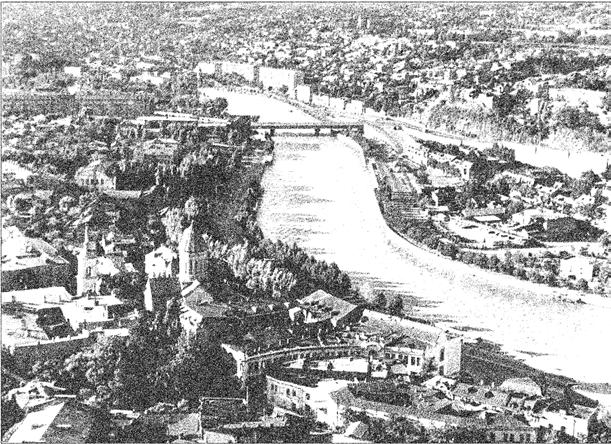
Tamaz Chkhenkeli
ormocdaaT wels gadavabije da moskovSi namyofi ara var. nodar dumbaZem damireka: moskovi ar ginaxavs da `stumris~ statusiT giSveb mweralTa sakavSiro yrilobazeo. yrilobaze miwveuli mwerlebi, anu mweralTa kavSiris wevrebi, e.w. `deputatebad~ da `stumrebad~ iyofian. gansxvaveba imaSia, rom deputatebi xmis micemis uflebiT arian morWmulni, stumrebisagan gansxvavebiT. CavediT moskovSi. Casulebs `diplomatebs~ urigebdnen. guram fanjikiZes wavyevi am Savi, patara Cemodnis asaRebad, romelSic, yrilobaze damswreTaTvis, sawer-kalami unda debuliyo. SevediT oTaxSi da aviReT es `diplomatebi~ da iqve gaisma SekiTxva: Tqven deputati xarT, Tu stumari? stumari, _ vupasuxe. maSin dadeT mag `diplomati~ da, meore mwkrivze mimiTiTa, iqidan aiReTo. rom gamovedi gurams vkiTxe: albaT, raRac gansxvavebaa am `diplomatebs~ Soris-meTqi. araviTario. gavogndi! gurami SenobasTan mdgar did urnasTan SeCerda, miixed-moixeda, gaxsna `diplomati~, bloknotebi da kalmistrebi amoiRo, danarCeni urnaSi CauSva. mec es gamakeTebina, swrafad, swrafad, aravin dagvinaxoso. raSia saqme? breJnevis broSurebiao. amityda xarxari. meore saRamos geno kalandiam miTxra: yrilobis monawileTaTvis aq specialuri maRaziaa, marina cvetaevas ortomeuli iyideba da icodeo. amjerad Tamaz WilaZes gavyevi. patara, orsarTuliani saxlis meore sarTulze avediT da moviTxoveT cvetaevas wignebi. ortomeuls vaTvaliereb da uceb mesmis igive kiTxva: deputati xarT, Tu stumari? stumari-meTqi rom vuTxari, Secbunebulma momigo: Tqven ar gekuTvniTo. aman gamaStera, magram Tavi Sevikave da RimiliT vuTxari: albaT `deputatebi~ ukeT erkvevian poeziaSi, vidre `stumrebi~-meTqi. daxlSi mdgari simpaTiuri qali aSkarad uxerxulobas grZnobda da meti araferi miTqvams. magram jer Turme sada xar!
I was then over fifty but had never been to Moscow. Nodar Dumbadze called and offered me to attend the all-union congress of writers in Moscow in guest status. The writers invited to the congress, i.e. members of the Writers’ Union, were divided into two groups: the so-called “deputies” and the “guests”. The difference between them was that deputies were vested with the right to vote, unlike guests. On arrival in Moscow each participant of the congress was to receive a “diplomat” - a small black briefcase, which contained pens and writing paper. I went for my “diplomat” with Guram Panjikidze. We entered the room, took our “diplomats” and were asked the immediate question: “Are you a deputy or a guest?” “I’m a guest” - I said. “Then put down this “diplomat” and take that one from the other row.” Coming out of the room I asked Guram whether there was any difference between these “diplomats”. He said there was none. I was startled! Guram came up to a dustbin, looked around, then opened his “diplomat”, took out pens and notebooks and emptied the remaining contents into the dustbin. He made me do the same, hurrying me up, so as not to grab anyone’s attention. “What’s this?”- I asked. “Brezhnev’s brochures.” It made me roar with laughter.
The next evening Geno Kalandia told me that there was a special shop for congress participants, which had Marina Tsvetaeva’s two-volume edition for sale. I went there with Tamaz Chiladze. We climbed the steps of a two-storey house and asked for Tsvetaeva’s books. I was browsing through the books, when the same question suddenly reached my ears: “Are you a deputy or a guest?” That I was a guest caused the shop assistant to become confused, who said that the books were not for me. It threw me off a bit again, but I regained my composure and said, smiling, that it seemed “deputies” had a better understanding of poetry than “guests”. The shop assistant, who was quite a pretty woman, looked embarrassed and I said no more. I did not know that worse was still to come.
We descended to the first floor to buy typing machine tapes. We
pirvel sarTulze sabeWdi manqanis lentebi moviTxoveT. oTx-oTxi lenti aviReT da sanam fuls gadavixdidi, Cemda gasaocrad, aqac igive avbediTi kiTxva ganmeorda: `stumari~ xarT? maSin mxolod ori lenti gergebaTo. guli amemRvra da lentebi daxlze davuyare. es iyo biurokratiuli gamoTayvanebis, idioturi ierarqiulobis zeniti. saRamos, restoranSi rom SevikribeT, nodars vuTxari: aseTi diferenciacia Zvel egvipteSic ar yofila, ra maRal materiebzea laparaki, yrilobaze es unda iTqvas, jer es saqme unda moagvaron-meTqi... kremlis ezoSi Sesvlamde (yriloba iq mimdinareobda, svetebian darbazSi) karibWesTan SevCerdi: dafa iyo kedelze gamokruli, sadac kremlis agebis istoria iyo mokled gadmocemuli. kargi, geyofa ganaTlebis miReba! _ Sesvlas maCqarebs arCil sulakauri. 74 metris simaRle yofila kremli, veubnebi arCils gansakuTrebuli toniT, rac umalve daiWira da swrafadve momigo: da mere ra! is, rom alaverdis taZari ori metriT maRalia kremlze. ras ambobo, da visac veubnebodi, aravis sjeroda. ai, ras niSnavs ideologiuri propagandiT gamagrebuli vizualuri zewola.
kremlis ezoSi iqauri fotografi suraTebs uRebs mwerlebs, ra Tqma unda, saxelganTqmul mwerlebs. arCilis nacnobi iyo da Cvenc gadagviRo suraTebi. magram roca arCilma uTxra: amas, amas gadauRe, es pirvelad aris moskovSio, fotografi gadairia: pirvelad? SeuZlebelia! marTla pirvelad xarT moskovSi? daujerebelia! da Tan aparats aCxakunebs, yovel SeZaxilze TiTo suraTs miRebs. asaki mkiTxa da daaskvna: am suraTebs davawer, _ 54 wlis mwerali, romelic pirvelad iyo moskovSi, _ da gadavrev xalxso. meore dRes guram gverdwiTels (Cven erT oTaxSi viyaviT sastumroSi) taqsiT wavyevi, raRac saqme hqonda. manqanaSi velodebi da taqsis mZRols vesaubrebi. mkiTxa da vuTxari, rom moskovi Zalian momewona. gaSlili sivrce, jansaRi haeri, arbatis myudro quCebi, romlebic Tbilisur quCebs magonebda, kremlis ucnauri intimiT gaJRenTili midamo, romelSic disonansi Sehqonda leninis absurdul mavzoleums. winandelTan SedarebiT ra cvlilebebi SeniSneTo, _ mkiTxa. pirvelad var-meTqi, rom vuTxari, pirdapir Seicxada: rogor, me Sofer kacs sabWoTa kavSiris uamravi qalaqi maqvs davlili, saqarTveloSic vyofilvar
took four tapes each, but before I paid for them, I heard the same question ring out ominously: “Are you a guest? Then you can take only two tapes.” Overwhelmed by a surge of anger, I dropped them scattering over the counter. It was the zenith of bureaucratic stupor and idiotic hierarchy. In the evening, as we gathered in a restaurant, I pointed out to Nodar that such discrimination was unknown even in Egypt and that the congress had to address this problem first, before moving on to some high-flown ideals.
Before entering the yard of the Kremlin, (that’s where the congress was held in the pillared hall), I halted at the gate. There was a board fixed to the wall, giving a brief history of the Kremlin. “Have done with reading” - Archil Sulakauri was in a fuss. “The Kremlin appears to be 74 meters in height” - I said in a heavily toned voice that made him snap back immediately. “So what?” - He was quick to respond. “Alaverdi Church is two meters higher than the Kremlin” - I said. Later, whoever I told this looked at me in disbelief, behind which lay visual pressure buttressed by ideological propaganda.
There was a photographer in the Kremlin’s yard taking photos of writers, of the famous writers of course, but he was an acquaintance of Archil’s and took our photos as well. When Archil told him that I was in Moscow for the first time, he almost lost his head with excitement: “For the first time? But it’s impossible! Are you really in Moscow for the first time? Incredible!” At each such exclamation he clicked his camera and photographed me. Then he asked me how old I was and decided to inscribe on the back of the photos the words “54-year-old writer on his first visit to Moscow” and send all into wonder.
The next day Guram Gverdtsiteli (my room-mate in the hotel) took me on some business with him. As I waited for him in a taxi, the driver asked me about my impressions of Moscow and I told him that I liked Moscow very much, I liked its vast expanse, the healthy air, Arbat’s quiet streets reminding me of streets in Tbilisi and the strange aura of intimacy hanging around the Kremlin, disturbed only by Lenin’s absurd mausoleum. He asked me if the city had undergone any alterations since my previous visit. My confession that I was in Moscow for the first time shocked him utterly: “I’m no more than a driver and I’ve traveled a lot throughout the Soviet Union, including Georgia. How can this be your first visit to Moscow?!” When he cooled down a bit, he asked me what I did in the summertime. I said I roamed around my own country. He fell silent for a moment and then, in a low and seemingly sorrowinflected voice, uttered: “It means that you love your country.”
My second visit to Moscow was on Losev’s invitation, on the

da Tqven pirvelad xarT moskovSi? cota rom daSoSminda mkiTxa: ki, magram ras akeTebT zafxulobiTo. zafxulobiT saqarTvelos sxvadasxva kuTxeSi vmogzaurob-meTqi. erTxans gayuCebuli iyo da mere xmadabla, da rogorc me momeCvena, raRacnairi naRveliT dasZina: значит вы
свою родину meorejerac viyavi moskovSi, amjerad a. f. losevma mimiwvia Tavis 90 wlis iubileze. am uaRresad saintereso iubiles peripetiebi aRwerili da gamoqveynebuli maqvs, magram ar aRminiSnavs erTi momenti, romelsac TviTon iubilesTan araviTari kavSiri ar hqonia. Cems meuRles amanaTi unda mietana viRacisTvis. daviWireT taqsi. Soferi monRoloiduri tipis mrgvalsaxiani rusia. mivediT. droze gamodi, vafrTxileb meuRles, amis gasalanZRi ar gamxado! vzivar Cabnelebul manqanaSi da velodebi. wuTi saaTad meCveneba. manqanaSi dumili Semzarav iers iZens. vah, sad aris amden xans, Semomibrundeba es kaci da raRac uxiags metyvis qarTvelebze da ar vici ras vizam. dro saSineli siswrafiT garbis. daZabuloba kulminacias aRwevs... da rom momelbo mZRolis guli da misi upiratesoba meRiarebina, mokrZalebuli toniT vekiTxebi: Можно выкурить сигарету? da am kiTxvis pasuxad ucnauri ram mesmis: Не только можно, но и нужно! aman gamaStera da sanam azrze movidodi man sxapasxupiT ganagrZo: es erTaderTi manqanaa sabWoTa kavSirSi, romelSic moweva aucilebeliao. ras eweviT? kolxeTs! o, miyvars qarTuli sigaretebio. sinaTle aanTo: verafers xedavT? ra unda davinaxo? man xeli gaiSvira da me manqanis parprizis Sua nawilSi davinaxe ori gojis simaRle Savi firfita, romelzec reliefuri TeTri asoebiT ewera qarTulad! _ `moswieT~, aseTive reliefuri TeTri Zaxilis niSniT. raa es? _ viyvire. es Cemi colisZmis oinia. me dedabriSvilis qali myavs colad... da man zedized gaimeora ucxoTaTvis Znelad gamosaTqmeli ramdenime qarTuli sityva. is miyveboda Tavis ambebs, xSirad axsenebda Tavis erTaderT gogonas da isic aRniSna TavmowonebiT, rom kaxeTSi yofnisas Tamada iyo, da rom sufridan, qarTuli wesisamebr, bolos is adga. am kacis saxeli da gvari maxsovs: Юра Бушуев! Sen iseTi kaci xar saxlSi geqneba-meTqi kaxuri Rvino. gamiTavda, Torem aqedan pirdapir saxlSi wagiyvandio... Cemi megobrebi, romlebic ocjer da ocdaaTjer iyvnen namyofi moskovSi, maSayirebdnen: biWo, sul eqvsi dRe iyavi moskovSi da aseTi ra naxe, rom saTqmeli ar gelevao.
koreeli abatis gaamerikelebulma da gamdidrebulma Svilma Seqmna seqta, romlis gasacnobad da propagandis gasawevad msoflios sxvadasxva qveynebidan, maT Soris yofili sabWoTa respublikebidan, vaSingtonSi miiwvia stumrebi. gza _ aqeT da iqiT, agreTve, eqvsdRiani sastumro uzrunvelyofili iyo misive fuliT.
occasion of his 90th birthday. I have already written and published the description of this highly interesting celebration, but then I skipped over one interesting point, which bore no relation to the jubilee itself. My wife had to hand over a parcel to someone. We took a taxi. The driver was a round-faced Russian, with distinctly Mongolian features. On arrival at our destination, I warned my wife not to keep us waiting and spare me the embarrassment of his complaints. Sitting and waiting in the darkness of the car, minutes seemed like hours. Silence was already pressing on me. I thought the driver, bored to death with waiting, would turn to me at any moment and say something sharp about Georgians. Feeling the strain reaching its culmination and trying to win the driver’s heart and confirm to him his superiority, I asked him humbly: “May I smoke a cigarette?” What came in reply was strange enough: “Not only may, but must!” I was taken aback and before I could come to my senses, he added that it was the only car in the Soviet Union in which it was necessary to smoke. “Which brand do you smoke?” - He asked. “Kolkheti.” “Oh, I’m fond of Georgian cigarettes.” Then he switched on the light. “Can’t you see it?” “What?” He reached out his hand and in the middle of the front window I saw a black plate displaying white Georgian letters followed by a white exclamation mark, written all in bold relief! The inscription read: “Smoke!” “What’s this?!” - I cried out. “It’s a trick of my brother-in-law. My wife is Georgian, she’s Dedabrishvili’s daughter.” Then he uttered several Georgian words, which are particularly difficult for foreigners to pronounce. He spoke eloquently about his life, often mentioning his only daughter, and recalled with pride his visit to Kakheti, where he had acted as toastmaster and had left the table last, as Georgian tradition dictates. I remember the name of this man: lura Bushuev! “Such a man as you are must surely have Kakhetian wine at his place,” - I told him. “I’ve run out of it. But if I had it I wouldn’t hesitate to take you directly there,” he replied.
My friends, who had been to Moscow 20 and even 30 times often joked that I, with my scant 6 days in this city, never seemed to go short of memories.
The enriched and Americanized son of some Korean abbot set up his own sect and to popularize it and make it universally known, he invited to Washington a group of representatives from various countries, including the Soviet republics, and took it upon himself to cover their return travel and hotel expenses for 6 days.
The Georgian delegation consisting of several men, including me, flew to Washington via London. At the very first session, it was revealed that the sect leader did not recognize Christ’s divine nature and His conception from the Holy Spirit (He was asserting directly that Joseph knew about his wife’s adultery). Such statements sounded blasphemous to all Christians (Orthodox and Catholic believers alike). The head of our delegation, Jansugh Charkviani, declared from the pulpit that those views were unacceptable to Georgia. It is interesting to note that representatives of Armenia and Azerbaijan were more focused on the problems of Karabakh than on religious issues.
londonis gavliT saqarTvelos delegacia, ramdenime kacis SemadgenlobiT, CavfrindiT vaSingtonSi. pirvelsave sxdomaze gairkva is, rom seqtis meTauri ar scnobda qristes RvTiur bunebas, rom ieso suliwmindis Casaxulad ar miaCnda (pirdapir ambobda, rom iosebma icoda colis Ralatis ambavio) da sxv. yoveli qristianisaTvis (marTlmadidebeli iqneba is Tu kaTolike) es gancxadeba mkrexelurad JRerda da Cveni delegaciis xelmZRvanelma jansuR Carkvianma Tqva kidevac tribunidan, rom aseTi Tvalsazrisi saqarTvelosTvis miuRebelia. saintereso iyo, rom somxeTisa da azerbaijanis warmomadgenlebi yarabaxis problemebze ufro amaxvilebdnen yuradRebas, vidre religiur aspeqtebze.
Cven SevwyviteT sxdomebze daswreba. meore dRes vestumreT saqarTvelos elCs amerikaSi baton Tedo jafariZes. man dawvrilebiT mogviyva iq momxdari tragikuli ambavi. gardacvlilis deda TviTon mosula saelCoSi, da rogor daxvdebodnen iq momuSave qarTvelebi _ xom gasagebia! mere amerikelebisTvis uTqvams: ra gulTbili xalxi yofilao, rogor momisamZimres, rogor ganicdidneno... aravin icis vina varT, micvalebulis gapatiosnebis ra didi kulturaa saqarTveloSi.
batonma Tedom orjer gvimaspinZla: pirvelad vaSingtonis feSenebelur sastumros restoranSi dagvpatiJa, sadac Turme kenedi da merlin monro farulad xvdebodnen erTmaneTs, da meored, axlomdebare zRvispira patara qalaqSi italiur restoranSi, sadac imJamad qorwilis rituali sruldeboda. es saporto qalaqi dekoraciulad gamoiyureboda, aTasfrad SeRebili saxlebiT da gamwvanebuli ezoebiT. sxvaTa Soris, restorans rom vuaxlovdebodiT, erTma Suaxnis kacma xeliT gaaCera arCil sulakauri, hkiTxa: italiano? arCilma, mere: ase vgavar italielso? magram kmayofili iyo, iRimeboda. viyaviT ferweris sasaxleSi (pikasos calke Senoba ukavia). CemTvis cnobili suraTebis axlodan dakvirvebam Semacbuna. dednebia, Tu aslebi? _ vikiTxe. dednebiao!.. adre gamovedi Senobidan da kibeze Camovjeqi. cota xanSi jansuR Carkviani gamovida: ra mogivida, ra gunebaze xaro. ra gunebaze viqnebi, dednebs vucqerdi da reproduqciebi magondeboda, romlebic dednebze ufro momwons-meTqi. es, ra Tqma unda, Cveni aRzrdis xarvezebia, rac rkinis fardas unda dabraldes. ukan rom movbrundiT, sastumros win asfalti ayrili dagvxvda. erTi kaci muSaobda _ zangi. xeliT vaniSne _ ratom ayare-meTqi asfalti da man erTi umniSvnelo bzaris ormtkavelian xazze mimiTiTa. ase uvlian dedaqalaqs. qalaqis quCebi TiTqmis carielia. TiToorola gamvleli Tu Segxvdeba. muSaobs xalxi!
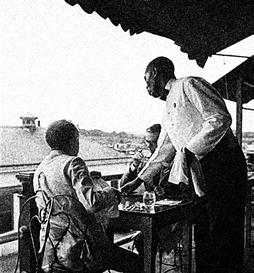
We withdrew our presence from the sittings. The next day we paid a visit to Mr. Tedo Japaridze, Ambassador of Georgia to the United States. He informed us in detail about the tragedy which had occurred there and how the mother of the deceased had herself arrived at the embassy and how the Georgian diplomats had received her, what she had later told her fellow Georgians, their warmth, compassion and ability to feel and share the same pain with others... Nobody knows who we are and how rich is our culture of paying final homage to the dead.
Mr. Japaridze hosted us twice: first he invited us to a restaurant in a luxurious hotel in Washington, where Kennedy and Marilyn Monroe used to have their secret rendezvous, and then to an Italian restaurant in the nearby seaside town, where a marriage ceremony was being held at the moment of our visit. This port town had a rather decorative aspect with its multicolored houses and the greenness of its gardens. Incidentally, when we were approaching the restaurant, an elderly man stopped Archil Sulakauri and asked him: Italiano? Later Archil asked us if he really looked like an Italian. In any case, he seemed very content with it, smiling.
Then we visited the palace of pictorial art (Picasso takes up a separate building there). A closer look at the well-known pictures bewildered me. “Are they originals or reproductions?” -I asked. “Originals!” I came out of the building early and sat down on the steps. After a little while, Jansugh Charkviani joined me. “What’s the matter with you, why are you in such a mood?” - he asked. But how could I feel when staring at originals my thoughts kept turning to reproductions, which I liked more? Of course it is the fault of our upbringing and it must be blamed on the Iron Curtain.
mesame Tu meoTxe dRes dagviriges oc-oci dolari. yvelam raRaca SeviZineT maxloblebisaTvis. aTi dolari damrCa da vaxo visockis vTxove: damaxarjine es fuli, rom saTqmelad mqondes, vaSingtonSi kaci davpatiJemeTqi. Semiyvana kafeSi. vaxo visocki Tbiliseli qarTvelia. miTxra: gagiJebuli var, Cemi biWi aq swavlobs da es ra ubeduri wesi hqoniaTo, _ rame Tu moxda moswavleebs Soris, erTmaneTs aswreben maswavlebelTan dasabezReblad. biWma miTxra, rogor moviqceo. vaxom: ar damRupo, es ar qna, eg Cveni wesi ar ariso. ki, magram _ vkiTxe _ skolaSi xom megobroben-meTqi. saqmec is aris, rom klasidan klasSi gadayvanisas moswavleebs, gansakuTrebiT _ damegobrebulebs, erTmaneTs aSoreben, paralelur klasebSi gadahyavT, rom es maTi megobroba moiSaloso. dabezReba karg tonad iTvlebao. SemaZrwuna aman da vaxoc SeZrwunebuli iyo: unda davbrunde saqarTveloSio... kafeSi Cveni msubuqi `seroba~ dasrulda, magram... fuli arafris didebiT ar gadamaxdevina vaxom, da Cemi saTbiliso `qadili~ CaiSala. 29 aprils aRdgoma iyo. meore diliT unda dagvetovebina vaSingtoni. Sadiman SamanaZem: CemTan amodiT, erTi boTli arayi maqvso. avediT jansuRi, arCili da me. nel-nela da cot-cotas vsvamdiT, rom gagvexangrZlivebina erTad yofna. movigoneT nodar dumbaZe, guram asaTiani da otia paWkoria. ar vicodiT, es ukanaskneli aRdgoma Tu iqneboda arCilisaTvis, magram vgrZnobdiT siberis susxs da drois avbediTobas. saqarTvelodan Sors roca xar, yvelafers gansakuTrebuli aura axlavs. rom gamovdiodiT, Sadimanma miCurCulma: rogor gyvarebiaT erTmaneTio. es sityva Cvens Taobas exeboda, marto Cven _ ara... axali CaZinebuli mWaxe zarma gamomaRviZa, xma derefnidan moismoda. Turme xanZars dauwvavs Cveni sastumros erTi oTaxi. fanjridan Canda ramdenime saxanZro manqana da maRal-maRali zangebi. Cavedi dabla da ras vxedav! _ mTeli vestibiuli xalxiT aris gaWedili. Cacmul-daxurulebi, CemodnebiTa da bargibarxaniT gamzadebulebi sxedan. da am damfrTxal xalxSi _ gavixede da modis erTi Cveniani _ Silifad Cacmuli, da ager, meore Cveniani, isic samgzavrod Caucmel-dauxuravi, da mesamec... mSvidad daseirnoben am awrialebul xalxSi da erTmaneTs ekiTxebian, ra moxda aseTi, ra mouvida am xalxso? ra iyo es? Cveneburi udardeloba, Tu realuri situaciis fxizeli Sefaseba? meore diliT gamovfrindiT saqarTveloSi.
When we returned we found that the asphalt in front of our hotel had been ripped up. There was only one black man working there. I asked him using gestures why he had done it and he pointed his finger to a tiny crack in the asphalt. That’s how they take care of their city. The streets are almost empty. Only two or three passers-by can be seen. On the third or the fourth day, 20 dollars was handed out to each of us. We all bought something for our family members. In order to dispose of my remaining 10 dollars, I asked Vakho Visotsky to let me spend this money on him so that I could boast in Tbilisi of being able to invite someone out in Washington. He took me to a café. Vakho Visotsky is a Georgian from Tbilisi. He said his son was studying there and he was dismayed at the rules, which governed children’s behavior. He added that if there was some incident in school, children were happy to be the first to inform teachers on one another. “My son asked me what to do about it” - Vakho said -”and I told him not to bring disgrace upon me, for it is not our rule.” “But don’t children make friends with one another?” - I asked. “The thing is that pupils who strike up close friendships are separated each year in different classes in order to erode this friendship. Informing on someone is a good tone there.” I felt shocked and so did Vakho. He said he ought to return to Georgia... Our light supper in the café was thus over but ... Vakho did not let me pay for it. So my plans about boasting in Tbilisi were canceled.
29 April was Easter Sunday. The following day we were leaving Washington. Shadiman Shamanadze invited Jansugh, Archil and me for a bottle of vodka. We sipped our drinks slowly, in small gulps, to linger on together. We recalled Nodar Dumbadze, Guram Asatiani and Otia Pachkoria. We did not know then that it was going to be the last Easter for Archil, but we felt the chilly breath of old age and the viciousness of time. When you are far away from Georgia, everything seems to be cloaked in a different aura. As we were parting, Shadiman Shamanadze whispered to me: “How strongly you love each other!” and it was true not only of us, but of our whole generation.
No sooner had I fallen asleep than I was awakened by the brassy sound of a siren issuing from the corridor. As it turned out, fire had broken out in one of the rooms of our hotel. From the window I could see fire engines and some tall black men. I went down to find the hall already crowded with people. All were wrapped up fully in their clothes, equipped with their suitcases and luggage. I looked around amid these frightened people and saw one of our group members, dressed casually, then another, his clothes also showing no sign of preparedness, and a third one ... all walking calmly among this fussing people and wondering curiously at their agitation. What was it -Georgian carelessness or our sober assessment of the situation?
The next morning we caught the flight to Georgia.

TeatrisTvis sagangebod Seqmnili farda pirveli da unikaluria, rac warmodgenasTan erTad mayureblis mexsierebaSi rCeba. is TiTqos speqtaklis nawilia _ amZafrebs emocias da waruSlel STabeWdilebas tovebs, rogorc dadgmis dawyebamde, aseve misi damTavrebis Semdegac; miT umetes Tu xelovanis xeliTaa Seqmnili. swored aseTi iyo sergo qobulaZis funjiT naxati jadosnoba, romelic 1960 wlidan 13 weli amSvenebda zaqaria faliaSvilis saxelobis Tbilisis operisa da baletis Teatrs. 1973 wlis 9 maisis xanZarma TeatrTan erTad fardac imsxverpla _ farda, romelic Tbilisis operis simbolod qceuliyo da romlis aRdgenac mxolod ormocdasami wlis Semdeg gaxda SesaZlebeli. bunebrivia, dRes fardis avtoris, misi cxovrebisa da Semoqmedebisadmi interesi didia. vin iyo sergo qobulaZe _ mxatvari? mecnieri? eriskaci?

The magnificent stage curtain we are going to talk about was created especially for the Opera and Ballet Theater and is one of its most impressive features and most distinctive symbols. It can almost be perceived as an integral part of the performances, as it intensifies emotions both before their beginning and after their ending. Such was the magic brush painting created by Sergo Kobuladze which embellished the Opera and Ballet Theater for 13 years from 1960 and burned down with the building on the 9th of May 1973. It took 43 years to recreate that curtain and return it to the stage. Naturally, people want to know more about its creator, his life, and career. Who was Sergo Kobuladze – A painter? A scientist? A public figure?
1909 wlis 7 Tebervals daibada axalcixeSi. mamamisi samxedro iyo, deda _ diasaxlisi, romelic SesaniSnavad qargavda Turme...
1920 wels ojaxTan erTad TbilisSi gadmosuli skolis paralelurad boris Sebuevisa da nikola sklifasovskis xatvis gakveTilebs iRebda. misi niWi da mowesrigebuli xasiaTi skolisdroindel geometriis rveulSic Cans. skolis damTavrebis Semdeg Tbilisis samxatvro akademiaSi ganagrZo swavla (1925-1930 ww.) _ „pirvelmeore kursze akademiaSi mxolod xatvas gvaswavlidnen. pirvel wels kursi ioseb Sarlemans mihyavda, momdevnoze ki evgeni lanseres. gansakuTrebulad bevri viswavle da SeviZine gigo gabaSvilisgan, romelic ferweris anabanas
Sergo Kobuladze was born on February 7th, 1909, in Akhaltsikhe. His father was a military man, his mother a housewife who excelled at embroidery.
After his family moved to Tbilisi in 1920, he started taking painting lessons from Boris Shebuev and Nikolay Sklifosovsky. His talent and discipline can already be perceived in his geometry notebook of that time.
After graduating from high school, he continued his studies at Tbilisi’s Academy of Arts (1925-1930). “The first couple of years, we learned painting technique exclusively. The courses of my first year were led by Ioseb Sharleman, those of my second year by Yevgeny Lansere. I learned and discovered very much from Gigo Gabashvili, who taught us the basics of painting. It is he who made me
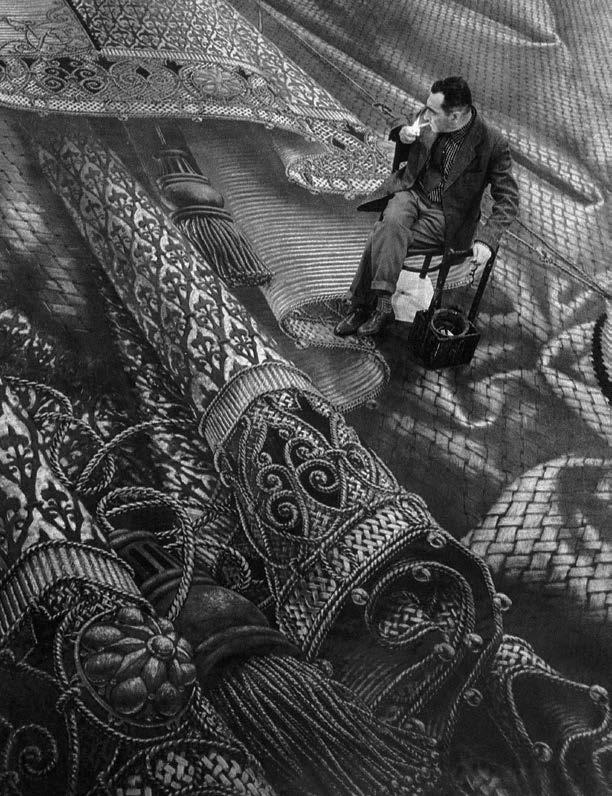

gvacnobda. pirvelad misgan gavige, Tu ras niSnavs Tbili da civi tonebi, ramac Cemze didi STabeWdileba moaxdina~, _ ixsenebda mogvianebiT Tavad qobulaZe. Zveli qarTuli xelovnebis ZeglebiT samxatvro akademiaSive swavlisas dainteresda, romelTac mogvianebiT Teoriul-mecnieruli naSromi `oqros kveTa~ miuZRvna. masSi mimoxilulia mcxeTis jvris taZris arqiteqturaSi mignebuli oqros kveTis wesi, atenis sionis XI saukunis freskebSi napovni adamianis sxeulis proporciis etaloni, aseve antikuri da qarTuli arqiteqturuli Zeglebis kompoziciuri agebis principebi... imavdroulad safuZvlianad Seiswavla dasavleT evropuli, gansakuTrebiT ki italiuri renesansis epoqis xelovneba. akademiis damTavrebis Semdeg Teatris dekoraciebi da sxvadasxva speqtaklis kostiumebis eskizebi Seqmna. 1932 wlidan igi aformebs speqtaklebs Tbilissa (kote marjaniSvilis miwveviT) da moskovSi.
1935 wels 25 wlis sergo qobulaZem rusTavelis 750 wlis iubilesTvis „vefxistyaosnis“ dasuraTxatebis sakonkurso seria Seqmna. mis garda konkursSi monawileobdnen _ lado gudiaSvili, Tamar abakelia, irakli ToiZe... da gaimarjva. es Sedevrebi patara, bnel saxelosnoSi Seiqmna da... imdroindel samxatvro
understand what warm and cold tones meant, and he had a great influence on me,” Sergo Kobuladze would later recall.
While studying at the Academy, Kobuladze became interested in the architecture of old Georgian buildings. He wrote ‘Golden Ratio’ on this subject, a theoretical scientific research paper discussing the golden ratio principles used in the architecture of the Jvari Church in Mtskheta, the standard proportions of the human body found on the frescoes of the Ateni Sioni Church (11th century), and architectural composition principles used in Georgia more generally, as well as abroad, in antiquity. He also thoroughly studied Western European art and particularly the Italian Renaissance.
After graduating from the Academy, he worked on theater sets and costume sketches for a number of performances. He was a theater set designer from 1932, in Tbilisi (on the invitation of Kote Marjanishvili) and Moscow.
In 1935, 25-year-old Sergo Kobuladze designed an illustration series for ‘The Knight in the Panther’s Skin’ in the framework of a contest dedicated to Rustaveli’s 750th anniversary. His competitors were the highly appraised and famous painters Lado Gudiashvili, Tamar Abakelia and Irakli Toidze, but Sergo won. These masterpieces, which were created in a small poorly-lit studio, brought fame to the artist within painting circles. Unfortunately, not a single piece remains in Georgia – the Tretyakov Gallery bought some of them right away, and the rest were sent to the Moscow
wreebSi mxatvars didi grafikosis saxeli daumkvidra. samwuxarod, saqarTveloSi erTi namuSevaric ki ar darCa _ nawili maSinve iyida tretiakovis galeream, nawili ki _ moskovSi aRmosavleTis xalxTa xelovnebis muzeums gaegzavna. dRemde qobulaZis ilustrirebuli „vefxistyaosani“
12-jer qarTulad; 22-jer rusulad; 2-jer inglisurad da TiTojer _ azerbaijanul, arabul, germanul, estonur, somxur, sparsul, frangul, yirgizul da esperantos enazec ki gamoica.
1938-39 wlebSi mxatvarma kidev erTi mniSvnelovani namuSevari Seqmna _ rusuli poemis, „ambavi igoris laSqrobisa“, ori Seudarebeli ilustracia. mxatvris SemoqmedebaSi gansakuTrebuli adgili fanqarSi Sesrulebul savonarolas da dantes saxeebsac uWiravT. 1956 wels am ukanasknels italiaSi, veneciis bienaleze, udidesi warmateba xvda wilad.
1950-iani wlebis meore naxevarSi samxatvro akademiis studentoba impresionizmisa da postimpresionizmis STabeWdilebis qveS moeqca. am dros akademiis reqtori (1952-59 ww.) sergo qobulaZe iyo. mxatvar-keramikosi nana kiknaZe ixsenebs: `sergo qobulaZem akademiis saaqto darbazSi miiwvia meamboxe sulis axalgazrda Taoba, maT Soris: jibson xundaZe, koki maxaraZe, edmond kalandaZe, gogi ToTibaZe, mito xaxutaSvili, merab berZeniSvili da sxvebi. qobulaZe mSvidad Camovida kaTedridan, magidaze mdgari wyliT naxevrad savse boTli aiRo da gadaWedil darbazs mimarTa _ „me xelSi miWiravs boTli...“ _ darbazs Rimilnarevma dacinvis CurCulma gadauara, SigadaSig studentebis xmamaRali sicilic ki gaisma. „es is boTli ar aris, Tqven rom ggoniaT. es wyliT savse boTlia. me mas franguli sunamos esenciis erTi wveTi davumate, romelic wyals Seeria da is namdvil sunamod aqcia. amas gTxovT Tqvenc, rac gindaT is akeTeT, magram sakuTar namuSevars erTi wveTi erovnulisa yovelTvis daawveTeT da qarTuli arasodes dakargoT“. sergo qobulaZe zogjer ver uZlebda cdunebas da studentebTan erTad leqciazeve iwyebda naturidan xatvas. misi moswavleebi, giorgi wereTeli da Temo gocaZe ixseneben, rom baton sergos ar uyvarda studentTa namuSevrebSi raimes Casworeba, mxolod SeniSvniT ifargleboda da rCevas aZlevda _ „yvelaferi unda icodeT, yvelanair teqnikas unda flobdeT, rom SegeZloT sakuTari ideebis xorcSesxma, da mere gnebavT mravalfeniani xateT, gindaT `a la prima~, impresia da gnebavT kubisturio“.
1969 wels, erT-erTi interviuSi mxatvari aRniSnavs: „SemoqmedebiTi intuicia _ arsebiTi niWia SemoqmedisTvis, ese igi nawarmoebis Sesaqmnelad; magram Tu is inteleqtis mier ar aris organizebuli, stiqiuri da anarqiulia.
State Museum of the East. His illustrations for ‘The Knight in the Panther’s Skin’ were published in Georgian versions of the book 12 times, 22 times in Russian and two times in English, and also in the Azerbaijani, Arabic, German, Estonian, Armenian, Persian, French, Kirghiz and even Esperanto versions.
In the years 1938-39, he created another important series – two exceptional illustrations for the Russian poem ‘The Tale of Igor’s Campaign.’
His pencil portraits of Savonarola and Dante met with great success in Italy’s Venice Biennale in 1956 and hold a particular place among his creations.
During the late 1950s, Art Academy students were greatly influenced by impressionism and postmodernism. At that time (1952-59), Sergo Kobuladze was the Director of the Academy. Ceramist Nana Kiknadze remembers: “Sergo Kobuladze invited rebellious young students to the conference room: Jibson Khundadze, Koki Makharadze, Edmond Kalandadze, Gogi Totibadze, Mito Khakhutashvili, Merab Berdzenishvili, and many others. Mr. Kobuladze slowly approached a table, took a half-full bottle in his hand and addressed the crowd: ‘I’m holding a bottle in my hand…’ Students started whispering, some of them laughed mockingly. ‘This is not the bottle you think it is. This is a bottle filled with water, but I added a drop of French fragrance to it. It dissolved in the water and turned it into real perfume. This is what I’m asking from you: do what you want, but always add one drop of national spirit to your works and never lose sight of it’, he said.” Sometimes, Sergo Kobuladze couldn’t resist the urge to paint and would start painting in front of his students during his own lectures. His students Giorgi Tsereteli and Temo Gotsadze say that Mr. Kobuladze was never fond of correcting students’ work, he would only make a note and give them a piece of advice – “You need to know everything and master all the techniques to be able to materialize your ideas. If you achieve this, you may paint in many layers, “alla prima”, you may do impressionism or cubism, whatever you like”.
In one of his interviews dating back to 1969, the painter states: “Creative intuition is an essential gift for making compositions. However, if it’s not controlled by intellect, it becomes disastrous and anarchical. One gains creative intuition by acquiring knowledge and skills. If technique is mastered, then we’re talking about art, but mastering techniques alone doesn’t make art, just as talent alone doesn’t make art. Art is a combination of creative intuition and skills mastery. This is what I really mean by the word ‘art’.” Kobuladze believed that in order to create a masterpiece, a painter has to know physics, chemistry, geometry, composition, and even the laws of gravity. In 1972, he opened a studio to enable young students to practice and improve their skills and knowledge. The studio is still functioning today under the direction of Giorgi Tsereteli.
Another initiative of Sergo Kobuladze led to the foundation of a special photo laboratory for the archiving of Georgian paintings. It was later transformed into the George Chubinashvili National Research Center for Georgian Art History and Heritage Preservation.

SemoqmedebiTi intuiciis organizeba xdeba saxviTi teqnikis dauflebisa da codnis SeZenis gziT. Tu teqnika ostatobamde avida, is xelovnebis ekvivalenturia, magram teqnikis srulyofili codna jer mainc ar qmnis xelovnebas, iseve, rogorc marto niWi ar qmnis xelovnebis nimuSs. xelovneba sinTezia SemoqmedebiTi intuiciisa da maRali saSemsruleblo teqnikisa. es aris e.w. mxatvruloba“. qobulaZe Tvlida, rom Sedevris Sesaqmnelad mxatvars zedmiwevniT unda scodnoda fizika, qimia, geometria, kompozicia, mizidulobis kanonic ki. man profesiuli codnis gasaRrmaveblad axalgazrda, niWieri mxatvrebisTvis 1972 wels grafikis SemoqmedebiTi saxelosnoc daaarsa. saxelosno dRemde funqcionirebs da mas giorgi wereTeli xelmZRvanelobs. sergo qobulaZis iniciativiTve Seiqmna qarTuli ferweris ZeglTa fiqsaciis specialuri fotolaboratoria, romelmac mogvianebiT giorgi
The laboratory’s objective was to establish scientific standards in the photography of cultural heritage exhibits and monuments. The family archive of the Kobuladze family still holds many unique black and white photos.
“There are artists whose works are the product of rationalization, research, hesitation, and the decision-making processes. They will rarely give themselves more freedom in their creations than pondering allows them to, and they consider thought and mastership to be interdependent. They love some continuous aspect about their work and cherish it: they know every detail exactly because they have thought about it for a long time. The relation between the thought and the touch of the brush is a long and complicated one for them, and thought and decision become one. The execution of their thoughts is up to the hand” – writes Aka Morchiladze in an album dedicated to Sergo Kobuladze. It is after this kind of rationalization process, research, hard work, and many sketches, that Sergo Kobuladze created the curtain of Tbilisi’s Opera and Ballet Theater in 1960. This was a monumental masterpiece done in tempera, pigments, and egg yolk. It took him four years of tireless work, from which three were exclusively spent on preparing the general outline of the curtain, and 11 months of painting countless sketches on parchment and paper. Specialists agree on the fact that, to a large extent, the uniqueness of Kobuladze’s curtain is due to his use of the very difficult multilayered technique used by masters of the Italian Renaissance such as Michelangelo, Raphael, and Leonardo da Vinci. As his student Loreta Shengelia recounts, Sergo Kobuladze would come up with colors that do not exist in nature, which he could achieve through his own magical recipe of colors, combining tones carefully, and with much patience. He also used a special technique that prevented shadows caused by brush strokes to appear on the curtain. Despite his students’ great interest and wish to help, he wouldn’t let anybody near it, only allowing technical assistance such as blending colors or preparing brushes. The curtain was spread flat on the floor, and he would stand, walk, and even sleep on it. He would work on its details intuitively, but at the same time, with utter scrupulousness. As Temo Gotsadze tells us, Sergo painted the curtain like deaf Beethoven wrote his music – fragment by fragment, yet never losing the whole picture in his imagination. If any part of the curtain got dusty, he would clean it with brown bread. Based on various sketches and material, we know he painted Orpheus, but after the public identified the figure as a muse, Kobuladze played along…
On the 9th of May 1973, the Opera and Ballet Theater, or “Fairy Palace” as Alexandre Dumas referred to it in his ‘Journey to the Caucasus,’ caught fire. Everything was destroyed – the hall, the stage, almost every sketch, decoration, costume, document, photo, the archive, and the library. Some people were also injured. Last, but not least, Kobuladze’s curtain burned to ashes. This was a tragedy for the painter. In a 1978 interview for the newspaper ‘Tbilisi,’ when asked which of his paintings was his favorite, he answered: “The one that was the most difficult to work on – the curtain of the Opera Theater”.
CubinaSvilis saxelobis erovnul kvleviT centrSi daido bina. laboratoria miznad isaxavda kulturuli memkvidreobis nimuSTa fotogadaRebis mecnierulad damuSavebuli standartebis damkvidrebas. qobulaZeebis saojaxo arqivSi dResac uamravi unikaluri Sav-TeTri fotoa SemorCenili.
„arseboben xelovanebi, romelTa xelovneba xangrZlivi fiqris, ufro farTo Ziebis, orWofobisa da gadawyvetilebebis Sedegad ibadeba. isini Znelad miscemen xels imaze met Tavisuflebas, rac mas fiqrisas gadauwyvites. fiqri da ostatoba amaTTan erTmaneTis saWiroebiT moqmedeben... maT uyvarT raRac mudmivi TavianT saqmeSi da ufrTxildebian mas: maT zustad ician, radgan didxans fiqroben... fiqrisa da xelis urTierToba, aseT SemoqmedTaTvis xangrZlivi da rTulia, fiqri da gadawyvetileba erTia. maTi aRsruleba xels evaleba“, _ wers sergo qobulaZisadmi miZRvnili erT-erTi albomis Sesaval werilSi aka morCilaZe. 1960 wels, aseTi dakvirvebis, kvlevis da dauRalavi Sromis, uamravi eskizis xatvis Sedegad Seqmna qobulaZis xelma Tbilisis operis fardac. es monumenturi xelovnebis Sedevri iyo, Sesrulebuli temperaSi, pigmentebiT da kvercxis guliT, e.w. repinis tiloze. Tavdauzogavi muSaobis 4 weli _ aqedan 3 eskizebis momzadebas dasWirda, 11 Tve ki _ uamravi Canaxatis, eskizis gakeTebas pergamentze da formatis qaRaldze. specialistebi fardis unikalurobasa da ganumeoreblobas metwilad miaweren qobulaZis mier italiaSi aRorZinebis xanis titanebis: miqelanjelos, rafaelis, leonardo da vinCiseuli mravalfeniani urTulesi teqnologiis gamoyenebas. mxatvris erT-erTi mowafis _ loreta Sengelias TqmiT, fardis xatvis procesSi, qobulaZe bunebaSi ararsebul ferebs iRebda, romelTa moZiebasac ferTa gamis miRebis sakuTari magiuri receptiT, frTxili SereviTa da funjiT xelSi saocari moTminebiT aRwevda. rogorc mxatvris mowafeebi amboben, fardis xatvisas igi mxolod lisirebis teqnikas iyenebda, rom monasmiT muSaobisas Crdili ar gaCeniliyo. miuxedavad Segirdebis ganuzomeli interesisa da daxmarebis survilisa, mxatvari fardas aravis akarebda (mxolod teqnikur daxmarebas sjerdeboda _ saRebavis Sereva, funjebis momzadeba, a.S.). tilo iatakze hqonda gafenili da masze xatvaSi garTuli, mosiarule da dawolilic aTenaRamebda... intuiciurad da amave dros skrupulozuri sizustiT amuSavebda fardis detalebs. Temo gocaZis TqmiT, rogorc yru beThoveni werda musikas, sergoc mis msgavsad xatavda fardas, fragment-fragment, Tumca warmosaxvaSi mis mTlianobas xedavda. fardaze dagrovil mtvers ki Savi puris guliT iRebda. uamravi Canaxatisa
Years after the fire, the public still wasn’t able deal with the destruction of this cultural hearth, and when the Opera and Ballet Theater was being rebuilt, Kobuladze was asked to paint its curtain once again. He happily accepted the offer. This time, he decided to use a 23-layer technique and to paint the figure of a horseman instead of Orpheus. He invited his cousin and assistant Ilia Tatishvili and started work on the new sketches. Unfortunately, he was unable to finish the curtain.
The idea and desire to bring back Kobuladze’s curtain had been present for years in artist circles, although nobody knew how this would be possible. Some, including Gia Kancheli, believed that using today’s technology, digital files would enable the printing of a copy that would be close to the original curtain. A group of artists including Temo Gotsadze, Radish Tordia, Loreta Shengelia, and Muraz Murvanidze got together to find out the best way to restore it. Minister of Culture and Monument Protection of Georgia, Mikheil Giorgadze; Director of the Georgian Theater, Cinema, Music and Choreography Museum, Giorgi Kalandia; and counselor of the Minister of Culture and Monument Protection of Georgia, Giorgi Gegechkori were also actively involved in this process. As Giorgi Kalandia stated, they had four sketches in their possession at the museum, all created at different times and in different circumstances: the first was done in pencil on
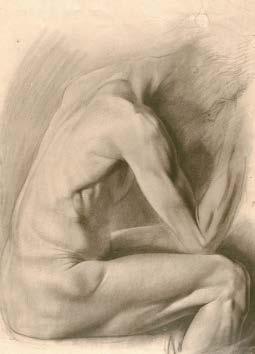
Tu eskizis mixedviT, dokumenturi masalis safuZvelzec, orfeosis figuris daxatva hqonda Cafiqrebuli. mas mere ki, rac sazogadoebam is muzad aRiqva, qobulaZec ar SeewinaaRmdega...
1973 wlis 9 maiss, operaSi _ „feriaTa sasaxleSi“, rogorc mas aleqsandre diuma Tavis `kavkasiaSi ~ moixseniebs, xanZari gaCnda, romelmac gaanadgura _ darbazi, scena, TiTqmis yvela eskizi, dekoracia, kostiumi, dokumentebi, fotoebi, arqivi da biblioTeka. iyvnen daSavebulnic. yvelaferTan erTad TiTqmis bolomde Caiferfla qobulaZiseuli fardac. mxatvrisTvis es udides tragediad iqca. 1978 wels gazeT „TbilisSi“ gamoqveynebul interviuSi kiTxvaze _ „yvelaze metad Tqveni romeli namuSevari giyvarT?, mxatvari pasuxobs: „is, romelzec yvelaze metad gamiZnelda muSaoba... saopero Teatris farda“. xanZris Semdeg ramdenime weli gavida. sazogadoeba ver egueboda erovnuli kulturuli keris ganadgurebas da rodesac Teatris aRdgenaze daiwyes fiqri, qobulaZes fardis xelaxla Seqmna sTxoves, razec mxatvari sixaruliT dasTanxmda. xelovanma amjerad 23 feniani teqnikis gamoyeneba gadawyvita da... muzis nacvlad cxenosnis figuris daxatva. fardis Sesaqmnelad deidaSvili da asistenti, ilia tatiSvilic miiwvia da axal eskizebze Seudga muSaobas, Tumca, samwuxarod, am Canafiqris xorcSesxma veRar dascalda. wlebis ganmavlobaSi xelovanTa wreebSi mudam iyo survili qobulaZiseuli fardis aRdgenisa, oRond rogor, ra teqnologiiT, aravin uwyoda. nawili da maT Soris gia yanCelic Tvlida, rom Tanamedrove teqnologiebis arsebobis pirobebSi, SesaZlebeli iqneboda Sesabamisi cifruli failis daxmarebiT originalTan SeZlebisdagvarad miaxloebuli mxatvruli tilos dabeWdva. da marTlac _ daiwyo konkretuli msjeloba, Seiqmna xelovanTa samuSao jgufi: Temo gocaZis, radiS Tordias, loreta Sengelias, muraz murvaniZis SemadgenlobiT, romelSic aseve aqtiurad iyvnen CarTulni saqarTvelos kulturisa da ZeglTa dacvis ministri _ mixeil giorgaZe, saqarTvelos Teatris, musikis, kinosa da qoreografiis saxelmwifo muzeumis direqtori _ giorgi kalandia, saqarTvelos kulturisa da ZeglTa dacvis ministris mrCeveli _ giorgi gegeWkori. yvela cdilobda fardis reabilitaciis yvelaze optimaluri gzis gamonaxvas. giorgi kalandias TqmiT, maT xelT arsebobda fardis oTxi, sxvadasxva dros Seqmnili eskizi: pirveli _ qaRaldze fanqarSi Sesrulebuli eskizi; meore _ e.w. vercxlisferi eskizi, romelSic kargad Canda ferTa palitra da figura; mesame _ maketi (kerZo koleqcia), romelic sivrcul ganwyobas qmnida; da bolo, meoTxe
paper; the second was the so-called “silver sketch” which had a clear color palette and a well-visible figure; the third version was a model from a private collection and offered a better rendering of the spatial composition, and the fourth and last was the Kobuladze-Tatishvili sketch. Some of the group believed that the only practicable plan was to create a replica of the curtain. After numerous debates, discussions, and consultations, Nana Iashvili (head of the Media Art Department at the Tbilisi State Academy of Arts) managed to create a digital version of Kobuladze’s masterpiece through the use of digital pictures, in a way that maximally preserved the charisma, artistic value, composition, and graphical features of the original, and which would allow its viewers to feel the same emotions they would have experienced in front of Kobuladze’s curtain.
The digital version of the curtain was then sent to the German company Gerriets, one of the leading companies in the field, which took care of the seamless printing process using a 12-meter-long printer. The same technology was used for the curtains of London, Barcelona, Berlin, and Vienna’s opera theaters.
The curtain that was revived using modern technology now embellishes the refurbished Opera and Ballet Theater. Together with their children and grandchildren, people can admire it in this historic monument once again, a mark of history’s continuity, a
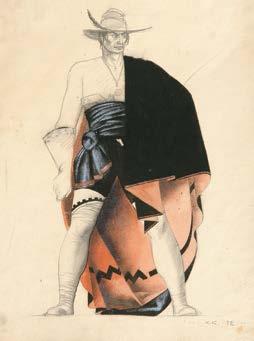
_ qobulaZe-tatiSviliseuli eskizi. xelovanTa nawili Tvlida, rom erTaderTi gamosavali fardis aslis Seqmnas gulisxmobda. araerTi Sexvedris, diskusiis, konsultaciis, monacemTa Sejerebis Sedegad, aseve arsebuli foto-masalis gamoyenebiT, nana iaSvilma (Tbilisis samxatvro akademiis mediaxelovnebis kaTedris xelmZRvaneli), samuSao gundTan erTad, SeZlo qobulaZis Sedevris cifruli versiis Seqmna ise, rom maqsimalurad SenarCunebuliyo xelovnebis nimuSis pirvandeli qarizma, misi mxatvruli Rirebuleba, rogorc kompoziciur-grafikuli, aseve ferweruli, da amave dros axali fardis mnaxvels kvlav daufleboda is gancda, rac qobulaZiseuli originalis xilvisas eufleboda.
cifruli teqnologiebiT aRdgenili fardis faili gadaegzavna erT-erT Tanamedrove teqnologiur lider germanul sawarmos Gerriets, romelic Tormet metrian printerze fardis unakerod beWdvas uzrunvelyofda da Canafiqrs xorci Seesxa. londonis, barselonas, berlinis, venis Teatrebis operis fardebic amave teqnologiiTaa Sesrulebuli.
dRes, axali teqnologiebis daxmarebiT gacocxlebuli farda iseve amSvenebs Tbilisis operisa da baletis ganaxlebul Teatrs... am monumenturi Zeglis sanaxavad isev daviwyeT Cven, Cvenma Svilebma da SviliSvilebma operaSi siaruli, rac albaT, istoriis uwyvetobas, tradiciebis da Tanamedroveobis kavSirs, im adamianebis pativgebas niSnavs, vinc aq muSaobda, vinc qmnida am Teatris istorias.
saqarTvelos kulturisa da ZeglTa dacvis saministros mxardaWeriT saqarTvelos Teatris, musikis, kinosa da qoreografiis saxelmwifo muzeums gadaeca _ erovnuli memkvidreobis nawilad iqca _ ilia tatiSvilis ojaxSi darCenili sergo qobulaZiseuli operis fardis eskizi (aqve inaxeba operis fardis pirveli eskizic). da mainc _ vin iyo sergo qobulaZe _ mxatvari? mecnieri? eriskaci? vicnobT ki?..
P. S. dimitri uznaZis N4-Si darCa erovnuli ganZis Semqmneli didi mxatvris samuSao sivrce, sadac erTmaneTs enacvlebian mulaJebi, Canaxatebi, keramikis gamosawvavi Rumeli (amJamad SesakeTebeli), dgas molberti, masze Camodebuli veeberTela planSetiT, romelic xelovanis xeliT fardis fanqarSi Sesrulebuli erTaderTi gadarCenil eskizia da droTa ganmavlobaSi qreba. albaT, saSuria Tu es saxelosnos muzeumad gadakeTeba da TiToeul Cvengans mxatvris jadosnur samyaroSi moxvedris saSualeba mogvecema. es is adgilia, sadac didi xelovanis suli cocxlobs.
maia morgoSia

link between tradition and modernity, and a sign of respect to all the people who have worked here and who have contributed to creating the history of this Opera Theater.
A sketch of Kobuladze’s curtain stayed in Ilia Tatishvili’s family and has now become a part of the national heritage of Georgia. With the support of the Ministry of Culture and Monument Protection, it is now preserved at the Georgian Theater, Cinema, Music and Choreography Museum, next to Kobuladze’s original, first sketch of the curtain. But still, who was Sergo Kobuladze – a painter? A scientist? A public figure? Do we even know him?
P. S. At #4, Dimitry Uznadze Street, there’ is a studio that once belonged to Sergo Kobuladze. It contains paintings, sketches, a ceramic furnace (that needs to be restored), and most importantly, an easel with an enormous board holding the only surviving pencil sketch done by the painter himself, which is slowly fading.
It would be great to transform this atelier into a museum so that everyone is given a chance to experience the magic world of the painter. This is the place where the great artist’s soul lives on.
Maia Morgoshia

`yvelgan da yvelaferSi unda iyo patiosani adamiani, es ufro metia, vidre iyo milionebis patroni~.
“One must be honest everywhere and in everything. It is much more than having millions in your possession.”
1906 wels, Tbilisis saxelmwifo universitetis (romelsac 1918 wlamde gimnazias uwodebdnen) saZirkvelSi, daviT sarajiSvilma erTi muWa oqro Cayara; niko cxvedaZes, romelic am saqmes Tavkacobda, 60 aTasi maneTi gadasca da uTxra: `aha, jer es ikmare, oRond nursad gamamJRavneb, daiwye saqme da ramdenic dagWirdeba aqa var~. iakob mansvetaSvili gadmogvcems, rom universitetis Senobis mSeneblobisTvis sarajiSvili aras zogavda, sakomisio bankebSi mis Tamasuqebs asi aTasobiT anaRdebdnen.
In 1906, David Sarajishvili threw a handful of gold coins into the foundation of Tbilisi State University (or “Gymnasium”, as it was called until 1918) and donated 60,000 rubles to Niko Tskhvedadze who was in charge of the construction of the university building. “Take this for the start but don’t disclose my name. As the work progresses let me know how much more you need. I am always at your disposal.”
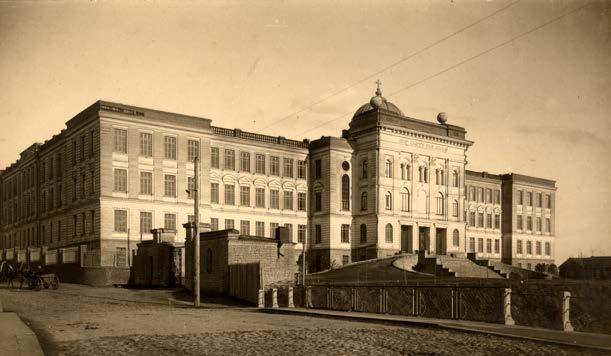
Iakob Mansvetashvili relates that Sarajishvili spared nothing for the University, his promissory notes were encashed in hundreds of thousands by many banks.
daviT sarajiSvili, 1848 wlis 28 oqtombers, SeZlebuli moqalaqis, sovdagrisa da memamulis zaqaria sarajiSvilis ojaxSi daibada. sarajiSvilebis winaprebs XVIII saukunis dasawyisSi vaxtang VI-sgan miuRiaT moqalaqis tituli.
daviTis aRzrdaSi, didi wvlili dedas _ SesaniSnav mandilosans, zaqarias marjvena xels da ojaxis burjs _ elisabed solomonis asul savanels miuZRvis. meuRlis darad elisabedic gulmowyale, RaribTa gamkiTxavi, Zveli qarTuli sibrZne-gonierebiT aRvsili da ganaTlebuli qalbatoni yofila. pirveldawyebiTi ganaTlebis saxlSi miRebis Semdeg, daviTi jer `hakes pansionSi~ swavlobs, Semdeg ki, 1866 wels, warCinebiT amTavrebs vaJTa pirvel klasikur gimnazias. imave wels, momavali mrewveli, peterburgis universitetis sabunebismetyvelo fakultetze warmatebiT abarebs misaReb gamocdebs. erTi wlis Semdeg ki swavlas germaniaSi agrZelebs. jer miunxenSi, Semdeg ki haidelbergis universitetSi, romelsac, 1871 wels, doqtoris xarisxiT amTavrebs. amave wels icavs disertacias filosofiis doqtoris samecniero xarisxis mosapoveblad. daviTi miRweuliT ar kmayofildeba da, 1878 wlamde, agrZelebs sasoflo-sameurneo mecnierebis Seswavlas jer hohenhaimsa da haleSi, xolo 1878-79 wlebSi safrangeTSi, sadac safuZvlianad eufleba meRvineoba-mevenaxeobis dargebs. daviTi ise gaitaca aryis, liqioris da, gansakuTrebiT, koniakis warmoebam, rom gadawyvita mTeli codna, samSobloSi dabrunebis Semdeg, am saqmis dafuZneba-ganviTarebisTvis Seelia. daviTis samSobloSi dabruneba mamis gardacvalebam daaCqara.
saqarTveloSi dabrunebis Semdeg igi daqorwinda cnobili Tbiliseli moqalaqis, mdidari vaWrisa da moijaris ivane foraqiSvilis asul ekaterineze. ekaterinesac kargi ganaTleba hqonda miRebuli da garda qarTulisa, mSvenivrad flobda rusul, inglisur, frangul da germanul enebs. zaqarias mier vaJisTvis naanderZev 700 aTas maneTs, uSvilod gardacvlili biZis solomon daviTis Ze sarajiSvilis qonebac daemata. damwyebma mrewvelma es memkvidreoba azrianad da saqmianad moixmara da, Zalze mokle droSi, erTi-meores miyolebiT, spirtiani sasmelebis qarxnebi SeiZina, aaSena da ganaaxla. sarajiSvilis firmis saqmianoba XIX saukunis dasasrulsa da XX saukunis dasawyisSi metad mravalmxrivi iyo da did warmatebas miaRwia. igi moicavda alkoholiani sasmelebis TiTqmis yvela saxis warmoebas _ xdida arays, asufTavebda spirts, amagrebda Rvinos, axdenda spirtis denaturacias, amzadebda sxvadasxva saxis liqiors, nayens, roms, xdida sakoniake spirts da amzadebda koniaks. sarajiSvilamde ruseTis
David Sarajishvili was born on the 28th of October, 1848, to a family of wealthy merchant and landowner Zakaria Sarajishvili. At the beginning of the 18th century, the Sarajishvilis were granted the title of Tbilisi Citizens by King Vakhtang VI.
David’s mother Elisabed Savaneli, Zakharia’s right hand and the pillar of the family, played a prominent part in David’s upbringing. Like her husband, she was a generous, well-educated woman and a benefactor for the poor and needy.
Having received his primary education at home, David continued his studies first at the Hake Boarding School and later at the Boys’ First Classical Gymnasium, from which he graduated with honors in 1866. The same year, the future entrepreneur enrolled in the Faculty of Natural Sciences of the St. Petersburg University. The following year, he continued his studies in Germany, first in Munich and then at Heidelberg University. In 1871, he graduated from the latter with a doctor’s degree in chemistry. The same year, he defended a dissertation and was awarded the degree of Doctor of Philosophy. David, however, was not satisfied with what he had already achieved and until 1878, he continued studying agricultural science, first at Hopenheim and Halle and later in France (1878-79) where he specialized in viticulture and wine-making. David was so fascinated with the production of vodka, liqueurs and, especially, cognac that after returning to Georgia he decided to use all his knowledge and experience for developing and promoting this business in his country.
His father’s death in 1880 precipitated David’s return to Georgia. After returning home, David married Ekaterine Porakishvili, the daughter of a well-known merchant and entrepreneur in Tbilisi, Ivane Porakishvili. Like David, Ekaterine had been well-educated and besides Georgian, was fluent in Russian, English, French and German. The property of David’s uncle Solomon Sarajishvili, who died childless, added to 700 thousand rubles inherited by David from his father. The young entrepreneur used his inheritance in a prudent and practical manner, buying, upgrading and building new wineries one after the other.
Already by the turn of the century, he had a thriving business, producing almost every kind of alcohol, including distillation of vodka, purification and denaturalization of spirit, making various types of liqueurs and rum, distilling spirit for cognac and making cognac. Prior to Sarajishvili, no one in the entire Russian Empire had tried to determine an active balance of wine materials for cognac spirit, distilment of cognac spirit using French technology and aging it in oak barrels. Even though Sarajishvili himself knew the theory and practice of cognac production perfectly, he invited liqueur and cognac specialists from France. Soon his products successfully competed with imports from Europe. In the early 20th century, Sarajishvili’s brand held more than two thirds of the market of the Russian Empire. It is generally recognized that David Sarajishvili was a pioneer and a founder of cognac production not only in Georgia and the Caucasus but also in the Russian Empire. Thanks to his product, the consumer obtained a high quality cognac made of pure wine spirit without any additives. In 1899-1913, various Sarajishvili
imperiis masStabiT aravis ucdia sakoniake spirtis Rvinomasalebis aqtiuri balansis dadgena, sakoniake spirtis franguli teqnologiiT gamoxda da muxis kasrebSi daZveleba. miuxedavad imisa, rom sarajiSvilma
SesaniSnavad icoda koniakis warmoebis rogorc Teoria ise praqtika, mainc safrangeTidan gamoiwera liqiorisa da koniakis warmoebis specialistebi. male misma nawarmma Rirseuli konkurencia gauwia evropidan Semotanil sasmelebs. XX saukunis dasawyisisaTvis ruseTis imperiis bazris or mesamedze meti sarajiSvilis produqciam daikava. saerTo aRiarebiT aramarto saqarTveloSi da kavkasiaSi, aramed ruseTis imperiaSic, daviT sarajiSvili koniakis warmoebis pioneri da fuZemdebeli iyo. misi produqciiT momxmarebelma sufTa Rvinis spirtisgan damzadebuli, yovelgvari minarevebisgan Tavisufali maRali xarisxis koniaki miiRo. 1899 _ 1913 wlebSi sarajiSvilis produqcia 14 medliT dajildovda, romelTa Soris 8 oqrosi iyo. niko nikolaZis qaliSvili, qalbatoni rusudani ixsenebs: `erTxel CvenTan binaze yofnisas akakim ixumra: ra meSveleba, Cemo niko, daviT sarajiSvili rom ar myavdeso. _ araferia, Cemo akaki, Sen gauZleb siRaribes, magram ra eSveleba qarTul Teatrs, wera-kiTxvis gamavrcelebel sazogadoebas da Rarib msaxiobebsa da moswavleebs udaviTod?~
daviT sarajiSvili mdidari, warmatebuli mewarme iyo, magram, sxva SeZlebuli adamianebisgan gansxvavebiT, misTvis fuli TviTmizani ki ara, saSualeba iyo qvelmoqmedebisTvis. aleqsandre xaxanaSvili sarajiSvilisadmi miZRvnil nekrologSi werda: `arc erTi saqveyno saqme ar dawyebula am 30 wlis ganmavlobaSi, rom daviT zaqarias-Zes Tavisi wvlili ar Seetanos, materialuri daxmareba ar gaewios. gazeT-Jurnalis, wignis gamocema, scenis moyvareTa, momReralTa, memusikeTa da mecnierTa gamozrda, eklesiis da skolis gamSveneba, Rarib-uZlurTa gakiTxva, ucxoel da Sinaur moRvaweTa gamaspinZleba da maTi erTmaneTTan daaxloeba _ yvela es Seadgenda sazrunav sagans gardacvalebuli daviTisaTvis~. sarajiSvilebis orive saxli, sergievis N13-Si (dRevandeli maCablis N13) da sasaxlis quCaze, stumarTmoyvareobiT iyo cnobili. daviTis saxlSi, sasaxlis quCaze, kviraSi erTxel Tavs iyridnen cnobili mwerlebi da sazogado moRvaweebi. kiTxulobdnen ama Tu im mwerlis nawarmoebebs, imarTeboda azrTa gacvla-gamocvla, romelic mTavrdeboda vaxSmiT, qeifiT. iakob mansvetaSvili igonebs: `mosvenebas ar vaZlevdiT ilias, gvindoda, rom `iveriisTvis~ raime axali moTxroba moeca. vicodiT, rom Canasaxad ukve aqvs dawyebuli moTxroba, romlisTvisac wina ganzraxva hqonia, mgoni `giorgi~ ewodebina saxelad,
products were awarded 14 medals including eight gold medals.
Niko Nikoladze’s daughter Rusudan recalls: “Once Akaki (Akaki Tsereteli), who was visiting us, joked: “What would I do, dear Niko, without David Sarajishvili?” “You would be able to withstand poverty Akaki, but what would happen to the Georgian theater, to the Society for the Promotion of Literacy and the poor actors and students without David’s help?”
David Sarajishvili was a rich and successful entrepreneur, but unlike many other wealthy people, he did not consider money as an end in itself, but as a means for doing charity. In his obituary for Sarajishvili, Alexandre Khakhanashvili wrote: “There has not been any significant undertaking initiated in the course of the past 30 years which David Sarajishvili had not contributed to or supported materially. Publication of newspapers, magazines and books, supporting artists, singers, musicians and scientists, rehabilitating schools and churches, helping the sick and the poor, hosting foreign and local public figures and artists and bringing them closer to one another – all this will be David’s enduring legacy.”
Sarajishvili’s two houses, one at 13 Machabeli Street (formerly Sergiev Street) and the other on Sasakhle Street, were famous for their hospitality.
Once a week, famous writers and public figures would get together at David’s house on Sasakhle Street. The latest works of different writers were first read here, usually followed by discussions and an exchange of ideas, ending with excellent food and drinks. Iakob Mansvetashvili recalls: “We never left Ilia in peace. We wanted him to write a new story for the Iveria newspaper. We knew that he had already begun writing something, realizing one of his earlier intentions. First he called the story “Giorgi” and then changed the title to “The Otaraant Widow”... The newly born story had to be baptized. David Sarajishvili was the irreplaceable and inseparable godparent of Ilia’s works. In fact, he was such a generous and loving godfather that he always held the baptizing ceremonies at his own house. This is how “Hermit” was baptized and this time, too, Sarajishvili was not going to break the established tradition. It was around eight o’clock in the evening when a large number of distinguished guests began to gather in Sarajishvili’s vast and beautiful house in Sololaki...
Ilia read his story. It was a long story so it was after midnight when the generous host invited all of us to supper. We went into a wide dining room with a magnificent table laid in the center. Supper proceeded very gaily, and was conducted masterfully by the toastmaster of the evening – elder Rapiel Eristavi.”
At one time, the Society for the Promotion of Literacy was located in the house in Sasakhle Street. In 1887, Akaki Tsereteli lived there for several months and Ivane Machabeli and Arthur Laist also stayed there for some time.
In the early 1900s, David had his ancestor’s house on Sergiev Street in Sololaki demolished, and built a new modern house there. Today this very building, where the loving couple celebrated their silver wedding in September 1905, houses the Writers Union of Georgia.
mere ki `oTaraanT qvrivi~ daarqva... axlad Sobils monaTvla undoda. ganuyreli, ucvleli naTlia ilias nawarmoebebisa daviT sarajiSvili iyo: imdenad guluxvi, pativcemuli naTlia, rom naTlobasac TviTonve ixdida Tavis stumarTmoyvare saxlSi. ase iyo monaTluli `gandegili~ da am wesrigs arc axla gadaudga sarajiSvili. saRamos rva saaTi iqneboda, sarajiSvilis farTo, mdidrulad mowyobil saxlSi, sololakSi, didZal qarTvelobas moeyara Tavi... iliam waikiTxa Tavisi moTxroba. amasobaSi karga xanma gaiara. SuaRame gadasuli iyo, puradma maspinZelma, daviT sarajiSvilma, yvelani vaxSmad migviwvia. SevediT did sasadilo oTaxSi, sadac didebuli sufra iyo gaSlili. vaxSamma mxiarulad Caiara. metadre lazaTi dasdo sufras Tamadam, moxucma rafiel erisTavma~. sasaxlis quCaze mdebare saxlSi iyo moTavsebuli erT dros wera-kiTxvis gamavrcelebeli sazogadoeba. 1887 wels, aq ramdenime Tve icxovra akaki wereTelma, cota xans cxovrobdnen ivane maCabeli da artur laisti. 900-iani wlebis dasawyisSi, daviTma, sololakSi, dRevandeli maCablis quCaze, mama-papeuli saxli daangria da, arqiteqturis ukanasknel miRwevaTa gaTvaliswinebiT, axali aago. am saxlSi, sadac mosiyvarule meuRleebma, 1905 wlis seqtemberSi, `vercxlis qorwili~ aRniSnes, dRes saqarTvelos `mweralTa saxlia~. `ras miqvian uSviloba! gana yvela bavSvi, momavlis imedad aRsazrdeli, qveynis sakeTilod gansawvrTneli da gansaswavli Cemi Svilebi ar arian?!~ _ am sityvebis avtorma, 1888 wels, Tbilisis mTavar kantorasTan, niko cxvedaZis TavmjdomareobiT, specialuri komiteti daaarsa, romelsac niWieri qarTveli axalgazrdobis gamovlena da ruseTsa da sazRvargareT swavlis gagrZelebaSi yovelmxrivi xelSewyoba evaleboda. qvelmoqmeds, marto stipendiebisTvis, yovelwliurad 30 aTasi maneTi hqonda gamoyofili da amave dros studentebs erTdroul daxmarebasac uwevda. daviTis stipendiantebi iyvnen: kompozitorebi _ dimitri arayiSvili, meliton balanCivaZe, ia kargareTeli, kote focxveraSvili; mxatvrebi _ mose ToiZe, gigo gabaSvili, grigol mesxi, Salva qiqoZe, moqandake iakob nikolaZe; momRerlebi _ vano sarajiSvili, valerian qaSakaSvili; profesorebi _ solomon ColoyaSvili, mixeil SalamberiZe, sargis kakabaZe, filipe gogiCaiSvili, ilia yifSiZe, mose janaSvili, SemdgomSi saqarTvelos kaTalikos-patriarqi kalistrate (cincaZe), arCil qarTveliSvili. fulad daxmarebas uwevda akaki SaniZes, parizSi saswavleblad myof daviT kasraZesa da kondrate TaTaraSvils (uiaraRos), briuselSi Tedo saxokiasa da geronti qiqoZes. sarajiSvilisadmi gamosaTxovar sityvaSi imereTis episkoposi giorgi brZanebs: `daviTs rom yovelwlobiT Tavisi gonivruli da windaxeduli moRvaweobiT

“How could you call me childless? Aren’t all the children who are the hope and future of this country and who need to be raised and educated for the benefit of Georgia all mine?” In 1888, Sarajishvili, the author of these words, founded a special committee chaired by Niko Tskhvedadze to identify gifted young Georgians and provide them with the necessary support to allow them to continue their studies in Russia and abroad. David Sarajishvili allocated 30,000 rubles yearly for grants, and simultaneously provided pecuniary help to individual students. David’s scholarship holders were composers Dimitri Arakishvili, Meliton Balanchivadze, Ia Kargareteli, Kote Potskhverashvili; painters Mose Toidze, Gigo Gabashvili, Grigol Meskhi, Shalva Kikodze; sculptor Iakob Nikoladze; opera singers Vano Sarajishvili, Valerian Kashakashvili; professors Solomon Cholokashvili, Mikheil Shalamberidze, Sargis Kakabadze, Philipe Gogichaishvili, Ilia Kipshidze, Mose Janashvili; the future KathalikosPatriarch of Georgia Kalistrate (Tsintsadze), Archil Kartvelishvili and many others. He provided financial support to Akaki Shanidze, to David Kasradze and Kondrate Tatarashvili when they studied in Paris, and Tedo Sakhokia and Geronti Kikodze in Brussels.
In his farewell speech at Sarajishvili’s funeral, Giorgi, the Bishop of Imereti said: “Had David not spent hundreds of thousands every year on benevolent causes, he would have left behind a property of twenty or forty million, like other millionaires. He has deposited his wealth in a much better bank, investing it in his native people whom he loved whole-heartedly. For him wealth was a means for reviving his homeland to its previous grandeur, but under the new historic conditions.”
Without David Sarajishvili’s generous material assistance to the Mtskheta Svetitskhoveli Restoration Committee established in the 1890s which was responsible for the protection and restoration of the Didube, Mtatsminda, Blue Monastery, Kashveti and other historic sites, it would have been impossible to preserve many of the monuments existing in Georgia today. When the decision was made to replace the old fractured building of the Kashveti Church with a new one, the commission (composed of Kalistrate Tsintsadze,
moxveWili simdidridan asi da orasi aTasobiT keTil saqmeebze ar exarjna, sxva milionerebiviT oc da ormoc milionis qonebas dastovebda, magram man ufro ukeTes bankSi dastova Tavisi simdidre, es banki aris misi mSobeli xalxi, romelic mas Tavdaviwyebamdin uyvarda. qoneba mis xelSi iyo saSualeba samSoblos aRdgenisa da Zveleburad ayvavebisa, mxolod, ra Tqma unda, axal istoriul pirobebSi~. rom ara daviT sarajiSvilis guluxvi materialuri daxmareba XIX saukunis 90-ian wlebSi daarsebuli mcxeTis sveticxovlis sarestavracio komitetisTvis, romelic didubis, mTawmindis, lurji monastris, qaSveTisa da sxva istoriuli Zeglebis dacvisa da aRdgenisTvisac zrunavda, dRes Cven bevri istoriuli Zegli aRar gveqneboda. roca gadawyda qaSveTis eklesiis Zveli, dabzaruli Senoba axliT SeecvalaT, daviTis rCeviT komisiam (kalistrate cincaZe, niko cxvedaZe, eqvTime TayaiSvili) axali proeqtis Sedgenaze uari Tqva da samTavisis eklesiis (1030 weli) aslis ageba gadawyvita. es mSeneblobac sarajiSvilma daafinansa. 1901 wels, ilias Semdeg `iverias~ aleqsandre sarajiSvili Caudga saTaveSi. gazeTs gauWirda da SeiZleba daxuruliyo kidec. Tav. konstantine muxranskis da daviT sarajiSvilis nivTierma daxmarebam gazeTi gadaarCina. mecenati daxmarebas uwevda TbilisSi saxalxo Teatris mSeneblobas. soliduri fuladi saxsrebi gaiRo avlabris saxalxo Teatris asagebad. mis saxels ukavSirdeba qarTvelTa Soris wera kiTxvis gamavrcelebeli sazogadoebis warmatebuli saqmianoba, `qarTveli glexebis aRmdgeneli komitetis~, lado aRniaSvilisa da ioseb ratilis gundebis, saistoriosaeTnografio da sxva sazogadoebebis Seqmna. rodesac daviTma 1907 wlis zafxulSi Seityo eqvTime TayaiSvilis ganzraxva axalcixe-axalqalaq-artaanis mazrebSi arqeologiuri eqspediciebis mowyobis Sesaxeb, maSinve daibara da Tavisi xazinidan garkveuli Tanxa misca. filipe gogiCaiSvili ixsenebs: `gacemas yovelTvis iseT xasiaTs aZlevda, TiTqos igi TavisTavad mimRebs ekuTvnoda da mis pirovnebasTan araviTari kavSiri ar hqonda. Tavmdabloba, gulkeTiloba da gulwrfeloba gamosWvioda yovels mis moqmedebaSi da yvela es Cven gvxiblavda da mis Tavs gvayvarebda...~ quTaisSi sarajiSvils axalgazrda kaci warudgines da gaasinjes mis mier warmoebuli limonaTi. cnobil mrewvels moswonebia sasmeli da ukiTxavs, ratom ar gaafarToeb warmoebaso, razec axalgazrdam upasuxa _ usaxsroba miSlis xels da Tu damexmarebiT, kargi iqnebao. daviTi uyoymanod daexmara. es kaci mitrofane laRiZe iyo.
1910 wels daviTs ukurnebeli seni Seeyara. mas ver uSvela berlinSi gakeTebulma operaciam da 1911 wlis
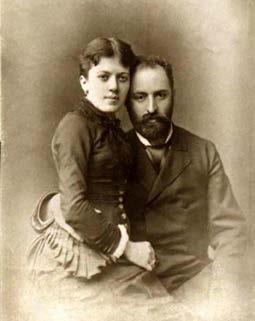
Niko Tskhvedadze and Ekvtime Takaishvili) followed David’s advice and decided to build an exact copy of the Samtavisi Church (1030) instead. This construction was also financed by Sarajishvili.
In 1901, after Ilia’s death, Alexandre Sarajishvili took charge of the Iveria newspaper, which was then experiencing serious financial problems. It was thanks to the contributions made by Prince Konstantine Mukhranski and David Sarajishvili that the newspaper was saved from closing down. David Sarajishvili gave financial assistance to the construction of the People’s Theater in Tbilisi. He contributed large sums of money to the construction of the Avlabari People’s Theater. The successful activities of the Society for the Promotion of Literacy are also associated with David Sarajishvili’s name and so is the work of the Georgian Peasantry Revival Committee, the choirs of Lado Aghniashvili and Ioseb Ratili, as well as the establishment of the Historical and Ethnographic Society and a number of other societies and associations.
When in the summer of 1907 David learned of Ekvtime Takaishvili’s intention to carry out an archaeological expedition in the Akhaltsikhe, Akhalkalaki and Artana districts, he immediately called Ekvtime and gave him money for the expedition.
Philipe Gogichaishvili recollects: “He donated money in such a way as if it belonged to the beneficiaries themselves and had nothing to do with his personality. Modesty, kindness and sincerity characterized his every action. All of us admired and loved him for this...” In Kutaisi
20 ivniss didebuli qarTveli saSineli tanjviT garadaicvala. gardacvalebamde erTi TviT adre daviTs germaniaSi dauCivlia: `vkvdebi, ra damSvidebiT movkvdebodi, rom samSoblos imedi mimyvebodes~. im dReebSi `saxalxo gazeTi~ werda: `amboben, avadmyofi, mZime seniT Sepyrobili, momakvdavi adamiani didi egoisti xdebao. Tvali gadaavleT daviTis ukanasknel sityvebs _ imis anderZs da darwmundebiT, rom am mxrivac es SesaniSnavi adamiani ganirCeoda sxvaTagan, Rirseulis anderZiT daagvirgvina man Tavisi keTili da nayofieri sicocxle da kubos karebis winaSec misi ukanaskneli survili saero, saqveyno Wiris gaziareba iyo. WeSmaritad imazed aris gamoWrili guramiSvilis sityvebi: `mokvda da Tvisis anderZiT, aw isev saqmobs mkvdario~!.. anderZma ki, romelic meuRlisagan farulad, 1910 wels, berlinisken mimavalma, rostovSi gaaforma, sazogadoeba gaaogna: piradi qonebis udidesi nawili, uZravi da moZravi qoneba saqarTvelos dautova! iakob gogebaSvili daviTis gardacvalebis Semdeg werda: `me amJamad ar ZalmiZs aRvnusxo arc didi amagi gansvenebulisa da arc misi umagaliTo qvelmoqmedeba. aRvniSnav mxolod, rom gansvenebuls mamisgan darCa mciredi Tanxa, da man es Tanxa Tavisi codniT da mxneobiT milionebad gadaaqcia... da bolos, mTeli Tavisi didi qoneba, SeZenili patiosani gziT da umwikvlo moqmedebiT, man dautova qveyanasa~. 1916 wlis agvistoSi, meuRlis gardacvalebis Semdeg, axalgazrda, magram janmrTeloba Seryeuli ekaterine foraqiSvili-sarajiSvilisa gardaicvala. `nu damkrZalavT didebulad, ar vsaWiroeb arc gvirgvinT, arc did Zegls, bevri ar damaxarjoT da qoneba Cemsa ersa gauboZeT~. igi Tanamecxedres gverdiT, didubis panTeonSi dakrZales.
P. S. 1939 wels, saqarTvelos ssr-s xelmZRvanelobis miTiTebiT, qalaqis sabWos mier gacemul dokumentSi, romlis adresatebi daviTisa da ekaterines naTesavebi iyvnen, ewera: `panTeonisaTvis gamoyofil nakveTze unda dakrZaluli iqnan is pirni, romelTa moRvaweobac literaturis, mecnierebis da xelovnebis dargSia cnobili. d. sarajiSvili da misi meuRle ki, radganac ar ekuTvnian aRniSnul kategorias, panTeonis nakveTze datovebulTa siaSi ar arian. amitom, gevalebaT d. sarajiSvilisa da misi meuRlis neSti gadaitanoT sxva sasaflaoze 10 dRis vadaSi. panTeonis direqtori v. enikolofaSvili~.
1939 wlis 1 dekembers daviT da ekaterine sarajiSvilebis neStebi vakis sasaflaoze gadaasvenes. 1995 wlis 24 ivniss sarajiSvilis mowafeebisa da misi Rvawlis TayvanismcemelTa mcdelobiT daviT da ekaterine sarajiSvilebis neStebi vakis sasaflaodan gadmoasvenes da qaSveTis taZris ezoSi dakrZales.
a young man was introduced to Sarajishvili. David was offered to taste the lemonade he was producing. He liked the drink very much and asked the young man why he was not expanding the enterprise. The young man explained that he was unable to do so due to lack of money and asked for Sarajishvili’s help. David agreed without hesitation. The man was Mitrophane Laghidze.
In 1910, David became ill with an incurable disease. He underwent surgery in Berlin but the operation did not relieve his condition and on June 20, 1911, the great Georgian passed away. In Germany, a month before his death, David complained: “I am dying. How peacefully I would die if I had a hope for my country’s better future.”
The Sakhalkho Gazeti newspaper wrote: “It is believed that a sick man, dying from an incurable disease, becomes selfish. Think of David’s last words, or his testament, and you will immediately understand that in this respect too, this extraordinary man was different from others. He crowned his outstanding life and deeds with a worthy will. His last wish was to share the common hardships and the sufferings of his homeland. David Guramishvili’s words “He died, but by his will he still continues to accomplish good deeds!” are truly about him.”
The Will, which he wrote in 1910 in Rostov on his way to Berlin, left everyone overwhelmed: he left the lion’s share of his fortune and properties to Georgia!
After David’s death, Iakob Gogebashvili wrote: “I cannot relate fully his immense contributions or unmatched charity. I shall only note that he inherited a modest sum from his father, which he turned into millions through his knowledge and skill... And finally, he left all his fortune gained through honest enterprise and irreproachable actions to his country.”
In August 1916, still young but with her health shaken after her husband’s death, Ekaterine Porakishvili-Sarajishvili also passed away. “I don’t want to be buried in pomp. I need neither a crown nor a monument. Don’t spend money on me and give all my property to my nation,” she said. She was buried in the Didube Pantheon next to her husband.
P. S. In 1939, on instructions from the authorities of the Georgian Soviet Socialist Republic, the city council issued a document addressed to David and Ekaterine’s relatives which said: “Only persons who have worked in the sphere of literature, science and art may be buried in the Pantheon. Since D. Sarajishvili and his spouse do not belong to the indicated category, they have not been included in the list of persons to be buried here. Therefore, you are required to transfer the remains of D. Sarajishvili and his spouse to another cemetery within a period of 10 days. V. Enikolopashvili, Director of the Pantheon.”
On the 1st of December 1939, the remains of David and Ekaterine Sarajishvili were transferred to the Vake cemetery.
On the 24th of June 1995, thanks to the efforts of Sarajishvili’s pupils and his grateful countrymen, the remains of David and Ekaterine Sarajishvili were reinterred in the graveyard of the Kashveti Church.
kultura.


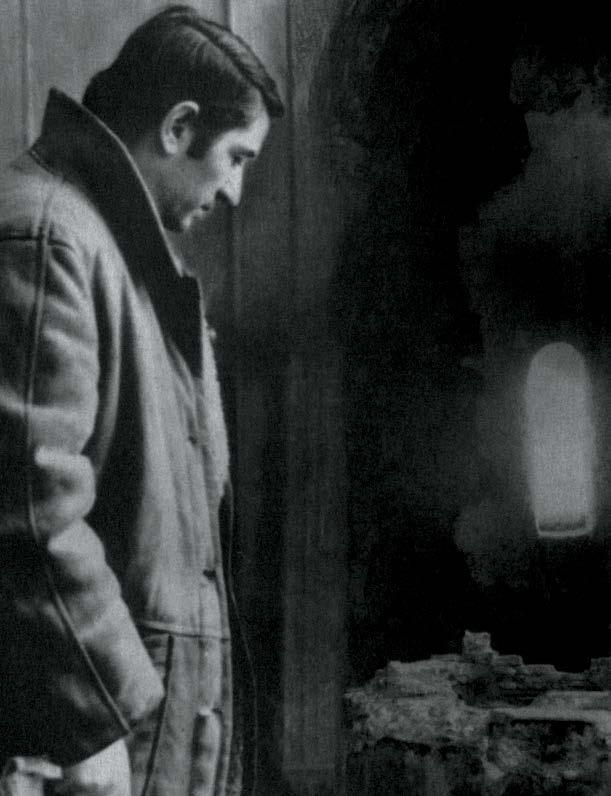
Znelia, Zalian Zneli ganmarto, ra ari kultura. TiTqmis SeuZlebeli. mgonia, sicocxlea kultura.
kulturiT fSvens yoveli arsi, yofiereba. da viT ZalmiZs ganvmarto kultura, roca ar vici, viT ganvmarto sicocxle. Tumc vici _ kultura, viT sicocxle, mudmiv ganaxlebadia, viTarca miTiuri amirani.
kulturis gamonaSuqia axal epoqebSi amiran-promeTes CiraRdani. da es CiraRdani maradiulia, arasdros qreba, JamiTi Jamad efareba Tvals.
iqneb, qmnaa kultura?!
kultura RmerTs ar Seuqmnia, adamiani Seqmna. da uboZa azri. kultura adamians unda Seeqmna. azria kulturis deda. amis mowmea kacobriuli cxovrebis aRmarTebi da daRmarTebi.
codvisdacemis Semdeg samoTxidan gamoZevebulni vcdilobT raRac imgvari vqmnaT, riTac gamovisyidiT codvas da kvlav vixilavT dakargul samoTxes. daviwyebuli araferia. dakargulis dasabruneblad viRvwiT. samoTxidan eqsoriaqmnilTa modgma qmnis kulturas.
iqneb, sinanulia kultura?! msaxurebaa?! amis SesaZlebloba erTxel kidev mogvca ufalma golgoTis misteriiT. saSveli ari! _ unda davuaxlovdeT pirvelqmnilebas. Tumc amaod _ mcdeloba mcdelobad rCeba. amaSi Zevs is dafaruli azri sinanulisa, is saniadago saidumlo Rvwisa, rac kulturis Seqmnis safuZvelTa safuZvelia. arcerT epoqaSi, arcerT erSi saRmrTo Tanalmobis, msaxurebis gareSe kultura ar Seqmnila. gulisxmavyoT Cveni xalxuri simRerebi
Tu sagaloblebi, rodisrodindeli, gulisxmavyoT avTandilis anderZi, erT-erTi zeuniversaluri teqsti msoflio literaturisa, da amaSi Tavadve davrwmundebiT.
iqneb, rwmenaa kultura?! mowameobaa?! mowameobaSi, riTac gvwadia rwmeniT miveaxloT dakargul samoTxes, monawileobs yoveli eri, mTeli kacobrioba. monawileobs qarTveli eric, rogorc civilizebuli samyaros ganuyofeli nawili. qarTvelTa winareqristianuli kultura gvaZlevs amis Tqmis uflebas. swored amitom warmogzavnes qristes Semdgom, 30-ian, 40-ian wlebSi, saqarTveloSi sjulis saqadageblad andria pirvelwodebuli, rom qarTvelTa eri, rogorc Zveli unikaluri kulturis eri, ukve mzad iyo qristianobis misaRebad. qristianobiT axali era daiwyo am qveynis kulturul-humanistur cxovrebaSi. qristianulma sarwmunoebam gaxada SesaZlebeli darRveuliyo aRmarTuli jebirebi, ziarebodnen erebi erTmaneTis kulturebs. swored qristianobis kulturul-humanisturi cnobierebis nayofia, rom qarTvel kacs arasodes Seulaxavs sxvaTa religiuri mrwamsi, arc eTnikurad mcireni daumcirebia odesme, romlebic odiTgan saxloben saqarTveloSi. amis magaliTi, daviT aRmaSenebelia _ `mesiis maxvili~, aRmosavleTSi mTeli saqristianos saso da imedi. misi himnografiuli Txzuleba `galobani sinanulisani~ im mefe-politikosis, im mefe-mxedarTmTavris, im mefe-poetis aRsarebaa, visi gulic qristianuli SemwynareblobiTa da siyvaruliT gaciskrovnebula.
iqneb, enaa kultura?!
saRmrTo siyvarulis gacxadebaa?! Tu ena eris kulturis uzenaesi gacxadebaa, rusTvelma qarTuli enis harmoniul sinTezSi diadhyo Tavisi
Culture.
I t’s very, very difficult to find a clue to the meaning of culture. It’s an almost impossibly difficult task. Perhaps, culture is life.
Culture enters and permeates every creature, every being, existence. And how can I puzzle out the meaning of culture if even the meaning of life is lost on me? Somehow, though, I know that culture is capable of revival – like life, like the mythical Amiran. The torch of Amiran/Prometheus continues to beam down the centuries through culture. The glow of this torch is eternal. It can never be extinguished and only fades from sight sometimes.
Can culture be created?
Only not by God. God created man and gave him knowledge. Culture was meant to be man’s creation.
Knowledge gives birth to culture.
The history of Mankind can attest to this.
Being cast out of Heaven due to the fall of man, we have since then been pursuing the dream to create something that would free us from the guilt and let us find our way back to where we belong. Nothing is forgotten. And we are now at pains to gain back what has been lost. Culture owes itself to exiles from Heaven.
What is culture? Maybe repentance?
Or the ability to serve?
An ability which God bestowed on us through the mystery of Golgotha.
The solution is known! We need to rediscover our original self. All attempts are, however, futile. And herein lies the latent meaning of repentance and tireless efforts which form the groundwork for culture. No culture was ever created without godly sympathy or godly devotion. The best insight of what it means comes from our folk songs and hymns deriving their origin from time immemorial; from Avtandil’s Testament raising one of the universal themes of world literature.
What if culture is faith?!
Or martyrdom?
Martyrdom as a quest for the lost paradise, which involves every nation, all Mankind including Georgian people – an integral part of the civilized world. Pre-Christian culture in Georgia allows us to say that it is the reason Andrew the First-Called was sent to Georgia in the years 30-40 AD to preach Christianity, because the Georgian people, an ancient nation with a unique culture, was ready to receive the religion. With Christianity, a new cultural and humanistic era started in the country. Christian faith made it possible to take down barriers and have nations get to know each other’s cultures. It is the result of Christian cultural and humanistic consciousness that Georgian men have never demeaned other religious beliefs, or persecuted ethnic minorities that have lived in Georgia since ancient times. David Aghmashenebeli, “the Sword of the Messiah”, is a good example, he was the hope of all of Christianity in the
genialuri qmnileba, am eniT mohfina kacobriobas siyvarulis Zalmosileba.
iqneb, sadRac gaRwevaa kultura?! miwieri amaoebidan Tavis xsnaa?! baraTaSvilis mernis grigalisebri qrolva gviadvilebs am gzaze savals. da axla Cven, misni Semdgomni, vadgavarT am gzas, misganve Telils, da tvirTmZimeni, ar vkargavT imeds _ gavaRwevT gasaRwevelSi. xolo ganuwyvetliv Cagvesmis yurSi sinanulis tragikuli notebi misi sulieri papisa _ guramiSvilisa, da erTxel kidev Segvacnobinebs nostalgias dakargul samoTxeze, daviwyebul samSobloze.
iqneb, Suamavlobaa kultura?! Suamavloba kacisa RmerTTan?! daviwyebul samSoblosTan?! mZimea sawuTro kacisa, vinc itvirTa es Suamavloba. ilia WavWavaZis mesianurma gonebam, viTarca gonebam winaswarmetyvel mosesi, kulturis, sityvis, ganmanaTleblobis STaberviT dauxsna qarTvelT cnobierebis karibWeni, apovnina ers dakarguli samSoblo, dausaxa gzani misi xsnisa. Tumc, ra umaduroba unda iyos, rom dResac gaigonebT nihilistur qirqils am RvTisdari kacisadmi. albaT, jer kidev hyvavis CvenSi social-demokratTa, bolSevik-komunistTa, bosxis am maxinj personaJTa, daTesili RvarZli. saRmrTo kverTxi, riTac naxevari saukune win migviZRoda, kvlavac zecisken aRupyravs, Ze SecTomilT gvafrTxilebs _ ar davuzavdeT eSmaks!
iqneb, mociqulobaa kultura?! orTodoqsul samanTa Zlevaa?!
Cveni erovnuli kultura gvmociqulobs sxvaTa kulturebTan. gvmociqulobs Cvensav kulturasTan. ar yofila dro, mis caze saavdro Rrubeli ar mogragniliyos, damangrevel grigalebs ar gadaevlos. da mainc aRmdgara, ganaxlebula. yvela samani uZlevia. ra sulier potencias unda flobdes, Tavisuflebisa da kulturis TviTaRorZinebis ra dauokebel wyurvils, ra mociqulebriv Segnebas, bolSevikur-komunisturi totalitaruli reJimis xanaSi, XX saukunis 60-ian wlebSi, ers rom am wiaRSive ganaxlebis Zala aRmoaCndeba. is sulieri ganaxlebis aucilebloba, kidev erTxel rom Seaxsenebda qarTvel kacs Tavis istoriul misias _ Tavdadebul moRvawebas erovnuli suverenobisa da kulturis gadasarCenad. Tumc am ganaxlebis inspiratori totaluri politikuri ryevebic iyo, Cvens kulturas aRmosavlur, gansakuTrebiT, dasavlur kulturasTan rom aaxlovebda (ufro sworad, aRadgenda am kulturasTan
East. His hagiographical work ‘Hymns of Repentance’ sees the confessions of the politician king, the general king, the poet king whose heart was enlightened with Christian tolerance and love.
What if culture is language?
What if it is the declaration of the love of God?
If language is the supreme declaration of the culture of a nation, then Rustaveli has elevated his genius work in the harmonious synthesis of Georgian language and spread the power of love throughout humanity using this language.
What it culture is to get away?
To deliver oneself from material futility?
The stormy flight of Baratashvili’s Pegasus makes it easier for us to advance down this road. And now we, his successors, are on this road, paved by him, and despite our heavy burden, we do not lose hope – we will make it to the end. All the while, the tragic notes of regret of his spiritual father – Guramishvili – are constantly in our ears and once again it makes us feel nostalgic for the lost paradise, the forgotten motherland.
What if culture is mediation?
Mediation of man with God?
With the forgotten motherland?
Heavy is the existence of the man who took this mediation upon himself.
The messianic mind of Ilia Chavchavadze, like the mind of the prophet Moses, opened the gates of consciousness to Georgians through culture, through words, through education, and he allowed the nation to find its lost motherland, showing the way to its deliverance. Although, however ungrateful it may seem, to this day we sometimes hear nihilistic mockery of this holy man. It must be that some of the spite sowed by Social-Democrats, BolshevikCommunists, these ugly Bosch characters, still remains. The royal scepter with which he led us for half a century is still held high and he warns those of us who are lost – never make a deal with the devil!
What if culture is to be an advocate?
To vanquish the conventional boundaries?
Our national culture is our advocate to other cultures. It is our advocate for our own culture. There has been no time when there was no dark cloud forming in its sky and no annihilating storms passing over it. And still, it has come back to life, renewed. All boundaries are indomitable.
What spiritual potency a nation should possess, what unquenchable thirst for freedom and culture, what understanding of advocacy, to have the strength to renew itself in the era of the Bolshevik-Communist totalitarian regime, in the 1960s. That need for spiritual renewal, which once again reminded Georgian men of their historic mission – to give their all to save national sovereignty and culture. Although this renewal was also inspired by total political fluctuations, which made
Zvel kavSirs), fesvebi mainc winaredrois klasikur wiaRSive _ XIX saukunis 60-ian wlebSi gaedga, iqidan iRebda maorganizebel impulsebs. es iyo procesi rTuli, mZime, konvulsiuric ki, rogorc dedisa, romelmac axali sicocxle unda Svas. gavixsenoT imJamindeli qarTuli kino, Teatri, mwerloba, mxatvroba, musika, mecniereba, arqiteqtura da amaSi Tavadve davrwmundebiT. Tumc sastik reJims ar eZina, iolad arafers Tmobda, Jamgasuli ideologia abrkolebda humanisturi azris aRorZinebas.
iqneb, providenciaa kultura?! bedisweraa?! raRac gangebulebiT, bediT Tu bedisweriT, am procesebSi miwevs arcTu martivi nabijebis gadadgma. terenti graneli. es saxeli bevrisTvis maSin, 60-ian wlebSi, ucnobi iyo, bevrs afrTxobda kidec. karga xnis daviwyebuli, swored am orbitze Semodis xelmeored, poeti, vinc myarad gansazRvruli msoflmxedvelobiT, jer kidev 20-ian wlebSive, konfliqtSi aRmoCnda bolSevikur ideologiasTan. misi pirovnul-poeturi krizisi qveyanaSi kulturis, religiis, humanizmis, yovelive sakraluris dekadanss ukavSirdeba. amis miRma darCenili poetisTvis, rogorc sulier emigraciaSi gadaxvewili RvTis maZiebeli euli piligrimisTvis, vinc ar indoma monawileoba mieRo am epoqalur degradaciaSi, xorcieli daRupva garduvali iyo. sagulisxmoa, rom misi gardacvalebidan gaivlis meoTxedi saukune da gaqrobis pirze misul poetis saflavs petre-pavles eklesiis winamZRvari mama Sio (TurqaZe) ixsnis daRupvisagan (1966 wels manve mimagnebina ekalbardebSi mimalul poetis saflavs)... da wlebis Semdeg xelmeored ubrundeba mSobliur mwerlobas da Tavis umrwemess TanamokalmeTa gverdiT, iwyebs axal sicocxles. da me, am qarcecxlian orbitaze moxvedrili, wlobiT vdgavar redaqcia-gamomcemlobebis karTan misive awewil-dawewili cxovrebiT, dro-JamiT gayviTlebuli xelnawerebiT xelSi... da vwer `kviris wirvebs~ _ biografiul romans am mowame poetze.
iqneb, uxsovrobis nostalgiaa kultura?! daviwyebulis reinkarnaciaa?! vagnerisa da berliozis musika, rac unda paradoqsi iyos, semantikis aRuricxvel velze damaxetialebda, Zveli qarTuli ezoTeruli teqstebidan `dao de Zinisa” da upaniSadebis yofierebis gadmosaqarTulebel cnebebsa da sityvebs mkarnaxobda. albaT, ar moiZebneba civilizebuli eri, es sakacobrio Txzulebani Tavis enaze ar eTargmnos. Rrmad rom uwyoda maTi mniSvneloba herman hesem, swored amitom miuCina mis mier Sedgenil msoflio idealur biblioTekaSi `dao de Zins” mexuTe, xolo upaniSidebs meore adgili (bibliis Semdeg). da Tu Cven kulturul
our culture closer to oriental, and, especially, occidental culture (or more precisely, restoring the old connections with this culture), its roots were still mostly grown in the classical period – the 1960s, and that’s where it received its marginalized impulses from. This process was difficult, painful, convulsive even, like that of a mother creating a new life. Let us remember Georgian cinema, theater, literature, art, music, science, architecture etc. of that time and we will be convinced of that. But the cruel regime did not sleep, did not give anything up easily; the outdated ideology creating obstacles to the renaissance of the humanistic thought.
What if culture is providence?
Destiny?
It is some fate, destiny or fortune that makes me take uneasy steps in these processes.
Terenti Graneli.
This name was unknown to many back then in the 60s, and was even scary to many others. Long forgotten, the poet returns to this orbit, a poet who, because of his strictly defined views, came into conflict with the Bolshevik ideology in the 1920s. His personal-poetic crisis has much to do with the decadence of everything sacred in the country - culture, religion, humanism. For the poet left without all that, like a lone pilgrim searching for God in a spiritual emigration, material demise was unavoidable. A quarter century after his death, the poet’s grave was on the verge of disappearing when it was saved by the priest of the Peter and Paul Church, Father Shio (Turkadze), from destruction (he was the one who helped me find the poet’s grave, hidden in the bush wood, in 1966)... and years later, he comes back to his beloved literature and begins a new life beside his younger fellow writers. And I, also happening to be on this fiery orbit, spent years standing at the doorstep of publishing houses, leading the same messy life as his, manuscripts yellowed from the “Sunday masses,” times in hand…
What if culture is the nostalgia of the immemorial?
The reincarnation of the forgotten?
However paradoxical it may seem, the music of Wagner and Berlioz made me wander in the infinite field of semantics, giving me clues to translate terms and words from the Tao Te Ching and the teachings of the Upanishads with old Georgian esoteric texts. There is probably no civilized nation that has not translated these works into its own language. Herman Hesse knew their meaning deeply, and this is why, in the ideal world library he created, he gave Tao Te Ching fifth place and the Upanishads second place (after the Bible). And if we want to be part of the family of cultured nations, it is impossible without being able to access the godly wisdom of these books in our native language.
What if culture is a messenger?
The revealer of the concealed?
The revealing of the hidden that we cannot see and that has been sealed seven times. A man will come, he will appear, remove the
erTa ojaxSi gvegulvis Tavi, SeuZlebelia mSobliur enaze ar vimecnebdeT am wignTa RvTaebriv sibrZnes.
iqneb, macnea kultura?!
dafarulis gamocxadebaa?! imis gamocxadebaa, rac dafarulia da ver vxedavT, Svidgzis beWdiT dabeWduls. mova kaci, gamogvecxadeba, axsnis beWdebs, gamogvicxadebs don kixotis, dimitri karamazovs, aluda qeTelaurs. gamogvicxadebs da sawuTrosa da sulTa feriscvalebis am idumal misteriaSi, Cvenc gvamonawilevebs.
mZimea am kacTa xvedri.
mZime iyo sawuTro servantesisa, dostoevskisa, vaJafSavelasi _ miwieri jojoxeTidan tanjviT amohqondaT zecieri samoTxe. da Tu vinme stiroda, pirvelni, zecieris madliT gaciskrovnebulni, albaT, Tavadve stirodnen TavianTi gmirebis xvedrze. ise wavida nikolo paganini wuTisoflidan, sakuTar samSobloSive eqsoriaqmnili, Tvalze cremli ar SeSrobia. am cremlidan gvicxadebda saswaulebs. ise wavida niko firosmanaSvili wuTisoflidan, sakuTar samSobloSive eqsoriaqmnili, Tvalze cremli ar SeSrobia. am cremlidan gvicxadebda sakvirvelebas. gamogvecxada, gaiara miwieri sawamebeli, gviboZa zecieri samoTxe, wavida, aRdga, aq yofnis yvela kvali waSala, saflavic ki _ viTom ar yofila. erTi natvra dagvitova _ mxatvrebma avagoT patara saxli, davdgaT samovari, vsvaT Cai da xelovnebaze vilaparakoTo. es uwyinari natvrac ver avusruleT. maxsendeba Cemi megobris, mxatvar gogi wereTlis sevdiani monaTxrobi: _ amsterdamSi var, van gogis samsarTulian muzeumSi, sixaruliT var savse _ didi mxatvris tiloebs originalSi vaTvaliereb da uneburad samSoblo maxsendeba, Tbilisi, niko firosmanaSvili, Tvalze cremli madgeba _ iseTi ra dagvemarTa qarTvelebs, rom am genialuri mxatvrisTvis sicocxleSi kibisqveSa sardafis meti veraferi gavimeteT, mokvda da, ager asi welia, dRemde erTi sakadrisi muzeumi ver avuSeneTo.
iqneb, uxilavi kavSiria kultura?! inspiraciaa?!
wlobiT Sevyurebdi `daTvi mTvarian Rames”, am mistiur sakvirvelebas, Cems naxevradmrume oTaxSi, mirza Safis quCaze, meidanSi, vwerdi romans `eliazaris dabrunebas~ da bedkruli eliazaris mTavar prototipze niko firosmanaSvilis (da ara mxolod mis) egzistencialur sawuTroebaze vfiqrobdi. magram es erTi, gare Srea romanisa. eliazari, miTiuri amiranis mxatvruli reinkarnacia, Tumc xelovania, misTvis xelovneba, anu saRmrTo saSromeli, rogorc amiranisTvis _ cecxlismfrqveveli laxti, TviTmizani ki ara, gzaa
seals and uncover Don Quixote, Dimitri Karamazov, Aluda Ketelauri for us. He will proclaim them and make us participants in this enigmatic mystery of the transfiguration of life and souls.
The fate of these men is a very hard one.
They were hard, the lives of Cervantes, Dostoyevsky, VazhaPshavela – they brought up heavenly paradise from material hell, and it was torture for them. And if anyone cried, enlightened by the mercy of the heavenly, they were probably the first ones, crying over the fate of their own heroes.
Niccolo Paganini left this life exiled from his own country, tears never ceasing to run down his face. He granted us miracles from these tears.
Niko Pirosmanashvili left this life exiled from his own country, tears never ceasing to run down his face. He granted us wonders from these tears. He came to us, went through the torture of life, gave us heavenly paradise, left, came back to life, erased all traces of his time here, even his grave – as if he had never existed. He left only one wish – for the painters to build a small house, put a samovar there, drink tea and talk about art. Even this small wish we could not make come true. I remember the sad tale of my friend, painter Gogi Tsereteli:
– I am in Amsterdam, in the three-story museum of Van Gogh, full of joy, admiring the original paintings of the great artist, and suddenly I remember my country, Tbilisi, Niko Pirosmanashvili, and tears come to my eyes – what is so wrong with us Georgians that we could not give anything more than a cellar under some stairs to our genius, then he died and a hundred years later, he still does not have a proper museum.
What if culture is an invisible connection?
Inspiration?
For years, I looked at “A Bear in the Moonlight”, this mystical marvel, in my half-darkened room, on Mirza Shapi Street, Meidani, writing the novel “The Return of Eliazari”, and thinking about the existential struggle of miserable Eliazari’s main prototype, Niko Pirosmanashvili (and not just him). But this is one of the external layers of the novel. For Eliazari, being the creative reincarnation of the mythical Amiran, though he is an artist, for him art, the holy work, like for Amiran – the fiery whip, is not a goal in itself, but a way to vanquish evil forces, to come back to the genetic civilization of the first man...
What if culture is a dream?
A fairy tale?
In dreams, as in fairy tales, everything is possible: we do not know who we are, where we are, whether we are or not. It’s as though we are there, but we are not. We are this and we are that. We remember and we cannot remember.
Sometimes remembering astonishes us.
This kind of astonishment is what we experienced in the 1990s, when we woke up independent, free. We dove in at one place and came back up in another. We were waiting for something else, believing in something else, and we got something different.
boroteul ZalTa saZlevad, pirvelkacSi _ genetikur civilizaciaSi dasabruneblad...
iqneb, sizmaria kultura?! zRaparia?!
sizmarSi, rogorc zRaparSi, yvelaferi SesaZlebelia: ar viciT vin varT, sad varT. varT, ar varT. viTom varT, viTom ar varT. xan vin varT, xan vin. vixsenebT, ver vixsenebT.
zogjer gvaognebs gaxseneba. amgvarma gaognebam mogvicva wina saukunis 90-ian wlebSi, roca gamoviRviZeT damoukideblobaSi, TavisuflebaSi. sxvagan CavyvinTeT, sxvagan amovyvinTeT. sxvas velodiT, rwmeniT velodiT, sxva miviReT. viTom _ damoukidebloba. viTom _ Tavisufleba.
viTom _ iqca Cveni cxovrebis sizmareul kredod. Cvens cnobierebas politika ise SemoWdobia, rogorc etlis borbals _ salte, saZraobas ar gvaZlevs. viTom gvRviZavs wafilosofoso ybedobaSi, sinamdvileSi wajequkujeqobaSi vTvlemT, erT wreze davlaRandarobT. politikurad egzaltirebuli qveyana amgvar ybedobaSi ise mofarebia kulturas, rogorc Ruzasaglejili gemi _ nislian navsadgurs. yoveli mxridan sastiki qari gviberavs. pandoras yuTs Tavi aqvs axdili. Tvalze xelebafarebulebi, did facafucSi varT (facafucma icis sindisis, RirebulebaTa devalvacia, facafuciT qmnili kultura vis unaxavs?!). gulisxmayaviT, ra saocrad hgavs genialuri ieronimus bosxis `Tivis gadazidva~ da `yeyeCTa xomaldi~, es universaluri qmnilebani, Cvens dRevandel yofierebas. amgvari cnobierebiT cxovreba, roca Sens caze damokles maxvili hkidia, ar mgonia, Rirseuli iyos (Rirsebaayril kacs ra xeli aqvs kulturasTan!). roca erTi mxriT _ Sovinistur-dampyrobluri manqana gvitevs, xolo meore mxriT _ nihilisturi manqana, takimasxaroba mgonia liberalizmis mantiaSi SefuTuli konformizmi, romlis saSoc _ SiSia. gavixsenoT nestandarejani _ qajeTis cixeSi datyvevebulsac saxelmwifoze fiqri ar miutovebia. am evropelobiT xom pirdapir agvikles. Caxedon matianes _ neta rodis ar iyo qarTveli evropeli. Tu evropuli kultura qristianobis wiaRSi iSva, Tu qristianobaa evropuli kulturis deda, maSin ganswavlulma evropelma gadafurclos Zveli foliantebi da naxavs, jer kidev romel saukuneebSi uSenebia qarTvels qristianuli eklesia-monastrebi. im axali epoqebis evropul kulturaze ratom sduman, im sakacobrio mniSvnelobis literaturaze, xelovnebaze, mecnierebaze, rasTanac ZvelTaganve arasodes gauwyvetia kavSiri qarTvel kacs. am orientaciiTa da cnobierebiT iyo nakarnaxevi erekle meores politikuri Ziebani evropaSi. vidre is,
A pretend independence.
A pretend freedom.
Pretend became the dream credo of our lives.
Politics are wrapped around our consciousness like the hoop around the wheel of a carriage, not allowing us to move. It’s as if we are awake in the pretend philosophical banter, and in reality we are sitting around snoozing, turning in circles. Our country, politically exalted, has been dragged away from culture in this banter, like a ship that has broken away from its anchor and has been dragged away from the foggy harbor. A cruel wind blows from every side. Pandora’s box has been opened. With our hands covering our eyes, we are bustling around (bustling is what brings devaluation of the conscience and values – who has ever heard of a culture created while bustling?). Take into consideration how amazingly the universal works “Hay Wagon” and “Ship of Fools” by the genius Hieronymus Bosch resemble our current condition. To live with this consciousness, that the sword of Damocles is hanging in your sky, cannot be honorable, in my opinion (and dishonorable men have nothing in common with culture!). When a chauvinist-conquering tank is attacking from one side and a nihilist from the other side, for me conformism hiding behind a mask of liberalism is nothing but buffoonery, at the heart of which is fear. Let us remember NestanDarejan, who never stopped thinking about the State, even while a prisoner in the Kajeti fortress.

georgievskSi, 1783 wels ruseTTan iZulebiT traqtats gaaformebda, musulmanuri samyaros ganuwyveteli Tavdasxmebisgan rom exsna Tavisi qristianuli samefo, manam evropasa da evropel monarqebTan eZebda mokavSires. Tumc amaod. amaod daSvra evropis gzebze Cveni didi meigavec, sulxan-saba orbeliani _ eris ganmanaTlebeli, politikuri da sazogado moRvawe.
zRvis motortmane talRebSi RvTis anabara mitovebuli unavsayudlo gemidan damsxvreuli naSTebi rom ar SegvrCes, mTeli siRrmiT unda CavxedoT momxdaris tragizms da, waRma-ukuRma ki ar viborialoT, imaze vizrunoT, gemi mSobliuri kulturis wiaRSi davabrunoT. es, rasakvirvelia, sulac ar gamoricxavs sxva eris kulturebTan Tanamonawileobas. Tu Zveli berZnebi ar Takilobdnen kolxeTsa da iberiaSi mogzaurobas, aq imJamindeli kultura rom eZiaT, Cven ra dagvemarTa?! neta dadgeba dro, roca qarTveli kaci, amerikeli uolt uitmeniviT, SesZaxebs: `o, kapitano, Cemo kapitano! xomaldi moadga napirs, man datova Stormi, zvirTebis mrisxane Sexla da yvelaferi damTavrda, morCa!~
magram vidre amis SeZaxebis dro mova, manam msxverplis gaReba mogviwevs, sul mcire msxverplis _ davicxroT vnebani gulisa, mediduroba, sxvaTa zeda aRmateba, gancxromisaken, warmavali mosaxveWelisken amao ltolva. kulturas Tavisi kanonebi aqvs. kulturis kanonebi ar morCilebs arc politikur, arc socialur, arc saxelmwifoebriv kanonebs. formaciebi icvleba, epoqebi icvleba, kulturis kanonebi ar icvleba. Tumc mudmiv ganaxlebadia, misi arsi ucvleli rCeba _ ar dainTqas drois azavTebul mdinarebaSi. geniosebi imitom ki ar swavloben kanonebs, rom daicvan isini, imitom swavloben, rom daarRvion. politikis kanonebs mravalni morCileben, kulturis kanonebs _ mcireni. mcireTa Seupovari muSakobiT ari kultura. misi gamaJamgrZelebelnic mcireni arian. misi mcvelnic. xelisufalT unda uwyodnen, rom umetesni am mcireTagan imitom ki ar iyvnen duxWirni da upovarni, rom Rirseba ar hqondaT, imitom iyvnen duxWirni da upovarni, rom RirsebiT qmnidnen kulturas, RirsebiT miuZRodnen progresisken kacobriobas.
RvTis wyalobiT, mcireTa mekanoneni, qarTuli kulturis caze obol cTomilebiviT moxetialeni, Rrma individualobiT wilxvdomilni (zogi samSobloSi, zognic ucxoeTSi), am mZime xanaSic agrZeleben im klasikur gzas, rac ZvelTaganve Tavganwiruli moRvawebiT dausaxavT winaprebs. unda viqonioT rwmena, amiranis qveyanas aRmoaCndeba Zala gansacdelSi TviTdaunjebisa da ganaxlebisa.
And they have talked our ears off about being European. If only they looked at history – when were Georgians not European? If European culture was born from the hearth of Christianity, if Christianity is the mother of European culture, then the European scholar should open old folios and see from which centuries Georgians were building Christian churches and monasteries. And why do they say nothing of the European culture of the new eras, the literature, art, science of significance of all of Mankind and with which Georgians have never lost contact. This is the orientation and consciousness that moved Erekle the Second during his political research in Europe. Before he signed a forced contract with Russia in Georgievsky in 1783, in order to save his Christian kingdom from unceasing attacks from the Muslim world, he searched for an ally in Europe, asked European monarchs, but in vain. Our great fabulist Sulkhan-Saba Orbeliani – enlightener of the nation, political and public figure – also walked the roads of Europe in vain.
In order to not be left with broken pieces of a ship wrecked because it was left on its own, without a harbor, in the swelling waves of the sea, we need to observe the tragedy of what happened in all its depth and instead of wandering back and forth, we have to make sure the ship goes back into the culture of its nation. Of course, this does not exclude common involvement with other cultures. If ancient Greeks traveled to Kolkheti and Iberia to get to know the culture there, why wouldn’t we?!
Will the time ever come when a Georgian, like the American Walt Whitman, will exclaim:
O Captain! My Captain!
Our fearful trip is done,
The ship has weather’d every rack,
The prize we sought is won.
But before this can be achieved, we will need to make a sacrifice, albeit a small one – we will have to make still the passions of the heart, the haughtiness, the excessive pride, the vain aspirations for comfort, luxury, the fleeting riches. Culture has its laws. Culture does not abide by political, social or state laws. Formations change, eras change, the laws of culture do not change. Although it is constantly renewed, its essence remains the same – not to disappear in the strong current of time. Geniuses study laws not to abide by them, but to be able to break them. Many observe the laws of politics, but few – those of culture. It is by the obstinate work of the few that culture exists. Few are the ones who pass it on and few are the ones who protect it. The rulers need to know that most of these few were not poor and destitute because they were dishonorable; on the contrary, their poverty was caused by the fact that they were creating culture with honor, and leading humanity toward progress honorably.
By God’s mercy, the few makers of culture, like lone sinner wanderers of the sky of Georgian culture, the ones gifted with deep individuality (some in their motherland, some abroad), still keep on walking in these hard times the classical road paved by their ancestors with selfless work. We need to believe that the country of Amiran will have enough strength to guard and renew itself in challenging times.
jer kidev Tavmouyrel, sabolood gaurandav da daulagebel sityvebs, Cems win dazvinul Zvel Canawerebs, Cems warmodgenaSi Tvaladuri leqsikoni hqvia... vici, am did xvavs, didi xnis nagrovebs, ase erTbaSad da mTlianad ver mouvli... jerjerobiT mxolod ganzraxuli `Tvaladuri leqsikonis~ WaSniksa vwer. mas Semdeg vwer, rac davrwmundi. rom sityvebsa da gamoTqmebs mxolod CemTvis ar vagrovebdi. erTi sityviT, gadavwyvite Cemi ojaxis, karis mezoblebisa da gare mezoblebis ena saaSkaraoze gamometana. magram, rogorc vTqvi, es mxolod WaSnikia. mTliani `Tvaladuri leqsikonis~ damTavreba da gamoqveyneba isev momavlis saqmed meCveneba.
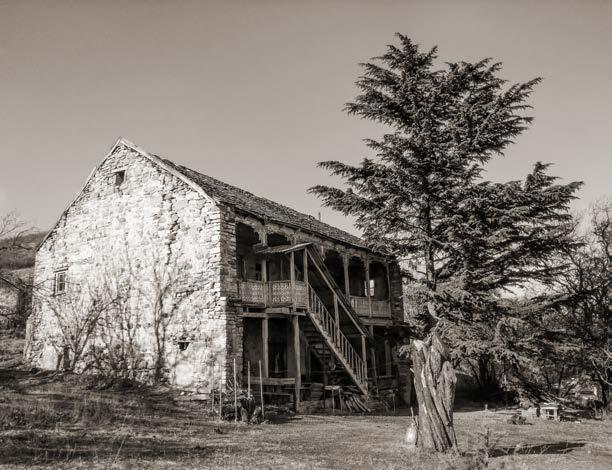

odesme sofel kavTisxevSi Tu moxvdebiT da Tan mis, silamaziT ganTqmul, uban TvaladSi amohyofT Tavs, nu daizarebT da SatberaSvilebis Zvel saxlsac SeavleT Tvali. winarexisken mimavalni, gudaluras xids rom gascdebiT, soflis Saragzidan marjvniv, jer SatberaSvilebis karis eklesias _ wminda nikolaozis saydars mohkravT Tvals da mere ZvelisZvel orsarTulian saxlsac SeamCnevT. taZars gars soflis sasaflao artyia, sadac bevri Zveli, xavsmodebuli saflavis qva dagxvdebaT. albaT, am qvebze, jiuti da CaZiebuli kaci, soflis istoriis wakiTxvasac SeZlebs. saydris gverdze aswlovan muxas ise Zlierad gaudgams fesvebi, rom dro dRemde verafers aklebs. cota moSorebiT mgdomi saxli ki drois dinebas umowyalod gauwiravs _ Robe-yore moungrevia, kedlebs datakebia da sadacaa daZlevs... magram is mainc amayad dags, jer kidev ar icvlis `fers~. pirvel sarTulze samzareulo da marania. meoreze ki or did oTaxTan erTad, didebuli aivani, romelic TeTri kirqvis mTas _ kataulas _ gahyurebs. Turme, roca es saxli Sendeboda, swored iqidan mohqondaT kiri da saSen masalad iyenebdnen.
XIX saukunis damdegs, sadad aSenebul aznauris am saxls, ubralo aRar eTqmis: rogorc giTxariT, drom is karga gvarianad Selaxa, magram amasTan erTad, erTi mniSvnelovani ramec mohmadla _ is, Tavisdauneburad, saqarTvelos istoriis mcire nawilad iqca...
SatberaSvilebis saxlis kedlebs, ornamentebiT morTul aivans, maranSi Camarxul qvevrebs, Tu Wermisferi kramitis qveS Camalul sxvens, dRes mravali ambis moyola SeuZliaT...
Tvaladeli SatberaSvilebi, qvaTaxevis monastris aznaurebi iyvnen. qvaTaxevi erT-erTi ukanaskneli mwignobruli centri iyo qarTlSi. aq moRvaweobda, pirveli qarTveli enciklopedistis, „kalmasobis“ avtoris, ioane batoniSvilis maswavlebeli, iona xelaSvili. monasterTan axlos mdebareobda SateberaanT koSkic, romelic dRes aRar dgas. gvaris Camomavalni mudam CarTulni iyvenen, droebis politikur oromtrialSi da... roca amas saWiroeba moiTxovda, arc xelis xmalze gakvraze ambobdnen uars. am saxlis erT-erTi pirveli binadarnic imdroindel movlenebs Seewirnen; sami Zma _ ivane, filipe da mRvdeli zebede aleqsandre batoniSvilis mxardamWerebi iyvnen da 1812 wlis ajanyebaSi iRebdnen monawileobs. aleqsandre orbelianis cnobiT, swored zebedes dauyoliebia Zmebi, rom batoniSvili TrialeTidan kaxeTSi gadaeyvanaT. rusi Cinovnikebis dokumentebis mixedviT ki swored zebedes dauficebia qarTlis glexoba, wyali da sakvebi ar miewodebinaT rusebisTvis. ivane nafareulTan brZolaSi daRupula, filipe da misi Zma _ mRvdeli zebede ki gadasaxlebulni, katorRis gzaze. rusebi maT rogorc
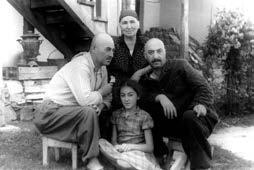
If you ever visit Kavtiskhevi village and find yourself in the ‘Tvaladi’ (handsome) quarter, famed for its beauty, don’t miss out on the old house of the Shatberashvilis. When you cross the Gudalura bridge on the way to Tsinarekhi, on the right side of the village’s main road, you will first see the Shatberashvili family church – the Church of Saint Nicholas, after which you will spot the ancient twofloor house. The surroundings of the church contain the village’s cemetery, where you will find many gravestones covered in moss. A stubborn and curious person might even be able to read the history of the village on these stones. Next to the church, a century-old oak tree is rooted so firmly in the ground that time has taken none of its charm, though the same can sadly not be said of the house standing a little bit further on. The hands of time have ravaged it mercilessly, destroying its fence, attacking its walls, and nearly knocking it down... But it still stands proudly, and has lost none of its character. The first floor consists of a kitchen and a wine cellar. On the second floor, apart from two large rooms, a long balcony offers a view on Kataula, a white limestone hill from which they once brought the materials to build the house.
Built without ostentation by noblemen at the beginning of the 19th century, this house isn’t an ordinary one: as I told you, time has damaged it considerably, but it has also blessed it with an important feature, as this house now plays a humble role in Georgia’s history… The walls of the Shatberashvili house, its ornamented balcony, the wine jars buried in its cellar, and the attic hidden below its apricot tiles, have many stories to tell…
The Shatberashvilis from Tvaladeli were the Counts of the Kvatakhevi Monastery, one of the last centers of erudition in the region of Kartli. There lived Iona Khelashvili, Professor of Ioane Batonishvili, the first Georgian encyclopedist and author of ‘Kalmasoba’. The Shatberashvili family also had a tower near the monastery, but it no longer exists. The family’s descendants were always involved in the political turmoil of their time… and when it was necessary, they were unhesitant to take up arms. Some of the first inhabitants of this house were sacrificed to the unfortunate events of their epoch: three brothers – Ivane, Philipe, and Father Zebede supported Aleksandre Batonishvili in the rebellion of
„наизлейшие
moixseniebdnen. 1812 wlis ajanyebis Semdeg, Tvaladel SatberaSvilebs aznauris tituli CamoerTvaT, Tumca, mis dabrunebas arc ise didi dro dasWirda. XIX saukunis meore naxevarSi da XX saukunis damdegs, maT, dalxenili cxovreba hqondaT, imdenad dalxenilic ki, rom rogorc ojaxuri legenda gviambobs: erTxel romanoz SatberaSvils, didi ivane SatberaSvilis SvilTaSvils, kars germaneli saqmosnebi midgomian da mTa kataulas gayidva SeuTavazebiaT. kiris mTaze, evropelebs karieris mowyoba surdaT da am saqmeSi fulis gadaxda ar enanebodaT. romanozs, romelic qarTluri wesis _ `gzebze sufris gadafenis~ _ didi moyvaruli iyo, „investorebi“ civi uariT gaustumrebia. Tan civi uari, myari argumentiT `dausabuTebia~ _ roca diliT meRviZeba, aivanze gamovdivar da Cems win kataulas xedi iSleba, karg xasiaTze vdgebio. axla, rom gavyido, diliT, rom gamoval da mivxvdebi, rom mTa Cemi aRaraa _ xasiaTi mTeli dRiT SeiZleba wamixdeso. 1812 wlis ajanyeba ar yofila bolo politikuri movlena, romelmac gansakuTrebuli gavlena moaxdina am ojaxis bed-iRbalze. 1910-an wlebSi, rusuli revoluciuri moZraobebis paralelurad, qarTlSi da mTels saqarTveloSi, TareSi daiwyes socialdemokratTa razmebma, romlebic devnidnen Tavadaznaurebs. Tvaladis axlo-maxlo soflebSi maT sastikad mokles ramdenime kaci. kavTisxevSi _ giguca TarxniSvils cocxlad gaaZres tyavi, sofel zemo niCbisSi ki kote ciciSvili sakireSi dawves. am droisTvis, SatberaSvilebi aqtiurad iyvnen Cabmulni soflis, kuTxisa da qveynis cxovrebaSi... maT Soris romanozis vaJi ivane, romelic Tamar gogibedaSvilze iyo daqorwinebuli da misgan oTxi Svili hyavda _ giorgi (momavali mwerali), nato, levani da SoTa.
mezobel soflebSi momxdari mkvlelobebi samwuxarod TvaladSic ganmeorda. ivanes alali biZa, zaqaria bavSvebis Tvalwin mokla Tavisive naTlulma, romelic im dros teroristebis erT-erT razms mitmasneboda; rom ara soflis glexebis vaJkacoba, bandis wevrebi, albaT, SatberaanT bavSvebsac gamoasalmebdnen sicocxles. ai, ras wers, mravali wlis Semdeg, am ambis Sesaxeb giorgi SatberaSvili: „pirveli micvalebuli, romelic kuboSi mwoliare vnaxe, iyo akaki wereTeli. manamdis arc poeti menaxa da arc micvalebuli... maSin me eqvsi wlisa viyavi da Cems ojaxs sikvdili ar enaxa.
mas Semdeg gardacvlili Cemi papebis _ mamaCemis mamis romanozisa da mamaCemis biZis _ zaqarias kuboebic ki ar maxsovs, Tumca maTi sikvdili, gansakuTrebiT zaqarias mkvleloba, Cem Tvalwin moxda da Cemi ojaxis saintereso Tavgadasavlis saTaved iqca.“
SatberaSvilebi saswaulebrivad gadaurCnen sikvdils
1812. According to Aleksandre Orbeliani, it is Father Zebede who enrolled his brothers to escort Batonishvili from Trialeti to Kakheti. According to official Russian documents, it is also Zebede who took an oath not to hand Georgian peasants, water or products to Russians. Ivane perished in battle near Napareuli, while Philipe and his brother Father Zebede passed on their way to being exiled. Russians referred to them as “the most hostile enemies of the Russian Empire”.
After the rebellion of 1812, the Shatberashvilis of Tvaladeli were stripped of their Aznauri (Count) title, but it didn’t take long for them to retrieve it. In the late 19th century and beginning of the 20th, they lived a shattered life, so much so that as the familial legend tells us, Romanoz Shatberashvili, the great-grandson of Ivane Shatberashvili, found German businessmen at his door offering to buy the Kataula mountain from him. They wanted to arrange a quarry on the limestone mountain, and weren’t shy to spend good money on it. Romanoz sternly rebuffed the offer, and gave a valid argument for his refusal – “When I wake up in the morning, I go on the balcony to look at the view of the Kataula mountain, and it puts me in a good mood. Now if I sell it, when I look at it in the morning and realize that it’s not mine anymore – my mood might well be ruined for the whole day.”
The rebellion of 1812 wasn’t the last political event to play a substantial role in the destiny of this family. In the 1910s, in parallel to the revolutionary movements in Russia, social-democrat military detachments started raiding Kartli, and Georgia in general, in pursuit of the nobility. They savagely killed a number of men in the villages neighboring Tvaladi. In Kavtiskhevi, they skinned Gigutsa Tarkhnishvili alive, and in Zemo Nichbisi, they burned Kote Tsitsishvili alive in a lime kiln. At that time, the Shatberashvilis were actively involved in the village, region and country’s life, including Ivane, son of Romanoz, who was married to Tamar Gogibedashvili and had four children – Giorgi (who would become the writer discussed in this article), Nato, Levan, and Shota.
Unfortunately, the killings committed in the neighboring villages also reached Tvaladi itself. Ivane’s uncle Zakaria was murdered in front of his children by his own godson, who was collaborating with one of the terrorist squads at that time. If not for the courage of the village peasants, the squad would probably have killed the younger generation of Shatberashvilis too. This is what Giorgi Shatberashvili would write about the events many years after their happening: “The first corpse I saw lying in a coffin was Akaki Tsereteli. Before that, I had seen neither poet, nor corpse… I was six years old then, and all the members of my family were alive. I don’t remember the coffins of my own grandfathers – my paternal grandfather Romanoz and my father’s uncle Zakaria, though their deaths, and especially Zakaria’s murder, took place in front of my eyes, to become the start of a captivating adventure for my family.”
The Shatberashvilis miraculously escaped death in 1924 – after the August rebellion was put down, Mikheil Lashkarashvili, the head of Kartli’s Partisan Movement, found shelter for Kakutsa
1924 welsac _ agvistos ajanyebis damarcxebis Semdeg, qaquca ColoyaSvilis SeficulTa razmis wevrma da qarTlis partizanuli moZraobis meTaurma, mixel laSqaraSvilma Tvalads, SatberaanT saxls Seafara Tavi. imisTvis, rom mdevrebisTvis gza-kvali aeriaT, ojaxma devnili sxvenSi damala da Tavad saxlSi, Signidan Caiketa, Tanac ramdenime saimedo glexs sTxova _ kar-fanjara garedan aeWedaT. bolSevikebis mier iq mivlinebulma osurma sadamsjelo razmma, mobinadreni qalaqSi gaxiznulad CaTvala da saxli aRar gaCxrika. am ambebis Semdeg TvaladSi met-naklebma simSvidem daisadgura...
SatberaSvilTa STamomavlebi ZiriTadad TbilisSi cxovrobdnen; bavSvebs kargi ganaTlebis miReba sWirdebodaT da mSoblebic Tvlidnen, rom amas qalaqSi ukeT SeZlebdnen. Tumca, zafxulisa da zamTris did wils TvaladSi atarebdnen. sofeli dasvenebisa da cocxali samyaros axleburad Secnobis adgilad iqca... giorgi qarTulma enam da literaturam gaitaca, magram misi interesi mxolod klasikuri literaturiT ar Semofarglula _ sofelSi mosmenilma zRaprebma, Tqmulebebma, Sairebma Tvalsawieris axali kari gauxsna. am dros gaCnda giorgis pirveli literaturuli mcdelobebic: „miyvarada istoria da siamovnebas maniWebda wignis kiTxva. vkiTxulobdi da ver vZRebodi „qarTlis cxovrebis“, „kalmasobis“ kiTxviT... mudmivi Cxirkedelaoba, ama Tu im sityvis amowera da axsna yoveldRiur moTxovnilebad mqonda qceuli.“
misi bavSvuri nawerebis pirveli msajuli mixeil javaxiSvili iyo, romelTanac naTliamisma _ generalma giorgi mazniaSvilma miiyvana. 1929 wlidan is ukve beWdavda nawarmobebs literaturul JurnalebSi, 1932 wels ki pirveli krebuli gamosca. maleve gamovida misi piesa „duSmanic“, romelic sandro axmetelma 1934 wels daadgmevina rusTavelis Teatris scenaze Salva aRsabaZes.
am dros ssrk-Si represiebi daiwyo. giorgi SatberaSvilis nawarmoebebi imdroindel sabWour cenzuras TvalSi ar mouvida da, gansakuTrebuli yuradReba, piesa „duSmansa“ da leqss „werili axalgazrdobas“ miaqcia. es nawarmoebebi, im droisTvis Seuferebeli, patriotuli suliskveTebisa iyo. amasTanave, leqss abreviatura _ T. C-l-s _ uZRoda... es ki „keTilismsurvelebma“ Tavad ColoyaSvilad gaSifres; leqsi marTlac qaqucas eZRvneboda, magram rodesac giorgi dakiTxvaze daibares da axsna-ganmarteba mosTxoves, mweralma abreviatura qaqucas qaliSvilis _ Tamarisadmi _ miZRvnad `monaTla~... am ambavs sasjelad alma-ataSi gadasaxleba mohyva. 1936 wels, gadasaxlebuli samSobloSi daabrunes, Tumca TbilisSi cxovrebis neba ar misces. giorgim
Cholokashvili in the Shatberashivili house in Tvaladi. In order to confuse the enemy, the family hid him in the attic, which was locked from inside the house, and asked some loyal villagers to barricade the doors and windows from the outside. The Ossetian punitive squad sent by the Bolsheviks held the inhabitants to be gone to the city, and therefore didn’t search the house.
After these events, Tvaladi experienced relative peace…
The majority of Shatberashvili descendants lived in Tbilisi; the children needed to receive a good education, and their parents thought that this could be better achieved in the city. But they still spent most of their summers and winters in Tvaladi. The village became a place to rest and to spend time in nature. Giorgi became passionate about Georgian language and literature, and not only classic literature – the tales, legends and improvised poems he heard in the village enriched his perspective. This is also the period when his first literary attempts came to be: “I loved history, and reading books filled me with joy. I couldn’t get enough of reading ‘The Georgian Chronicles’, ‘Kalmasoba’… I was in a never-ending quest, and writing down this or that word and its meaning soon became a daily need.”
The first judge of his early works was Mikheil Javakhishvili, to whom Giorgi was brought by his godfather, General Giorgi Mazniashvili. From 1929, his writings were printed in literary newspapers, and in 1932, he published his first collected works. His play ‘The Enemy’ came out soon after and would be staged at the Rustaveli Theater by Shalva Aghsabadze in 1934, following the recommendation of Sandro Akhmeteli.
This was also the time of the first soviet repressions. Giorgi Shatberashvili’s works didn’t please soviet censors, especially his play ‘The Enemy’ and poem ‘Letter to the Youth’, which were deemed inappropriate for being “too patriotic in nature.” In addition, the poem was followed by the abbreviation ‘T. Ch-l-s’ (“To T. Ch-l”) And this was interpreted by “well-wishers” as a dedication to Cholokashvili himself; the poem itself was indeed dedicated to Kakutsa, but when Giorgi was summoned and questioned about the abbreviation, the writer explained that it was a dedication to Kakutsa’s daughter, Tamara…
Because of this, Giorgi was sentenced to exile in Almaty. In 1936, they allowed him to return to his homeland, but refused him the right to live in Tbilisi. Giorgi started to teach Georgian, literature, history and Russian in Kavtiskhevi. He also started working on his dictionary (which would take him 20 years), titled ‘A Taste of Tvaladian Georgian’. In his diary, Shatberashvili writes: “Everything deteriorates, crumbles and turns to dust… only words are indestructible and unfading. They can endure a dictator’s wrath, the sword of the executioner, the battering of a heavy hammer – they won’t break, they won’t bend, they won’t wear out… only words are indestructible!”
‘A Taste of Tvaladian Georgian’ is precisely a study into this indestructibility... But it is neither an academic dictionary nor can it be considered a dictionary of the Kartlian dialect. Its charm
kavTisxevSi qarTuli enis, literaturis, istoriisa da rusuli enis maswavleblobas mihyo xeli. am dros daiwyo muSaoba leqsikonze (romelic 20 weli gagrZelda) da romelsac `Tvaladuri qarTulis WaSniki~ hqvia. giorgi SatberaSvili „ubis wignakSi“ wers: „yvelaferi ixrwneba, ifSvneba da mtverdeba... mxolod sityvaa uxrwneli da umtverebeli. is uZlebs diqtatoris Serisxvas, jalaTis maxvils, mZime uros cemas, ar gaiWreba, ar gaiRuneba, ar gacvdeba... mxolod sityvaa uxrwneli!“
„Tvaladuri qarTulis WaSnikic“ swored am uxrwnelis kvlevaa... Tumca akademiuri leqsikoni ar aris da qarTluri kilos leqsikonadac ver CaiTvleba; misi xibli qarTuli enis im mcire Senakadis kvlevaa, romlis saSualebiTac Cven Tvalwin Zveli Tu Tanamedrove yofis samyaro cocxldeba. qarTuli enis am mcire Senakadsac ki uamravi plasti aqvs, uamravi patar-patara `ena~:
„sxva aris diasaxlisis ena da sxva aris mamasaxlisis ena. deda oTaxis, ezo-yuris, saTonis, bostnis eniT saubrobs, mamis enas venaxis, marnis, orRobis, mindvris da saTibis surneli dahkravs. usmen, iwer, imaxsovreb da sadRac SenSi es ori nakadi erTmaneTs erTvis, rogorc odesRac am ori adamianis suli, sisxli da xorci Semovida SenSi da gaerTianda... pirvelad maT damawafes qarTulis WaSniks, damanaxves siRrme misi, magemes sitkbo misi da TiTqos miTxres: „yoveli saidumloi ama enasa Sina damarxul ars!“
enisadmi amgvari faqizi, mowiwebuli da amave dros mecnieruli damokidebulebis gamo giorgi SatberaSvilma gansakuTrebuli da avTentikuri stili Seqmna, romelic sicxadiT, gamWvirvalobiTa da leqsikuri simdidriT gamoirCeva. „WaSnikis“ garda gamoqveynda misi araerTi moTxroba, leqsi, samecniero statia da daidga ramdenime piesac. 1959 wels gamoica „mkvdris mze“, vrceli moTxroba-romani, romelic mamisa da Svilis qiSpobis maradiul Temas eZRvneba. am romans giorgi, Tavis mTavar nawarmoebad Tvlida.
mSobliuri sofeli, misi yofa-cxovreba, mxolod „WaSnikiT“ ar damTavrebula; Tvaladi yovelTvis rCeboda giorgi SatberaSvilis Semoqmedebis erT-erT mTavar Temad. „Cems Zvel saxlSi“, „mamalxines sikvdili“, „sami Zmis qorwili da konstantines Segonebani“ da kidev mravali sxva Tvaladuri yofierebisa da mSobliuri karmidamos satkivars eZRvneba. da saxli, romelic dRes, XXI saukuneSi, saxelmwifos mier gamocxadebuli kulturuli memkvidreobis Zeglia da samwuxarod dangrevis pirasaa, mudam mis safiqrals warmoadgenda... enis saSualebiT Cven aRvwerT samyaros da iseT samyaroSi vcxovrobT, rogori enac gvaqvs. ena Cveni saxlia... da am saxls mixedva sWirdeba!
ivane ninoSvili

lies in the fact that it studies the small stream thanks to which the worlds of ancient and modern existence unfold before our eyes. And even this small stream of the Georgian language has numerous layers, numerous little “languages” of their own: “The language of a housewife differs from that of the head of the family. Mothers talk the language of rooms, yard, clay oven and kitchen garden, while fathers’ language has the aroma of vineyards, cellars, country roads, fields and mowing. You listen to them, write down words, remember them, and somewhere inside you, these two currents merge, as once did the souls, blood and flesh of these two individuals, when they united to create you… They were the ones who first let me savor a sample of Georgian, who taught me its profoundness, made me taste its sweetness, as if they were telling me: “All the secrets of this language are hidden within!”
Thanks to such a delicate, reverential, and at the same time scientific approach to the Georgian language, Giorgi Shatberashvili created an authentic style characterized by its clarity, transparency, and lexical richness. Aside from ‘A Taste of Tvaladian Georgian’, he published several other stories, poems, and scientific articles, and a number of his theater plays were staged. His sizable novel ‘The Sun of the Dead’ was published in 1959, revolving around the eternal theme of the rivalry between father and son. He considered this novel to be his most accomplished work.
His relation to his native village and its everyday life didn’t end with ‘A Taste of Tvaladian Georgian’; Tvaladi always remained one of the main themes in Shatberashvili’s creations. ‘In my Old House’, ‘The Death of Mamalkhine’, ‘Three Brothers’ Wedding and Konstantine’s Suggestions’, and many other works are dedicated to the everyday life and the concerns of his native region. And his house, which was declared a cultural heritage monument by the State in the 21st century, and is now unfortunately at risk of crumbling down, has always remained in his thoughts…
We express the world around us through language, and we live in the world our language voices. Language is our home. And this home needs to be looked after!
Ivane Ninoshvili
Where is the fire that was concealed in reed? Shota Nishnianidze
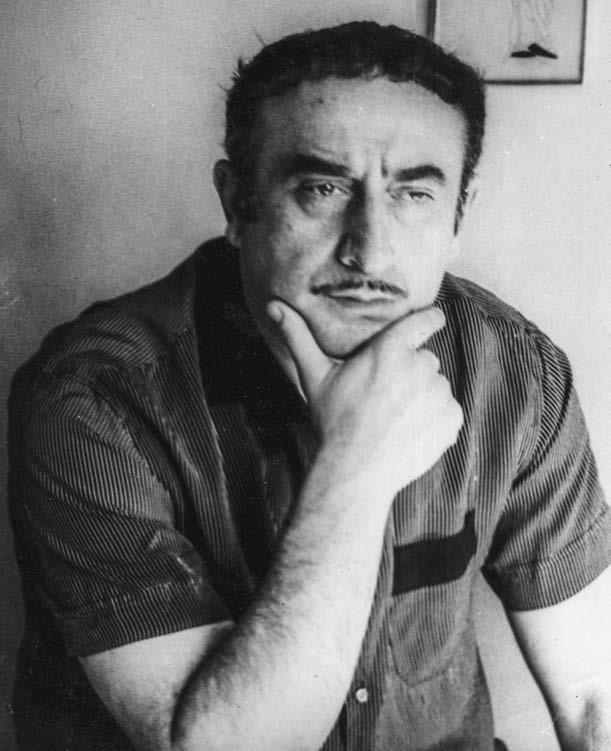
uZvelesi Tqmulebis mixedviT, cecxli RmerTebis saidumloeba yofila, magram promeTes wyalobiT igi adamianis kuTvnileba gamxdara. kacTmoyvare titans cecxli RmerTebisTvis mouparavs da, lerwmis ReroSi damaluli, miwaze Camoutania. cecxli kosmosuri sibrZnis simboloa. samyaroTa
warmomSobi stiqiaa, Semoqmedi sulis materialuri formaa. cecxli sicocxlis dedaa. cecxlis gamovlenis formebi usasruloa, aseve dausrulebelia misi metamorfozac. maSasadame, cecxli sicocxlea, fenomenia, sicocxlis biografiac cecxliT iwyeba. qarTuli sityvebi „sicocxle“, „cincxali“, „cecxlis“ fuZidan
gamokvesili sityvebi gaxlavT. yoveli atomi, ujredi Tu galaqtika sxvadasxva raodenobisa da masStabis eleqtronuli kombinaciaa. qvac ki gacivebuli cecxlia. qvaSi, gansakuTrebiT kaJis qvaSi, uricxvi pawawkintela varskvlavuri anabeWdia moTesili, TiTqos mzis Worfliseburi naperwklebi gaqvavebulano. adamianur vnebaTa foriaqic, temperamenti, azrovneba, emociebis wneva-tonusi, mTeli sasicocxlo energiis gamovlenaa, am RvTaebrivi cecxlis met-naklebi intensiurobiT xarjvaa. miTebsa da legendebSi, Cveulebriv mistikuri azria dafaruli, romelic realistur wakiTxvas moiTxovs. RmerTebisaTvis cecxlis motacebis legendaSi es gasaSifri azri simboloebis saxiT warmogvidgeba. lerwami Semoqmedebis simboloa, cecxli _ RvTaebriv Zalisa, romelic lerwams suls STahberavs da salamurad aqcevs. rogorRa gavigoT damaluli cecxlis simbolika?
1. Semoqmedeba (lerwami) cecxlis (STagonebis) gareSe araraa.
2. raxan cecxli RvTaebrivi Zalaa _ uCinaric unda iyos. RvTaebis da RvTaebriobis erT-erTi atributi uxilavobacaa.
3. damaluli cecxli moTokil temperamentsac niSnavs. moTokili (azrovnebiT gawonasworebuli) temperamenti umaRlesi rangis xelovnebaSi swored dafarulad, qvedinebis saxiT arsebobs. maSasadame, legendaSi SemoqmedebiTi fsiqologiisa da esTetikis es sakiTxi, diaxac rom umaRles doneze, ase vTqvaT, olimpos donezea gadawyvetili.
cecxlis zeciur warmoSobasa da miwiur sazriss Taviseburad exmianeba didi iliac: „me ca mniSnavs da eri mzrdis, miwieri zeciersa“.
cecxlze mkiTxvelis yuradReba SemTxveviT ar SemiCerebia, arc cecxlis „poetur interpretaciaSi“ momixmia igi SemTxveviT.
dRevandel qarTul poeziaSi ramdenime aseuli didpatara poeturi lerwami xmianobs. zogi glexurad gaCorknili, zogi modernistulad galaquli, zogic pirdapir safirmo markisa _ kritikisagan reklamirebuli da xaverdis futliarSi Casvenebuli. mainc Tamamad vambob: zogierTi qarTveli poeti ara Tu Tavisuflad usworebs mxars Tanamedrove msoflio poeziis standartebs, aramed bevr rameSi, (Tundac xatweraSi, metaforul azrovnebaSi) aWarbebs kidec. magram, Cemi azriT, dRevandel qarTul poezias swored is mTavari Tviseba aklia, rac dRemde misi siamayis sagani iyo _ aklia cecxli, es RvTaebrivi madli. ucecxlod Seqmnili striqoni dune, mWle da sisxlnaklulia. Tu Tanamedrove leqsi marTlac rafinirebuli da teqnikurad artistulia, mSobiarobis tkivilebi ar axlavs, Tu leqsi sulieri duRilidan ar daibadeba, ra Tqma unda, arc xorkli da qafi mohyveba da civi iqneba. amitomac tovebs aseTi leqsi natifad Tlili
According to ancient legends, fire was a privilege that Gods used to keep secret, until Prometheus gave it to humanity. The titan, who was fond of humans, is said to have stolen the fire from the Gods, hidden it in a reed, and to have brought it to Earth.
Fire is a symbol of cosmic wisdom. It is an element at the origin of universes, and the material form of creative souls. It is the mother of life. Fire comes in infinite shapes, and its metamorphic process will never stop. Fire is life, it is a wonder. The biography of life starts with fire too. The Georgian words “sitsotskhle” (life) and “tsintskhali” (completely new) both come from the word “tsetskhli” (fire). All atoms, cells and galaxies are an electric combination of various quantities and scales. Even stones are cooled fire. In stones, and particularly in flint, one can find countless minuscule starshaped marks, as if freckled sparks had descended from the Sun. The turmoil of human passion, temper, pondering, and load of emotions are also a manifestation of this cosmic vital energy, the consumption of divine fire at various intensities.
In myths and legends, there is usually a hidden mystical message that needs careful reading. In the legend of the theft of fire, this message has to be deciphered through symbols. The reed is a symbol of creation, fire – of divine force, which breathes life into the reed and transforms it into a flute. How can we decode the hidden symbolism of fire?
1. Creation (reed) without fire (inspiration) is nothing.
2. Because fire is a divine force, it needs to be invisible. One of the attributes of deities and divinity is that they are hidden.
3. Hidden fire also symbolizes a restrained temper. In the finest artworks, a restrained (balanced) temperament appears in a concealed way. Therefore, in this legend, the question of creative psychology and aesthetics is very well addressed; one could say – in an Olympian way.
The heavenly origin and earthly essence of fire are also mentioned by the great poet Ilia Chavchavadze: “I am appointed by the heavens and raised by the earthly nation”.
It is not by coincidence that I have directed readers’ attention towards fire and its “poetic interpretation”.
Several hundreds of reeds of various sizes are “chanting” in contemporary Georgian poetry. Some rustically rough-hewn, some varnished in a modern way, and others even advertised by critics and arranged in a velvety case. I can proudly say that not only do some Georgian poets effortlessly satisfy the standards of contemporary world poetry, but in many cases (for instance in iconography or metaphorical contemplation), they surpass them. But on the other hand, I also believe that contemporary Georgian poetry lacks the fundamental attribute that used to be the source of our pride – it lacks the divine blessing of fire. A fireless verse is inert, scrawny and pale. If contemporary poetry is indeed refined and technically artistic, it doesn’t convey the pain of giving birth, and naturally, if poems aren’t born from a spiritual boil, they won’t be accompanied by any swelling or foam, and will become frigid. This is why this kind of poetry leaves the impression of finely
marmarilos STabeWdilebas. civi striqoni Zalauneburad bundovanic gamodis. Tu cecxlis Tvisebebi siTbo da sinaTlea, gulidan (cecxlis keridan) dabadebul striqonSi sicive da bindbundi ar gaiWaWanebs.
Wkuis darigeba aravis uyvars, miT ufro axalgazrdobas, RmerTma damifaros amgvari „mkrexelobisagan“, me mxolod Cemi dakvirvebis gaziareba minda umcrosi kolegebisaTvis.
literaturaSi momavali axalgazrdoba garkveuli unda iyos Tavis sulier ZiebebSi, sulier moTxovnilebebSi. man unda icodes razed Tqvas uari, ra uaryos, rogorc dromoWmuli da uvargisi. rac mTavaria, kargad unda icodes, ras gaufrTxildes, ras mouaros, ris memkvidred da Wirisuflad Tvlis igi Tavs, ra aris misi ganviTarebis orientirebi.
axalgazrdobas meti romantikuli suli unda aRmoaCndes. pirvel rigSi, wminda profesiuli sakiTxebi unda awuxebdes, vidre honoraris tarifis, TabaxTa raodenobisa da kritikosTa yuradRebis sakiTxia. bevri elvare talanti, mravali didebulad gamocemuli wignis avtori, sinamdvileSi pirveli wignis avtorad darCenila. mizezi maT pragmatistul pativmoyvareobaSi, sakuTari niWierebis vermovlaSi unda veZioT. karieris Ziebam, taSis sixarbem, `Savvolgian~ samsaxurze ocnebam, „Saikobanam“, naadrevma profesionalizmma da bohemurma cxovrebam gaflanga maTi sulieri energia, daSrita maTi STagoneba. aseTi cduneba mware gakveTili unda iyos yvelasTvis. literaturuli axalgazrdobis didi nawili TeTri da Tavisufali leqsiTaa gatacebuli. normaluria es mdgomareoba? ara mgonia. riTma-uriTmobis sakiTxi sulac ar wyvets poeziis rangis sakiTxs. aq sul sxva saSiSroebaa Casafrebuli: vaiTu riTmisa da metris ugulebelyofa sulieri modunebis simptomia, vaiTu cecxlis naklebobas niSnavs? siZneleebisaTvis Tavis arideba, ioli gziT siaruli axalgazrdobis gza ar aris. riTma da metri poets xels ar unda uSlides, rom mxatvrul xilvebs forma mounaxos. pwkareds, prozas miaxlovebuli leqsi gadRabnilia, fokusdarRveuli suraTiviTaa da misi emociuri aRqmac amitom Zneldeba. pwkareds, prozas miaxlovebuli leqsi formis uaryofas udris. uaryofa advili saqmea, Seqmnaa Zneli. riTma da metri leqsis Semkvreli duRabi, rkinis karkasia, poeturi qaosis, anarqiis momwesrigebeli Zalaa da bevr poetur daudevrobas, udisciplinobas gvaSorebs xolme. Tanamedrove qarTul Tavisufal leqss anarqiuli ufro eTqmis, vinem Tavisufali. zogierTebis azriT, verlibri ufro tevadi formaa, uxvi informaciis, inteleqtualuri Ziebebis, teqnicizmiT garTulebuli drois gamomxatveli forma. nu dagvaviwydeba Cveni saukunis didi inteleqtualebi _ maiakovski, pasternaki, galaktioni riTmis virtuozebi iyvnen da aranaklebad rTuli drois
hewn marble. Frigid verses are also automatically vague. The main attributes of fire are warmth and light, so verses that come from the heart (or from the hearth) cannot be cold or vague.
Nobody likes to be preached to, especially youth, and God forbid that I indulge in this “sacrilege” – I only want to share the results of my observations with my younger colleagues.
The future generation in literature should be conversant with their own spiritual quests and needs. They have to know what to refuse; what to deny as outdated and unavailing. Most importantly, they have to know very well what they need to look after, to care for, whose heritage they represent, and what the landmarks of their evolution are.
Youth needs a more romantic soul. In the first place, they should focus on purely professional issues, and not the tariff of their honorary, the number of sheets they have, or the attention of literary critics. Many bright talents, authors of numerous wellpublished books, have actually remained the authors of one book – their first. We have to look for the reasons of this phenomenon in their pragmatic vanity and their inability to look after their talent. The ambition of a career, the greed for applause, the dream of a prestigious job, premature professionalism and bohemian life has wasted their spiritual energy and constricted their inspiration. This kind of temptation should be a bitter lesson for everyone.
A large part of young literary talents is very fond of blank and free verses. Is this situation normal? I don’t think so. The question of whether a poem is rhymed or not doesn’t determine its quality. The threat here is completely different: what if the neglect of rhyme and meter is a symptom of spiritual weakening, what if it comes from a lack of fire? Avoiding difficulties and taking the easy way is not the path the young generation should follow. Rhyme and meter patterns should not hinder poets from finding forms for artistic vision. A poem that looks like prose or a word-to-word translation is distorted; it is like a photograph out of focus, and it also becomes more difficult to perceive on an emotional level.
A poem that looks like prose or a word-to-word translation is a negation of form. It is easy to negate things, and it is much more difficult to create. Rhyme and meter pattern are the mortar keeping a poem together; they are its metal framework; they are forces that organize poetic chaos and anarchy, and keep us away from the many risks of poetic negligence and indiscipline. Contemporary Georgian free verse is more anarchic than free. Some believe that the vers libre is a form that can incorporate more aspects, delivering plenty of information and fitting our time of intellectual research and increased technical complications. Let’s not forget the great intellectuals of our century – Maiakovski, Pasternak, Galaktioni, who were virtuosi of rhyme, and managed to describe a period that was no less complicated than ours. In any case, there is no tendency of particularly high intellectual quests, nor of describing difficult times in Georgian vers libre. I understand that the use of vers libre is a reaction against the primitive poetry that is babbling with rhymes, but the lack of talent and primitiveness cannot be concealed by vers libre either. You are even more “exposed” in that territory. Vers libre is
gamoxatva SeZles. yovel SemTxvevaSi, qarTul Tavisufal leqsSi arc gansakuTrebuli inteleqtualuri Ziebebi
Cans da arc rTuli drois gamomxatveli tendenciebi. me mesmis, Tavisufali leqsis moZaleba Taviseburi reaqciaa riTmebiT atitinebuli primitiuli moleqseobis mimarT, magram uniWoba da primitiuloba arc verlibrSi imaleba. iq ufro „motitvlebulia teritoria“. Tavisufali leqsiT gataceba modaSia, advilicaa, rac mTavaria, saxis etalonadac saRdeba. mTeli evropa ase werso _ amboben specialistebi, Tumca imasac dasZenen, axla klasikur formas ubrundebiano. asea Tu ise, literaturuli evropa Tu msoflio Tavis Tavs rogorme mouvlis. Cven Cveni satkivari vTqvaT. nurc Cvens gemovnebas gamovWriT ucxoTa Targze. gavarkvioT ra formebi ufro gamoamzeurebs qarTuli enis elastikurobasa da simdidres. albaT ucxour enebze verlibris maRalmxatvruli faqtebic arsebobs da moqalaqeobrivi uflebac amitom moupovebia. CvenSi ki aseTi faqti jer ar aRnusxula. verc erT qarTul Tavisufal leqss ver davasaxeleb, romelic karg riTmian leqss jabnides, Sedevrebze aRarafers vambob. Tavisufali leqsi arc siaxlea. Zveli qarTveli himnografebi TeTr da Tavisufal sagaloblebs werdnen. Cveni saukunis 20-30-ian wlebSic did modaSi iyo es formebi. ra Tqma unda, Ziebebis, eqsperimentebis gareSe ganviTareba ar arsebobs, magram dasabeWdad mxolod am Ziebebis Sedegebi unda gamogvqondes da ara yovelgvari laboratoriuli alqimiis nimuSebi. qarTuli literaturuli axalgazrdoba uars ver ityvis Tavis umdidres poetur memkvidreobaze. amis uflebas erovnuli siamayis grZnobac ar mogvcems. erovnuli siamaye ki, pirvel rigSi, isev qarTuli poeziis didi avtoritetiT, aRorZinebiT aris gapirobebuli. araviTari siaxle ar Seqmnila dagrovili poeturi kulturis auTviseblad. amas istoriuli gamocdileba gveubneba. axalgazrda poets gaTavisebuli unda hqondes saukuneebis ganmavlobaSi qarTuli muzis mier mopovebuli warmatebebi; aTvisebuli unda hqondes versifikaciuli normebis, mxatvruli formebis, modelebis, sqemebis, formulebis gamosaxvis saSualebaTa da teqnikur ileTTa mTeli uzarmazari arsenali. qarTveli kacis suli erTob musikaluri, erTob artistulia, riTmas da melodiurobas, formis pewianobas advilad ver Seeleva. gavixsenoT qarTuli simRerebis rTuli arqiteqtonika, maTi formiseuli eleganturoba. Tu gansakuTrebuli smena da artistuli buneba ara gaqvs, aseT simRerebs verc Seasruleb. asevea poeziaSic: Znelia daukargo qarTul leqss artistuli buneba, Znelia daukargo riTmac, metric, ritmic, melodikac, Sesrulebis teqnikuri rafinireba. saWiroa leqsis sazRvrebis gafarToeba, magram gaprozauleba _ ara. qarTveli kaci ver daukargavs qarTul leqss im momxibvlelobas, rac rusTavelma, akakim da galaktionma moupoves. Tu
fashionable, it is easy too, and most importantly, it is considered as an established standard. Everybody in Europe writes like this, specialists say, though they also add that they are currently returning to more classical forms. Anyway, the literary world in Europe or elsewhere will manage to look after itself. Let us focus on our own situation. Let us not base our taste on the templates of others. Let us determine which forms best fit the elasticity and richness of the Georgian language. There are probably highly artistic possibilities for vers libre in foreign languages, and this is why it got such an established status. But this hasn’t happened here yet. I cannot name one Georgian poem written in vers libre that prevails over a rhymed, metered poem – and I won’t even bother to compare them to masterpieces.
Vers libre isn’t a new thing for us. Old Georgian hymnographers wrote chants in blank and free verses. These forms were also popular in our country during the 1920s and 30s. Naturally, there is no evolution without research and experimentation, but we should only publish the accomplished results of this research, and not every example of alchemic work that poets carry out in their “laboratories”. The young generation of Georgian poets cannot renounce its unbelievably rich poetic heritage. The feeling of national pride won’t allow us. And this national pride comes, in the first place, from the prestige of Georgian poetry and its revival. From the experience of history, we know that no novelty has ever been introduced without consideration of the poetic culture that preceded it. A young poet should make the successes found by the Georgian muse throughout centuries his own, as well as the enormous arsenal of versification norms, artistic forms, models, patterns, variety of depiction formulas and technical tricks. The Georgian soul is both musical and artistic; it cannot refrain from the charm of rhythm and melody that easily. Let us remember the complex

davukargavT _ mkiTxvelsac vkargavT da isev poetebi gamovalT wagebulebi. xolo estafetisa da tradiciis ufleba yvela im karg Tvisebas aqvs, rac maradiulia qarTul leqsSi. maradiuli anu waruvali, pirvel rigSi, es cecxlia, anu igive temperamentia _ qarTuli erovnuli poeziis Jangbadi, sicocxlis eleqsiri da ukvdaveba. movCxrikoT es cecxli da gavaRvivoT, aRmovaCinoT damaluli cecxli. mxolod cecxlis Semnaxveli sityvaa gamZle, cocxali da saestafeto. cecxlis cxovelmyofeloba da madli sWirdeba Tanamedroveobasac da momavalsac. TviT ferflad qceuli istoriac ki cecxls inaxavs da ara ferfls. yvelafers iswavli da SeiZen temperamentis gardao, _ ambobda geronti qiqoZe. am azrs komentari ar sWirdeba. me mxolod mis erT aspeqts gavusvam xazs: utemperamento kacma leqsi ar unda weros!..
albaT yvelas gaxsovT giorgi leoniZis striqonebi: „qvac yvela aris naperwkliani, guli rom iyos, gasakviria?“. gasakviri diaxac unaperwklobaa, gulTa unaperwkloba! naperwkali, cecxli axalgazrdobaSia saZiebeli. axalgazrdobas meti cecxli aqvs, aseTia bunebis kanoni. es cecxli unda gamovlindes sicocxlis wyurvilSi, SromismoyvareobaSi, sicocxlis JinSi, idealebisken jiutad swrafvaSi. cecxlis, STagonebis gareSe poezia ar arsebobs. „moazrovne lerwmis drtvinva“ (tiutCevis sityvebia) poeturi cecxlis gaRvivebas gulisxmobs. am cecxliT unda aRvanTebdeT kacTa gulebs, am cecxliT unda vumkurnaloT sazogadoebriv wyluls, sulier mconarobas, primitiul wamxedurobas. „moazrovne lerwmis drtvinva“ mxatvrul siyalbeebTan Seurigeblobas niSnavs, WeSmaritebisken swrafvis poetur Jinsac da vin icis, iqneb cxovrebiseuli azris moZiebasac niSnavdes? sad aris es naperwkliani, Rvelfiani gulebi? ra iqna lerwamSi damaluli cecxli, RvTaebrivi cecxli _ SemoqmedebiTi stiqiis es pirvelsawyisi? sad aris yayaCosferi, Wrilobisferi, broweulis yvavilis briala cecxli? nuTu gaixarja? nuTu adre mosulma tabiZeebma, leoniZeebma da asaTianebma daitaces? ara mgonia... asea Tu ise, am SemTxvevaSi awmyos movaleoba sakiTxis sworad dasmaa. sworad dasmul kiTxvaze swor pasuxs momavali gascems.
magram sityva axalgazrdobas ekuTvnis, dRevandel axalgazrdobas. da ra amowuravs qarTuli poeziis _ erovnuli sulis potenciur SesaZleblobebs? aucileblad unda gamovceT axalgazrda poetebisa da prozaikosebis didtaniani saerTo krebulebi da visac es damaluli cecxli aRmoaCndeba _ siyvaruli, pativiscema da aRiareba ar unda movakloT. 1978 weli
architectonics of Georgian polyphonic songs and their formal elegance. If you don’t have a particularly developed ear and an artistic nature, you won’t be able to perform these kinds of song. It is the same with poetry: it is difficult to strip Georgian poetry from its artistic nature, and it is also difficult to strip it from rhymes, meter, rhythm, melody, and its technical refinement. We do need to spread the horizons of poetry, but not to transform it into prose. Georgians can’t take away the charm that was bestowed to Georgian poetry by Rustaveli, Akaki and Galaktioni. If we do lose it, we will also lose readers, and again, poets will be the losers in the story. The aspects that should be relayed and become a tradition are those that have always existed in Georgian poetry. The main thing that is timeless or eternal is this fire, or in other words, this temper – the oxygen, life elixir and immortal nature of Georgian poetry. Let’s look into this fire and set it ablaze again, let’s discover this concealed fire. The only words that will last are those that have fire in them, that are full of life and should be passed on. Both our current time and our future need the vitality and grace of fire. Even if history turns into ashes, it preserves fire, not ash.
Geronti Kikodze used to say that we can learn and own anything except our temper. This sentence doesn’t need any commentary. I will only underline one aspect of it: a man without temper should not write poetry!..
You probably remember Giorgi Leonidze’s verse: “Even stones produce sparks; would it be surprising if our hearts do?”. What’s surprising is that our hearts can lack sparks! This spark and fire should be searched for in one’s youth. Youth is fierier – it’s a law of nature. This fire can be felt in the thirst for life, in dedication, stubbornness, in the obstinate struggle for ideals... There is no poetry without fire, without inspiration. “The complaint of the thinking reed” (in Tyutchev’s words) means the kindling of poetic fire. This is the fire with which we should light people’s hearts, the one with which we should quench our society’s thirst, spiritual idleness, and primitive imitativeness. “The complaint of the thinking reed” means irreconcilability with artistic forgery, the poetic desire for truth, and who knows, maybe also the search for an existential purpose.
Where are these sparky, burning hearts? Where did the fire that was concealed in the reed go – this divine fire at the origin of creative elements? Where is this brilliant poppy fire, the color of wounds and of pomegranate flowers? Was it fully consumed? Was it taken away by previous poets such as Tabidze, Leonidze or Asatiani? I don’t think so… Whatever the answer, in our current situation, our duty is to ask the question in a relevant way. In time, a question that is asked correctly will always be answered.
But the ball is in the young generation’s camp of today. And what could consume the potential of Georgian poetry – the potential fire of the national spirit? We definitely need to publish thick anthologies of young Georgian poets and prose writers, and we should not lack love, respect and acknowledgement for the ones who display this hidden fire.


fon mercbaxeri
GOTTFRIED VON MERZBACHER
‘FROM
2018 wlis oqtomberSi mouTmenlad veliT Cveni qveynisTvis gansakuTrebuli movlenis, frankfurtis saerTaSoriso wignis bazrobis gaxsnas, sadac saqarTvelo sapatio stumari qveynis rangSi wardgeba... Tumca, Cven qveynebs Soris politikurkulturuli urTierToba araerT saukunovania da amis dasturi, met-naklebad, axlo warsulSi CvenSi arsebuli germanelTa kolonia-dasaxlebebicaa. saqarTveloSi Camodiodnen germaneli mecnier-mogzaurebi, romlebic ikvlevdnen Cvens kulturas, xelovnebas, eTnografias, sabunebismetyvelo mecnierebebs da sxv. iohan giuldenStedtma, gustav radem, gotfrid mercbaxerma fasdaudebeli samsaxuri gagviwies qarTvelebs da Cveni qveynis saxeli Rrma samecniero naSromebiT evropaSi gaitanes. 2017 wels aRiniSna germanuli koloniebis saqarTveloSi daarsebidan 200, saqarTvelos saxelmwifoebriobis aRdgenis 100 (1992 wels germaniam pirvelma scno saqarTvelos damoukideblobis aRdgena) da or saxelmwifos Soris bilateraluri urTierTobis aRdgenis 25 weli. swored am saiubileo wlebs daukavSirda saqarTvelo-germaniis sazogadoebis mier organizebuli eqspedicia saxelwodebiT `TuSeTi _ gotfrid fon mercbaxeridan erovnul parkamde~. saqarTvelo-germaniis sazogadoebas, romelic 1992 wlis 4 Tebervals daarsda, saqarTveloSi goeTes institutis, germaniis sagareo saqmeTa saministros, saqarTveloSi Sveicariisa da avstriis saelCoebis, Sveicariis fond prohelvecias, doiCebankis, saqarTvelos erovnuli muzeumis, sasjelaRsrulebisa da probaciis saministros, evropis saxlis, quTaisis meriis, T.G. Nili Art Space mxardaWeriT ganxorcielebuli aqvs uamravi mniSvnelovani proeqti. erTerTi maTgani, swored gotrfrid fon mercbaxeris (mTamsvleliglaciologi, mineralogi, kartografi-geografi, botanikosi, eTnograf-eTnologi, folkloristi da sxv.) fundamenturi naSromis `kavkasiis maRalmTiani regionebidan~ (Aus den Hochregionen des Kaukasus) qarTuli Targmanis dawyebacaa, romelic mizezTa da mizezTa gamo dRemde ver dasrulda da mxolod misi mcire nawilia gadmoqarTulebuli. arada, 1901 wels laifcigSi gamocemul am CvenTvis umniSvnelovanes ortomeuls, romelic 1892-93 wlebSi Catarebul eqspedicias exeba, Cveni qveynisTvis udidesi mniSvneloba aqvs... imeds gamovTqvamT, rom es saSuri saqme ganxorcieldeba da Cvens samecniero wreebs, zogadad qarTvelebs, saSualeba mogvecema mSobliur enaze gavecnoT am gansakuTrebul ganZs.
We are eagerly awaiting the inauguration of the Frankfurt Book Fair in October 2018, where Georgia will be welcomed as a guest of honor… But the political and cultural ties between our countries date back centuries, as illustrated, for instance, by the German colonies and settlements established in Georgia in recent times. German scientists and travelers were visiting Georgia and studying, among other things, our culture, art, ethnography, and natural sciences. Johann Guldenstedt, Gustav Rade, and Gottfried von Merzbacher spread thorough scientific works about Georgia into Europe and have thus made a priceless contribution to our country’s popularity. 2017 was celebrated as the 200th year since the creation of German colonies in Georgia, as well as the 100th year since the restoration of Georgian statehood (note that Germany was the first country to recognize Georgian independence in 1992) and the 25th year since the restoration of bilateral relations between the two states. The expedition “Tusheti – from Gottfried von Merzbacher to the national park” organized by the GeorgiaGermany Society happened to take place precisely during that commemorative year.
The Georgia-Germany Society, which was founded on the 4th of February 1992, has carried out numerous important projects in Georgia, with the support of the Goethe-Institut, the German Ministry of Foreign Affairs, the embassies of Switzerland and Austria in Georgia, the Swiss fund Pro Helvetia, the Deutshe Bank, the Georgian National Museum, the Ministry of Corrections and Probations of Georgia, Europe House, Kutaisi City Hall, and the T.G. Nili Art Space. One of those projects consisted of starting to translate Gottfried von Merzbacher’s (mountaineer-glaciologist, mineralogist, cartographergeographer, botanist, ethnographer-ethnologist, folklorist...) cardinal work ‘From the Highland Regions of the Caucasus’ (Aus den Hochregionen des Kaukasus) into Georgian, which, for various reasons, still isn’t finished – only a small part of it has been translated to date. That is very unfortunate, because this two-volume book, published in Leipzig in 1901 and describing the author’s expedition in the Caucasus in the years 1892-93, is of enormous importance for our country… We hope that this crucial work will be done, and that our scientific community, as well as Georgians in general, will be able to discover this treasure in their own language.
nawyvetebi meore tomidan:
kavkasiis centraluri nawilis maRalmTiani regionebis kvleva 1892 wlis zafxulisTvis mqonda ganzraxuli, magram 1891 wlis zamTarSi Sua aziaSi mogzauroba sxvadasxva moulodneli mizezebis gamo Zalian gamigrZelda, mere ki iqidan CineTSi amovyavi Tavi da 1892 wlis ivnisSi jer kidev iq vimyofebodi. erTmaneTTan moqiSpe Cinel da monRol didmoxeleTa intrigebis gamo dabruneba sakmaod gamiZnelda. rodesac iqaurobas Tavi didi gaWirvebiT davaRwie da isev ruseTis teritoriaze Sevdgi fexi, gaxarebuli davadeqi gzas, romelsac kavkasiis mTebisken unda waveyvane... bolos da bolos ivlisSi TbilisSi, kavkasiis dedaqalaqSi (avtori Tbiliss ase moixseniebs) iseTi gaxarebuli Cavedi TiTqos didi xnis unaxav Zvel megobars gadavyrode. eniT ver agiwerT im sixaruls da aRtacebas, rodesac ramdenime Tve ukiduresad mZime pirobebSi mogzaurobis Semdeg, rogorc iqna, sastumro „londonSi“ evropul komfortSi da Cemi Tanamemamuleebis wreSi aRmovCndi. mTebSi samogzaurod mosamzadebeli saqmeebis mogvareba sakmaod gaiwela, magram 16 agvistos faqtobrivad ukve mzad viyavi gasamgzavreblad. Tan maxldnen Cemi momavali gamyolebi: tiroleli (avstria) mTamsvlelebi iohan vindiSi da hainrix mozeri, agreTve adgilobrivi somexi Tarjimani ovanesi... 17 agvistos gamTeniisas mZimed datvirTuli Cveni eqspedicia Tbilisis ganapiras kukiis mTas miuaxlovda da oRro-CoRro gzebze gaWirvebiT miiwevda... ramdenime xnis Semdeg mivaRwieT sofel gldans, sadac erTi Cemi Tanamemamule saucxood movlil baRian agarakze cxovrobda. es agaraki, iseve rogorc yvela sxva aqauri lamazi nageboba, ra Tqma unda, somxis sakuTreba iyo. Cemma Tanamemamulem CrdilSi mdgom magidasTan migviwvia... misi meuRlec germaneli gaxldaT da or qaliSvilTan erTad sul Tavs dagvtrialebda. sasiamovno saubarSi dro male gavida da Cvens Tavazian maspinZlebs madlierad davemSvidobeT. gldanidan ukve SedarebiT ukeTesi gza daiwyo da mas saguramos mTebisken gavyeviT... sakvirvelia, rom saqarTvelos Tanamedrove, evropulad mowyobili dedaqalaqidan sul raRac asiode kilometris daSorebiT mdebareobs adgili, sadac ganvlili aTaswleulebis ganmavlobaSi adamianTa cxovrebaSi bevri araferi Secvlila. es gaxlavT xevsureTi, romelsac kavkasionis qedi or nawilad _ piraqeTa da piriqiTa xevsureTad hyofs... xevsurTa Sesaxeb uZvelesi istoriuli cnobebi ar arsebobs. aris mxolod zepiri gadmocemebi, romelTa mixedviT qarTvelur tomTa zogierTi jgufi gaurkveveli mizezebis gamo am unayofo da Znelad
Excerpts from the second volume:
I had planned to study the highland regions of the central Caucasus in the summer of 1892, but because of various unpredictable factors, my journey in Central Asia in the winter of 1891 took longer than expected, and from there, I found myself in China, where I stayed until June of 1892. Because of the political intrigues between rivaling Chinese and Mongol rulers, it became quite difficult for me to come back. When I finally managed to get out and to re-enter Russian territory, I happily took the road that would lead me to the Caucasus mountains…
When I eventually arrived in Tbilisi, capital of the Caucasus, I felt as much joy as I would if I had stumbled across an old friend. I cannot describe this feeling of delight, when after several months of traveling in extremely harsh conditions, I finally found myself at the ‘London’ hotel among a group of compatriots. The preparation for my journey in the mountains took quite a long time, but on the 16th of August, I was ready to leave. My future companions were with me: Tyrolean (Austrian) mountaineers Johann Vindisch and Heinrich Mozer, as well as a local Armenian translator named Ovanes…
At first light on the 17th of August, our heavily loaded expedition approached Mount Kukia in the suburbs of Tbilisi, walking with difficulty on rough pathways… After some time, we reached Gldani village, where one of my compatriots lived in a villa with an extraordinarily well-maintained yard. Naturally, like other beautiful buildings found here, this house belonged to Armenians. My compatriot invited us to a table in the shade of a tree… His wife was German too, and together with her two daughters, she indulged us with every attention. Time flew by during our pleasant conversation, and at last, we bid farewell to our generous hosts.
From Gldani, the road was relatively better, and we headed to the hills of Saguramo…
It is surprising that only about a hundred kilometers from the modern, European-like capital of Georgia, there is a place where not much has changed in human life for the last millennia. This place is Khevsureti, a region divided in two by a ridge of the Caucasus: “Piraketa” (“Hither”) Khevsureti and “Pirikita” (“Thither”) Khevsureti…
There are no ancient historic sources about the Khevsurs; there is only an oral history, according to which for unknown reasons, some groups of Kartvelian tribes were forced to move and settle in this inaccessible barren region, where they found a new home and became an independent tribe. But this people didn’t lose their roots.
If we pay attention to the utterly interesting inner world of this small tribe, we will see that there are three main reasons that make them stand out. These are: the natural environment of the region in which they live, their practice of blood feuds, and their particular religious beliefs. The origin and development of this people’s incredibly strong martial spirit is mostly due to the first two factors. Until very recently, a Khevsur man would never go out of his household unarmed. Above the waist, he would wear a coat of mail, with metal plates covering his armpits, and a slightly curved
misadgom mxareSi iZulebiT gadasaxlda, iq axali samSoblo hpova da damoukidebel xalxad Camoyalibda. Tumca es xalxi fesvebs mainc ar mowyvetila. Tu am mcirericxovani xalxis erTob saintereso Sida samyaros davakvirdebiT, davinaxavT, rom maTi gansakuTrebulobis mizezi sam garemoebaSia. esenia: im mxaris bunebrivi garemo, sadac isini cxovroben, sisxlis aRebis wesi da gansakuTrebuli religiuri warmodgenebi. am xalxis warmoudgenlad Zlier sabrZolo sulis warmoSobas da ganviTarebas, uwinares yovlisa, pirveli ori faqtori ganapirobebda. jer kidev sul cota xnis win xevsuri mamakaci saxlidan iaraRausxmeli ar gavidoda. welszemoT jaWvis perangs icvamda, iRliebs liTonis firfitebi ufaravda, Tavzec odnav SeRunuli, rkinisave mcire muzaradi exura, romelsac yurebTan damcavi liTonis wvrili jaWvebi ekida. cal xelSi grZeli, swori xmali eWira da meoreSi patara rkinis fari, xolo qamarze xanjali ekida. es aRWurviloba da mkerdze da mxrebze feradi jvrebiT amoqarguli samosi warmoadgens samogzauro literaturaSi gavrcelebuli legendebis wyaros, TiTqos xevsurebi sxvadasxva qveynebSi gafantuli jvarosani raindebis STamomavlebi iyvnen. am saWurvels Zvel droSi emateboda mSvildi da karWapSi Cawyobili isrebi. mogvianebiT is cecxlsasrolma iaraRma Secvala... rogorc aRvniSneT, xevsurTa mebrZoli suli da xasiaTi saukuneebis ganmavlobaSi gamudmebul sabrZolo moqmedebebSi yalibdeboda. maTi kuTxis geografiuli mdebareobis gamo xevsurebs CrdiloeTiT mosazRvre mousvenar da mudam yaCaRobiT dakavebul CeCnebTan da qistebTan uxdebodaT brZola. qistebi mamaci meomrebic iyvnen da agreTve cxenis moparvaSic badali ar hyavdaT. garda amisa, didi mniSvneloba hqonda religiur faqtorsac. CeCnebi da qistebi fanatikosi musulmanebi arian da maTi xevsurebTan mtroba amiTac iyo gamowveuli. maT Soris mtroba da SuRli arasdros SeCerebula. dResac SexvdebiT xevsurul soflebSi koSkebze gadmokidebul adamianis gamxmar mklavebs, romlebsac xevsurebi moklul mters aWridnen da saxlSi am nadavliT brundebodnen. xevsur qals ki mxrebze awevs uamravi saqme da movaleoba, magram misi uflebebi Zalian SezRudulia. xevsur qalebs mamakacebTan erTad yvelaze mZime sasoflo-sameurneo saqmeebis Sesruleba uwevT, aseve wylisa da SeSis saxlSi mitana, mosavlis mka da misi galewva. raRa Tqma unda, masve evaleba saWmlis momzadeba, yvelis da karaqis keTeba da tanisamosisa Tu fexsacmlis kervac. samagierod, misi aseTi mdgomareoba radikalurad icvleba, rogorc ki ojaxSi rZali Seva. maSin is, rogorc ufrosi diasaxlisi, am samuSaoebs ki aRar asrulebs, aramed anawilebs da rZlebs avalebs.
small iron helmet with narrow protective chains hanging next to his ears. In one hand, he held a long, straight sword, and in the other, a small metallic shield; a dagger was also attached to his belt. This equipment and their embroidered attire, with colorful crosses on the chest and shoulders, is the source of legends in travel literature, according to which Khevsurs are claimed as the descendants of crusading knights spread in various countries. In ancient times, they would also carry a bow and a quiver of arrows. Later, this was replaced by firearms…
As mentioned, the Khevsur’s fighting spirit and character was developed during the multitude of battles they faced throughout the centuries. Because of the geographical location of their region, Khevsurs had to battle the restless Chechens and Kists, who carried out one robbery after another. Kists were brave warriors and had no equal for stealing horses. Apart from that, the religious factor was also very important. Chechens and Kists are fanatic Muslims, and this is why they became enemies with the Khevsurs. Their enmity still exists and to this day, you will encounter dried-out upper limbs hanging from towers in Khevsur villages – Khevsurs having cut them from the bodies of the enemies they killed and returning home with them as loot.
As for Khevsur women, they have plenty of duties and responsibilities, but their rights are very limited. Khevsur women have to exert themselves on the hardest agricultural works together with the men, as well as to bring home water and firewood, and to crop and thresh harvests. It goes without saying that they must also prepare food, make cheese and butter, and sew clothes and shoes. However, this condition changes radically when a daughter-inlaw enters the household. In this case, the wife becomes the head housewife, and instead of fulfilling the above tasks, they distribute them between their daughters-in-law. They also look after the order and tidiness of the house. They are respected by all, and no important matter in the household can be decided without them…
Knowledgeable readers will easily notice the similarity with the Mosaic Law. As we will see later, other Khevsur customs also bear clear correspondences to the practices of ancient Jews, which suggests that ancient, emigrant Israelites also moved to Khevsureti and settled there with the Kartvelian groups.
Pshavs, Tushetians, and the relatively smaller tribe of Mtiuletians living near the Khevsurs, have similar religious beliefs and customs. Among Pshavs, these customs have remained almost identical to those of their brotherly Khevsurs, while with Tushetians, because of much more frequent contact with the Georgian valleys, and therefore a more progressive mental development, we find only a number of the abovementioned customs.
Concerning clothing, Khevsurs are the only Kartvelian tribe to not have adopted the Kabardian attire spread all over the Caucasus mountains – the so-called “cherkeska”. This is why to this day, Khevsurs – both men and women – wear their own traditional attire, which clearly differs from that of other Caucasian peoples in its embroidered decorations and colorfulness. All this has been
aseve ganagebs is saxlSi wesrigs. igi sayovelTao pativiT sargeblobs da saxlSi yvela mniSvnelovani saqme mis daukiTxavad ver keTdeba... gaTviTcnobierebuli mkiTxveli advilad SeamCnevda did msgavsebas moses sjulis kanonebTan. rogorc Semdgom davinaxavT, Zvel iudevelTa wesis aSkara msgavsebas xevsurTa sxva adaT-CveulebebSic Cans, rac imaze migviTiTebs, rom am xalxis warmoSobis dros maT mxareSi gadmosaxlebuli Zveli ebraelebic saxlobdnen. fSavlebs, TuSebs da xevsurebTan maxloblad mcxovreb SedarebiT mcirericxovani mTiel xalxs _ mTiulebs _ TiTqmis iseTive religiuri Sexedulebebi, wesCveulebebi aqvT. fSavlebSi es wes-Cveulebani dRemde TiTqmis iseTivea, rogorc maT moZme xevsurebSi, xolo TuSebSi ki, saqarTvelos barTan gacilebiT xSiri urTierTobebisa da, aqedan gamomdinare, mentalurad ufro progresuli ganviTarebisa, xsenebuli wesCveulebani didwilad aRar gvxvdeba. rac Seexeba samosels _ xevsurebi qarTvelur tomebs Soris erTaderTni arian, romelTac ar miiRes zogadad kavkasiaSi gavrcelebuli yabardouli samosi _ e.w. Cerqezka. amitom xevsurebi _ rogorc mamakacebi, aseve qalebi _ dRemde TavianT erovnul samoss atareben, romelic kavkasiis sxva xalxTa samosisgan gansxvavebiT naqargebiTaa morTuli da ferTa siuxviT aSkarad gamoirCeva. es yovelive gustav rades imdenad dawvrilebiT, saqmis codniT da gulmodginebiT aqvs aRwerili, rom me msgavsi daxasiaTebisgan Tavs Sevikaveb. am Znelad misadgom mxareSi evropelebi faqtobrivad ver aRweven. evropelebs ki ara, TviT barSi mcxovreb qarTvelebs da spekuliantobaSi saxelganTqmul somex vaWrebsac ki xevsureTSi TiTqmis versad SexvdebiT, radgan es mxare Raribia da vaWrebisTvis uintereso. am siRaribis gamo iqaur mamakacebs sul ufro da ufro xSirad uxdebaT mSobliuri mTebis mitoveba da ojaxis sarCenad saqarTvelos sxva kuTxeebSi saSovarze wasvla... xevsurebisa da fSavlebis garda Cveni mogzaurobis dros qistebsac gavecnobiT da, gansakuTrebiT _ TuSebs... qistebTan dakavSirebiT vityvi, rom CeCnebTan eTnikuri da enobrivi aSkara kavSiris miuxedavad, maTi SesaZlo qarTveluri warmoSobis sakiTxis gadaWriT uaryofa mainc sadavoa. qarTuli wyaroebis (vaxuSti batoniSvili) Tanaxmad, qistebiT dasaxlebuli teritoria uZvelesi droidan qarTveli tomebis gavrcelebis arealSi mdebareobda da erTi xanoba mas kaxeTis mefeebic ki marTavdnen. rogorc winamdebare wignis pirvel tomSi aRvniSneT, dRes qistebiT dasaxlebul teritoriaze bevri qarTulwarwerebiani Zveli eklesiis nangrevi da agreTve qistebSi arsebuli wes-Cveulebebi gvxvdeba, romlebsac qistebi garkveul dReebSi swored am nangrevebTan aRasruleben...
described by Gustav Rade in such detail and which such expertise and dedication that I will refrain from any further characterization. Europeans are practically unable to get to this remote region. Even Georgians living in the valley, or the famously speculative Armenian merchants, are almost nowhere to be seen in Khevsureti. It is because this region is poor, and therefore uninteresting for merchants. Because of poverty, more and more frequently local men need to leave their mountains and look for work in various Georgian regions in order to sustain their families…
Apart from Khevsurs and Pshavs, during our travel, we also got to know Kists, and remarkably – Tushetians… About the Kists, I will say that despite their obvious ethnic and linguistic link to Chechens, one shouldn’t rule out the possibility that they have Kartvelian origins. According to Georgian sources (Vakhushti Batonishvili), since ancient times, the territory inhabited by Kists has been located in an area where Georgian tribes were present, once ruled by the Kings of Kakheti. As we mentioned in the first volume of this book, there are many old church ruins with Georgian inscriptions on the territory now inhabited by Kists, as well as Kist rituals that they perform precisely next to these ruins on specific occasions…
Like Upper Svaneti, Tusheti consists of an elliptic basin, which is located between the region’s two main rivers Pirikita Alazani and Tushetis Alazani. The lower part of the river valleys isn’t fit for living in, which is why Tushetian settlements are located on alpine terraces, namely at 1800 to 2200 meters above sea level.
The Tushetian climate is harsh, and winter lasts almost seven months there. Despite rich alpine pastures, mountain people stock livestock feed far ahead of time, so that they can cater for sheep and other animals’ food in winter… This is the reason Tushetians often drive their cattle down into Kakheti for winter, sometimes even bringing them to the pastures of Shiraq and Zakatala. In a strange contrast to other nomadic peoples living in similar conditions, Tushetians live a strictly sedentary life during summer, and spend winter on the road. But this only concerns the menfolk…
Their common religion and race, and their union against their common enemy, their neighboring Kists and Dagestanis, have united Tushetian and Khevsur tribes through the centuries. These two courageous peoples have become a unified, live curtain wall protecting Georgians, and more generally Christians, from their fanatic old archenemies. It would be no exaggeration to say that if today the Georgian race is at the forefront in Transcaucasia, it is, in major part, due to the way these two brave peoples so brilliantly defended themselves, relentlessly and vigilantly guarding Georgia’s northern border and facing the enemy without fear.
Compared to all other Caucasian mountain peoples, Tushetians are the ones who most resemble the Georgian tribes living in the valleys, as well as their neighboring Khevsurs. But we can also note some differentiating signs in their appearance… For instance, Tushetians don’t like beards, choosing moustaches, while beards are very popular among men in Kartli and Imereti. I was struck by their noteworthy facial expressions, which were different than
TuSeTis regioni, zemo svaneTis msgavsad, elifsur auzs warmoadgens. is Seqmnilia ori mTavari mdinaris, piriqiTa da TuSeTis alaznebs Soris. mdinareTa xeobebis qvemo nawili sacxovreblad gamousadegaria, amitom TuSebis dasaxlebebi alpur terasebzea ganlagebuli, kerZod 1800-dan 2200 metr simaRleze.
TuSeTis klimati mkacria da iq zamTari TiTqmis Svidi Tve grZeldeba. mdidari alpuri saZovrebis miuxedavad, saqonlisaTvis saWiro sakvebs mTielni adreve imarageben, raTa cxvari da sxva saqoneli zamTris ganmavlobaSi gamokvebon... am garemoebis gamoa, rom TuSebi TavianT saqonels gamosazamTreblad xSirad kaxeTSi Carekaven xolme da xandaxan TviT Siraqisa da zaqaTalas saZovrebamdec ki gadahyavT. analogur pirobebSi mcxovrebi momTabare xalxebisgan ucnauri gansxvavebiT, TuSebi myarad mobinadre cxovrebas zafxulSi ewevian, zamTarSi ki gzaSi arian. Tumca es mxolod mamakacebs exeba... rwmenisa da jiSis erTianobam da saerTo mtris, mezoblad mcxovrebi qistebis da lekebis winaaRmdeg gaerTianebam TuSebi da xevsurebi saukuneTa ganmavlobaSi erT muStad Sekra. es ori guladi mTieli xalxi erTian, cocxal galavans qmnida qarTvelebis, da saerTod qristianebis, uZvelesi fanatikosi da dauZinebeli mtrebis winaaRmdeg. gadaWarbebuli ar iqneba, Tu vityviT, rom Tu dRes amierkavkasiaSi pirvel planze qarTveluri rasaa warmodgenili, es didwilad imis damsaxurebacaa, rom es ori umamacesi xalxi umagaliTo TavdacviT brZolas awarmoebda. isini saqarTvelos CrdiloeT sazRvars gamudmebiT da fxizlad darajobdnen da mters uSiSrad egebebodnen. yvela sxva kavkasiel mTielebTan SedarebiT TuSebi garegnobiT yvelaze metad hgvanan barSi mcxovreb qarTvelur tomebs da aseve mezobel xevsurebs. Tumca, erTi SexedviT maT garegnobaSi ganmasxvavebeli niSnebic gvxvdeba... qarTlSi da imereTSi mamakacebs Soris esoden gavrcelebuli wveri TuSebs ar moswonT. isini umetesad ulvaSs atareben. me TvalSi meca maTi sakmaod sayuradRebo gansxvavebuli saxis gamometyveleba xevsurebTan SedarebiT. maSin, roca xevsurebis gamometyveleba cota moridebuli, Tumca jiquri da daxurulia, me, didi mcdelobis miuxedavad, TuSeTSi yvelaze ufro qardakrul da gauxeSebul saxeebSic ki mxolod sialales da sikeTes vxedavdi... am mSvenier saRamos Zalian civi Rame moyva. karavSi vkankalebdi, gareT ki, cecxlTan xalxi ijda da maTi xmamaRali saubari da sicili Zils mifrTxobda. diliT irgvliv yvelaferi TeTri rTviliT iyo dafaruli. vedroebSi wyali gayinuliyo. CrdiloeTidanac saSinlad susxiani qari qroda da amitomac maincdamainc guli ar damwyvetia im adgilTan gamomSvidobebis gamo, radgan vicodi, rom male isev mziT gamTbar
that of Khevsurs. While the Khevsur expression is a bit shy, though undeterred and closed, despite my best efforts, I couldn’t see anything other than purity and kindness in even the most seasoned and roughened faces in Tusheti...
This lovely evening was followed by a very cold night. I was shivering in the tent, while people were sitting around a fire outside, and their loud talking and laughter prevented me from sleeping. In the morning, everything was covered in a white frost and the water in the buckets was frozen. A stinging wind blew from the north, and as such, I wasn’t sorry to leave the place, knowing that we would soon be heading towards sunnier climes. Tushetians loaded the horses that had been brought the former evening with joyful sounds; this took several hours, after which we finally left. These experienced people masterfully lead the heavily loaded horses on a steep downward slope, and we descended towards the valley of the River Kvakhidi without any difficulty or delay. And this on quite a dangerous trail. Riding his horse, one of the men was almost touching the slope of the mountain with one of his legs, which could have both hurt the man and brought the horse so close to the edge of the path that both were at risk of falling into the abyss, at the bottom of which a mountain river roared straight from the glacier. When we continued on our way above the river set in this precipice, we found ourselves on a terrace approximately 2200 meters above sea level, where a defensive wall of black shale layers and the beautiful towers of the picturesque Tushetian village Chontio appeared, welcoming us with a bit of a frown, nested in idyllic surroundings. You would have thought that you had arrived in a robbers’ den from the Middle Ages, because almost everything there was black: the stone walls of the houses and the towers, the soil, and even the clothes of the men, women, and children. Some of the houses on the mountainside were falling apart, and thus intensified this impression even more, but the mood that reigned in this gloomy village was a festive one. The village was preparing for a wedding, and, naturally, as we were with the esteemed Solomon, we were wholeheartedly invited to the celebrations. In a corner of one of the village streets, they were brewing beer in an enormous boiler, and our hosts soon handed me a large jug full of it. Even though I had been suffering from the scorching sun the whole way to the village, I cannot say that I enjoyed that beer very much. It had a sour and burned taste similar to Russian Kvass. The praiseworthy words written by some of our travelers about beer brewed in the Caucasian mountains probably come from the fact that they like everything that reminds them of their homeland. Even my Tyroleans, who were drinking connoisseurs, held their jugs with downcast faces. However, Levan was more than happy, and looking at him, I became convinced that everything in this world is relative. Probably no other beer in this world could have made his face as blissful as when he came staggering from the house of the groom after an impressively short time. And he was not the only one to be happy. I soon saw several other reeling men and, considering the
adgilebisken gavemarTebodiT. TuSebma mxiaruli xmauriT datvirTes wina saRamos CvenTvis Camoyvanili cxenebi, rac ramdenime saaTs grZeldeboda, da bolos, rogorc iqna daviZariT. axla ki es gamocdili adamianebi mZimed datvirTul cxenebs ostaturad miuZRvebodnen cicabo daRmarTze da mdinare qvaxidis wylis xeobisken yovelgvari Seferxebisa da marcxis gareSe veSvebodiT. es ki sakmaod saxifaTo bilikze xdeboda. cxenze mjdomi kaci cali fexiT TiTqmis mTis kldian kalTas exeboda, rac adamians an daazianebs, anda cxens bilikis kidemde imdenad axlos miiyvans, rom orives ufskrulSi gadaCexva emuqreba, romlis fskerze myinvaridan wamosuli mTis mdinare grialiT miedineba. rodesac gza kldovan kalapotSi moqceuli mdinaris zemoT gavagrZeleT, daaxloebiT 2220 metris simaRleze mdebare terasasTan aRmovCndiT, sadac Cvens win romantikulad lamazi mdebareobis mqone TuSuri soflis, WonTios sipis qvis qanis Savi galavani da lamazi koSkebi aRimarTa da cota moRuSuli mogvesalma. gegoneboda, Sua saukuneebis yaCaRebis budeSi movxvdio, radgan iqauroba TiTqmis mTlianad Savi feris iyo: saxlebis qvis Robeebi da koSkebi, miwa, agreTve rogorc mamakacebis, ise qalebis da bavSvebis samosic ki. mTis kalTebze Sefenili dangrevis piras misuli nagebobebi am STabeWdilebas kidev ufro amZafrebda, magram am pirquS sofelSi sazeimo ganwyoba sufevda. sofelSi saqorwino samzadisi idga da Cven, rogorc pativcemuli adamianis, solomonis Tanmxlebni, rasakvirvelia, qorwilSi mTeli guliT migvipatiJes. soflis erTi quCis kuTxeSi mdgom spilenZis uzarmazar qvabSi ludi moexarSaT da damxvdurebma male ludiT savse didi doqi momawodes. marTalia, mTeli gza dasicxulma viare da Zalian mwyuroda, magram ver vityvi, rom ludi Zalian mesiamovna. raRac rusuli buraxis msgavsi momJavo da damwvris gemo dakravda. is saqebari sityvebi, rac kavkasiis mTebSi moxarSuli ludis Sesaxeb zogierT Cvenebur mogzaurs albaT imitom aqvs dawerili, rom maT yvelaferi moswonT, rac samSoblos moagonebs. TviT Cems tirolelebsac ki, romlebic smis didi moyvarulebi gaxldnen, sakmaod uJmuri saxiT hqondaT doqebi moyudebuli. samagierod levani iyo erTob kmayofili da misi Semxedvare kidev erTxel davrwmundi, rom am qveynad yvelaferi SedarebiTia. albaT, vercerTi sxva ludi am qveyanaze mas iseT netar saxes ver mohgvrida, rogoriTac is saocrad mokle xanSi meqorwileTa saxlidan gamobarbacda. sxvaTa Soris, marto is ar gaxldaT aseT netarebaSi. male kidev ramdenime motortmane kaci davlande da imis gaTvaliswinebiT, rom TuSebi ludis smaSi ganTqmuli xalxia da didi raodenobiT sma SeuZliaT, unda vivaraudoT, rom iq imdeni ludi dailia, ramdenic miunxenis romelime
fact that Tushetians are renowned beer drinkers and can consume large amounts, we can suppose that they drank as much beer in that house as would be drunk in a beer cellar in Munich. The bride and the groom were in Dartlo village partaking in a religious wedding ceremony, and the guests were expecting them back any minute. We later met them on the road. Guests were gathered in one of the houses. They brought us stewed veal, sweet barley porridge, bread, and the famous, wonderful Tushetian cheese on a wooden platter outside. We didn’t need to go inside the house to see the celebration, because it happened the other way around: the curious people came outside to see us. Naturally, I didn’t miss the opportunity and took photographs of some groups of these people. But they were only photographs of men and children. The beautiful, mainly young, women, fled as soon as I directed the lens toward them, and even Solomon’s summons couldn’t make them change their minds. Only one woman obliged, but, unfortunately, she was old and very ugly. I guess that she was either already fearless of anything, or she deemed her withered face still attractive enough to enrich a foreigner’s collection. In general, that is how it is in life – what you want most slips from your hands, and what you don’t want will come to you by itself and weary you. A little later, I saw the women who had fled on another street. They were crouched next to each other in the shade of a tower, chatting and knitting. Knitting is the Tushetian woman’s main recreational occupation. The colorful shoes (“chitebi”) for men, women and children, adorned with beautiful motifs, are precisely the result of this “recreational occupation”. Tushetian women are so used to knitting that if they happen not to have anything to knit, they don’t know what to do with their hands, so they interlock their fingers. Their facial features are even and well-constructed, like other Georgian women’s, but with fuller cheeks, and fierier and expressive large black eyes. Both their face and body skin is dark. Their lips have a subtle and full shape. Only their noses are bent and aquiline. Their faces are embellished on both sides by a rolled braid. Below their glittering, silver-striped black headscarves, their shy and curious gazing eyes are of a breathtaking beauty... The women have characteristic beautiful silver jewelry about their necks, and they also wear a silver necklace combining several chains on their chests. Young women don’t wear a headscarf; instead, they boast many thin braids, in which they insert colorful beads. The cleanliness of the women’s attire is remarkable. The principal color of their attire is black, and it is richly decorated with bright colors and silver, which looks quite attractive…
Unlike their neighboring Pshavs, Tushetian women don’t become ugly when they get old. On several elderly women’s faces, largely covered by a headscarf, I observed pale, thin and harmonious features, bearing the same noble appearance as those described of old ladies in Ancient Rome (so-called matrons). To say the least, and contrarily to what I had heard before, I noticed that Tushetians were not as tall as I was expecting. In fact, as I observed, Tushetian men are mostly short or of medium height, and are slim. People are very friendly and frank. They are openhearted and merry people…
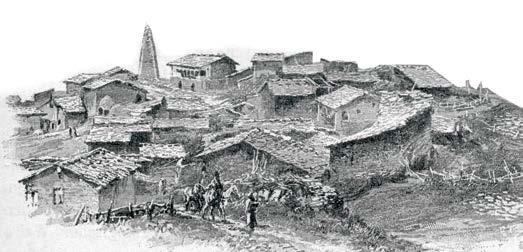
ludis sardafSi daileoda mTlianad. meqorwile qalvaJi sofel darTloSi wasuliyo jvris dasawerad da ukan male moelodnen. Cven maT mogvianebiT gzaSi SevxvdiT. erT-erT saxlSi stumrebi iyvnen Sekrebili. CvenTvis quCaSive gamoitanes xonCaze dalagebuli moxarSuli saqonlis xorci, qeris tkbili fafa, puri da ganTqmuli, SesaniSnavi TuSuri yveli. zeimis sanaxavad saxlSi Sesvla ar dagvWirvebia, radgan piriqiT moxda: cnobismoyvare xalxi Cvens sanaxavad gareT gamovida. raRa Tqma unda, SesaZlebloba xelidan ar gamiSvia da am xalxis ramdenime jgufs fotosuraTebi gadavuRe. Tumca es mxolod mamakacebis da bavSvebis fotoebi iyo. lamazi, umetesad axalgazrda qalebi ki maSinve garbodnen, rogorc ki obieqtivs maTken mivmarTavdi da maTze TviT solomonis Txovna-Segonebac ki ver Wrida. mxolod erTaderTi qali gamiCerda, magram samwuxarod moxuci da erTob Seuxedavi. albaT, an SiSi ukve aRarafris hqonda, anda egona, rom misi damWknari saxe jer kidev sakmaod mimzidveli iqneboda saimisod, rom ucxoelis koleqcia gaemdidrebina. saerTod, asea cxovrebaSi _ rac Zalian ginda, umeteswilad xelidan gisxlteba da rac ar ginda, TviTon gadageyreba da Tavs mogabezrebs. gaqceuli qalebi cota xnis Semdeg sxva quCaze davinaxe. koSkis CrdilSi erTmaneTis gverdiT Cacucquliyvnen, maslaaTobdnen da Tavs qsoviT iqcevdnen. qsova TuSi qalebis mudmivi TavSesaqcevi saqmianobaa. Wreli, lamazi motivebiT moqsovili mamakacebis, qalebis Tu bavSvebis lamazi fexsacmeli (CiTebi) swored am „TavSesaqcevi saqmianobis“ Sedegia. TuSi qalebi qsovas ise arian miCveuli, rom Tu SemTxveviT saqsovi Tan ara aqvT, ar ician xelebs ra mouxerxon da amitom TiTebs ermaneTSi
aWdoben xolme. maTi saxis nakvTebi Tanabaria da sworad awyobili, rogorc es sxva qarTvel qalebSic gvxdeba, oRond loyebi ufro sruli aqvT, Tvalebi _ Savi, didi, ufro cecxlovani da metyveli. saxis kani Savgvremani aqvT, da aseve xorcis feri. tuCebi natifi moxazulobis da sruli. mxolod cxviri aqvT umetesobas mokauWebuli da cota qorisebri. saxes aqeT-iqidan ori daxveuli nawnavi umSvenebT. mobrWyviale, vercxlisferkantebiani Savi mandilis qvemodan Tan morcxvad da Tanac cnobismoyvared mzirali Tvalebi marTlac rom Tavbrudamxvevi silamazisa aqvT... qalebs yelzec vercxlis sxvadasxva samkauli SveniT da maTi tansacmeli mkerdzec vercxlis Zewkvisebri morTulobebiT gamoirCeva. axalgazrda gogonebi mandils ar atareben da samagierod mravali wvrili nawnaviT iwoneben Tavs, romelSic ferad-feradi margalitebia Cawnuli. qalTa samosis sisufTave TvalSisacemia. samosis ZiriTadi feri Savia da WrelfrTiani, Tan vercxliT mdidruladaa morTuli, rac sakmaod mimzidvelad gamoiyureba... mezobeli fSaveli qalebisgan gansxvavebiT, TuSi qalebi sibereSi ar uSnovdebian. ramdenime xnieri qalis mandiliT Rrmad dafarul saxeSi fermkrTali, gamxdari da mwyobri nakvTebi SevniSne, iseTive keTilSobili ieris, rogorebadac Zvel romael xanSiSesul qalbatonebs (e.w. matronebs) aRweren. cota ar iyos, TvalSi meca, rom adre gagonilis sawinaaRmdegod, TuSebi aRnagobiT ise maRlebi ar iyvnen, rogorc velodi. piriqiT, Cemi dakvirvebiT, TuSi mamakacebi umetesad tanmorCili an saSualo simaRlis da Txeli aRnagobis arian. xalxi Zalian megobruli da alalia, gulgaxsnilni da molxena uyvarT...
(qarTuli ganmanaTleblobis saTaveebTan)
„qveynis daarsebiTgan mamulsa Cvensa aqvnda Tavisi sakuTari mdgomareoba, aqvnda Tavisni rjulni, Tavisni sarwmunoeba, Tavisi ena da Tavisi Cveuleba, hyvanda yovelsa drosa sakuTari Tavisi xelmwife da arasodes ar iyo mokidebuli sxvasa zeda da arca mona, viTarcaa aq ars mamuli ese Cveni. da Cveni xma, saxeli da mamacoba winaparTa CvenTa yovelTvis hquxda da aRavsebda msofliosa. mteri maradis mowylul iyo da damxobil maTgan. xolo aw xedavTa damxobasa da araraobasa mamulisa Cvenisasa? hgrZnobTa Seiwroebasa yovlisa kacisasa?! raisTvis ars ese esreT? nu ukve Cven ara varT Svili mama-papaTa CvenTana?! nu ukve Cven ara ZalgviZs Senaxva sakuTarisa mamulisa Cvenisa?! nu ukve Cven ara gvaqvs simxne da Zali eseoden, raodenic Cvens mamaTa anu sxvaTa msgavsTa kacTa?! maS raisTvis vcocxlobT!“ solomon dodaSvili
(AT THE SOURCE OF GEORGIAN ENLIGHTENMENT)
“From the very creation of our country, our homeland had its own territory, its own traditions, its own faith, its own language and its own customs; it had its own rulers at all times, and was never dependent on others, nor was it someone’s slave, like it is today. And our say, our reputation and the bravery of our ancestors always resounded around the world. They always managed to defeat their enemies. But do you see the current state of decay and the terrible situation of our motherland? Can you feel the oppression exerted on each individual?! Why do we let this happen? Aren’t we the sons of our fathers and grandfathers anymore?! Have we lost the courage to protect our own homeland?! Have we lost the vigor and strength of our fathers and other men of the like?! Then why do we even live?!” Solomon Dodashvili
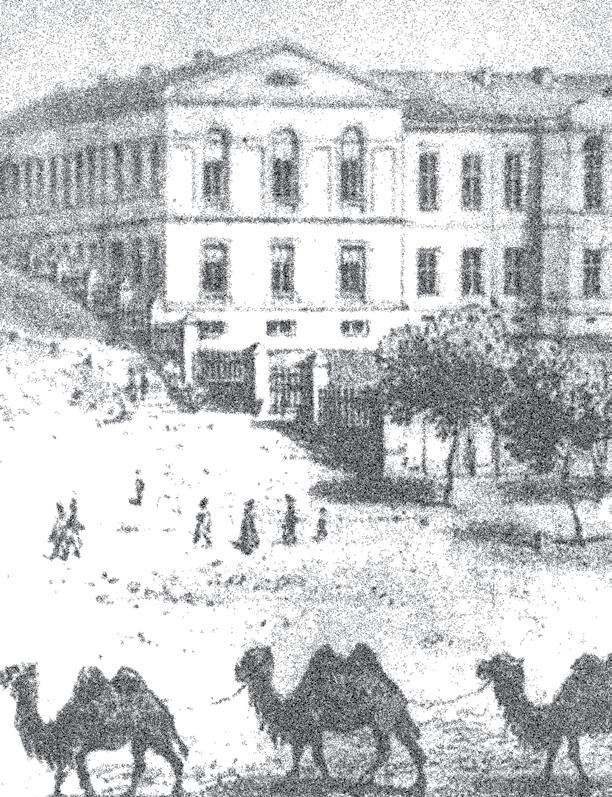
roca qarTuli ganmanaTleblobis Sesaxeb vsaubrobT, pirvel rigSi, da samarTlianadac, TergdaleulTa Taoba gvaxsendeba. saqarTveloSi progresuli ideebis popularizeba-gavrcelebisTvis dimitri yifianma, ilia WavWavaZem, iakob gogebaSvilma, vaJa-fSavelam da sxvebma titanuri Sroma gaswies. qarTuli enis reforma, maTi publicisturi da literaturuli moRvaweoba, werakiTxvis gamavrcelebeli sazogadoebis mier gaweuli Sroma da am xalxis politikuri saqmianoba swored rom ganmanaTleblobisa da Tavisuflebis suliT iyo ganmsWvaluli.
gavrcelebuli mosazrebaa, rom es ideebi Tergdaleulebma rusi inteleqtualebisgan
Seisisxlxorces da rom ara ruseTis mier saqarTvelos aneqsia, saqarTvelosa da qarTvelebisTvis ar gaiWreboda gza evropisken da dRemde, aRmosavluri kulturis tyveobaSi davrCebodiT. SesaZloa, es Sexeduleba nawilobriv sworic iyos, magram Tu saqmis arsSi garkveva gvsurs, istoriis im monakveTebzec unda davfiqrdeT, romelebic CvenTvis bolomde naTeli araa da qarTul istoriografias bolomde jer ar gamoukvlevia. dRes erT-erT aseT gamoukvlevel sakiTxad nikoloz baraTaSvilis pirovneba rCeba. raze unda yofiliyo dafuZnebuli misi msoflmxedveloba, romelic ase kardinalurad gansxvavdeboda imdroindeli sxva qarTveli poetebis, zogadad sazogadoebis
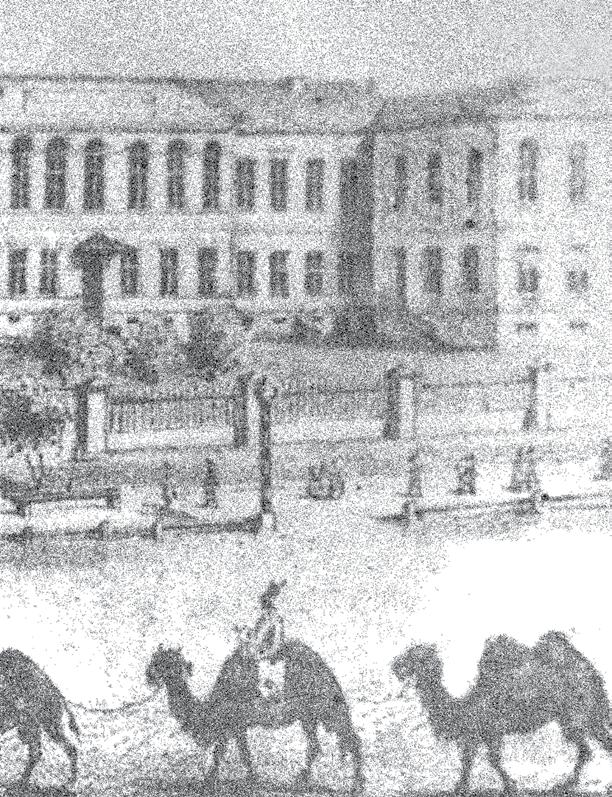
Sexedulebebisgan. sainteresoa, rom TanamedroveTa mxridan, baraTaSvilis „vergageba“ da „verdafaseba“, qarTvelT arxeinobas, daudevrobas Tu Surs miewereba xolme. aseve, xSirad mohyavT argumenti baraTaSvilis mier `drois gaswrebis~ Sesaxeb, rac am mosazrebis momxreTagan poetis talantis saTanadod `verdafasebis~ mizezad saxeldeba. SesaZloa `drois gaswrebis~ argumenti sainteresoc iyos, magram is an metaforad unda CavTvaloT _ SevecadoT siRrmiseulad avxsnaT, ras vgulisxmobT ama Tu im pirovnebis mier `drois gaswrebaSi~, andac Cveni azrovnebisTvis yovlad usargeblo informaciad miviRoT. magaliTad, xSirad gvesmis, rom nikoloz baraTaSvili TviTnabadi geniosi iyo da mis `amqveynad dabadebas~ arc socialuri da arc saazrovno winapiroba hqonia. marTlac, ucilobelia, rom baraTaSvili udidesi niWiT dajildoebuli poetia, magram mxolod am utyuari WeSmaritebiT, rTulia im mizezebis dadgena, Tu ris safuZvelze Camoyalibda misi msoflmxedveloba da azrovneba iseTad, ra saxiTac Cvenamde movida. baraTaSvilis poezia revoluciuri da zogadsakacobrio ideebiTaa savse da, rac mTavria, imdroindeli evropuli poeziis, azrovnebis Tanadroulia. sagulisxmoa, rom es ideebi ucxoa misi Tanamedrove sxva qarTveli poetebisTvis; Tanac, baraTaSvilis uSualo literaturuli winapris aRmoCena imdroindel an odnav ufro adreul qarTul poeziasa Tu prozaSi praqtikulad SeuZlebelia. im epoqaSi, yvelaze dasavlur yaidaze moleqse qarTveli poetebi _ aleqsandre WavWavaZe da grigol orbeliani (romlebic romantizmis (am wmindad evropuli movlenis) qarTuli skolis fuZemdeblebad iTvlebian), arsobrivad gansxvavdebian maTi formaluri memkvidre baraTaSvilisgan. amitom, albaT, sjobs davsvaT kiTxva _ vin SeiZleba yofiliyo is adamiani, romelsac SeeZlo amgvari ideebisTvis eziarebina igi? Sesabamisad Tu am kiTxvaze pasuxis gacemas movaxerxebT, imasac gavigebT Tu ratom daafasa nikoloz baraTaSvili samocianelTa `axalma Taobam~, ilia WavWavaZis TaosnobiT da ara misma Tanamedroveobam. Tu nikoloz baraTaSvilis biografias gadavxedavT, aRmovaCenT, rom erTaderTi visac SeeZlo igi „meranisa“ Tu „bedi qarTlisas“ zogadsakacobrio idealebisTvis eziarebina, solomon dodaSvili iyo. poetis saaxlobloSi ar iZebneba kaci, romelic solomon dodaSvilis darad, sicxadiT da siRrmiT gaacnobda evropuli ganmanaTleblobisa da germanuli idealizmis ideebs. roca solomoni Tbilisis klasikur gimnaziaSi aswavlida, moswavle da maswavlebeli imdenad daaxloebulan, rom `keTilismyofelebi~ nikolozs xSirad afrTxilebdnen _`dodaSvils Tavi daanebe, Torem gagTokaveno“.
When we talk about Georgian Enlightenment, in the first place, and rightfully so, we think of the Tergdaleulebi generation (literally, “Those who have drunk the water from the river Terek, this river being seen as a boundary between Georgia and Russia). Dimitri Kipiani, Ilia Chavchavadze, Iakob Gogebashvili, Vazha-Pshavela and others did a titanic job for the popularization and spreading of progressive ideas in Georgia. The reform of the Georgian language, their activities as publicists and literary figures, the efforts of the Society for the Spreading of Literacy among Georgians and the political activities of these individuals were inspired precisely by a spirit of enlightenment and freedom.
There is quite a widespread opinion stating that these ideas were absorbed by the Tergdaleulebi from Russian intellectuals; that if Russia hadn’t annexed Georgia, there wouldn’t have been any way for Georgia and Georgians to get closer to Europe – and this country would have remained captive of the eastern culture to this day. This opinion might be partly true, but if we want to get to the bottom of this subject, we should also inspect the portions of history that are less known to us, and that haven’t been fully researched by Georgian historiography.
As of today, Nikoloz Baratashvili remains one of the lesser studied figures of Georgian history. On what did he base his worldview, which was so cardinally different from that of other Georgian poets, and more generally, of the society of the time? Interestingly enough, the “misunderstanding” and the “underappreciation” of Baratashvili by his contemporaries is attributed to either the lightheartedness of Georgians, their negligence, or jealousy. They also often bring up the argument of Baratashvili being “ahead of his time”, which would be the reason why the poet’s talent couldn’t be properly acknowledged by his contemporaries according to the supporters of this idea. The “ahead of his time” argument could actually be an interesting one, but we should either see it as a metaphor and try to explain in depth what we mean by saying that someone is “ahead of his time”, or take it as a completely useless information for our inquiry.
For instance, there is a popular idea stating that Nikoloz Baratashvili was a born genius, and that his “coming to this world” didn’t have any social or intellectual preconditions. It is indeed undisputable that Baratashvili was a poet endowed with great talent, but with this sole hard truth, it is difficult to define the reasons behind the formation of his worldview and reasoning as they have reached us. Baratashvili’s poetry is full of revolutionary and universal ideas, and most importantly, it converges with the European poetry and thoughts of the time. It is worth noting that these ideas are not to be found in other Georgian poets from that period; moreover, it is practically impossible to find a literary antecedent to Baratashvili in the Georgian poetry or prose of the time, and even in the period directly preceding him. In that epoch, the Georgian poets who had the most western style were Aleksandre Chavchavadze and Grigol Orbeliani (who are considered to be the founders of romanticism, this purely European
mainc ra iyo dodaSvilis moZRvrebis Ziri, raze dafuZnda misi msoflmxedveloba?
Salva nucubiZis mosazrebiT, imanuel kantisa da iohan gotlib fixtes ideebi iyo is saazrovno sivrce, rasac daeyrdno solomon dodaSvili. misi filosofiurpolitikuri msoflmxedvelobisTvis ori mTavari wyaro arsebobda _kantis, germanuli ganmanaTleblobis mwvervalis, axali, wminda gonebis filosofia da fixtes moZRvreba qmedebis Sesaxeb, romlis mTavar Tezad ioanes saxarebis citatis originaluri perifrazi _ `pirvelad iyo saqme~ _ gvevlineba. fixte, aseve erT-erTi pirveli germaneli filosofosia, romelmac napoleonis germanuli laSqrobebisas, naSromiT „sityvebi germaneli eris mimarT“, xeli Seuwyo germanelebSi erovnuli suliskveTebis gaRviZebas. solomon dodaSvilis azrovneba erTis mxriv dafuZnebuli iyo ganmanaTleblobaze, meores mxriv ki erovnul suliskveTebaze. swored am ideebisadmi erTgulebam ganapiroba misi bedic... dodaSvili qarTuli filosofiis istoriaSi erTerTi yvelaze tragikuli figuraa `axali drois~1 gagebiT: napoleons erTxel goeTesTvis uTqvams _ `axali tragedia~ Zvelisgan imiT gansxvavdeba, rom Cvens warmodgenaSi bediswera aRar arsebobs da misi adgili politikas uWiravso. solomon dodaSvilis biografiac am WrilSi SeiZleba gaviazroT: rogorc pirovneba, romelsac ubedureba bedisweris ukuRmarTobiT ki ar daatyda Tavs, aramed politikuri Sexedulebebis, viTarebisa da movlenebis gamo. solomon dodaSvils, gansakuTrebuli niWis adamians, mravali Tanamemamulis msgavsad, SeeZlo ruseTis imperiaSi warmatebuli kariera hqonoda; Tumca, Zalian axalgazrdam, Segnebulad miiRo gadawyvetileba da 1832 wlis SeTqmulebis erT-erTi sulisCamdgmeli gaxda. mas swamda, rom saqarTvelos Tavisuflebisken svla da ganviTareba mxolod damoukideblobis aRdgenis Semdeg iyo SesaZlebeli.
1832 wlis SeTqmuleba iase falavandiSvilma gasca...
SeTqmulebis monawileTa umetesoba daapatimres da ruseTis sxvadasxva guberniaSi gadaasaxles. Tumca, SeTqmulTa absoluturma umravlesobam moaxerxa da male saqarTveloSi Sewyalebis `furcliT~ Camovida; paradoqsia, magram gadasaxlebisas, zogierTma karieruladac ki waiwia win _ aleqsandre WavWavaZe sulac Cinmomatebuli, epoletebiT Semkuli daubrunda samSoblos. erTaderTi, romlis Sewyalebac imperatorma ar ineba, solomon dodaSvili iyo. igi 1836 wels,
phenomenon, in Georgia), and they fundamentally differ from their “heir” Baratashvili. Therefore, it would perhaps be appropriate to ask the following question – who was the person who introduced him to these kinds of ideas? If we manage to answer this question, we will also understand why Baratashvili’s value was finally properly appreciated by the “new generation” of the 1860s, under the guidance of Ilia Chavchavadze, and not by his own contemporaries.
If we take a look at Nikoloz Baratashvili’s biography, we will discover that the only one who could have introduced him to the universal ideas found in 'Merani' or 'The Fate of Kartli' was Solomon Dodashvili. There was no other person in the poet’s close circle of acquaintances who could have familiarized him with the ideas of European enlightenment and German idealism with as much clarity and depth as he. When Solomon was teaching at the Tbilisi Classical Gymnasium, the pupil and the professor got so close that “goodwilled” people were often warning Nikoloz – “Stop frequenting Dodashvili, or they’ll arrest you”.
So what were the fundamentals of Dodashvili’s doctrine and on what did he base his worldview?
According to Shalva Nutsubidze, Solomon Dodashvili’s principles derived from the ideas of Immanuel Kant and Johann Gottlieb Fichte. There were thus two main sources to his philosophicpolitical worldview – Kant’s, the peak of German enlightenment’s, philosophy of pure reason, and Fichte’s doctrine about action, the main thesis of which can be considered to be his rewriting of the first words of John’s Gospel: “In the beginning was the action”. Fichte is also one of the first philosophers who contributed to the awakening of a feeling of national belonging among Germans, with his work “Addresses to the German Nation”, which was published during Napoleon’s German campaign. Solomon Dodashvili’s philosophy was founded, on the one hand on enlightenment, and on the other hand on a national feeling. And his destiny would actually be sealed by his faithfulness to these ideas…
Dodashvili is one of the most tragic figures in the history of Georgian philosophy from the modern era1: Napoleon is said to have told Goethe – “The “new tragedy” differs from the old in that there’s no fate in them anymore, it was replaced by politics.”
Solomon Dodashvili’s biography can also be seen from that perspective, as he is a person who wasn’t struck by disaster because of a twist of fate, but because of his political views, as well as the political situation and developments of the time.
Like many of his compatriots, Solomon Dodashvili, a person of unusual talent, could have had a successful career in the Russian empire; but when he was still in his youth, he deliberately took part in the 1832 conspiracy. He strongly believed that the development of Georgia and its progress towards freedom could only take place after the restoration of its independence.

1`axali dro~ _ igulisxmeba istoriis is periodi, romelsac mkvlevarebi Sua saukuneebsa da uaxles dros Soris aTavseben. `axli dro~ ukavSirdeba iseT istoriul da kulturul movlenebs, rogoric aris renesansi, reformacia, humanizmi, didi geografiuli aRmoCenebi da a.S.
1By the modern era, we mean the period of history that researchers put between the Middle Ages and the contemporary period. “New times” refers to historical and cultural periods such as the Renaissance, the Reformation, Humanism, important geographic discoveries, and so on.

rusul, miyruebul-gadakargul viatkaSi gardaicvala ocdaTerTmeti wlis... 1832 wlis SeTqmulebis monawileTagan mxolod mas hqonda gaTviTcnobierebuli damoukideblobis da Tavisuflebis idea, naTlad xedavda axali qarTuli Tavisufali saxelmwifos politikur da socialur konturebs... da swored amitom daisaja igi. gadasaxlebidan dabrunebis SemTxvevaSi is verafriT Caewereboda im absoluturi monarqiis suraTSi, romlisTvisac sxva SeTqmulebi zedgamoWrilni iyvnen. dodaSvili, monarqiisTvis socialuri warmomavlobiTac Seusabamo iyo. igi warmoSobiT glexi gaxldaT. misi mama ivane dodaSvili, daviT garejisa da bodbis samonastro skolaSi ganaTlebis miRebis Semdeg, sofel maRaroSi ganaweses mRvdlad, sadac aRizarda solomonic. amitomac _ Quod licet Iovi, non licet bovi (laT. rac epatieba iupiters, ar epatieba xars). miuxedavad imisa, rom solomon dodaSvilis filosofiuri memkvidreoba raodenobrivad mcirea, misi Rvawlis mxolod gamoqveynebul filosofiur nawarmoebebze dayvana arasworia. rogorc vaxtang orbeliani ambobs _ rom ara dodaSvili, arc nikoloz baraTaSvili iqneboda. amiT, arc mas, da arc Cven, baraTaSvilis, rogorc moazrovnis, mniSvnelobis daknineba srulebiTac ar gvinda, ubralod yvela mweralsa da poets aqvs sakuTari konteqsti, romlis gareSec is ver moaxerxebda imad qcevas, radac iqca. nikoloz baraTaSvilis `konteqsti~ misi maswavlebeli solomon dodaSvilia. gana SemTxveviTia baraTaSvilis striqonebi: „da gza uvali, Sengan Telili, merano Cemo, mainc darCeba...“ romelic, Tu davakvirdebiT, `ganmanaTleblurad~ JRers; aseve `bedi qarTlisaSic~ aSkarad igrZnoba dodaSvilis gavlena poetis monarqiisadmi skeptikur damokidebulebaSi _ „didixania guls iraklisa / gaduwyvetia bedi qarTlisa!“ es xom mefe erekles erTpirovnuli, guliswadilze dayrdnobili gadawyvetilebis kritikaa. statiis dasawyisSi mwerlis mier `drois gaswrebis~ SesaZleblobaze vsaubrobdiT; arc dodaSvils da arc baraTaSvils droisTvis ar gauswriaT, maT TavianTi xanmokle cxovrebis ganmavlobaSi (gansxvavebiT TanamedroveTagan, romlebmac moaxerxes da dros CamorCnen), SeZles da epoqis suli amoicnes. swored esaa mizezi imisa, rom baraTaSvili manamde ar dafasda saqarTveloSi, sanam Tanamedrove qarTuli saxelmwifos sulisCamdgmelma, ilia WavWavaZem ar wagvakiTxa igi.
levan SatberaSvili
The 1832 conspiracy was revealed to the authorities by Iase Palavandishvili…
They arrested most of the conspirators, and deported them to various Russian provinces. But the large majority of the conspirators somehow managed to soon return to Georgia with an amnesty document; it is quite paradoxical, but during their time in Russia, some even moved forward in their careers – Aleksandre Chavchavadze even returned with new epaulettes of a higher rank. The only one who was not amnestied by the Emperor was Solomon Dodashvili – he died in Russia in 1836, in the remote region of Vyatka... Among the conspirators, he was the only one who had truly comprehended the idea of independence and freedom, and who could clearly see the political and social contours of independent Georgia… And that is precisely why he was punished. If he had returned to Georgia after his deportation, he would never have been in line with absolute monarchy, which other conspirators suited perfectly. Dodashvili was also deemed inappropriate for the monarchy because of his social origins: he came from a peasant family. His father Ivane Dodashvili had received his education at the schools of the Davit Gareja and the Bodbe Monasteries, after which he was appointed as a priest in the village Magharo, where Solomon grew up. Quod licet Iovi, non licet bovi (Latin for “What is permissible for Jupiter is not permissible for cattle”).
Despite the fact that Solomon Dodashvili’s philosophical heritage is quite small, it would be wrong to measure his merits on his published philosophical works alone. As Vakhtang Orbeliani puts it – “Without Dodashvili, we wouldn’t have Baratashvili”. With this, we obviously don’t want to diminish Baratashvili’s importance as a thinker, but to underline that each writer and poet have their own background, without which they simply wouldn’t have been what they were. Nikoloz Baratashvili’s “background” is his teacher Solomon Dodashvili. These verses were not written by chance: “And the untrodden road, paved by you, my Merani, will remain...”. If we pay attention, it sounds quite “enlightenmental”. In ‘The Fate of Kartli’ too, we can clearly feel Dodashvili’s influence on the poet’s skeptical attitude towards the monarchy – “It’s been a long time since Erekle’s heart / decided of the fate of Kartli!” is obviously a critique of Erekle II’s unilateral, impetuous decision to ally with Russia.
At the beginning of this article, we talked about the possibility for a writer to be ahead of his time. Neither Dodashvili nor Baratashvili were ahead of their time; during their short lives (and unlike their contemporaries, who were actually lagging behind their time), they managed to capture the soul of their epoch. This is precisely the reason why Baratashvili wasn’t properly appreciated in Georgia until Ilia Chavchavadze, one of the figures behind the revival of the modern Georgian state, made us read the poet.
Levan Shatberashvili

90-ian wlebSi musikiT gaJRenTil erT patara oTaxSi movxvdi, sadac Seufereblad didi ferweruli tiloebi ekida. kedelTan ki magidaze, sabeWdi manqanis garSemo, uamravi wigni, firfita da kompaqtdiski elaga. yovelive es gafiqrebinebda, rom aq mwerali, musikosi an mxatvari cxovrobda; miTumetes, Tu im didi tiloebTan erTad, gansakuTrebuli StrixiT Sesrulebul grafikul Canaxatebsac mokravdiT Tvals. iyo sxva saxlic, sadac tradiciulad, wlebis ganmavlobaSi, didi musikaluri procesi mimdinareobda _ ori Taobis didi maestroebis xelSi qarTuli vokaluri skola iWedeboda. aq ki, Cemi didi survilis miuxedavad, verasdros movxvdi, magram am saxlisa da misi mkvidrebis Sesaxeb, pirvelxsenebuli saxlis patroni, mwerali da dramaturgi laSa buRaZe mogviTxorbs.
In the 1990s, I found myself in a small room drenched with music, where unfittingly large paintings adorned the walls. Near the latter, around the typewriter on the desk, there were numerous books, vinyls and compact discs. All this would make you think that you were in the home of an author, a musician, or a painter – especially if together with the large paintings, you noticed the particular strokes of the neighboring graphic sketches. There was also another house where traditionally, a great musical process was taking place for years – the Georgian vocal school was being established in the hands of great maestros of two generations. Despite my yearning, I didn’t get to visit that place, but the owner of the first house, writer and dramaturge Lasha Bugadze, will tell us about the second one and its inhabitants.
pirveli Sexeba musikasTan... saxlSi, albaT, mamaCemis wyalobiT da deidaCemisac. bavSvobisdroindeli mTavari Teatraluri da musikaluri STabeWdilebebi Tojinebis Teatrs ukavSirdeba, romelic deidaCemma skamisgan Seqmna fardiT, dekoraciiTa da im TojinebiT, romlebsac keravda. pirveli `dadgmebi~ saopero speqtaklebis fragmentebi iyo, magaliTad mocartis `jadosnuri fleitidan~, romelSic me mxolod mayurebeli viyavi. ase garTobiT Semovida musika da Teatri Cems cnobierebaSi. rogorc yvela melomans, mec Cemi musikaluri miTologia maqvs. am miTologiis erT-erTi nawili isaa, Tu rogor asmeninebda ocdaerTi wlis mamaCemi Cemze fexmZimed myof oci wlis dedaCems, mocartis 23-e safortepiano koncerts. cnobili idea, rom pozitiuri impulsebisTvis orsulma mocarts unda usminos, sabWouri 70-iani wlebis bolosac cnobili iyo, an sulac mamas intuiciam ukarnaxa. SeiZleba iTqvas, rom nayofad yofnis droidan damyva klasikuri musikis siyvaruli. Semdeg ukve, rac CemTvis samwuxaroa, da meores mxriv SeiZleba piriqiT, raRacas gadavurCi kidec _ musika profesiulad arasdros miswavlia da yovelTvis diletanturi, magram `cocxali~ damokidebuleba mqonda. marTlac, ar maxsovs dro, roca CvenTan saxlSi musika ar JRerda. mamaCemi xatavda da Tan firsakravic wripinebda. umeteswilad es iyo klasika, Tumca mas CemsaviT gansazRvruli Janruli CarCo ara aqvs da sxvadasxva musikas usmens, gansakuTrebiT germanuls _ vagners, malers, rixard Strauss... da aseve roks. maxsovs, eqvsi-Svidi wlis asakSi Cemi mSoblebis megobris, jarji balanCivaZis saxlSi `jadosnuri fleitiT~ miRebuli udidesi STabeWdileba, mamam mas am speqtaklis foni dauxata. mere iyo `legenda qiramis da solomonis Sesaxeb~, aseve maxsovs TumaniSvilebis saswauli, cnobili Tojinebis `Teatri~ qiaCelze. Tan saxlSi xom deidaCemis skami-Teatric gvqonda, Zalian patara, magram Zalian sayvareli da originaluri. samwuxarod, dRes aRarc is saxlia da aRarc is skami, Tumca deidaCemi dResac qmnis dro da dro Tojinebs.
Could you tell us about your first encounter with music?
It was probably at home, thanks to my father and mother. My most significant childhood memories about theater and music are related to the puppet theater that my aunt created with a chair and a curtain, some small decorations, and puppets she was crafting herself. The first “stagings” were fragments of operas, for instance Mozart’s ‘The Magic Flute’, in which I was only a spectator. This is how music and theater entered my consciousness, with entertainment.
Like every music lover, I have my own music mythology. One of the parts of this mythology is how my 21-year-old father was making my 20-year-old mother, who was carrying me in her womb, listen to Mozart’s Piano Concerto No 23. The idea that a pregnant woman should listen to Mozart for positive impulses was also popular in the late Soviet 1970s, but it could also simply have been my father’s intuition. One could say that my fondness for classical music has followed me from the womb.
As for my later musical development, I sometimes regret it, though it also has positive aspects to it: I have never learned music professionally, and therefore, I always had a dilettantish, though “natural” approach. I don’t remember one instance when music couldn’t be heard at our home. The turntable was always squeaking when my father was painting. It was mainly classical music, but he didn’t have a determined frame of genres like myself, so he listens to various music, especially to Germans – Wagner, Mahler, Richard Strauss… and to rock.
I remember my amazement at ‘The Magic Flute’ I saw at my parents’ friend’s, Jarji Balanchivadze’s place, when I was six or seven years old; my father had painted the background for this performance. Afterwards, there was ‘The Legend of Hiram and Solomon’; I also remember the Tumanishvilis’ wonderful and popular Puppet Theater on Kiacheli Street. And at home, we had my aunt’s chair-theater, a very small, but lovely and original one. Unfortunately, today, neither the house nor the chair exist anymore, even though my aunt still creates puppets from time to time.
Have you never tried to stage a play yourself?
In the trees of the yard on Chavchavadze Street #51, together with my neighbor kids, I staged no more, no less than ‘Faust’; to be more exact, we said that it was Goethe’s ‘Faust’, but in reality, it was
TviTon ar gicdia dadgma?
WavWavaZis 51-is ezoSi, avtofarexebis ukan, xeebSi, mezobel bavSvebTan erTad, arc meti, arc naklebi goeTes `fausti~ davdgi, ufro sworad davarqviT, rom goeTes `faustia~, sinamdvileSi ki es iyo Tqmulebebi faustze. me mefistofels vTamaSobdi da mecva fraki, mgoni es roli ufro am frakis xaTriT avirCie, radgan maSin diriJoroba mindoda, an pianistoba, an momRerloba. am `dadgmis~ Canaweric ki arsebobs _ vmReri Cems mogonil serenadas greTxenisTvis.
ZiriTadad gogonebi vaTamaSe da mxolod erTi biWi; sxvebs, albaT, eTakilebodaT, iseT asakSi viyaviT. Tumca, patara ezo iyo, bevri biWi arc gvyavda. vinc viyaviT, isini gaverTeT, magram mainc seriozuli raRac gamovida, gind ase Tqvi, gind ise _ `fausti~ iyo.
im dros ukve kiTxulobdi? kiTxva mezareboda. TerTmeti wlisas sizarmacis periodi mqonda, ubralod xalxs Tavs ise vaCvenebdi, TiTqos vkiTxulobdi, sinamdvileSi ufro vismendi da advilad viWerdi ambebs. rasakvirvelia iyo germanuli skolis gavlenac, sadac gviyvebodnen Tqmulebebs faustze, nibelungebze da a.S.
Tumca, Sen operiT daiwye... opera SemoiWra konkretuli faqtiT, principSi Zalian banaluri epizodis gavleniT. 1990 wels `karakalas TermebSi~ gamosuli sami tenoriT movinusxe _ italiaSi fexburTSi msoflio Cempionatisas luCano pavarotim, plasido domingom da xose karerasma zubin metasTan erTad gamarTes es cnobili koncerti. maxsovs CvenTan Semosuli mezoblis replika: `fexburTi mindoda da es ra daiwyo?~. ra daiwyo ki ara, es daiwyo Tu daiwyo _ gavogndi, gamovSterdi, ufro metad pavarotize. sami momRerlis yureba, CemTvis sul sxva aRmoCena, brwyinvaleba iyo _ momRerali adamiani _ rogorc individualoba, homo cantor momewona. amis Semdeg momRerloba mominda da daviwye `pavarotobanas~ TamaSi TiTebze moxveuli TeTri cxvirsaxociT. mogvianebiT, radgan karikaturebs vxatavdi, axalgazrda mxatvrebTan erTad kopenhagenSi aRmovCndi, sadac firfitebis maRaziaSi SokSi Cavvardi; iqve vnaxe sami tenoris koncertis firfitac _ pirveli, romelic cxovrebaSi viyide da Camovitane. karga xans vusmendi da axla vbrazob, sad da rogor davkarge, roca vinilis firfitebis epoqa brundeba. Semdgom, roca `agresiuli koleqcioneri~ gavxdi, mSral xidTan xalxma firfitebis gamotana daiwyo da isev da isev mama, Tuki raRac fuls momcemda, vyidulobdi. zustad maxsovs, pirvelad mocartis `ase iqceva yvela~ da misive koncerti fleitisTvis SeviZine, aseve etore bastianinis `rigoleto~.
a composition of stories about Faust. I was playing Mephistopheles, and I was wearing a tailcoat. I think I chose that role because of the tailcoat, as at that time, I wanted to be a conductor, a pianist, or an opera singer. There’s even a video of this “staging” – I am singing a serenade of my invention to Gretchen. The actors were mainly girls, and there was only one boy apart from me. Others were probably embarrassed to act, we were in that age… Also, it was a small yard, and there weren’t many boys living there. We gathered and had a lot of fun, but it resulted in something serious – you can turn it in every way, it was still ‘Faust’.
Were you already reading at that time?
I was too lazy to read. I was very lazy when I was 11 years old, but I was presenting myself as someone who reads a lot, while in reality, I was more of a listener, and I was easily “catching” stories. Naturally, there was also the influence of my German school, where they were telling us stories about ‘Faust’, the Nibelungs, and so on.
But you started with opera…
Opera entered my life on one specific occasion, through a very banal episode, actually. In 1990, I was mesmerized by the performance of three tenors at the Baths of Caracalla in Italy, when Luciano Pavarotti, Placido Domingo and Jose Carreras performed their famous concert with conductor Zubin Mehta for the FIFA World Cup. I remember a comment by a visiting neighbor: “I wanted to see football, what’s this?”. To me “this” was something special – I was hypnotized, especially by Pavarotti. Looking at three singers was a brilliant discovery for me – I became fond of the singing human –homo cantor. After that, I wanted to start singing, so I started “playing Pavarotti”, with a white handkerchief around my fingers. Later, when I was drawing caricatures, I got to travel to Copenhagen, where I was flabbergasted in a vinyl shop: there was the vinyl of the three tenors’ concert – the first one that I bought in my life. I brought it home and listened to it for quite a while, and now that the vinyl is becoming popular again, I am very angry at myself for losing it. Afterwards, when I became an “aggressive collector”, people started bringing vinyls on the Dry Bridge, and when my father gave me money, I would always go and buy some. I remember very well that the first ones I bought there were Mozart’s ‘Così fan tutte’ and his Flute Concerto, as well as Ettore Bastianini’s ‘Rigoletto’.
Did you go to the Opera?
I couldn’t say that when I was going there, I was returning home with great impressions. I started going to the Opera in the 1990s, when everything was crumbling down and there was complete chaos. One evening particularly stuck to my memory – I saw ‘Rigoletto’ together with my grandmother, and when we got outside, on the darkened Rustaveli Avenue, there were autumn leaves on the ground, and a grim atmosphere. One month later, a civil war erupted in Tbilisi.
operaSi Tu dadiodi?
davdiodi da ver vityvi, rom didi STabeWdilebiT vbrundebodi. 90-iani wlebidan daviwye, maincdamainc maSin, roca yvelaferi daiqca da sruli qaosi iyo. erTi saRamo gansakuTrebiT damamaxsovrda, `rigoleto~ movismine, bebiaCemTan erTad viyavi da gareT rom gamovediT, Cabnelebul rusTavelze, gviani Semodgomis foTlebi eyara da pirquSi atmosfero idga. erT TveSi Tbilisis omic daiwyo.
Semdeg gaicani nodar andRulaZe... diax, is iyo yvelaze didi da waruSleli STabeWdileba. Cemi azriT, nodar andRulaZe udidesi movlenaa qarTul kulturaSi, erTgvari akademia, renesansuli figura, radgan es adamiani ar iyo mxolod momRerali, is iyo universaluri pedagogi, moazrovne, mkvlevari. vokali misi kvlevis iaraRi iyo da ara mxolod xmis, aramed zogadad adamianisac. adamians da samyaros ikvlevda vokalis teqnologiis meSveobiT. masTan urTierToba sruliad unikaluri gamocdileba aRmoCnda. Cveni gacnoba SemTxveviT moxda, mamaCemTan stumrad iyo mosuli nodaris mowafe da Svilobili guri zaqareiSvili da radgan sul vmRerodi an vbRaodi xolme, albaT maSinac raRac wavimRere; an ufro sworad, mamaCemma uTxra mgoni xma aqvs da iqneb nodars movasmeninoTo. TxuTmeti Tu Teqvsmeti wlis viqnebodi masTan rom mimiyvanes. raRac gavimRere, nodarma momismina da Tqva, rom principSi SeiZleboda tenori gavmxdariyavi. iq iseT samyaroSi aRmovCndi, romelic Zalian miyvarda _ musika, firfitebi, wignebi, Tavad nodari, romelic cocxali istoria iyo, Zalian axalgazrduli, dakvrivebuli, Wkviani, iumoriT aRsavse da Tbili. ramdenime gakveTilic Camitara da gulwrfelad rom vTqva, arc maxsovs rodis gadavinacvle momRerali mowafis statusidan msmenelmegobari mowafis mdgomareobaSi. raRac momentidan simRera Sevwyvite _ mivxvdi, rom realurad Zalian ki miyvarda simRera, magram mecadineoba ar gamomdioda, ar mominda, iq ufro wignebis Tvaliereba mainteresebda an sxvadasxva ambebis mosmena. rogorc Cans, mainc ar vfiqrobdi rom momRerloba Cemi profesia unda yofiliyo, ufro reJisura mainteresebda da raRaceebs ukve vwerdi kidec. amas nodaric mixvda. axla ar vici, zogjer vnanob, SeiZleba vokalizebiT varjiSi, anu rutina damezara, an sakmarisad ver gaverTe, an sulac SeiZleba zogierTi momRerali mebanalura da ar mominda aseTi gamovsuliyavi. maSin xom pirvelad Sevxvdi realur momRerlebs, romlebic Cems mier warmosaxulebs ar hgavdnen. sul sxva iyo nodar andRulaZe, ufro meti vidre momRerali. did momRerlebs Sorisac iSviaTad SeiZleba Segvxvdes iseTi inteleqtuali, romelsac
Then you met Nodar Andghuladze…
Yes, and he had a great and everlasting influence on me. In my opinion, Nodar Andghuladze is a great figure of Georgian culture, he is a whole academy all by himself, a renaissance man, as he was not only a singer, but a universal teacher, a thinker, and a researcher. Vocals were his research tool, not only to study people’s voices, but also humans themselves. He was studying humans and the world through vocal technique.
Interacting with him turned out to be a unique experience. Our encounter took place by coincidence; Nodar’s student and stepson Guri Zakareishvili was visiting my father, and because I was always singing and bleating around, I guess I must have sung something then too; my father told him that he thought I had a good voice, and asked if we could make Nodar listen to my singing. I was about 15 or 16 years old when they brought me to him. I sang something, Nodar listened, and he said that I could, in principle, become a tenor. I found myself in a world that I loved – music, vinyls, books, Nodar himself, who was a living legend – a very youthful, attentive, smart, and warm person full of humor. He gave me a few lessons, and to be honest, I don’t even remember when I switched from the position of a singing student to that of a listener and friend. At some point, I stopped singing – I understood that I really loved singing, but that I was not good at studying; I didn’t feel like it, I preferred reading books or listening to this or that story when I was there. It seems that I didn’t think that singing could have become my profession, I was more interested in becoming a director, and I was already writing some things. Right now, I don’t know, sometimes I regret it, perhaps I was too lazy for the routine of training in vocalises, or I wasn’t entertained enough, or maybe I considered some singers to be too ordinary, and I didn’t want to become like them. You know, it was the first time that I met with real singers, and they didn’t look like I had imagined them. Nodar Andghuladze was completely different, he was much more than a singer. Even among great singers, it is rare to find such an intellectual, who understands and can explain music to you with his own singing. Singers’ intellect should be perceivable in their voice, and Nodar was always trying to achieve this.
We used to gather in his house, which was a real treat for a music lover like me – we didn’t have electricity and it was cold, so we were wrapped in coats and scarfs, but I was witnessing a wonderful, live creative process. I remember how Lado Ataneli was preparing ‘Tosca’, how they were arranging Scarpia’s part by the candlelight. I was also taking part in the process, and was watching, captivated, how a role was being created – and by a great singer, Lado, who was in perfect shape at that time. This turned out to be very interesting for me also from an artistic point of view, as Nodar was underlining artistic aspects – I could at least understand that; many things regarding vocal technique were new to me, but I understood how a character was created, what is voice, intonation, which color should appear where and how in the latter, be it for Scarpia or Philippe II in ‘Don Carlos’, or any other role.
Tavadac esmis da Tavisive simReriT gixsnis musikas. momRerlis inteleqti xmaSi unda Candes da nodaric yovelTvis swored amas eZebda.
masTan saxlSi vikribebodiT, Cemnairi melomanisTvis es didi saCuqari iyo _ uSuqod gvcioda, qurTukebSi da kaSneebSi viyaviT SefuTnulebi, magram ucnaurad cocxali SemoqmedebiT process veswrebodi. maxsovs lado aTaneli rogor amzadebda `toskas~, rogor amuSavebdnen skarpias partias sanTlis Suqze. mec Sevexe amas da xeldasxmuliviT vuyurebdi rogor ibadeboda gmiri, Tan karg momReralTan _ lado, romelic maSin genialur formaSi iyo. es yovelive CemTvis mxatvruli
TvalsazrisiTac aRmoCnda saintereso da nodaric aqcents swored mxatvrul elementze akeTebda, yovel SemTxvevaSi, me es mesmoda _ vokaluri teqnologiebis
TvalsazrisiT bevri ram CemTvis ucxo iyo. magram mivxvdi, rogor iqmneba personaJi, ra aris xma, intonacia, sad rogori feri unda gamoCndes masSi, iqneba es skarpia Tu filipe `don karlosSi~, ar vici, romeli erTi CamovTvalo.
garda amisa iyo koncertebi, romlebsac veswrebodiT. amas Zalian didi azarti sdevda da kargi xmebi ismoda. ar maxsovs maSin operaSi rame gansakuTrebiT saintereso momesminos. saerTodac, sul megona, rom verasodes movusmendi scenaze cocxlad xmas, romelzec ar iZabebi da cudad ar xdebi, an Tundac orkestrs, romelic ar gtanjavs. is, rac maSin xdeboda, mZime STabeWdilebas tovebda, Tu vinme konkretuli kargi momRerali ar mReroda.
nodaris wris Sesaxeb?
aucileblad unda vaxseno gogi niJaraZe, romelic nodaris irgvliv Semokrebili melomanebis erTgvari klubis erTmniSvnelovani lideri da Zalian mimzidveli pirovneba iyo. maTematikosi, klasikuri musikis, operisa da maria kalasis didi moyvaruli. CemTvis dauviwyaria nodarisa da gogis erToblivi musikaluri leqciebi, magaliTad kalasze; gogis mohqonda Canawerebi, mas firfitebis da diskebis didi koleqcia hqonda da vusmendiT, pauzebisas gviyveboda ambavs, nodari ki gvixsnida simReras teqnologiuri TvalsazrisiT. SeiZleboda nodars iqve mcire masterklasic Caetarebina Tavis studentTan erTad, raTa vokalis teqnologia TvalsaCino gamxdariyo diletantisTvis. mas hqonda sruliad unikaluri leqcia karuzos karikaturuli avtoportretebis mixedviT karuzosave simReris teqnikis Sesaxeb.
am Sexvedrebs Soris iyo naklebad salonuri yofiTi Sexvedrebic. magaliTad, yvelieri gogi niJaraZesTan _ iSleboda mSvenieri msuye sufra narCevi melomanebisTvis da hedonistebisTvis, msunagi xalxisTvis. sadac
Apart from that, we attended some concerts. We were very excited about this, and we listened to some good voices. I don’t remember listening to anything particularly interesting at the Opera back then. And I thought that I would never be able to listen to a live voice on stage without getting tense and feeling unwell, or even to an orchestra that didn’t strain me. Except for when specific good singers were performing, what was happening in the field of opera at that time was quite irritating.
Can you tell us more about Nodar’s circle?
I definitely need to mention Gogi Nizharadze, who was the undeniable leader of the sort of club of “select” music lovers that used to gather around Nodar; he was an utterly charming person. He was a mathematician fond of classical music, opera, and Maria Callas. I will never forget Nodar and Gogi’s joint music lessons, for instance about Callas; Gogi, who had a large collection of vinyls and discs, would bring recordings, and we would listen to them. During pauses, he would tell us stories, while Nodar was explaining her singing from a technical point of view. Nodar would sometimes incorporate a small masterclass with one of his students, for the vocal technique to become clearer for amateurs. He also held a unique lesson about the technique used by Caruso according to the tenor’s caricatural self-portraits.
Among these meetings, there were also some of a less “salon” essence. For instance, during the “Butter Week” (the last week before the Great Fast), a wonderful table was laid at Gogi Nizharadze’s house for glutton music lovers and hedonists. Where there is Italian opera, there is also good cuisine. For instance, on the birthday of Maria Callas, we were listening to her and enjoying delicious dishes. Mrs. Mediko, Gogi’s wife, was baking the best khachapuris (cheese-filled bread) for us, but Mr. Gogi would wink at us, joking that his mother baked even better ones. Back then, there would be electricity cuts from time to time; the generator rumbled, and our host got angry, because it was messing up his music listening schedule. His writing desk was also noteworthy, and always displayed several new discs. The era of discs passed in Georgia without a disc shop being opened. We were exchanging them between us, but I didn’t have many at that time; Gogi and Nodar would sometimes hand discs to me as presents, and I would go home in a cheerful mood. Sometimes, I would go through Gogi’s disks with such excitement, that I would completely forget about everything around me. What I want to say with all this is that our subjects of attention were not connected with the reality at hand around us; but we thought of them as very topical, even though it could have been related to the 1850s, for instance to Verdi or Giuseppina Strepponi – as if these stories were happening during our time. Naturally, Gogi and Nodar weren’t interesting to everybody, and to be honest, many people weren’t interested at all in such details of music culture. Some simply had a good voice, and their fate changed because of it. Some of them shocked me, for instance when between lessons, I would see a singer listen to Presnyakov – a singer preparing Philippe II’s part was actually fond
italiuri operaa, iq samzareulocaa. vTqvaT kalasis dabadebis dRes, vusmendiT mas da mSvenier yveleuls mivirTmevdiT. qalbatoni mediko, gogis meuRle, unikalur xaWapurebs gvicxobda, magram batoni gogi Tvals Cagvikravda da gvetyoda, dedaCems mainc ukeTesi gamosdiso; am dros, xandaxan Suqi qreboda, generatori gruxunebda, maspinZeli brazobda, imitom rom reJimidan vardeboda (mas musikis mosmenis garkveuli ganrigi hqonda). mimzidveli iyo misi saweri magidac, romelzec yovelTvis ido ramdenime axali diski. CvenTan xom ise gaiara diskebis epoqam, rom maRaziac ki ar gaxsnila. vcvlidiT xolme, Tumca maSin bevri araferi mqonda; gogis da nodars uCuqebiaT kidec da saxlSi bednieri davbrunebulvar. xandaxan ise viqeqebodi gogis diskebSi, rom zrdilobis farglebi maviwydeboda. mokled, imis Tqma minda, rom Cveni Temebi arsebul realobasTan ar iyo dakavSirebuli; Tumca Cven isini Zalian aqtualurad migvaCnda, miuxedavad imisa, rom SeiZleba me-19 saukunis 50-ian wlebTan dakavSirebuli yofiliyo yovelgvari poziorobis gareSe, magaliTad verdisTan an juzepina streponisTan, TiTqos es ambebi Cven dros xdeboda. cxadia, gogi da nodari yvelasTvis ar saubrobdnen, gulwrfelad rom vTqva, bevrs arc ainteresebda musikaluri kulturis aseTi detalebi da siRrme. ubralod, adamians aRmoaCndeboda xma da bedi ecvleboda. zogierTi maTgani SokSic magdebda, roca arc meti arc naklebi, vokalis gakveTilebs Soris magnitofonSi vinme presniakovs usmenda _ momRerali, romelic filipes partias amuSavebda, Turme, sinamdvileSi, rusul estradas etrfoda. maSin mivxvdi, rom `presniakovi~ sadRac momavalSi aucileblad vlindeba.
didi iyo es rCeuli auditoria? sakmaod mcirericxovani. iyvnen iseTebi, vinc SeiZleba musikosi arc yofiliyo, Tumca melomani; an nodaris intuiciuri mowafe, romelic aRar apirebda simReras, magram nodar andRulaZis figura da aura, misTvis mimzidvelobas ar kargavda. klasikuri musikis siyvaruliT gaerTianebuli adamianebi erTad vusmendiT da vuyurebdiT vidoeCanawerebsac _ maxsovs, erTerTi didi STabeWdileba Jan pier ponelis dadgmulma rosinis `konkiam~ moaxdina. principSi es ar iyo da verc iqneboda didi wre, imitom rom nodari Zalian frTxilad giziarebda codnas da gamowmebda ramdenad Rrmad SegeZlo yovelives gaazreba. magram meCveneboda rom is mainc sul marto iyo _ Tavis wignebTan da uamrav CanawerebTan erTad. misi umdidresi biblioTekis yovel wignSi poulobdi saniSnes, Cadebul furcels, minawers; da bevri ver mihyveboda da esaubreboda mas nicSeze, Sopenhauerze an haidegerze... mec patara viyavi da
of Russian pop music. There, I understood that he would, himself, most probably also become a “Presnyakov” in the future.
Was this “select” audience a large one?
No, it was quite small. Some were not even musicians, but all were music lovers; or a student chosen bu Nodar who had decided not to sing anymore, but who was still fascinated with Nodar Andghuladze and his aura. We were people gathered by their love of classical music, and we listened to records and watched videos together – I remember that Jean-Pierre Ponnelle’s staging of Rossini’s ‘Cinderella’ had a great impact on me. It wasn’t – and actually couldn’t have been – a large circle, because Nodar was very cautious when sharing his knowledge, and he was verifying the degree of depth to which you could understand it. But I still had the impression that he was always alone – with his numerous books and recordings. You could find bookmarks in each of the books of his rich library, as well as notes made on papers and on the pages themselves; not many could follow him and discuss Nietzsche, Schopenhauer or Heidegger with him… I myself was young, so I didn’t have that much to talk about, and I was sensing that he was a very deep, open-minded man. But there were also cases when we had interesting dialogues.
Did he tell you about his studies in Italy?
It was a very important stage of his life. He would often mention his experience at ‘La Scala’. The 1960s were the golden age of this theater. Nodar would often remember the premiere of Meyerbeer’s ‘Les Huguenots’ with Franco Corelli, Giulietta Simionato, and Nicolai Ghiaurov. After a triumphant opera performance, Italian flags were flying in the hall.
But Gianni Raimondi’s voice and technique turned out to be his best match, and therefore, he chose Gennaro Barra as a tutor. Moreover, he thought that in this way, he would follow the footsteps of his father Davit Andghuladze… It was the period when he was establishing his own style, and he believed that he was the one who had to continue his father’s tradition in order to transmit this great knowledge and experience to his students. And he probably succeeded in that. His approach – which gradually became a hybrid of the methodologies used by Davit and those of the Italian school – was that both methodologies had the same origins, were telling the same story, and were following the same principles. Davit was also coming from the Italian school, and that’s precisely the reason why Nodar got interested by Gennaro Barra, who was a student of Fernando De Lucia, a great figure of Neapolitan bel canto… He saw similarities between their vocal techniques, and to some degree, in their voice timbre.
Whom did he like among the tenors of his generation?
Alfredo Kraus, and he was even agreeing, to some extent and with some irony, to the criticism of Kraus towards the concert of the three tenors I previously mentioned. Kraus believed that he was either the best, or one of the best. But Nodar was also paying tribute to Pavarotti and Domingo. He agreed to the general opinion that Pavarotti had
raze unda melaparaka, Tan aSkarad vxvdebodi rom es kaci Zalian Rrma, farToa. magram yofila SemTxvevebi, rodesac Cven Soris saintereso dialogic gamarTula.
giyvebodaT italiaSi swavlis periodze? es Zalian mniSvnelovani etapi iyo mis cxovrebaSi. xSirad ubrundeboda `la skalaSi~ staJirebis periods. XX saukunis 60-iani wlebi am TeatrisTvis `oqros xanaa~. nodari xSirad ixsenebda meierberis `hugenotebis~ premieras franko korelis, julieta simionatos da nikolai giaurovis monawileobiT. triumfaluri speqtaklis Semdeg darbazSi italiis droSebi afrialebula.
magram, misTvis yvelaze axlos jani raimondis xma da teqnika aRmoCnda da amitom pedagogad misi maswavlebeli jenaro bara arCia. amasTanave, hqonda gancda da Tvlida rom mamis, daviT andRulaZis gzas agrZelebda... es miseuli skolis Camoyalibebis periodi iyo da Tvlida, rom mamiseuli tradicia axla mas unda ganegrZo da es udidesi codna da gamocdileba mis mowafeebs gadascemodaT. albaT, garkveuli formiT gadaecaT kidec. misi skolac _ daviTis da Semdeg italiuri skolis erTgvari hibridi aRmoCnda _ ambobda, rom es erTi sawyisi, erTi ambavi, erTi xazia; daviTic italiuri skolidan modioda da nodaric swored imitom daainteresa jenaro baram, romelic neapoluri belkantos udidesi warmomadgenlis, fernando de luCias mowafe iyo... da maT Soris msgavseba dainaxa vokaluri teqnikis da SeiZleba iTqvas, raRac kuxTiT, tembraluri TvalsazrisiTac.
Tavisi Taobis tenorebSi vin moswonda? alfredo krausi da swored sami tenoris koncertze, romelic vaxsene da romelmac momnusxa, krausis kritikas da sibrazes, ironiiT, magram eTanxmeboda. krausi Tvlida rom igi erTaderTi Tu ara, erT-erTi saukeTeso iyo. magram nodari afasebda pavarotis da domingosac. rogorc zogadad miiCneoda, isic fiqrobda rom pavarotis yvelaferi hqonda lamazi xmis garda. es CemTvis didi aRmoCena iyo. aseTi frazac maxsovs, ara nodarisgan, radgan mas radikaluri Sefasebebi ar sCveoda, magram im adamianisigan, vinc nodars usmenda: ra samwuxaroa, ra kargad mReris da neta pavarotisac lamazi xma hqonodao. domingoze ambobda, rom aseTi mwyobri vokalis mqone tenori da simReris aseTi gaazreba, Zalian iSviaTiao. nodari Sefasebebs, cxadia, mxolod cocxal Sesrulebaze akeTebda da yovelTvis am Sesrulebis mixedviT msjelobda. erTi siamovneba iyo misi Sefasebebis mosmena, magaliTad, juzepe di stefanos problemebis Sesaxeb. misi `modeli~ cxadia karuzo iyo, krausi da raimondi _ romelic ukve misi vokaluri bedis nawili gamxdariyo.
everything except for a beautiful voice. This was a real discovery for me. I even remember that I once heard the following words, not from Nodar, though, as he wasn’t characterized by radical assessments, but from someone who was listening to Nodar: “It’s such a shame, he sings so well; if only Pavarotti too had a beautiful voice like that.” About Domingo, he would say that tenors with such orderly vocals and such awareness of songs were very rare. It goes without saying that Nodar would only evaluate live performances. We took great pleasure in listening to his reviews, for instance about Giuseppe Di Stefano’s problems. Naturally, his “models” were Caruso, Kraus, and Raimondi –and the latter had already become part of his own vocal development.
Did he talk about his own singing?
He would talk about his decision to move from linguistics to vocals – he didn’t want to at first, but his natural abilities and the environment “forced” him to become a singer. This was probably his interpretation that his father’s work as a thinker, and not only as a singer, should also have been continued. You could feel that Nodar didn’t want the Georgian tradition of Italian bel canto, whose preserver was his father, who himself transmitted it to Nodar, to end with Davit Andghuladze. Despite the fact that he also considered Arnold Chikobava to be his intellectual father, the continuation of this vocal tradition turned out more important – perhaps his father also encouraged him to choose this path. He was always underlining the concept of continuation, be it when his stepson Guri would help him up the stairs in his old days just like he himself used to help his father. He would sometimes say: “Now, I am like my father, and Guri puts his hand on my back to help me walk up the stairs.” And apart from these details, he referred to elements of global importance concerning the perpetuity of tradition. He had a great sense of humor and valued humor in general, he was self-deprecatory and very aware of human foolishness. The lack of sense found in singers couldn’t surprise him anymore, but he was still observing this or that “wisdom” of theirs with a watchful eye. In general, this is a field in which talent intersects with some kind of infantilism or childishness, and therefore with some stupidity, which made Nodar see singers as children; sometimes, this was so obvious that he had to teach them elementary things, even, for instance, how to use a fork and a knife. He also liked how I used to draw caricatures of singers and of all kinds of people who were visiting him. Guri has so many of these caricatures that he is even thinking of publishing them in an album.
Was he in a constant learning process?
He was always reading, quoting, writing; he was always reexamining his inner intellectual processes. He was analyzing the critique of contemporary music, and he was especially fond of Italian critic Rodolfo Celletti and his radical views; he also liked and would smile at Giacomo Lauri-Volpi’s book ‘Parallel Voices’, because he knew the psychology of singers very well himself. I remember the opinions he shared with us when we asked him about Rubini or Duprez, for whom Rossini, Bellini and Donizetti had written astonishing parts.
sakuTar simReraze Tu saubrobda? saubrobda im gadawyvetilebaze, ratom gadavida enaTmecnierebidan vokalze _ ar undoda, magram bunebrivma monacemebma da garemom `aiZula~ momRerali gamxdariyo. es albaT ufro imis gaazreba iyo, rom mamis saqme gagrZelebuliyo, ara rogorc momRerlis, aramed rogorc moazrovnis. igrZnoboda, rom nodars ar undoda daviT andRulaZesTan erTad dasrulebuliyo tendenicia italiur belkantos qarTuli tradicisaa, romlis faqtobrivi Semnaxveli, mcveli iyo daviTi da romelic misgan nodarma gadmoibara. miuxedavad imisa, rom arnold Ciqobavas aseve Tavis inteleqtualur mamad miiCnevda, vokaluri tradiciis uwyvetoba ufro mniSvnelovani aRmoCnda, SesaZloa mamamac ubiZga. yovelTvis esmeboda xazi mamis modelis ara gameorebas, aramed replikas, Tundac imas, Tu rogor ahyavda kibeze ukve xandazmulobaSi guris ise, rogorc mas Tavad ahyavda mama. ambobda xolme, axla me var mamaCemiviT da guri madebs xels zurgze, rom damexmaros kibeze asvlaSi. aseTi detalebiT dawyebuli, dasrulebuli Zalian globalur-mniSvnelovani elementebiT tradiciis uwyvetobis Sesaxeb. iumori hqonda da afasebda iumors, TviTironiuli iyo da kargi damkvirvebeli adamianuri sisuleleebis. momRerlebis sisuleleebi aRar akvirvebda, magram jerac akvirdeboda maT ama Tu im `sibrZneebs~, rogor aRiqvamdnen movlenebs. saerTod, es aris samyaro, sadac niWiereba gadakveTilia raRacnair infantilurobasTan, bavSvurobasTan da amdenad garkveul sisulelebTanac da nodarisTvis momRerlebi iyvnen bavSvebi da es zogjer imdenad aSkara iyo, rom ubralod elementaruli raRaceebis swavlebac uxdeboda, dana-Canglis xmarebis donezec ki. mowonda isic, rogor vxatavdi xolme momRerlebis da masTan mimsvlel-momsvleli aTasnairi adamianis karikaturas, romelic guris imdeni daugrovda, rom maT albomad gamocemasac ki fiqrobs.
mudmivad Semecnebis procesSi iyo? sul kiTxulobda, citirebda, werda, mudmivad iyo inteleqtualuri procesis Sinagan gadasinjvaSi. akvirdeboda Tanadroul musikalur kritikas, gansakuTrebiT uyvarda italieli kritikosi, rodolfo Celeti da miseuli radikaluri azrebi; Zalian moswonda da Rimils gvrida jakomo lauri-volpis wigni `paraleluri xmebi~ _ Tavadac xom kargad icnobda momRerlis fsqologias. maxsovs formulebi, romlebsac nodari gvawvdida, roca vekiTxebodiT rubinize an diupreze, romlebisTvisac rosini, belini da doniceti unikalur partiebs werdnen.
What about his German repertoire?
I remember how he was working with Lado Ataneli on Schubert’s ‘Erlkönig’, how he was developing his pronunciation. Nodar spoke German and had sung ‘Lohengrin’, as well as Herodes’ part in Richard Strauss’s ‘Salome’.
Was he critical towards his students?
He was very diligent, soft, and would never raise his voice. If he noticed a problem, he would continue no matter how tired he was – he would perform every voice, sing the bass parts with the bass singers, then sing with the sopranos, and so on. He always had a non-stop regime, because his house was always full of his friends, students, and admirers – which is why I dubbed it the “Academy”. Because he had such a convincing vocalization, we always understood right away what he wanted to achieve when he was singing to teach something. Nodar could also be explosive sometimes, but I never experienced this myself, and I don’t think that it was related to the working process. As an amateur, I cannot really say what a vocal school is, but I know one thing – we have many good singers, and most of them were Nodar’s students, or students of the latter. It was a kind of culture, I don’t know if we can call it a school. The people who attended this “Academy” have learned and accumulated many good things…
Was he reading your texts?
He was, and he provided me with great support concerning a peculiar scandal that took place about one of my works in the 2000s – he got irritated with the absurdity of the situation. He was completely free of any “Homo Sovieticus” complex, and was European in every understanding of this word.
He also gave me some good pieces of advice about these events: I remember that for some reason, I was always using the term “symbol” when talking about my work, and he told me that instead, I should use “allegory” when referring to a specific metaphor. From his generation, Nodar and Mikheil Kvlividze were the only ones who took my defense at that time…
And now?
Now, I have some sorrow, something significant ended with him. After Nodar left our world, a great cultural void appeared. I am also reproaching myself that in his last years, because of objective reasons, I had other interests and broke up with his world, that I couldn’t spend much time with him anymore, and I missed many important things. The loyalty to music, the “refined fanaticism” for opera and the constant thirst for high quality, aesthetics and culture, of which, without any exaggeration, Nodar was the “Order’s” guarantor, doesn’t exist anymore. In any case, I have never met someone like him, someone who was in a constant process of creation, whose mind never stops its labor – and today, I miss this. I don’t want to whine, but what we are looking for, for instance you and me, as lovers of opera, we cannot find it anymore… and we mainly find glamour kitsch instead of genuine, lively elements. With Nodar, everything was full of life…
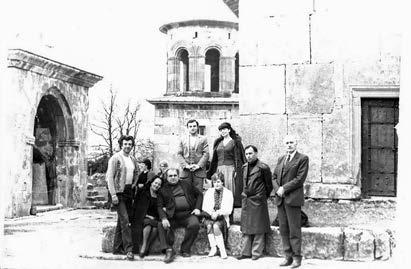
germanuli repertuari?
maxsovs, rogor muSaobda is lado aTanelTan Subertis `tyis mefeze~, rogor umuSavebda gamoTqmas. nodari germanulad saubrobda da loengrini hqonda namReri, aseve herode _ rixard Strausis `salomeSi~.
kritikuli iyo mowafeebis mimarT?
Zalian saqmiani, rbili, xmadabali. Tu problemas xedavda uzomod daRlilic ki agrZelebda muSaobas _ aCvenebda yvela xmas, banebTan mReroda banis partiebs, Semdeg iwyebda sopranoebTan da a.S. isedac `non-stop~ reJimi hqonda, imitom rom misi saxli mudam savse iyo megobrebiT, studentebiT, TayvanismcemlebiT da amitomac vuwode `akademia~. Tavis mdidar xmas rom amouSvebda, vxvdebodiT ra undoda, iseTi damajerebeli fraza hqonda. nodarma icoda afeTqebac, Tumca me amas ar Sevswrebivar da ar mgonia es profesiul procesTan yofiliyo dakavSirebuli. me, rogorc diletanti, ver vityvi ra aris vokaluri skola, magram erTi ram vici _ bevri kargi momRerali gvyavs da maTi umetesoba nodaris mowafe iyo, an misi namowafrebis mowafe. es erTgvari kultura iyo, ar vici amas skola qvia Tu ra. vinc es `akademia~ gaiara, bevri ram daitova, bevri ram moagrova...
Sens teqstebs kiTxulobda? kiTxulobda da Cems erT moTxrobasTan dakavSirebuli ucnauri skandalis dros 2000-ian wlebSi, Zalian mgulSematkivrobda, brazobda am
absurdze. is abosluturad Tavisufali iyo `homo sovetikusis~ kompleqsebisgan da yvelanairi gagebiT evropeli iyo.
im ambebTan dakavSirebiT konkretul rCevebsac maZlevda: maxsovs, ratomRac im moTxrobaze saubrisas termini `simbolo” avikviate; miTxra, rom sjobda gamomeyenebina `alegoria~, rodesac rame konkretul metaforaze vsaubrobdi. am Taobidan nodarTan erTad gverdSi mxolod mixeil qvliviZe damidga...
axla?
axla, raRac sevda damrCa, raRac dasrulda. nodaris gardacvalebis Semdeg didi kulturuli sicariele gaCnda. Cems Tavsac Zalian vsayvedurob, rom bolo wlebSi, obieqtur mizezTa gamo, sxva interesebi gamiCnda da mis samyaros movwydi, masTan veRar vatarebdi imden dros da bevri saintereso ram gamovtove. musikis is erTguleba, `daxvewili fanatizmi~ operis mimarT da mudmivi wyurvili maRali xarisxis, esTetikis da kulturisa, romlis `ordenis” mcvelic yovelgvari gadaWarbebis gareSe iyo nodari, aRar arsebobs. yovel SemTxvevaSi, me aRar Semxvedria vinme misi msgavsi. mudmivi SemoqmedebiTi aqtualobis gancdis procesSi, am adamianis goneba arasdros gaCerebula da dRes es maklia. ar minda viwuwuno, magram imas, rasac veZebT magaliTad me da Sen, rogorc operis moyvarulebi, ver vpoulobT... da vpoulobT umeteswilad glamurul kitCs cocxali elementebis nacvlad. nodaris SemTxvevaSi ki yvelaferi cocxali iyo, Zalian cocxali...






